UNITED STATES DISTRIT COURT FOR THE WESTERN DISTRICT OF WASHINGTON AT SEATTLE
ELNA MARIE BERRY; BART BERRY; GWINT L. FISHER; RENÉE FISHER; IRIS RUIZ; GARET CUNNINGHAM; ROSALBA RUIZ; SUZANNAH LUNH ANDERSON; DEBBIE ASHKAR and STEVEN ASHKAR, individually and on behalf of their minor son, C.A.; KENDRA FROME and DAVID FROME, individually and on behalf of her minor children J.F., H.F. and O.F.; MARGARITA ANDERSON; JOSH ANDERSON; MINHKIM BUI; MINHTAM BUI; EVAN GRANGER; CHRISTOPHER HICKMAN; TERESA HICKMAN; MEGAN HUTCHENS; ELIZABETH LE; CONNER MEJIA; JESSICA MONTOYA; ROBERT MONTOYA; VI NGUYEN; MICHAEL SIMENTAL and GRACE SIMENTAL, individually and on behalf of their minor children E.S. and K.S.; EVAN SMITH; LORRAINE SMITH; DENISE STEWART; NATHANIEL STEWART; GEORGE TATE JR., L'TOYA WHEELER-TATE; MARY GRACE CATLE-USTARIS; ROBERTO USTARIS; JENNIFER WINEGAR; KIRSTEN WRIGHT; ROBERT WRIGHT; individually
Plaintiffs, v.
THE BOEING COMPANY, a Delaware profit corporation; SPIRIT AEROSYSTEMS, INC., a Delaware profit corporation; and ALASKA AIRLINES, INC., an Alaska corporation, Defendants
Case No.: 2:24-cv-00134-RSM
SECOND AMENDED COMPLAINT FOR PERSONAL INJURIES, FRAUD, AND PUNITIVE DAMAGES
SECOND AMENDED COMPLAINT FOR PERSONAL INJURIES, FRAUD, AND PUNITIVE DAMAGES - 1 1 2 3 4 5 6 7 8 9 10 11 12 13 14 15 16 17 18 19 20 21 22 23 24 STRITMATTER KESSLER KOEHLER MOORE 3600 15th Ave W, Ste. 300 Seattle, WA 98119 Tel: 206 448 1777
RICARDO S. MARTINEZ
HONORABLE
EXHIBIT
001
A, p.
Plaintiffs allege Defendants’ negligence caused near catastrophic blowout of a fuselage panel on Boeing 737 MAX 9 Alaska Airlines Flight 1282 on January 5, 2024, resulting in personal injuries and damages. Plaintiffs also allege punitive damages against Defendant Boeing.
I. THE PARTIES
The Plaintiffs:
1.1 Plaintiffs Elna Marie Berry and Bart Berry are a married couple residing in Venice, Florida. Plaintiff Elna Berry was a passenger in seat 18C. Plaintiff Bart Fisher brings a loss of spousal consortium claim
1.2 Plaintiffs Gwint L. Fisher and Renee Fisher are a married couple residing in Long Beach, Washington. They were passengers in seats 16C and 16B, respectively.
1.3 Plaintiff Iris Ruiz is a resident of Vancouver, Washington. She was a passenger in seat 18A.
1.4 Plaintiff Garet Cunningham resides in Corona, California. He was a passenger in seat 28D.
1.5 Plaintiff Rosalba Ruiz resides in Corona, California. She was a passenger in seat 28E.
1.6 Plaintiff Suzannah Lunh Anderson resides in Portland, Oregon. She was a passenger in seat 1C.
1.7 Plaintiffs Debbie Ashkar and Steven Ashkar are a married couple residing in Murietta, California. Their minor son, C.A. was an unaccompanied minor passenger in seat 20F. They bring claims as C.A.’s guardians and under RCW 4.24.010.
SECOND AMENDED COMPLAINT FOR PERSONAL INJURIES, FRAUD, AND PUNITIVE DAMAGES - 2 1 2 3 4 5 6 7 8 9 10 11 12 13 14 15 16 17 18 19 20 21 22 23 24 STRITMATTER KESSLER KOEHLER MOORE 3600 15th Ave W, Ste. 300 Seattle, WA 98119 Tel: 206 448 1777
EXHIBIT A, p. 002
1.8
Plaintiff Kendra Frome and David Frome are a married couple residing in Redlands, California with their three minor children J.F., H.F. and O.F. Kendra Frome and the children were passengers in seats 19D, 19E, and 19F, respectively (toddler J.F. was sitting on Kendra Frome’s lap). Plaintiff David Frome brings a loss of spousal consortium claim. Plaintiffs Kendra and David Frome bring claims individually, as guardians of their minor children, and under RCW 4.24.010.
1.9
Plaintiffs Margarita Anderson and Josh Anderson are a married couple residing in Tigard, Oregon. Margarita Anderson was a passenger in seat 21C. Plaintiff Josh Anderson brings a loss of spousal consortium claim.
1.10 Plaintiff Minhkim Bui resides in Salem, Oregon. She was a passenger in seat 29E.
1.11 Plaintiff Minhtam Bui resides in Salem, Oregon. She was a passenger in seat 29F.
1.12 Plaintiff Evan Granger resides in Vancouver, Washington. He was a passenger in seat 16F.
1.13 Plaintiff Christopher Hickman resides in Vancouver, Washington. He was a passenger in seat 8A.
1.14 Plaintiff Teresa Hickman resides in El Monte, California. She was a passenger in seat 8B.
1.15 Plaintiff Megan Hutchens resides in Keizer, Oregon. She was a passenger in seat 2F.
1.16 Plaintiff Elizabeth Le resides in Happy Valley, Oregon. She was a passenger in seat 29D.
SECOND AMENDED COMPLAINT FOR PERSONAL INJURIES, FRAUD, AND PUNITIVE DAMAGES - 3 1 2 3 4 5 6 7 8 9 10 11 12 13 14 15 16 17 18 19 20 21 22 23 24 STRITMATTER KESSLER KOEHLER MOORE 3600 15th Ave W, Ste. 300 Seattle, WA 98119 Tel: 206 448 1777
EXHIBIT
003
A, p.
1.17 Plaintiff Conner Mejia resides in Clackamas, Oregon. He was a passenger in seat 4D.
1.18 Plaintiffs Jessica Montoya and Robert Montoya are a married couple residing in Whittier, California. They were passengers in seats 31C and 31D, respectively.
1.19 Plaintiff Vi Nguyen resides in Beverton, Oregon. She was a passenger in seat 34E.
1.20 Plaintiffs Michael Simental and Grace Simental are a married couple residing in Salem, Oregon with their two minor children, E.S. and K.S. They were passengers in seats 24D, 24C, 24B, and 24A, respectively. Plaintiffs Michael and Grace Simental bring claims individually, as guardians of their minor children, and under RCW 4.24.010.
1.21 Plaintiffs Evan Smith and Lorraine Smith are a married couple residing in Sun City, California. They were passengers in seats 20D and 20E, respectively.
1.22 Plaintiffs Denise Stewart and Nathaniel Stewart are a married couple residing in Corona, California. They were passengers in seats 24F and 24E, respectively.
1.23 George Tate, Jr. and L’Toya Wheeler-Tate are a married couple residing in Corona, California George Tate, Jr. was a passenger in seat 6B. Plaintiff L’Toya Wheeler-Tate brings a loss of spousal consortium claim.
1.24 Plaintiffs Mary Grace Catle-Ustaris and Roberto Ustaris are a married couple residing in Marysville, Washington. Plaintiff Mary Grace Catle-Ustaris was a passenger in seat 29A. Plaintiff Roberto Ustaris brings a loss of spousal consortium claim.
1.25 Plaintiff Jennifer Winegar resides in Monmouth, Oregon. She was a passenger in seat 7D.
SECOND AMENDED COMPLAINT FOR PERSONAL INJURIES, FRAUD, AND PUNITIVE DAMAGES - 4 1 2 3 4 5 6 7 8 9 10 11 12 13 14 15 16 17 18 19 20 21 22 23 24 STRITMATTER KESSLER KOEHLER MOORE 3600 15th Ave W, Ste. 300 Seattle, WA 98119 Tel: 206 448 1777
EXHIBIT A, p. 004
1.26 Plaintiff Kirsten Wright resides in Portland, Oregon. She was a passenger in seat 9B.
1.27 Plaintiff Robert Wright resides in Eugene, Oregon. He was a passenger in seat 9C.
The Defendants:
1.28 Defendant The Boeing Company (“Boeing”) is a Delaware corporation with its corporate headquarters in Arlington, Virginia.
1.29 Defendant Boeing’s principal place of business is in Seattle, WA 98108, where it owns, operates, manages and controls one of the largest aircraft manufacturing facilities in the world
1.30 As of December 2023, 66,797 of Defendant Boeing’s employees were located in the State of Washington. 1
1.31 The 737 MAX plane is assembled at the Boeing Everett Production facility along with the 767, 777 and 787 airplanes. The Everett facility is heralded as the largest manufacturing building in the world. 30,000 Boeing employees work there. 2
1.32 Defendant Boeing’s 737 factory in Renton leads the industry as the most efficient airplane factory in the world. Renton manufactures all variants of the 737 and continues to produce the 737 MAX family of aircraft. 3
1.33 The registered agent for Defendant Boeing is Corporation Service Company, 300 Deschutes Way SW, Suite 304, Tumwater, WA 98501.
1 https://www.boeing.com/company/general-info#global
2 https://www.boeing.com/company/about-bca/everett-production-facility#anchor1
3 https://www.boeing.com/company/about-bca/renton-production-facility#anchor4
SECOND AMENDED COMPLAINT FOR PERSONAL INJURIES, FRAUD, AND PUNITIVE DAMAGES - 5 1 2 3 4 5 6 7 8 9 10 11 12 13 14 15 16 17 18 19 20 21 22 23 24 STRITMATTER KESSLER KOEHLER MOORE 3600 15th Ave W, Ste. 300 Seattle, WA 98119 Tel: 206 448 1777
EXHIBIT A, p. 005
1.34 Defendant Spirit AeroSystems, Inc. (“Spirit”) is a corporation organized and existing under the laws of Delaware with its headquarters in Wichita, Kansas. Its registered agent for service of process in Washington is Corporation Service Company, 300 Deschutes Way SW, Ste. 208, MC-CSC1, Tumwater, WA 98501.
1.35 Defendant Spirit was part of Boeing Commercial Airlines until the sale of its Wichita division to an investment firm in 2005.
1.36 At all times material, Defendant Spirit was an agent of Defendant Boeing, acting within the course and scope of Spirits’ duties as such in constructing the fuselage for the Aircraft.
1.37 Defendant Alaska Airlines, Inc. (“Alaska Air”) is a corporation organized and existing under the laws of the state of Alaska with its headquarters in SeaTac, Washington. Its registered agent for service of process in Washington is Kyle Levine, 19300 International Blvd., Ste. 800, SeaTac, WA, 98188. Defendant Alaska Air’s principal business is the transportation of passengers on aircraft.
II. JURISDICTION & VENUE
2.1 This lawsuit was initially framed as a proposed class action and filed in King County Superior Court, State of Washington.
2.2 Without opposition from Plaintiffs, Defendant Boeing removed the case based on minimal diversity: “any member of a class of plaintiffs is a citizen of a State different from any defendant.” 28 U.S.C. § 1332(d)(2)(A).
2.3 Defendant Alaska Air consented to removal. 4
4 Dkt. # 8.
SECOND AMENDED COMPLAINT FOR PERSONAL INJURIES, FRAUD, AND PUNITIVE DAMAGES - 6 1 2 3 4 5 6 7 8 9 10 11 12 13 14 15 16 17 18 19 20 21 22 23 24 STRITMATTER KESSLER KOEHLER MOORE 3600 15th Ave W, Ste. 300 Seattle, WA 98119 Tel: 206 448 1777
EXHIBIT
006
A, p.
2.4 Plaintiffs now withdraw the class allegations. The Plaintiff group jointly asserts individual claims arising out of the same negligent conduct by Defendants and fraud by Defendant Boeing.
2.5 The Ninth Circuit and others have held that jurisdiction under 28 U.S.C. § 1332(d)(2)(A) does not depend on certification. United Steel, Paper & Forestry, Rubber, Mfg., Energy, Allied Indus. & Serv. Workers Int'l Union, AFL-CIO, CLC v. Shell Oil Co., 602 F.3d 1087, 1092 (9th Cir. 2010); In Touch Concepts, Inc. v. Cellco P'ship, 788 F.3d 98, 102 (2d Cir. 2015).
2.6 This Court has ongoing subject matter jurisdiction over these claims.
2.7 Defendants are subject to personal jurisdiction in the Western District of Washington because they were served in Washington State pursuant to the law of the State of Washington and Fed. R. Civ. Pro. 4(h). Defendants conduct regular business in the State of Washington. Their conduct giving rise to the claims occurred in the State of Washington.
2.8 Venue is proper in the Western District of Washington under 28 U.S.C. §1391 because a substantial part of the events or omissions giving rise to the claims occurred in the Western District of Washington, and because the Court has personal jurisdiction over these Defendants.
III. DEFENDANT BOEING 2015 FAA SAFETY AGREEMENT 5
3.1 Following an enforcement action in 2015, the Federal Aviation Administration (FAA) found that during a time period starting in 2012, Defendant Boeing repeatedly failed to
5 FAA Settlement Agreement 2015 (See Ex. 1 attached) https://www.faa.gov/sites/faa.gov/files/2022-08/20151218-boeing-settlement-agreement.pdf
SECOND AMENDED COMPLAINT FOR PERSONAL INJURIES, FRAUD, AND PUNITIVE DAMAGES - 7 1 2 3 4 5 6 7 8 9 10 11 12 13 14 15 16 17 18 19 20 21 22 23 24 STRITMATTER KESSLER KOEHLER MOORE 3600 15th Ave W, Ste. 300 Seattle, WA 98119 Tel: 206 448 1777
EXHIBIT A, p. 007
follow protocols designed to guard against production errors that put safety at risk. Among other failures, tasks were signed off as completed and checked when they were not.
3.2 In 2015 the FAA and Defendant Boeing entered into a Settlement Agreement (2015 FAA Agreement) under authority of 49 U.S.C. Sections 40113, 46102(a) and 46301. 6
3.3 The 2015 FAA Agreement included mandated improvements in the areas of: safety management, regulatory compliance, internal audit for regulatory compliance, specification improvement, audits of its suppliers, and compliance reporting.
3.4 To fulfill its legal obligations under the 2015 FAA Agreement, Defendant Boeing adopted the Safety Management Systems (SMS) Plan and was required to adhere to it. The SMS Plan was comprehensive and addressed all aspects of manufacture, operation, and safety.
3.5 To fulfill its legal obligations under the 2015 FAA Agreement, Defendant Boeing adopted the Regulatory Compliance Plan (RCP) to increase the focus and prioritization of its management on regulatory compliance and to prevent noncompliance.
3.6 To fulfill its legal obligations under the 2015 FAA Agreement, Defendant Boeing was to ensure that its internal audit system was responsible for assessing all engineering, supplier management, production, modification, repair, and customer support.
3.7 To fulfill its legal obligations under the 2015 FAA Agreement, Defendant Boeing was to perform audits of its suppliers to determine whether any suppliers were accepting work that was not complete and whether any such improper acceptance was systemic.
6 See id
SECOND AMENDED COMPLAINT FOR PERSONAL INJURIES, FRAUD, AND PUNITIVE DAMAGES - 8 1 2 3 4 5 6 7 8 9 10 11 12 13 14 15 16 17 18 19 20 21 22 23 24 STRITMATTER KESSLER KOEHLER MOORE 3600 15th Ave W, Ste. 300 Seattle, WA 98119 Tel: 206 448 1777
EXHIBIT A, p. 008
3.8 Defendant Boeing issued a statement on December 22, 2015, promising it would “never compromise on our commitment to quality and compliance.” 7
4.1 In March 2019, the FAA grounded the 737 MAX following two mass casualty crashes in Indonesia and Ethiopia that killed 346 people. 9
4.2 Following an enforcement action, in 2021, the FAA and Boeing entered into a Settlement Agreement (2021 FAA Agreement).
4.3 The parties agreed that Boeing should implement sustainable, enduring corrective actions to address the root causes of certain regulatory violations and to prevent similar future violations. And that regulatory compliance was critical to the quality and safety of aircraft products.
4.4 To fulfill its legal obligations under the 2021 FAA Agreement, Defendant Boeing was required to pay a civil penalty of $27,178,778.00.
4.5 To fulfill its legal obligations under the 2021 FAA Agreement, Defendant Boeing was required to implement a comprehensive review via its Boeing Problem Solving Model (BPSM) to ensure that Boeing had robust process controls in place.
4.6 To fulfill its legal obligations under the 2021 FAA Agreement, Defendant Boeing was required to address and mitigate the risk of aircraft with nonconformances produced by internal or external suppliers.
4.7 To fulfill its legal obligations under the 2021 FAA Agreement, Defendant Boeing was required to perform a Safety Risk Management (SRM) activity.
7 https://boeing.mediaroom.com/2015-12-22-Boeing-Statement-on-U-S-Federal-Aviation-AdministrationSettlement
8 FAA Settlement Agreement 2021 (See Ex 2 attached)
9 https://www.faa.gov/sites/faa.gov/files/2022-08/737_MAX_Timeline.pdf
SECOND AMENDED COMPLAINT FOR PERSONAL INJURIES, FRAUD, AND PUNITIVE DAMAGES - 9 1 2 3 4 5 6 7 8 9 10 11 12 13 14 15 16 17 18 19 20 21 22 23 24 STRITMATTER KESSLER KOEHLER MOORE 3600 15th Ave W, Ste. 300 Seattle, WA 98119 Tel: 206 448 1777
IV. DEFENDANT BOEING 2021 FAA SETTLEMENT AGREEMENT 8
EXHIBIT A, p. 009
V.
DEFENDANT BOEING 2021 CRIMINAL INFORMATION AND DOJ DEFERRED PROSECUTION AGREEMENT 10
5.1 On January 7, 2021, the Department of Justice (DOJ) Fraud Section filed a criminal information against and simultaneously entered into a Deferred Prosecution Agreement (DPA) with Defendant Boeing. i Court docket No. 4:21-CR-005-0 (N.D. Texas). The criminal information charged:
From at least in or around November 2016 through at least in or around December 2018, in the Northern District of Texas and elsewhere, the Defendant, THE BOEING COMPANY, knowingly and willfully, and with the intent to defraud, conspired and agreed together with others to defraud the United States by impairing, obstructing, defeating, and interfering with, by dishonest means, the lawful function of a United States government agency, to wit, the Federal Aviation Administration Aircraft Evaluation Group (“FAA AEG”) within the United States Department of Transportation, in connection with the FAA AEG’s evaluation of the Boeing 737 MAX airplane’s Maneuvering Characteristics Augmentation System (“MCAS”), including for purposes of the 737 MAX Flight Standardization Board Report (“FSB Report”) and the 737 MAX differences-training determination.
5.2 Defendant Boeing admitted to one count of conspiracy to defraud the U.S. in violation of 18 U.S.C. § 371.
5.3 Acting Assistant Attorney General David P. Burns of the DOJ’s Criminal Divion stated: “Boeing’s employees chose the path of profit over candor by concealing material information from the FAA concerning the operation of its 737 Max airplane and engaging in an effort to cover up their deception.” 11
5.4 The DPA was in effect for three years until January 7, 2024.
10 https://www.justice.gov/criminal/criminal-fraud/case/united-states-v-boeing-company; Criminal Information and DPA attached as Ex 3 and incorporated by reference.
11 https://www.justice.gov/opa/pr/boeing-charged-737-max-fraud-conspiracy-and-agrees-pay-over-25-billion
SECOND AMENDED COMPLAINT FOR PERSONAL INJURIES, FRAUD, AND PUNITIVE DAMAGES - 10 1 2 3 4 5 6 7 8 9 10 11 12 13 14 15 16 17 18 19 20 21 22 23 24 STRITMATTER KESSLER KOEHLER MOORE 3600 15th Ave W, Ste. 300 Seattle, WA 98119 Tel: 206 448 1777
EXHIBIT
010
A, p.
5.5 The DPA was in effect at the time of this incident.
5.6 Defendant Boeing is in breach of the DPA should it commit any U.S. federal felony during the term of the DPA, including providing any deliberately false, incomplete or misleading information; failing to implement a compliance program; or failing to completely perform or fulfil each obligation under the DPA.
5.7 Should Defendant Boeing breach any condition of the DPA, the U.S. Justice Department has the discretion to prosecute Boeing for the original crimes charged.
5.8 To fulfill its legal obligations under the 2021 DPA, Defendant Boeing was required to pay a total of $2.5 billion which included a criminal monetary penalty of $243.6 million.
5.9 To fulfill its legal obligations under the 2021 DPA, Defendant Boeing was required to cooperate with the DOJ Fraud Section in any future investigations.
5.10 To fulfill its legal obligations under the 2021 DPA, Defendant Boeing was required to strengthen its fraud compliance program.
5.11 To fulfill its legal obligations under the 2021 DPA, Defendant Boeing was required to create a safety committee of the board of directors.
5.12 To fulfill its legal obligations under the 2021 DPA, Defendant Boeing was required to create a product and services safety organization to strengthen and centralize the safety related functions that were previously located across Boeing.
VI. DEFENDANTS BOEING
AND SPIRIT’S ONGOING 737 MAX
6.1 In early 2023, Defendant Boeing found improperly torqued bolts in landing gears and wing ribs of new build 737 MAXs in its Renton plant.
SECOND AMENDED COMPLAINT FOR PERSONAL INJURIES, FRAUD, AND PUNITIVE DAMAGES - 11 1 2 3 4 5 6 7 8 9 10 11 12 13 14 15 16 17 18 19 20 21 22 23 24 STRITMATTER KESSLER KOEHLER MOORE 3600 15th Ave W, Ste. 300 Seattle, WA 98119 Tel: 206 448 1777
FAILURES PRE-INCIDENT
SAFETY
EXHIBIT
011
A, p.
6.2 In March 2023, the FAA addressed improperly torqued bolts that hold down anti-ice exhaust ducts found on the bottom of 737 MAXs’ CFM International Leap-1B turbofans. 12
6.3 In April 2023, Defendant Boeing halted delivery of some 737 MAXs due to a supplier quality problem by Defendant Spirit stretching back to 2019. Installation of two fittings that join the aft fuselage to the vertical tail were not attached correctly. 13
6.4 In August 2023, Defendant Boeing found that Defendant Spirit improperly drilled holes on the aft pressure bulkheads of 737 MAXs. 14 Defendant Spirit responded that because it used multiple suppliers, not all of the fuselages were impacted by the new “elongated” hole problem.
6.5 In December 2023, an international operator discovery a bolt with a missing nut while performing routine maintenance involving the rudder-control linkage. Defendant Boeing discovered a nut that was not properly tightened in an additional undelivered aircraft. This resulted in issuance of a Multi-Operator Message, urging operators of newer planes to inspect for possible loose hardware.
6.6 In 2023, Defendant Boeing requested FAA exemptions for the 737 MAX related to: lightning and radiation protection rules, the engine anti-ice system, extended overwater
12 https://www.flightglobal.com/airframers/boeing-tightens-procedures-to-address-bolt-torque-issue-at-renton-737factory/152623.article
13 https://www.reuters.com/business/aerospace-defense/boeing-pauses-deliveries-some-737-maxs-amid-newsupplier-problem-2023-04-13/
14 https://www.reuters.com/business/aerospace-defense/new-boeing-737-max-supplier-defect-delay-aircraftdeliveries-2023-08-23/
SECOND AMENDED COMPLAINT FOR PERSONAL INJURIES, FRAUD, AND PUNITIVE DAMAGES - 12 1 2 3 4 5 6 7 8 9 10 11 12 13 14 15 16 17 18 19 20 21 22 23 24 STRITMATTER KESSLER KOEHLER MOORE 3600 15th Ave W, Ste. 300 Seattle, WA 98119 Tel: 206 448 1777
EXHIBIT A, p. 012
operations, temperature and humidity in material durability, and the reliability of certain critical systems.
VII. ACSAA EXPERT PANEL FINDINGS 16
7.1 Pursuant to Section 103 of the 2020 Aircraft Certification, Safety, and Accountability Act (ACSAA) Pub.L. 116-260, Div. V, Sec. 103, an Expert Panel was convened on March 1, 2023, to review Defendant Boeing’s safety management processes and their effectiveness for the design and production of transport airplanes.
7.2 The timeline in the Panel’s report helped inform its work:
15 https://www.airlinerwatch.com/2023/12/boeing-seeks-faa-exemptions-for-737max.html#:~:text=Boeing%27s%20request%20for%20exemptions%20includes%20a%20temporary%20reprieve,s uch%20as%20temperature%20and%20humidity%20in%20material%20durability.
16 Plaintiffs incorporate by reference the ACSAA Report attached as Ex. 4 https://www.faa.gov/newsroom/Sec103_ExpertPanelReview_Report_Final.pdf
SECOND AMENDED COMPLAINT FOR PERSONAL INJURIES, FRAUD, AND PUNITIVE DAMAGES - 13 1 2 3 4 5 6 7 8 9 10 11 12 13 14 15 16 17 18 19 20 21 22 23 24 STRITMATTER KESSLER KOEHLER MOORE 3600 15th Ave W, Ste. 300 Seattle, WA 98119 Tel: 206 448 1777
15
EXHIBIT
013
A, p.
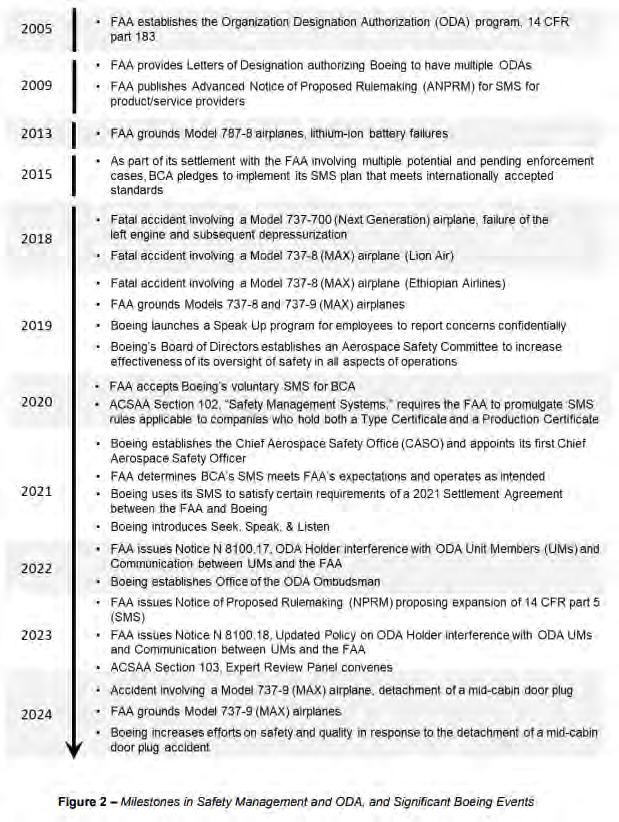
SECOND AMENDED COMPLAINT FOR PERSONAL INJURIES, FRAUD, AND PUNITIVE DAMAGES - 14 1 2 3 4 5 6 7 8 9 10 11 12 13 14 15 16 17 18 19 20 21 22 23 24 STRITMATTER KESSLER KOEHLER MOORE 3600 15th Ave W, Ste. 300 Seattle, WA 98119 Tel: 206 448 1777 EXHIBIT A, p. 014
7.3 The Panel found a disconnect between Defendant Boeing’s senior management and other members regarding safety culture including: whether safety reporting systems ensured communication and non-retaliation, and inadequate and confusing implementation of the components of a positive safety culture.
7.4 The Panel found SMS procures were not structured to ensure all employees understood their role in the SMS including employee confusion regarding procedures and training among different work sites and employee groups.
7.5 The Panel found a lack of awareness of safety-related metrics at all levels.
7.6 Defendant Boeing’s deficiencies as determined by the Panel existed despite its supposed adoption of Dr. James Reason’s safety culture model reflected in the International Civil Aviation Organization Safety Management Manual: Reporting Culture, Just Culture, Flexible Culture, Learning Culture and Informed Culture.
VIII. THE AIRCRAFT
8.1 Defendant Boeing is the manufacturer of the Aircraft within the meaning of the Washington Product Liability Act, Chapter 7.72 RCW.
8.2 Defendant Boeing designed, made, fabricated, constructed, and/or remanufactured, and/or had the contractual and/or designated responsibility to design, make, fabricate, construct and/or remanufacture, and/or marketed or branded under its name, some or all of the Aircraft, including but not limited to its left MED plug assembly.
8.3 Defendant Boeing conducted final assembly and inspection of the Aircraft at its manufacturing plant in Renton, Washington.
SECOND AMENDED COMPLAINT FOR PERSONAL INJURIES, FRAUD, AND PUNITIVE DAMAGES - 15 1 2 3 4 5 6 7 8 9 10 11 12 13 14 15 16 17 18 19 20 21 22 23 24 STRITMATTER KESSLER KOEHLER MOORE 3600 15th Ave W, Ste. 300 Seattle, WA 98119 Tel: 206 448 1777
EXHIBIT A, p. 015
8.4 Defendant Boeing is the type certificate holder for the Aircraft. Under Washington law and under the Federal Aviation Regulations, it is responsible for the safety of design and maintenance instructions as well as continuing airworthiness of the aircraft.
8.5 The Aircraft received its airworthiness certificate on October 25, 2023
8.6 The Aircraft received its FAA registration certificate on November 2, 2023.
8.7 Defendant Alaska Air upon its purchase of the Aircraft and at all material times was the registered owner of the Aircraft.
8.8 Defendant Alaska Air took delivery of the Aircraft from Defendant Boeing on October 31, 2023.
8.9 Defendant Alaska Air put the Aircraft in service on November 11, 2023 in the state of Washington.
8.10 At the time of the incident the Aircraft had accumulated 510 total hours and 154 cycles. 17
8.11 The Airplane was equipped with an MED plug option which Defendant Alaska Air selected based on its desired seating configuration.
8.12 This diagram from Defendant Boeing shows the three types of mid exit doors with the plug version on the far right. 18
17 See NTSB aviation investigation preliminary report attached as Ex. 5, page 4.
18 See id, pages 4-5.
SECOND AMENDED COMPLAINT FOR PERSONAL INJURIES, FRAUD, AND PUNITIVE DAMAGES - 16 1 2 3 4 5 6 7 8 9 10 11 12 13 14 15 16 17 18 19 20 21 22 23 24 STRITMATTER KESSLER KOEHLER MOORE 3600 15th Ave W, Ste. 300 Seattle, WA 98119 Tel: 206 448 1777
EXHIBIT
016
A, p.

8.13 The MED plug was manufactured by Spirit AeroSystems Malaysia on March 24, 2023.
8.14 The MED plug was received by Spirit AeroSystems Wichita on May 10, 2023.
8.15 Upon receipt at Wichita, the MED plug was installed and rigged on the Aircraft’s fuselage (Spirit AeroSystems Fuselage Line 8789) before it was shipped to Boeing on August 20, 2023.
8.16 The Aircraft’s fuselage arrived at Defendant Boeing’s BA Factory in Renton, Washington, on August 31, 2023. 19
8.17 On September 1, 2023, the document NCR 1450292531 was created noting five damaged rivets on the edge frame forward of the left MED plug. 20
19 See id, page 6.
20 See id, page 15.
SECOND AMENDED COMPLAINT FOR PERSONAL INJURIES, FRAUD, AND PUNITIVE DAMAGES - 17 1 2 3 4 5 6 7 8 9 10 11 12 13 14 15 16 17 18 19 20 21 22 23 24 STRITMATTER KESSLER KOEHLER MOORE 3600 15th Ave W, Ste. 300 Seattle, WA 98119 Tel: 206 448 1777
EXHIBIT A, p. 017
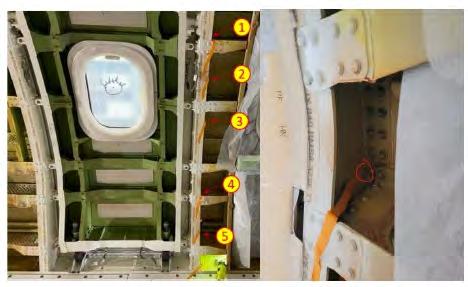
8.18 Defendant Boeing used a “travel work” model, where planes were assembled out of order to keep the production line working. This results in employees shuttling back and forth to retrieve parts and equipment. 21
8.19 Defendant Boeing was aware according to then Chief Executive Dave Calhoun that travel work “creates opportunities for failure.”
8.20 On September 19, 2023, Defendant Boeing instructed Defendant Spirit to replace the rivets according to Non-Conformance Order 145-8987-RSHK-1296-002NC.
8.21 Photo documentation of the work was obtained and circulated within Boeing that same day. The photo shows evidence of the left MED plug closed with no
21 https://www.msn.com/en-us/money/news/behind-the-alaska-blowout-a-manufacturing-habit-boeing-can-tbreak/ar-BB1jGhf5
SECOND AMENDED COMPLAINT FOR PERSONAL INJURIES, FRAUD, AND PUNITIVE DAMAGES - 18 1 2 3 4 5 6 7 8 9 10 11 12 13 14 15 16 17 18 19 20 21 22 23 24 STRITMATTER KESSLER KOEHLER MOORE 3600 15th Ave W, Ste. 300 Seattle, WA 98119 Tel: 206 448 1777
EXHIBIT
A, p. 018
bolts in the three visible locations. The aft upper guide track was covered with insulation and not shown. 22

8.22 Defendant Boeing commenced interior restoration of the Aircraft despite the lack of retaining bolts on the left MED plug. 23
22 See Ex. 5, page 16.
23 See id, page 17.
SECOND AMENDED COMPLAINT FOR PERSONAL INJURIES, FRAUD, AND PUNITIVE DAMAGES - 19 1 2 3 4 5 6 7 8 9 10 11 12 13 14 15 16 17 18 19 20 21 22 23 24 STRITMATTER KESSLER KOEHLER MOORE 3600 15th Ave W, Ste. 300 Seattle, WA 98119 Tel: 206 448 1777
EXHIBIT A, p. 019
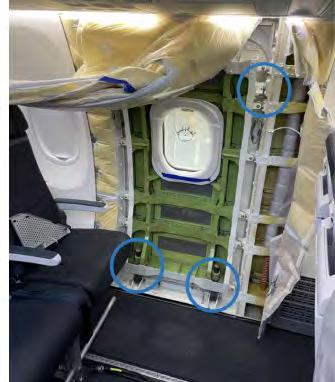
8.23 Defendant Boeing claims that in violation of its own manufacturing procedures, it has no formal log or other documentation of the repairs done that required opening the left MED door plug. 24
8.24 In testimony to congress on April 10, 2024, the NTSB confirmed Defendant Boeing’s claim that documentation does not exist.
24 https://www.msn.com/en-us/money/companies/boeing-critic-says-he-shared-missing-737-bolt-records-withfbi/ar-BB1lNVB5
SECOND AMENDED COMPLAINT FOR PERSONAL INJURIES, FRAUD, AND PUNITIVE DAMAGES - 20 1 2 3 4 5 6 7 8 9 10 11 12 13 14 15 16 17 18 19 20 21 22 23 24 STRITMATTER KESSLER KOEHLER MOORE 3600 15th Ave W, Ste. 300 Seattle, WA 98119 Tel: 206 448 1777
EXHIBIT
020
A, p.
8.25 A whistleblower testified in the same proceeding that the records do exist (perhaps through Defendant Boeing’s informal database known as shipside action tracker) and “this is a criminal coverup.”
8.26 The MED plug is primarily constructed of aluminum and is installed in the fuselage by means of two upper guide fittings and two lower hinge fittings.
8.27 The two upper guide fittings are shown in this Boeing diagram.

8.28 The two lower hinge fittings are shown in this Boeing diagram.
25 See Ex. 5,page 7.
SECOND AMENDED COMPLAINT FOR PERSONAL INJURIES, FRAUD, AND PUNITIVE DAMAGES - 21 1 2 3 4 5 6 7 8 9 10 11 12 13 14 15 16 17 18 19 20 21 22 23 24 STRITMATTER KESSLER KOEHLER MOORE 3600 15th Ave W, Ste. 300 Seattle, WA 98119 Tel: 206 448 1777
25
EXHIBIT
021
A, p.

26 8.29 The two upper guide fittings are located on the upper sides of the plug and engage with two upper guide rollers that are fixed to the upper sides of the fuselage opening as shown in this Boeing diagram.
26 See id, page 7.
SECOND AMENDED COMPLAINT FOR PERSONAL INJURIES, FRAUD, AND PUNITIVE DAMAGES - 22 1 2 3 4 5 6 7 8 9 10 11 12 13 14 15 16 17 18 19 20 21 22 23 24 STRITMATTER KESSLER KOEHLER MOORE 3600 15th Ave W, Ste. 300 Seattle, WA 98119 Tel: 206 448 1777
EXHIBIT A, p. 022
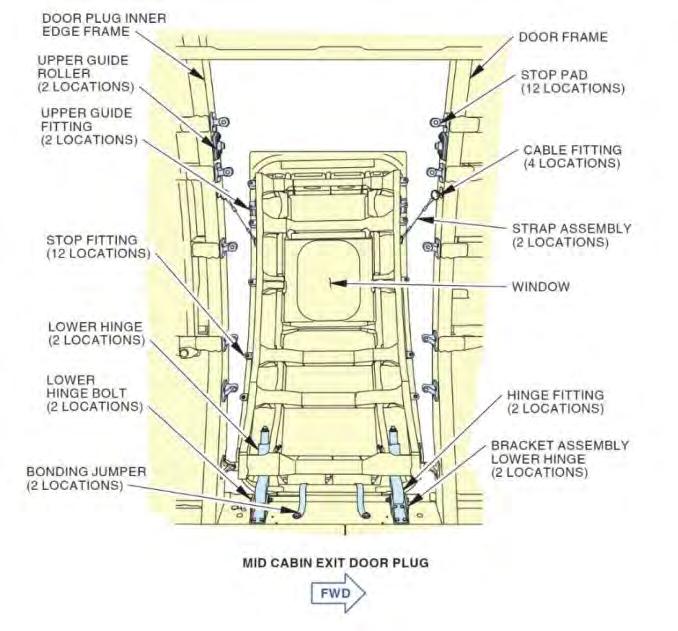
8.30 Two lower hinge guide fittings are fixed to the lower section of the plug and engage with the two lower hinge fittings that are attached to the bottom of the fuselage opening at the lower hinge bracket assemblies. 28
8.31 Once the plug is in place, it is secured from moving vertically by a total of four bolts. There is a bolt installed through each upper guide fitting and each lower hinge guide fitting. Once these bolts are installed, they are secured using castle nuts and cotter pins. Outboard motion of the plug is prevented by 12 stop fittings (6 along each forward and aft edge) installed on the fuselage door frame structure. 29
27 See id, page 8.
28 See id, page 6.
29 See id, page 6.
SECOND AMENDED COMPLAINT FOR PERSONAL INJURIES, FRAUD, AND PUNITIVE DAMAGES - 23 1 2 3 4 5 6 7 8 9 10 11 12 13 14 15 16 17 18 19 20 21 22 23 24 STRITMATTER KESSLER KOEHLER MOORE 3600 15th Ave W, Ste. 300 Seattle, WA 98119 Tel: 206 448 1777 27
EXHIBIT A, p. 023
8.32 The door plug is only intended to be opened for maintenance and inspection, which requires removing the vertical movement arrestor bolts and upper guide track bolts. The strap assemblies below the second stop pad from the top restrict the plug from opening further than 15 degrees. 30
8.33 Defendant Alaska Air took the Airplane out of service on December 31, 2023 through January 1, 2024, because of issues with the front passenger entry and exit door. 31
8.34 Defendant Alaska Air failed to inspect the left MED plug sufficiently if at all during the entry and exit door inspections and maintenance.
8.35 Defendant Alaska Air maintenance logs identified entries indicating that a pressure controller light had illuminated on three recent previous flights: the first earlier in the month, the second on January 3, 2024 its first day back in service, and the third on January 4, 2024.
8.36 Defendant Alaska Air should have visually observed during inspections that the left MED plug was gradually sliding upwards.
8.37 The NTSB noted that small upward movements of the door plug had left visible marks, and possibly created a gap between the panel and the fuselage pre-blowout.
8.38 Passengers on a previous flight heard a “whistling sound” coming from the area of the plug and reported it to a flight attendant who reported it to the pilots. But Defendant Alaska Air denies any record exists to confirm that report.
8.39 Defendant Alaska Air intended to perform a rigorous maintenance check of the Aircraft to be held overnight on January5.
30 See id, page 6.
31 https://www.nytimes.com/2024/03/12/us/politics/alaska-airlines-flight-door.html?smid=nytcore-iosshare&referringSource=articleShare
SECOND AMENDED COMPLAINT FOR PERSONAL INJURIES, FRAUD, AND PUNITIVE DAMAGES - 24 1 2 3 4 5 6 7 8 9 10 11 12 13 14 15 16 17 18 19 20 21 22 23 24 STRITMATTER KESSLER KOEHLER MOORE 3600 15th Ave W, Ste. 300 Seattle, WA 98119 Tel: 206 448 1777
EXHIBIT A, p. 024
8.40 Instead of immediately grounding the Aircraft, Defendant Alaska Air left it in service but prohibited it from flying over large bodies of water.
8.41 Defendant Alaska Air failed to detect the missing and/or defective bolts or other problems with the left MED plug because it did not timely conduct adequate inspections and maintenance.
IX. THE INCIDENT
9.1 On January 5, 2024, Defendant Alaska Air designated the Aircraft for service as Flight 1282, without timely nor adequately inspecting and maintaining it prior to departure from Portland, Oregon.
9.2 171 passengers and six crew were on board. The interior seating layout of the Alaska Airlines Boeing 737-9 MAX aircraft is represented below. The white “x” is where each plaintiff passenger sat on the Aircraft. 32

9.3 The left MED plug is located at row 26 and is 59 inches high by 29 inches wide.
33
32 Diagram of plaintiff passengers.
33 See Ex. 5, page 3.
SECOND AMENDED COMPLAINT FOR PERSONAL INJURIES, FRAUD, AND PUNITIVE DAMAGES - 25 1 2 3 4 5 6 7 8 9 10 11 12 13 14 15 16 17 18 19 20 21 22 23 24 STRITMATTER KESSLER KOEHLER MOORE 3600 15th Ave W, Ste. 300 Seattle, WA 98119 Tel: 206 448 1777
EXHIBIT
p. 025
A,
9.4 About ten minutes after takeoff at 16,000 feet, with a sudden loud explosive noise, the left MED plug detached and blew off leaving a gaping hole in the passenger compartment (“the incident”) 34
9.5 The Aircraft was cleared to flight level 230 (23,000 feet).
9.6 The flight crew said their ears popped.
9.7 The captain said his head was pushed into the heads-up display and his headset was nearly pushed off his head.
9.8 The pilot monitoring said her headset was completely removed due to the rapid outflow of air from the flight deck.
9.9 The flight deck door was blown open.
9.10 In the aftermath of the blowout, it was very noisy and difficult to communicate. 35
9.11 The force of the depressurization sucked C.T., a minor passenger, towards the opening ripping off his shoes, socks, and shirt. It also sucked cell phones, other items, and much of the oxygen out of the aircraft.
9.12 The entire seatback of 26A as well as the headrests in seats 26A and 26B, were torn off and sucked out.
9.13 Paneling and window trim in several rows extending from the point of failure were damaged.
34 See id, page 3.
35 See id, page 3.
SECOND AMENDED COMPLAINT FOR PERSONAL INJURIES, FRAUD, AND PUNITIVE DAMAGES - 26 1 2 3 4 5 6 7 8 9 10 11 12 13 14 15 16 17 18 19 20 21 22 23 24 STRITMATTER KESSLER KOEHLER MOORE 3600 15th Ave W, Ste. 300 Seattle, WA 98119 Tel: 206 448 1777
EXHIBIT A, p. 026

9.14 Seat 25A was rotated out and aft toward the opening.
9.15 The seatback of 26A was rotated forward and outboard.
SECOND AMENDED COMPLAINT FOR PERSONAL INJURIES, FRAUD, AND PUNITIVE DAMAGES - 27 1 2 3 4 5 6 7 8 9 10 11 12 13 14 15 16 17 18 19 20 21 22 23 24 STRITMATTER KESSLER KOEHLER MOORE 3600 15th Ave W, Ste. 300 Seattle, WA 98119 Tel: 206 448 1777
EXHIBIT A, p. 027

9.16 The violence of the event and ensuing depressurization physically injured some passengers.
9.17 The specter of the gaping hole caused most passengers to believe and fear they were going to get sucked out of the plane or that the plane was going to crash.
9.18 A man stood and shouted, “There’s a fuckin’ hole inside the plane! What the fuck is that?!” 37 A woman shouted, “Oh my God! Someone’s shirt was sucked out of the plane! There’s a hole in the plane!” 38
9.19 Some passengers tried to text or call loved ones to say goodbye in case the plane did not make it.
9.20 Some passengers hyperventilated.
9.21 Some passengers dealt with bleeding from the ears and intense head pressure.
9.22 Some passengers tried to protect and save their traveling companions.
36 See id, page 9.
37 https://www.cnn.com/2024/01/06/us/passengers-alaska-airlines/index.html
38 https://www.oregonlive.com/portland/2024/01/are-we-going-down-passengers-on-alaska-airlines-flight-1282describe-fear-confusion.html
SECOND AMENDED COMPLAINT FOR PERSONAL INJURIES, FRAUD, AND PUNITIVE DAMAGES - 28 1 2 3 4 5 6 7 8 9 10 11 12 13 14 15 16 17 18 19 20 21 22 23 24 STRITMATTER KESSLER KOEHLER MOORE 3600 15th Ave W, Ste. 300 Seattle, WA 98119 Tel: 206 448 1777 36
EXHIBIT A, p. 028
9.23 Some passengers sat still in mute shock.
9.24 The oxygen masks 39 dropped from the ceiling. But many panicked passengers could not get them to work.

9.25 The pilots declared an emergency and diverted. They descended under 10,000 feet MSL, and turned the Aircraft back toward Portland.
9.26 Pilots landed Alaska Air 1282 on Runway 28L without causing additional structural damage to the Aircraft.
39 Photo copied from The Washington Post, attributed to Flight 1282 passenger Nicholas Hoch, available at https://www.washingtonpost.com/travel/2024/01/10/alaska-airlines-boeing-max-9-passenger-compensation/
SECOND AMENDED COMPLAINT FOR PERSONAL INJURIES, FRAUD, AND PUNITIVE DAMAGES - 29 1 2 3 4 5 6 7 8 9 10 11 12 13 14 15 16 17 18 19 20 21 22 23 24 STRITMATTER KESSLER KOEHLER MOORE 3600 15th Ave W, Ste. 300 Seattle, WA 98119 Tel: 206 448 1777
EXHIBIT A, p. 029

9.27 On behalf of Defendant Boeing, its CEO Dave Calhoun publicly declared the incident “our mistake” 40 and that the plug was not properly secured to the fuselage either during manufacture or otherwise while the aircraft was being built by Defendant Boeing, and/or its subcontractor, Defendant Spirit. 41
9.28 On behalf of Defendant Boeing Calhoun told CNBC, “It escaped their factory but then it escaped ours too.”
X. POST INCIDENT INSPECTIONS OF OTHER 737 MAXs
10.1 Following the incident and grounding of 737 MAXs Alaska Air found “some loose hardware was visible on some aircraft.”
10.2 Similarly, United found “instances that appear to relate to installation issues in the door plug – for example, bolts that need additional tightening.”
40See, e.g., https://www.cbsnews.com/news/boeing-ceo-acknowledging-our-mistake-alaska-airlines-door-plugblowout-dave-calhoun/
41 See, e.g., https://www.youtube.com/watch?v=7PngZBdCwJU
SECOND AMENDED COMPLAINT FOR PERSONAL INJURIES, FRAUD, AND PUNITIVE DAMAGES - 30 1 2 3 4 5 6 7 8 9 10 11 12 13 14 15 16 17 18 19 20 21 22 23 24 STRITMATTER KESSLER KOEHLER MOORE 3600 15th Ave W, Ste. 300 Seattle, WA 98119 Tel: 206 448 1777
EXHIBIT
A, p. 030
11.1 The MED plug was recovered in a residential back yard and taken by the NTSB for examination. 42
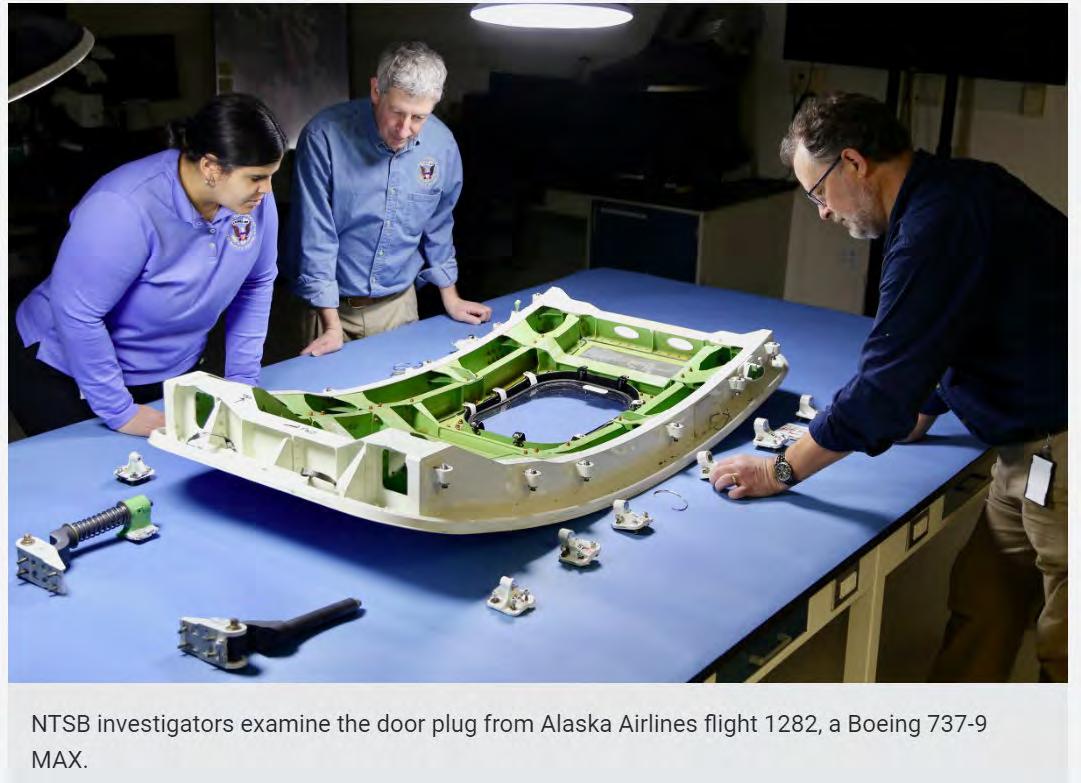
11.2 The outboard track bolt hole bore was undamaged. 43 42 See Ex. 5,, page 10. 43 See id., page 13.
SECOND AMENDED COMPLAINT FOR PERSONAL INJURIES, FRAUD, AND PUNITIVE DAMAGES - 31 1 2 3 4 5 6 7 8 9 10 11 12 13 14 15 16 17 18 19 20 21 22 23 24 STRITMATTER KESSLER KOEHLER MOORE 3600 15th Ave W, Ste. 300 Seattle, WA 98119 Tel: 206 448 1777 XI. POST INCIDENT NTSB PRELIMINARY INVESTIGATION FINDINGS
EXHIBIT A, p. 031
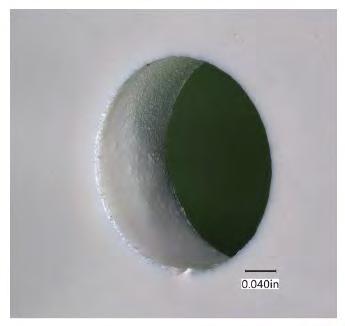
11.3 The vertical movement arrestor bolt holes in the aft lower hinge guide fitting were intact and undamaged. 44 44 See id, page 14.

SECOND AMENDED COMPLAINT FOR PERSONAL INJURIES, FRAUD, AND PUNITIVE DAMAGES - 32 1 2 3 4 5 6 7 8 9 10 11 12 13 14 15 16 17 18 19 20 21 22 23 24 STRITMATTER KESSLER KOEHLER MOORE 3600 15th Ave W, Ste. 300 Seattle, WA 98119 Tel: 206 448 1777
EXHIBIT A, p. 032
The four bolts that prevent upward movement of the MED plug were missing. 45
XII. CAUSES OF ACTION
A. PRODUCT LIABILITY: CONSTRUCTION DEFECT – DEFENDANTS BOEING AND SPIRIT.
12.1 The Aircraft and its left MED plug are each a “product” and a “relevant product” within the meaning of the Washington Product Liability Act, Chapter 7.72 of the Revised Code of Washington.
12.2 The Aircraft and its left MED plug door were defective in construction within the meaning of RCW 7.72.030(2)(a), because when the product left the control of the manufacturer, the product deviated in some material way from the design specifications or performance standards of the manufacturer, or deviated in some material way from otherwise identical units of the same product line.
12.3 The Aircraft and its left MED plug were defective in construction within the meaning of RCW 772.030(2)(a), because they were unsafe to an extent beyond that which would be contemplated by the ordinary user.
12.4 Defendants Boeing and Spirit are liable under the doctrine of res ipsa loquitur.
B. BREACH OF COMMON CARRIER’S DUTY – DEFENDANT ALASKA AIR
12.5 Defendant Alaska Air is North America’s fifth largest passenger airline, serving 44 million enplaned passengers in 2023.
12.6 26,000 people are employed by Defendant Alaska Air.
12.7 Defendant Alaska owns 230 Boeing 737 aircraft. This includes 65 Boeing 737 MAXs.
45 See id, page 15.
SECOND AMENDED COMPLAINT FOR PERSONAL INJURIES, FRAUD, AND PUNITIVE DAMAGES - 33 1 2 3 4 5 6 7 8 9 10 11 12 13 14 15 16 17 18 19 20 21 22 23 24 STRITMATTER KESSLER KOEHLER MOORE 3600 15th Ave W, Ste. 300 Seattle, WA 98119 Tel: 206 448 1777
11.4
EXHIBIT
033
A, p.
12.8 Defendant Alaska Air revamped its safety and maintenance departments following its maintenance failures leading to the deaths of 88 people onboard Alaska Air Flight 261 on January 31, 2000. 46
12.9 In August 2021, Defendant Alaska Air elected a new vice president of maintenance and engineering to lead 1,346 employees, including the technical operations team, and oversee the safety, compliance and operational performance of the airline’s mainline fleet including Boeing aircraft. 47
12.10 600 employee members of the Aircraft Mechanics Fraternal Association (AMFA) maintain Defendant Alaska Air’s fleet of 737s. 48
12.11 Defendant Alaska Air owed to its passengers on flight 1282 the duty to exercise the highest degree of care consistent with the practical operation of its type of transportation and its business as a common carrier. 49
12.12 Defendant Alaska Air owed its passengers the duty to timely inspect and properly maintain the Aircraft, particularly where notice of unusual or suspect conditions was received.
12.13 Defendant Alaska Air owed its passengers the duty to protect them from harm resulting from the misconduct of others, when such conduct was known or could reasonably be foreseen and prevented by the exercise of the care required of a common carrier.
46 https://www.ntsb.gov/investigations/AccidentReports/Reports/AAR0201.pdf
47 https://news.alaskaair.com/newsroom/alaska-airlines-names-new-vice-president-of-maintenance-andengineering-2/
48 https://www.amfanational.org/index.cfm?zone=/unionactive/view_page.cfm&page=Alaska20Airlines
49 Also under federal law, in prescribing regulations, the FAA must consider “the duty of an air carrier to provide service with the highest possible degree of safety in the public interest.” 49 U.S.C. 44701(d)(1). See also 14 CFR § 43.13 (“maintenance and preventative maintenance must be done in a manner that restores the aircraft to its original condition); 14 CFR § 43.15 (inspections must be performed to determine whether the aircraft meets all applicable airworthiness requirements)
SECOND AMENDED COMPLAINT FOR PERSONAL INJURIES, FRAUD, AND PUNITIVE DAMAGES - 34 1 2 3 4 5 6 7 8 9 10 11 12 13 14 15 16 17 18 19 20 21 22 23 24 STRITMATTER KESSLER KOEHLER MOORE 3600 15th Ave W, Ste. 300 Seattle, WA 98119 Tel: 206 448 1777
EXHIBIT
034
A, p.
12.14 Defendant Alaska Air knew that Defendant Boeing, the manufacturer of its 737 MAX fleet, was subject to the 2015 FAA Agreement.
12.15 Defendant Alaska Air knew that Defendant Boeing, the manufacturer of its 737 MAX fleet, was subject to the 2021 DPA arising out of the two mass fatality crashes in 2018 and 2019.
12.16 Despite knowing that its 737 MAX manufacturer had plead guilty to a criminal fraud charge and faced massive penalties and federal oversight action, Defendant Alaska Air did not initiate and enhance its own layers of quality control regarding the production of the Aircraft.
12.17 Defendant Alaska Air failed to ensure that the Aircraft had been properly and safely manufactured by Defendant Boeing. Specifically, whether the Aircraft’s fuselage and left MED plug assemblies had been constructed using dedicated quality inspectors to ensure that the parts were those specified by Boeing’s design engineers, that the parts met design, material and construction specifications, and the parts were installed correctly according to Boeing’s design.
12.18 Defendant Alaska Air failed to ground the Aircraft in order to engage in maintenance occasioned by pressure system and door concerns previously described. Instead electing to subject passengers to the risk of death mitigated only by restricting the flight path of the Aircraft.
12.19 Defendant Alaska Air is liable under the doctrine of res ipsa loquitur.
C. FRAUD
12.20 All previous allegations in the complaint are incorporated by reference.
SECOND AMENDED COMPLAINT FOR PERSONAL INJURIES, FRAUD, AND PUNITIVE DAMAGES - 35 1 2 3 4 5 6 7 8 9 10 11 12 13 14 15 16 17 18 19 20 21 22 23 24 STRITMATTER KESSLER KOEHLER MOORE 3600 15th Ave W, Ste. 300 Seattle, WA 98119 Tel: 206 448 1777
EXHIBIT A, p. 035
12.21 The “Boeing Problem Solving Model” is a longstanding method by which Defendant Boeing purports to identify problems and sustain solutions. It is based on Apollo Root Cause Analysis methodology. 50
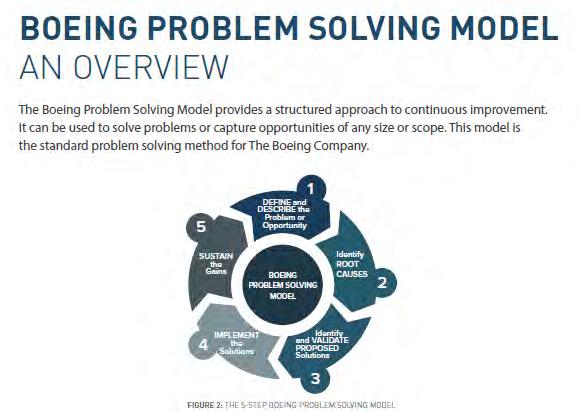
12.22 Step One requires a comparison between the current situation, the ideal situation, and the gap between. The end result is a “clearly stated end goal” with “measurable and challenging targets.”
12.23 Step Two requires that Defendant Boeing ask “why” an event occurred then with each answer repeat that question until “actionable root causes are identified.” Defendant Boeing uses RealityCharting root cause analysis software to chart root cases and actionable steps, an example of which is below:
50 See Ex. 6 attached hereto: Jemma Gaber and Jennifer MacKay, Root Cause Analysis and the Boeing Problem Solving Model (ARMS Reliability), available at https://www.armsreliability.com/page/resources/whitepaper/rootcause-analysis-and-the-boeing-problem-solving-model
SECOND AMENDED COMPLAINT FOR PERSONAL INJURIES, FRAUD, AND PUNITIVE DAMAGES - 36 1 2 3 4 5 6 7 8 9 10 11 12 13 14 15 16 17 18 19 20 21 22 23 24 STRITMATTER KESSLER KOEHLER MOORE 3600 15th Ave W, Ste. 300 Seattle, WA 98119 Tel: 206 448 1777
EXHIBIT A, p. 036

12.24 Since 2015 as describe above, Defendant Boeing at the corporate level 51 has repeatedly identified specific deficiencies in its safety culture and quality control that led to foreseeable and inevitable failures, with disastrous consequences. After each such disaster, Defendant Boeing conducted its root cause analysis to establish actionable root causes. In addition to the above, these include but are not limited to:
12.24.1 “Inspector shopping,” where its employees were permitted to seek out inspectors that would sign off on work with little pushback.
12.24.2 Defendant Boeing’s decision to lay off thousands of experienced employees with institutional and industry knowledge, without sufficient succession planning.
12.24.3 Insufficient training of new employees, despite requests for training by those employees.
51 This includes officers, directors and executives based primarily out of Illinois at the time of the conduct in question.
SECOND AMENDED COMPLAINT FOR PERSONAL INJURIES, FRAUD, AND PUNITIVE DAMAGES - 37 1 2 3 4 5 6 7 8 9 10 11 12 13 14 15 16 17 18 19 20 21 22 23 24 STRITMATTER KESSLER KOEHLER MOORE 3600 15th Ave W, Ste. 300 Seattle, WA 98119 Tel: 206 448 1777
EXHIBIT A, p. 037
12.24.4 Engineers in Washington are isolated in work and decision-making processes, are less supported, with little organized mentoring or knowledge sharing.
12.24.5 Isolation and decentralization of quality control—for overall corporate gain—have eroded and impaired training of newer employees on critical safety issues.
12.24.6 Confusion of employees at different work sites and groups about their respective responsibilities due to complex and constantly changing procedures and training.
12.24.7 Regular lapses in quality-control practices and documentation of work performed at multiple stages in manufacturing and assembly.
12.24.8 Acceptance of flawed components from suppliers, including Spirit, to adhere to a tight production schedule.
12.24.9 Lack of awareness of safety-related metrics at all levels of Boeing, including employees’ difficulty distinguishing the differences among various measuring methods, their purpose, and outcomes.
12.24.10 Administrative decisions by Defendant Boeing eroded the role and influence of human factors. These decisions included reorganization, decentralization, downsizing, and relocating the company’s headquarters.
12.24.11 Defendant Boeing failed to provide guidance to employees of their roles and expectations in its publicly-announced SMS plan.
12.24.12 Defendant Boeing instructed its employees that the SMS plan was not to disrupt existing safety programs or systems, but was an “overarching” safety program.
12.25 Despite identifying these root causes and assuring regulators, airlines, and the public that Boeing would address these failures, Defendant Boeing corporate has repeatedly, knowingly, and systematically refused to implement solutions to these problems.
12.26 Instead, Defendant Boeing has placed public relations over any genuine implementation of solutions to root cause failures.
SECOND AMENDED COMPLAINT FOR PERSONAL INJURIES, FRAUD, AND PUNITIVE DAMAGES - 38 1 2 3 4 5 6 7 8 9 10 11 12 13 14 15 16 17 18 19 20 21 22 23 24 STRITMATTER KESSLER KOEHLER MOORE 3600 15th Ave W, Ste. 300 Seattle, WA 98119 Tel: 206 448 1777
EXHIBIT A, p. 038
12.27 Defendant Boeing has repeatedly, knowingly, and systematically placed profits and corporate convenience over safety culture and best practices at the ground level of manufacturing, inspection, and maintenance.
12.28 Defendant Boeing knew it would not fully comply with the 2015 FAA Agreement at the time of its entry, including:
12.28.1 It would not perform sufficient audits of its suppliers to determine whether suppliers, specifically Defendant Spirit Aero Systems, were accepting incomplete work and whether improper acceptance was systemic.
12.28.2 It would not sufficiently increase focus and prioritization of its management sufficiently to ensure regulatory compliance specifically, noncompliance initiated by systemic improper acceptance of deficient work by Defendant Spirit Aero Systems.
12.29 Defendant Boeing in making its December 22, 2015 statement that it would “never compromise on our commitment to quality and compliance,” had already compromised its commitment to quality and compliance, and would continue to do so.
12.30 Defendant Boeing’s statements and agreement in Sections III, IV, and V were false and intended to mislead regulators, airlines, investors, and the traveling public including to Plaintiffs, to induce them to continue to travel on Boeing commercial aircraft, including the Aircraft.
12.31 Additionally, in the aftermath of the MAX crashes, in early 2021 Defendant Boeing created a new “Chief Safety Officer" position, which the company announced to employees as “broad control of internal safety initiatives and a seat on Boeing’s executive council.” 52
52 https://www.seattletimes.com/business/boeing-aerospace/boeing-creates-chief-safety-officer-job-in-wake-ofmax-crashes/
SECOND AMENDED COMPLAINT FOR PERSONAL INJURIES, FRAUD, AND PUNITIVE DAMAGES - 39 1 2 3 4 5 6 7 8 9 10 11 12 13 14 15 16 17 18 19 20 21 22 23 24 STRITMATTER KESSLER KOEHLER MOORE 3600 15th Ave W, Ste. 300 Seattle, WA 98119 Tel: 206 448 1777
EXHIBIT A, p. 039
12.32 In its inaugural Chief Aerospace Safety Officer Report, Defendant Boeing described “Our Safety Journey”: “We implemented a series of meaningful changes to strengthen our safety practices and culture and bring lasting improvements to aerospace safety. It is a journey of continuous improvement and we are dedicated to making daily progress and holding ourselves accountable to the highest standards.”
12.33 Yet as described above, Defendant Boeing not only failed to effectively implement the SMS plan by assigning roles and responsibilities to employee groups, it refused to adopt structural change.
12.34 In its 2022 Chief Aerospace Safety Officer (“CASO”) Report, Defendant Boeing claims it “realigned its 50,000 engineers into a single integrated organization, reporting to the company’s Chief Engineer.” And, “realignment results in an even greater emphasis on safety as it increases transparency, collaboration and accountability across all engineering designs and decisions.” 53
12.35 Despite Defendant Boeing touting integration and collaboration, the ACSAA Expert Panel found, “SMS operating procedure documents spoke of SMS as the overarching safety program but then also provided segregation of SMS-focused activities from legacy safety activities.”
12.36 The Expert Panel found “Boeing’s SMS documents do not effectively result in understanding by the average employee of their role in Boeing’s SMS.”
53 https://www.boeing.com/content/dam/boeing/boeingdotcom/principles/safety/caso/caso-report-2022.pdf Plaintiffs incorporate the report by reference as representations made by Boeing.
SECOND AMENDED COMPLAINT FOR PERSONAL INJURIES, FRAUD, AND PUNITIVE DAMAGES - 40 1 2 3 4 5 6 7 8 9 10 11 12 13 14 15 16 17 18 19 20 21 22 23 24 STRITMATTER KESSLER KOEHLER MOORE 3600 15th Ave W, Ste. 300 Seattle, WA 98119 Tel: 206 448 1777
EXHIBIT A, p. 040
12.37 Additionally, the Expert Panel found “The reliance on dispersed engineering experience, expertise, and guidance does not appear to be coordinated or consistently monitored for sufficiency in numbers, experience, expertise, or communication channels.”
12.38 In its CASO Report, Defendant Boeing claims its SMS Implementation process “involves training all employees on the value of an SMS, the approach to risk management and safety assurance, and the importance of a positive safety culture, which is the foundation of this framework.”
12.39 Yet in its report the Expert Panel notes, “Boeing’s SMS documents do not effectively result in understanding by the average employee of their role in Boeing’s SMS.
12.40 The Expert Panel found a lack of awareness of safety-related metrics at all levels of the organization, and significant skepticism expressed by Boeing employees regarding the lasting power of the SMS implementation.”
12.41 In its CASO report, Defendant Boeing states: “In 2021, employees completed SMS overview awareness training and completed more detailed training on the Safety Risk Management process by the first quarter of 2022.”
12.42 The Expert Panel report reveals, “No measures of competency were included in the training measures.”
12.43 In the wake of the 737 MAX 8 disasters in Indonesia and Ethiopia in 2021, Defendant Boeing issued a statement that after the 737 Max returned to service, "The in-service reliability is greater than 99%, and is consistent with other commercial airplane models." 54
54 Theo Leggett, 737 Max: Boeing refutes new safety concerns (BBC News, Nov. 26, 2021) available at https://www.bbc.com/news/business-59420570
SECOND AMENDED COMPLAINT FOR PERSONAL INJURIES, FRAUD, AND PUNITIVE DAMAGES - 41 1 2 3 4 5 6 7 8 9 10 11 12 13 14 15 16 17 18 19 20 21 22 23 24 STRITMATTER KESSLER KOEHLER MOORE 3600 15th Ave W, Ste. 300 Seattle, WA 98119 Tel: 206 448 1777
EXHIBIT A, p. 041
12.44 Defendant Boeing’s statement and other similar statements were misleading and intended to conceal and evade whistleblower reports arising from the 737 MAX certification process, such as concerns identified by Joe Jacobsen, a former senior safety engineer at the FAA, regarding system safety analysis especially as to safety-critical items, and underlying deficiencies in Defendant Boeing’s safety culture. 55
Defendant Boeing knowingly and intentionally refused to comply with the letter and/or intent of its promises in the DPA, and instead refused to reform its deficient safety and quality cultures, specifically, to address nonconformances by Defendant Spirit AeroSystems.
12.45 Defendant Boeing’s concealment of its failure to reform its safety culture has been the subject of congressional testimony by whistleblowers and others following the incident in 2024. 56 A number of these whistleblowers have described alleged harassment and retaliation by Boeing for raising their safety concerns, in addition to Boeing simply ignoring safety concerns.
57
12.46 If the facts as alleged by whistleblowers are true, then Boeing concealed such information from the FAA, the DOJ, Defendant Alaska Air and the general flying public, including Plaintiffs.
12.47 The NTSB has criticized Defendant Boeing for not cooperating in investigation of the incident; including failure to create, preserve and produce records that pertain specifically to work performed on the left MED plug.
55 See id
56 Lauren Rosenblatt, After months of hearing about safety from Boeing workers, a call for change (Seattle Times, April 17, 2024), available at https://www.seattletimes.com/business/boeing-workers-still-scared-to-raise-safetyconcerns-says-faa-appointed-experts/
57 This includes the now-deceased whistleblower who warned of serious defects in the oxygen systems that provide breathing masks during emergencies https://www.bbc.com/news/business-68534703
SECOND AMENDED COMPLAINT FOR PERSONAL INJURIES, FRAUD, AND PUNITIVE DAMAGES - 42 1 2 3 4 5 6 7 8 9 10 11 12 13 14 15 16 17 18 19 20 21 22 23 24 STRITMATTER KESSLER KOEHLER MOORE 3600 15th Ave W, Ste. 300 Seattle, WA 98119 Tel: 206 448 1777
EXHIBIT
042
A, p.
12.48 Defendant Boeing intended that each of its misrepresentations and concealments described above, inhibit the FAA from exercising more direct oversight and enforcement to achieve the improvements Boeing promised in the 2015 FAA Agreement, the DPA, Defendant Boeing’s representations related to ACSAA-SMS compliance, and otherwise.
12.49 Each such misrepresentation and/or concealment was made by a Defendant Boeing managing agent and/or other authorized agent acting within the course and scope of that agent’s duties.
12.50 Each such misrepresentation and concealment bolstered Plaintiffs’ confidence in Defendant Boeing aircraft. Without sufficient confidence, they would not have been aboard during the incident.
12.51 Defendant Boeing failed to disclose that the promises it had made in the 2015 FAA Agreement, the 2021 DPA, ACSAA-SMS compliance, and other assurances described above were not fully implemented such that numerous potentially serious and even deadly quality control problems were occurring.
12.52 Defendant Boeing was in a position of trust, confidence, influence and superiority over the passengers who chose to board the Aircraft, with respect to its safety culture and the characterization of that information.
12.53 Defendant Boeing had legal duties arising from the statutes and regulations governing its commercial aviation operations, the 2015 FAA Agreement, the DPA, and common law obligations; to disclose to the FAA, and the public, known deficiencies in its 737 MAX 9 products and their manufacturing, inspection and related safety processes, including that the left MED plug on Alaska Air Flight 1282 was not secured to the frame of the Aircraft.
SECOND AMENDED COMPLAINT FOR PERSONAL INJURIES, FRAUD, AND PUNITIVE DAMAGES - 43 1 2 3 4 5 6 7 8 9 10 11 12 13 14 15 16 17 18 19 20 21 22 23 24 STRITMATTER KESSLER KOEHLER MOORE 3600 15th Ave W, Ste. 300 Seattle, WA 98119 Tel: 206 448 1777
EXHIBIT A, p. 043
12.54 Defendant Boeing knew or should have known, but refused to disclose to the FAA, the fact that the left MED on the Aircraft was not secured to the airframe.
12.55 Defendant Boeing knew or should have known but refused to disclose to the passengers aboard that flight the fact that the MED on the Aircraft was not secured to the airframe.
12.56 Defendant Boeing’s concealments of its ongoing defective safety culture as described was designed to increase that corporation’s profitability, the compensation of its managers, the value of its stock and other aspects of its market worth.
12.57 Defendant Boeing through its deliberately misleading statements as described, lulled Plaintiffs into a false sense of security that the Airplane was safe as represented. Plaintiffs justifiably relied on those representations and characterizations.
12.58 Because of Defendant Boeing’s concealments above, Plaintiffs before boarding the Aircraft did not discover, and could not reasonably be expected to have discovered and avoided, the defects that led to this incident.
12.59 Defendant Boeing’s actions and omissions as described above breached Boeing’s duty not to commit fraud with respect to Plaintiffs.
XIII. INJURIES & DAMAGES
13.1 Plaintiffs passengers suffered physical injuries as a result of the incident, including but not limited to concussion, soft tissue spine injury, ear drum injury, seizure, headache, oxygen deprivation, wind rash, bruising.
13.2 Plaintiff passengers suffered mental harm and emotional distress, including but not limited to terror, fear of death or serious injury, PTSD, anxiety, and Aerophobia (fear of flying).
SECOND AMENDED COMPLAINT FOR PERSONAL INJURIES, FRAUD, AND PUNITIVE DAMAGES - 44 1 2 3 4 5 6 7 8 9 10 11 12 13 14 15 16 17 18 19 20 21 22 23 24 STRITMATTER KESSLER KOEHLER MOORE 3600 15th Ave W, Ste. 300 Seattle, WA 98119 Tel: 206 448 1777
EXHIBIT
p. 044
A,
13.3 Phobia is an anxiety disorder under DSM-5.
13.4 Panic attacks may result from Aerophobia including chills, dizziness and light headedness, excessive sweating, nausea, dyspnea, trembling or shaking and dyspepsia. 58
13.5 Aerophobia can result in missing family vacations or refusing to travel for work. Or insisting on other modes of transportation even if slower and less convenient. Others may become obsessed with learning about plane safety.
13.6 Plaintiffs who did not suffer physical injury were within the scope of foreseeable harm created by Defendants’ conduct, had a reasonable psychological reaction under the circumstances, and their symptoms of distress are manifested by objective symptomology.
13.7 Plaintiffs suffered special damages, including but not limited to medical expenses past and future, lost wages, loss of earning capacity, travel expenses, and personal property damage.
13.8 Plaintiffs suffered general damages including physical and mental pain and suffering, past and future.
13.9 Plaintiff-spouses suffered damages for loss of consortium.
13.10 Plaintiff-parents suffered damages pursuant to RCW 4.24.010.
13.11 Plaintiffs suffered other general and special damages to be proven at the time of trial.
XIV. APPLICATION OF ILLINOIS PUNITIVE DAMAGES
14.1 At inception, Defendant Boeing was headquartered in Seattle, Washington, where manufacturing, assembly, inspection and repair had and continue to take place.
14.2 After 85 years, Boeing moved its headquarters to Chicago, Illinois in 2001, and enjoyed the benefits of conducting business under the laws of and in the State of Illinois
58 https://my.clevelandclinic.org/health/diseases/22431-aerophobia-fear-of-flying
SECOND AMENDED COMPLAINT FOR PERSONAL INJURIES, FRAUD, AND PUNITIVE DAMAGES - 45 1 2 3 4 5 6 7 8 9 10 11 12 13 14 15 16 17 18 19 20 21 22 23 24 STRITMATTER KESSLER KOEHLER MOORE 3600 15th Ave W, Ste. 300 Seattle, WA 98119 Tel: 206 448 1777
EXHIBIT
045
A, p.
14.3 The decision to separate corporate management from the company’s work was the start of Boeing’s ongoing production problems. Boeing prioritized profit over safety.
14.4 Defendant Boeing remained headquartered in the State of Illinois until late 2022, and then maintained a “significant presence” there
14.5 Washington State has the most significant relationship to Boeing’s defective construction of its aircraft at the Renton, Washington plant.
14.6 However, the root cause of this incident was corporate fraud and misconduct at Boeing’s headquarters in Illinois. At the corporate level, 59 Boeing knew of actual and potential defects and failed manufacturing practices in the Boeing 737-MAX 9, but knowingly and intentionally concealed them from the FAA, from the Department of Justice, from airlines including Defendant Alaska Airlines, and from the public.
14.7 Washington has no interest in protecting companies from punitive damages that commit fraud or egregious misconduct in other states.
14.8 Illinois has the most significant relationship to, and greatest interest in, punishment and deterrence of Defendant Boeing’s fraudulent, intentional, willful and wanton, or otherwise egregious misconduct and practices occurring there and impacting injured victims nationwide. See Erickson v. Pharmacia LLC; 60 Singh v. Edwars Lifesciences Corporation, 151 Wash. App. 137, 210 P.3d 337 (Div. 1 2009).
14.9 Based on the conduct described herein, Plaintiffs are entitled to an award of punitive damages under Illinois law. 61
59 Including officers, directors, and executives based in Illinois.
60 Div. 1 Cause No. 83287-5-I: https://www.courts.wa.gov/opinions/pdf/832875.pdf
61 See Illinois Pattern Instruction No. 35.
SECOND AMENDED COMPLAINT FOR PERSONAL INJURIES, FRAUD, AND PUNITIVE DAMAGES - 46 1 2 3 4 5 6 7 8 9 10 11 12 13 14 15 16 17 18 19 20 21 22 23 24 STRITMATTER KESSLER KOEHLER MOORE 3600 15th Ave W, Ste. 300 Seattle, WA 98119 Tel: 206 448 1777
EXHIBIT
p. 046
A,
XV. PRAYER FOR RELIEF
Wherefore, Plaintiffs respectfully request this Court grant them the following relief against Defendants jointly and severally:
a. Judgment of liability against Defendants.
b. Special and general damages in amounts to be proved at trial.
c. Punitive damages against Defendant Boeing.
d. Pre- and post-judgment interest on any judgment awarded to Plaintiffs to the maximum extent allowed by law;
e. Such other and further relief as this Court deems fit and just to award.
DATED this ____ day of May, 2024.
STRITMATTER KESSLER KOEHLER MOORE
/s/ Karen K. Koehler
Karen K. Koehler, WSBA #15325
Andrew Ackley, WSBA #41752
Daniel R. Laurence, WSBA#19697
Brad J. Moore, WSBA#1802
Melanie Nguyen, WSBA #51724
Debora Silberman, WSBA #59302
3600 – 15th Avenue West, Suite 300
Seattle, WA 98119
Telephone: 206.448.1777
Facsimile: 206.728.2131
karenk@stritmatter.com andrew@stritmatter.com dan@stritmatter.com brad@stritmatter.com melanie@stritmatter.com deboras@stritmatter.com
Attorneys for Plaintiffs
SECOND AMENDED COMPLAINT FOR PERSONAL INJURIES, FRAUD, AND PUNITIVE DAMAGES - 47 1 2 3 4 5 6 7 8 9 10 11 12 13 14 15 16 17 18 19 20 21 22 23 24 STRITMATTER KESSLER KOEHLER MOORE 3600 15th Ave W, Ste. 300 Seattle, WA 98119 Tel: 206 448 1777
EXHIBIT A, p. 047
UNITED STATES DEPARTMENT OF TRANSPORTATION
FEDERAL AVIATION ADMINISTRATION
NORTHWEST MOUNTAIN REGION OFFICE OF REGIONAL COUNSEL
SETTLEMENT AGREEMENT

In the Matter of:
The Boeing Company (Boeing Commercial Airplanes).
The Federal Aviation Administration (FAA) and the Boeing Company, through its business unit Boeing Commercial Airplanes (BCA), (collectively, "the parties") enter into this Settlement Agreement (Agreement) by and through their undersigned representatives to resolve the allegations documented in the following Enforcement Investigative Reports (EIRs): 2010NM410014, 2012NM520006, 2012NM520035, 2011NM520003, 2012NM520057, 2012NM410009, 2013NM410010, 2013NM410021, 2013NM410018, 2013NM410009, 2014NM410014, 2015NM410003, and 2015NM410013 (the "pending cases").
Recitals.
WHEREAS, this Agreement is issued under the authority contained in 49 U.S.C. Sections 40113, 46102(a) and 46301.
WHEREAS, the FAA issues type certificates under Title 14, Code of Federal Regulations (14 CFR) part 21. Type certificates constitute the FAA's confirmation that the design of a product, such as an airplane or its engine, meets FAA standards. The FAA has approved applications from BCA for type certificates for the designs of many models of airplanes, including designs for the 737, 747, 757, 767, 777, and 787 models that are the subject of EIRs to be resolved by this Agreement.
WHEREAS, the FAA's approval of a type certificate for transport category airplanes creates obligations under 14 CFR part 26 for the holder.
WHEREAS, the FAA has granted BCA authority to manufacture aircraft under 14 CFR part 21. This authority is manifested in the form of a production certificate issued by the FAA. BCA is the holder of Production Certificate No. 700.
1 EXHIBIT A, p. 048 Ex. 1, p. 001

WHEREAS, subpart G of 14 CFR part 21 requires production certificate holders to maintain and implement a quality assurance program that has been approved by the FAA.
WHEREAS, to determine whether BCA is complying with its quality assurance program, the FAA conducts surveillance of BCA's production processes.
WHEREAS, following such surveillance, the FAA compiled evidence into investigations, and opened 13 EIRs, which are the pending cases and the subject of this Agreement.
WHEREAS, the FAA, upon reviewing the evidence contained in the pending cases and applying the agency's compliance and enforcement policies, determined that civil penalty action against BCA is appropriate.
WHEREAS, the FAA has identified most of the pending cases as involving apparent failures of corrective action.
WHEREAS, BCA recognizes that regulatory compliance is critical to the quality, safety, and prompt delivery of its products. BCA therefore has committed and is further committing, with this Agreement, to continue its efforts to improve its processes and practices for ensuring compliance with regulatory commitments.
WHEREAS, since the FAA announced proposed penalties in two of the pending cases, BCA has, at the direction of its senior management, voluntarily implemented significant organizational and process improvements designed to enhance its regulatory compliance and increase its accountability for the same.
WHEREAS, BCA wishes to further improve and enhance its self-correcting systems which are designed to correct any regulatory noncompliances and prevent their recurrence, and apply those lessons to prevent other noncompliances without the need for FAA involvement.
WHEREAS, based on BCA's having undertaken significant systemic initiatives, and its commitment in this Agreement to implement additional significant systemic initiatives, to strengthen its regulatory compliance processes and practices, the FAA believes that both BCA and FAA resources can be deployed most effectively by promoting, implementing, and verifying these improvements.
WHEREAS, the FAA believes that it is in the public interest to settle all claims arising from the pending cases, given BCA's initiatives to date and BCA's additional commitments in this Agreement.
2 EXHIBIT A, p. 049 Ex. 1, p. 002

WHEREAS, the FAA would not have agreed to the monetary amounts set forth in this Agreement absent BCA's current and planned remedial efforts, including specifically BCA's agreement to perform the obligations described below.
WHEREAS, the FAA and BCA agree that the public interest and safety in air transportation are best served by certificate holders that take actions voluntarily to address past concerns, and the FAA acknowledges that BCA has invested and is committing to invest significant resources in its processes, its people, its internal organization, and its systems, in ways that exceed FAA regulatory requirements.
WHEREAS, the parties intend BCA's commitments in this Agreement, together with the initiatives it already has undertaken, to improve BCA's performance in meeting regulatory compliance obligations. Nevertheless, the parties recognize that even well-designed regulatory compliance processes and practices are subject to human error and, as a consequence, the parties intend that this Agreement assist and strengthen BCA's compliance systems by instituting processes and practices to identify and eliminate conditions that may lead to noncompliance, whether the root cause of such conditions be individual or systemic. The parties further expect that this Agreement, fully implemented on the agreed-upon schedule, will result in a high degree of assurance of compliance in the specified areas of compliance and the continuation of such high level of performance into the indefinite future.
The specified regulatory compliance areas whose specific metrics and requirements are more expressly delineated in the Appendices to this Agreement (which are incorporated into and made an integral part of this Agreement) and in Section I below are:
A. Safety Management;
B. Regulatory Compliance Plan;
C. Organization Designation Authorization (ODA) and Internal Auditing System for Regulatory Compliance;
D. Specification Improvement;
E. First Article Verification;
F. Problem Solving and Sustainment;
G. Accuracy of Stamping and Other Verifications;
H. Quality of Submissions;
3 EXHIBIT A, p. 050 Ex. 1, p. 003
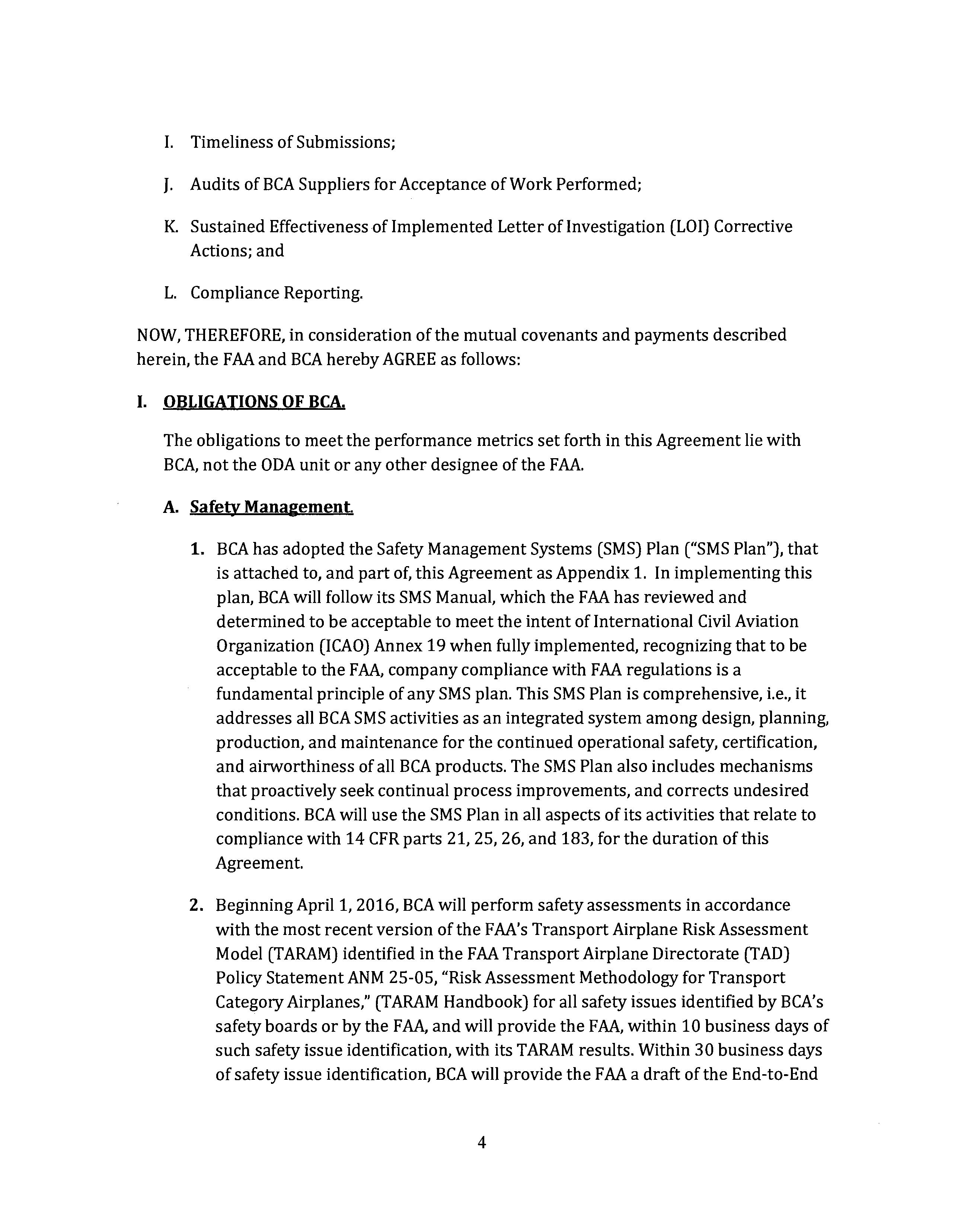
I. Timeliness of Submissions;
J. Audits of BCA Suppliers for Acceptance of Work Performed;
K. Sustained Effectiveness of Implemented Letter of Investigation (LOI) Corrective Actions; and
L. Compliance Reporting.
NOW, THEREFORE, in consideration of the mutual covenants and payments described herein, the FAA and BCA hereby AGREE as follows:
I. OBLIGATIONS OF BCA.
The obligations to meet the performance metrics set forth in this Agreement lie with BCA, not the ODA unit or any other designee of the FAA.
A. Safety Management
1. BCA has adopted the Safety Management Systems (SMS) Plan ("SMS Plan"), that is attached to, and part of, this Agreement as Appendix 1. In implementing this plan, BCA will follow its SMS Manual, which the FAA has reviewed and determined to be acceptable to meet the intent of International Civil Aviation Organization (ICAO) Annex 19 when fully implemented, recognizing that to be acceptable to the FAA, company compliance with FAA regulations is a fundamental principle of any SMS plan. This SMS Plan is comprehensive, i.e., it addresses all BCA SMS activities as an integrated system among design, planning, production, and maintenance for the continued operational safety, certification, and airworthiness of all BCA products. The SMS Plan also includes mechanisms that proactively seek continual process improvements, and corrects undesired conditions. BCA will use the SMS Plan in all aspects of its activities that relate to compliance with 14 CFR parts 21, 25, 26, and 183, for the duration of this Agreement.
2. Beginning April 1, 2016, BCA will perform safety assessments in accordance with the most recent version of the FAA's Transport Airplane Risk Assessment Model (TARAM) identified in the FAA Transport Airplane Directorate (TAD) Policy Statement ANM 25-05, "Risk Assessment Methodology for Transport Category Airplanes," (TARAM Handbook) for all safety issues identified by BCA's safety boards or by the FAA, and will provide the FAA, within 10 business days of such safety issue identification, with its TARAM results. Within 30 business days of safety issue identification, BCA will provide the FAA a draft of the End-to-End
4 EXHIBIT A, p. 051 Ex. 1, p. 004
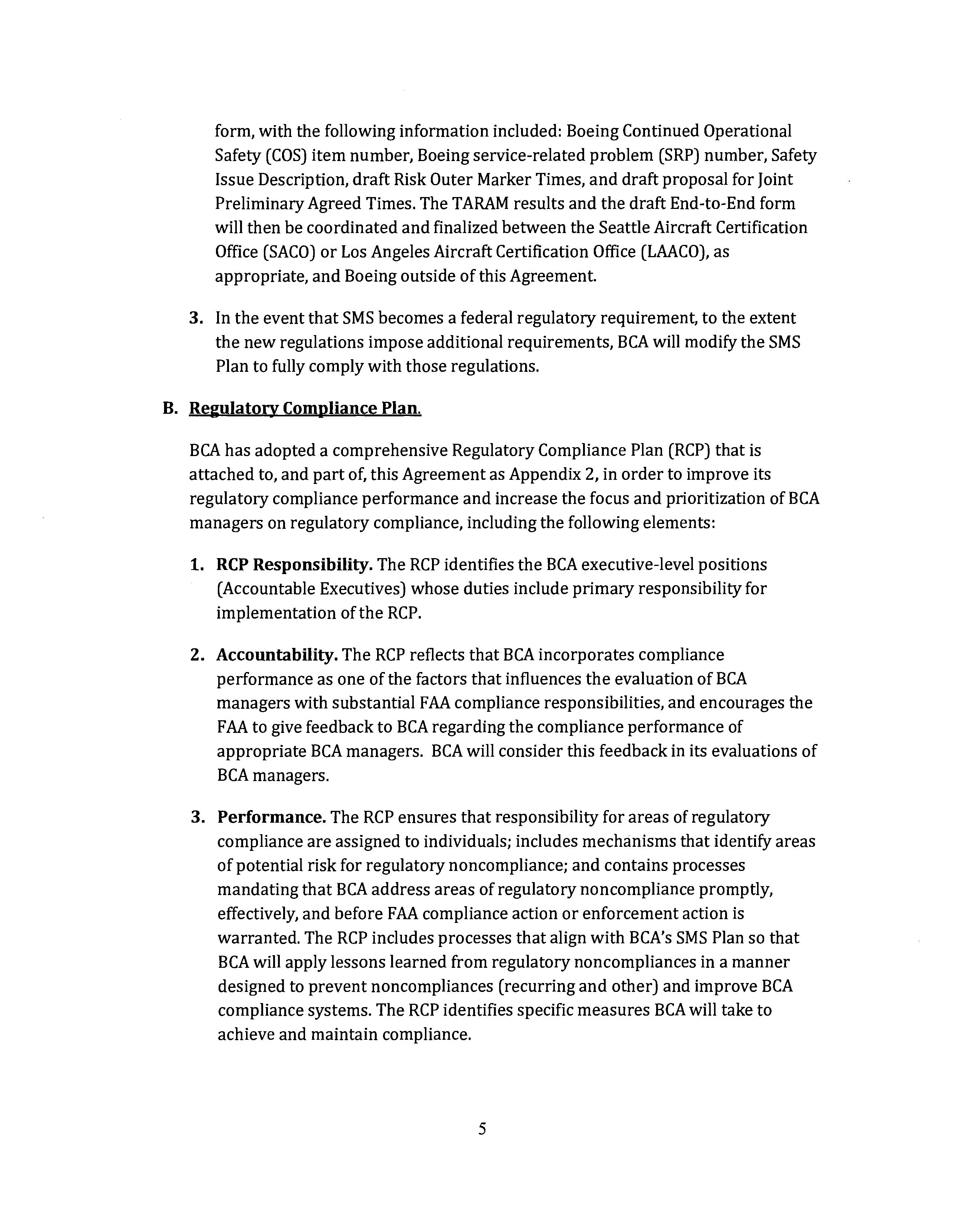
form, with the following information included: Boeing Continued Operational Safety (COS) item number, Boeing service-related problem (SRP) number, Safety Issue Description, draft Risk Outer Marker Times, and draft proposal for Joint Preliminary Agreed Times. The TARAM results and the draft End-to-End form will then be coordinated and finalized between the Seattle Aircraft Certification Office (SACO) or Los Angeles Aircraft Certification Office (LAACO), as appropriate, and Boeing outside of this Agreement.
3. In the event that SMS becomes a federal regulatory requirement, to the extent the new regulations impose additional requirements, BCA will modify the SMS Plan to fully comply with those regulations.
B. Regulatory Compliance Plan.
BCA has adopted a comprehensive Regulatory Compliance Plan (RCP) that is attached to, and part of, this Agreement as Appendix 2, in order to improve its regulatory compliance performance and increase the focus and prioritization of BCA managers on regulatory compliance, including the following elements:
1. RCP Responsibility. The RCP identifies the BCA executive-level positions (Accountable Executives) whose duties include primary responsibility for implementation of the RCP.
2. Accountability. The RCP reflects that BCA incorporates compliance performance as one of the factors that influences the evaluation of BCA managers with substantial FAA compliance responsibilities, and encourages the FAA to give feedback to BCA regarding the compliance performance of appropriate BCA managers. BCA will consider this feedback in its evaluations of BCA managers.
3. Performance. The RCP ensures that responsibility for areas of regulatory compliance are assigned to individuals; includes mechanisms that identify areas of potential risk for regulatory noncompliance; and contains processes mandating that BCA address areas of regulatory noncompliance promptly, effectively, and before FAA compliance action or enforcement action is warranted. The RCP includes processes that align with BCA's SMS Plan so that BCA will apply lessons learned from regulatory noncompliances in a manner designed to prevent noncompliances (recurring and other) and improve BCA compliance systems. The RCP identifies specific measures BCA will take to achieve and maintain compliance.
5 EXHIBIT A, p. 052 Ex. 1, p. 005

a. The RCP requires BCA to implement processes no later than January 1, 2016.
b. BCA will maintain the responsibilities and commitments in the RCP for the duration of this Agreement.
c. The RCP reflects that BCA will make periodic, but no less than annual, communications from the BCA Chief Executive Officer (CEO) to all employees regarding expectations for regulatory performance, and other periodic communications of regulatory issues important to the company.
C. Organization Designation Authorization (ODA) and Internal Auditin&:: System for Regulatory Compliance.
1. ODA.
a. ODA Unit Reporting. BCA holds an ODA Unit, whose Lead Administrator reports directly to the Accountable Executive under BCA's SMS Plan. BCA will maintain this direct reporting relationship for the duration of this Agreement.
b. ODA Structure. The ODA Lead Administrator ensures that the ODA fulfills its delegation responsibilities and that no conflicting duties or other interference affects the performance of authorized functions by ODA unit members. To avoid any potential conflict, the Lead Administrator and the deputy Lead Administrator will not advocate for BCA as the applicant in any interaction on specific compliance issues with the FAA. The holder of the Lead Administrator position may have other non-ODA related functions and responsibilities within BCA for promoting the safety and airworthiness of BCA products and services.
2. Internal Auditing System.
Specific details and actions required of BCA to support the commitments in this paragraph C.2 are set forth in Appendix 3 to this Agreement.
a. Internal Audit Reporting. BCA has an independent internal audit team that reports directly to the Vice President of Quality under BCA's corporate structure. BCA will maintain this direct reporting relationship and structure for the duration of this Agreement.
b. Audit Team. BCA's internal auditing system is implemented in part by an internal audit team, which includes permanent members and supporting
6 EXHIBIT A, p. 053 Ex. 1, p. 006
participants possessing the technical qualifications necessary to effectively assess all aspects of BCA compliance with FAA regulatory requirements. This internal audit system is integrated with BCA's SMS Plan and incorporates a self-correcting philosophy.
c. Audit System Responsibility. BCA has developed and deployed a comprehensive internal audit system under a single organizational reporting and management structure. This internal audit system will assess all aspects of BCA compliance with FAA regulatory requirements at all sites and across the value stream (including Engineering, Supplier Management, Production, Modification, Repair, and Customer Support).
d. Audit Team Competence. Beginning January 1, 2016, and for the duration of this Agreement, BCA will ensure the internal audit team comprises individuals, including permanent team members and supporting participants, possessing the technical qualifications and auditing skills necessary to effectively assess FAA regulatory compliance for BCA.
e. Self-Correcting System.
(1) BCA's self-identifying and self-correcting internal audit system will ensure the Boeing Problem Solving Model (BPSM), currently set forth in Appendix 4, is applied to all findings. The BPSM methodology will clearly define the problem, identify root cause(s), define and test solutions, implement solutions, and sustain the gains.
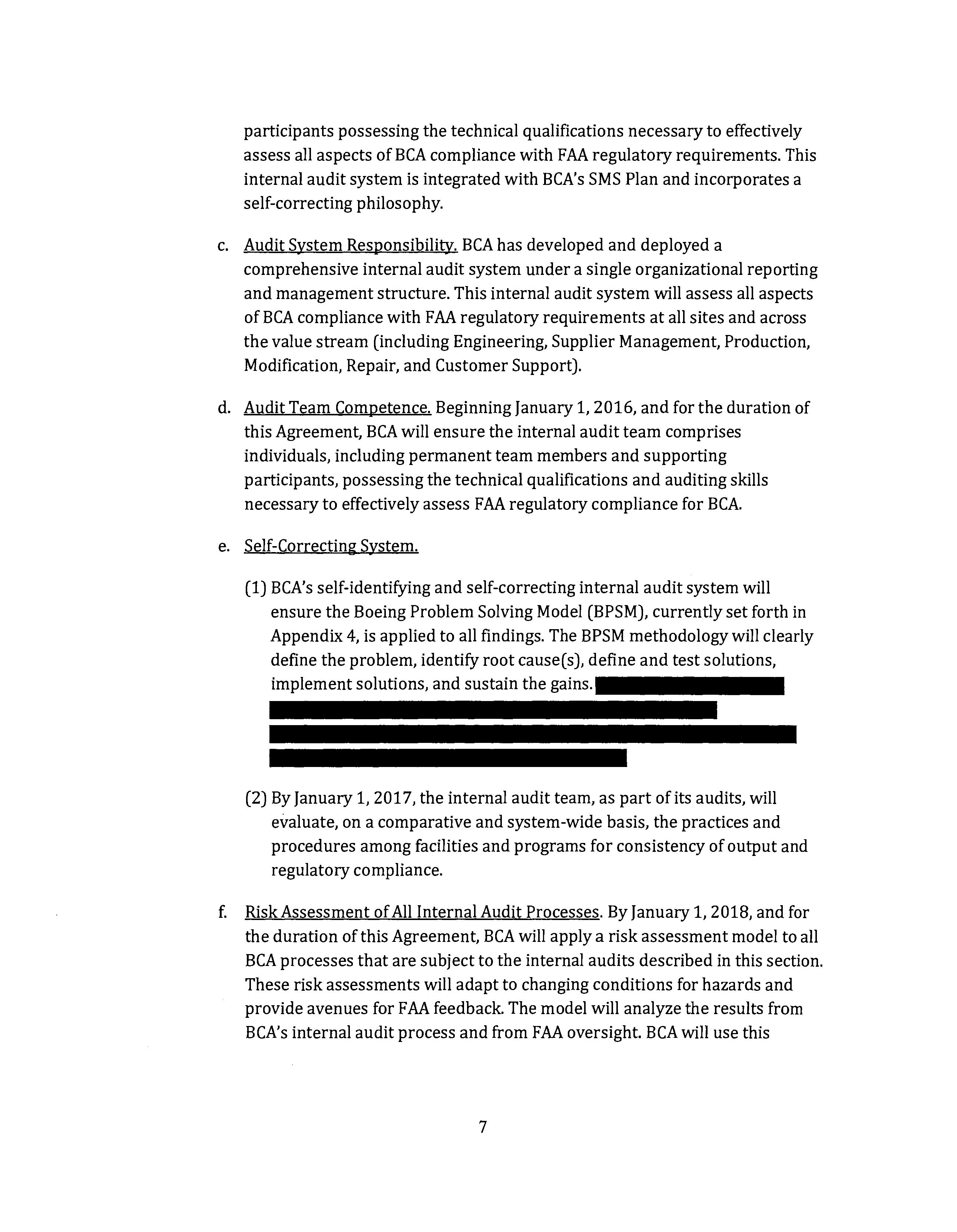
(2) By January 1, 2017, the internal auditteam, as part of its audits, will evaluate, on a comparative and system-wide basis, the practices and procedures among facilities and programs for consistency of output and regulatory compliance.
f. Risk Assessment of All Internal Audit Processes. By January 1, 2018, and for the duration of this Agreement, BCA will apply a risk assessment model to all BCA processes that are subject to the internal audits described in this section. These risk assessments will adapt to changing conditions for hazards and provide avenues for FAA feedback. The model will analyze the results from BCA's internal audit process and from FAA oversight. BCA will use this
7 EXHIBIT A, p. 054 Ex. 1, p. 007
information to help identify and correct issues and enhance its internal audit process.
g. Performance Indicators. By January 1, 2016, BCA will provide the FAA with a baseline effectiveness measurement of the internal audit system as related
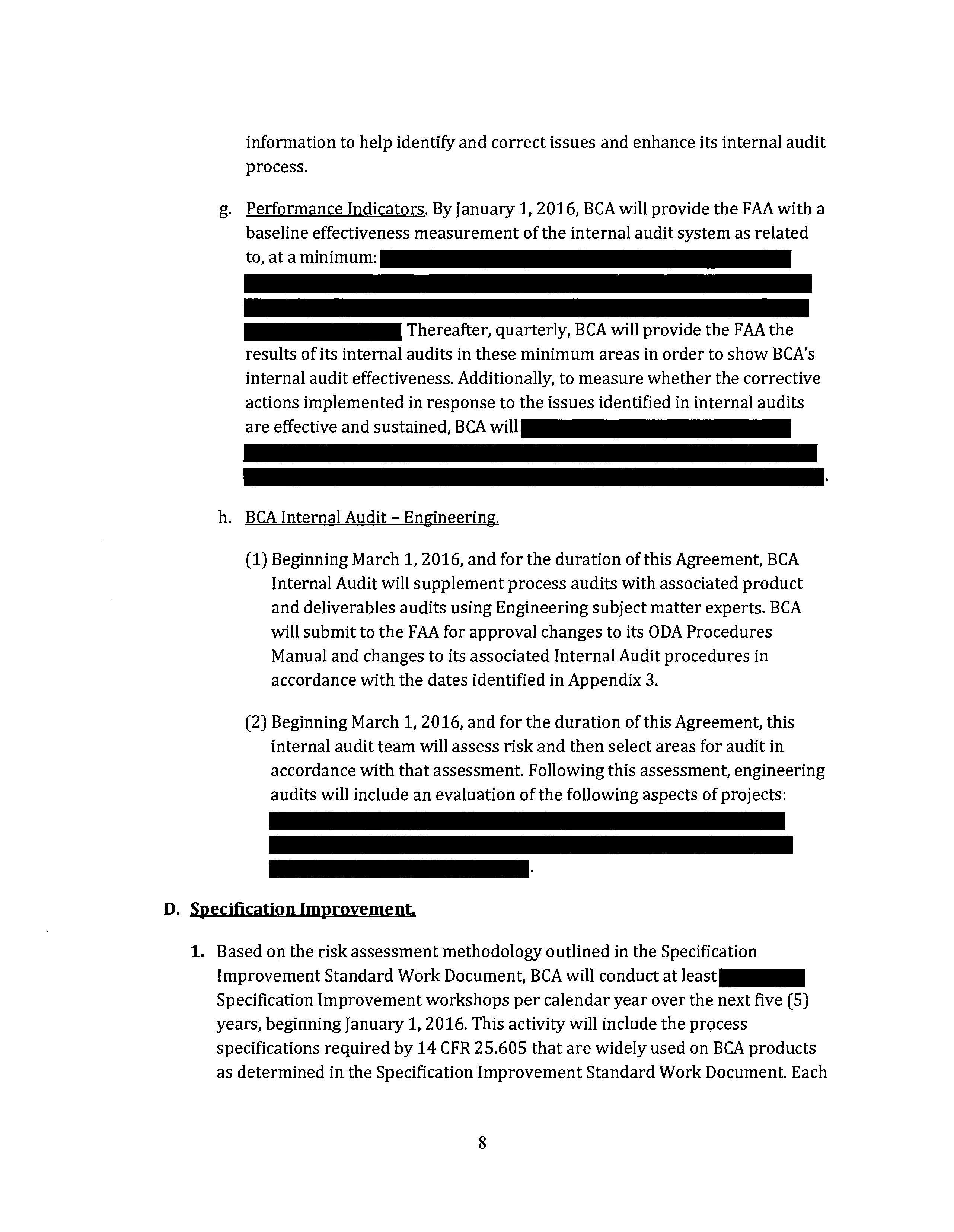
Thereafter, quarterly, BCA will provide the FAA the results of its internal audits in these minimum areas in order to show BCA's internal audit effectiveness. Additionally, to measure whether the corrective actions implemented in response to the issues identified in internal audits are effective and sustained, BCA will
h. BCA Internal Audit - Engineering.
(1) Beginning March 1, 2016, and for the duration of this Agreement, BCA Internal Audit will supplement process audits with associated product and deliverables audits using Engineering subject matter experts. BCA will submit to the FAA for approval changes to its ODA Procedures Manual and changes to its associated Internal Audit procedures in accordance with the dates identified in Appendix 3.
(2) Beginning March 1, 2016, and for the duration of this Agreement, this internal audit team will assess risk and then select areas for audit in accordance with that assessment. Following this assessment, engineering audits will include an evaluation of the following aspects of projects:
D. Specification Improvement.
1. Based on the risk assessment methodology outlined in the Specification Improvement Standard Work Document, BCA will conduct at leastSpecification Improvement workshops per calendar year over the next five (5) years, beginning January 1, 2016. This activity will include the process specifications required by 14 CFR 25.605 that are widely used on BCA products as determined in the Specification Improvement Standard Work Document. Each
8 EXHIBIT A, p. 055 Ex. 1, p. 008
workshop will pertain to a specific specification chosen, based on the above risk assessment or business need, and will result in an improved specification to · submit into the release process (per ) for use in design, build, delivery and support of BCA products. BCA will notify the FAA regarding its findings.
a. Upon request, improved specifications highlighting the changes will be provided to the FAA. The improvement process is not intended to change the technical content or intent of the standard; however, if technical changes are incorporated, the specification will be submitted to the FAA for review and comment through the release process that exists as of the date of execution of this Agreement.
b. Risk assessment of these standards is and will continue to be based on

2. By January 1, 2016, BCA will document in a local work instruction the detailed steps to reflect the controls needed for the initiation and maintenance of the improved specifications and how to conduct these workshops. By the same date, BCA will review any changes to- that may be necessary to carry out this paragraph.
3. Findings resulting from these workshops will support the development of specification writing style guides and checklists to be used upon creation and revision of all specifications. Each specification will be required to adhere to the requirements outlined in the style guide prior to release. BCA will also change any command media that provides guidance on how to write a BCA specification for commercial airplanes to reflect the controls needed for the initiation and maintenance of the improved specifications that are developed in these workshops.
E. First Article Verification.
1. 9 EXHIBIT A, p. 056 Ex. 1, p. 009

All changes to such procedures and processes will go through FAA review prior to release for the duration of this Agreement. This process will apply to all new or major changed installations as defined by 14 CFR 21.93(a) and (b).
2. BCA will deploy the improved FAV processes across BCA no later than the beginning of January 2017.
F. Problem Solving and Sustainment.
1. Boeing Problem Solving Model (BPSM). BCA has adopted the BPSM. The BPSM is attached to, and part of, this Agreement as Appendix 4.
a. Upon execution of this Agreement, BCA will use the BPSM to analyze all allegations of regulatory noncompliance identified in Letters Of Investigation (LOis), Letters Of Acknowledgment (LOAs), Surveillance Evaluation Records (SERs), Notifications of Airworthiness Noncompliance, and Safety Issues as determined by Boeing or the FAA for the affected airplane model(s), prior to the closure of the corrective action. For purposes of this Agreement, Boeingidentified safety issues are those identified by the Boeing Safety Review Board (SRB).
b. Beginning January 1, 2016, and for the duration of this Agreement, BCA will apply the BPSM to properly identify the root cause of each allegation and safety issue associated with the conditions identified in paragraph F.1.a, and use that root cause determination to address the noncompliance or safety issue and develop actions intended to prevent similar noncompliances or safety issues in the future.
c. BCA will make summaries of the BPSM analyses, and related BPSM documents, available to the FAA upon request. BCA will make available to the FAA upon request any additional information related to the problem statement, root cause(s), proposed/tested solutions, and sustain the gains activity.
2. Pre-coordination. Beginning January 1, 2016, and for the duration of this agreement, if BCA needs clarification about any of the alleged violations or the requirements being referenced in the documents in paragraph F.1.a, BCA may,
IO EXHIBIT A, p. 057 Ex. 1, p. 010
within the three (3) business days after the date of receipt of that document, request a clarification meeting with the FAA. The FAA will use its best efforts to support such a meeting.
G. Accuracy of Stamping and Other Verifications.
1. Engineering Quality. For the duration of this Agreement, BCA will adopt processes sufficient to self-assess the compliance and timeliness of its applicant compliance submissions, and accountability of those persons making such

2. Root Causes. As of the date of execution of this Agreement, BCA will apply the BPSM
BCA Supplier Quality will ensure the BPSM or a similar structured problem-solving methodology is applied to all stamping violations.
3. Training.
a. Stamping Accountability Training. BCA has adopted a training course on stamping accountability for all BCA manufacturing and quality employees with stamping authority. , "stamping" consists of either of the following:
(1) Electronic Stamp -A computing access account assigned and traceable to an individual responsible for its use within computing applications as an indicator of process status or completion on product record; or
(2) Physical Stamp - Any stamp assigned and traceable to an individual responsible for its use to apply an impression on process, products, or product records as an indicator of process status or completion.
This course has been reviewed and accepted by the FAA. BCA will make this training mandatory for all manufacturing and quality employees, with a mandatory completion date of July 31, 2016. BCA will thereafter require mandatory recurring training to all BCA manufacturing and quality employees with stamping authority on a frequency of least every 24 months.
11 EXHIBIT A, p. 058 Ex. 1, p. 011
b. BCA Supplier Management and Supplier Quality has sent a letter to its supply base stating the expectations and key messages around stamping and records accuracy for these suppliers to communicate to their workforces with a completion date of December 31, 2015. (BCA provided a draft copy of the letter to the FAA for comment and input prior to its release.)
c. Applicant Compliance Training. Within 180 days of execution of this Agreement, BCA will propose to the FAA a training course for employees on compliance and incorporate any changes requested by the FAA. Promptly following review of this course by the FAA, BCA will make such training mandatory for all BCA engineering employees, and require recurring mandatory training by such employees at least every twenty-four (24) months.
4. Verification.
a. During 2016 and each year thereafter during the term of this Agreement, BCA will conduct at least- internal audits of each product line and at least. internal audit of each Boeing PC 700 fabrication site. Based on those audit results, BCA will, , conduct risk assessments, and then will adjust future audit frequency and subject matter

b. BCA Supplier Quality has added stamping audit criteria to its supplier audits and deployed these criteria across the entire BCA supply base for use during scheduled audits.
c. All incidences of improper stamping will be investigated and, if substantiated
d. The results of these audits and assessments will be provided to the FAA upon request.
e. When requested, BCA will also submit to the FAA all findings regarding improper stamping,
f. Beginning one year after the date of execution of this Agreement, and for the duration of this Agreement, BCA will have no repeat findings of improper stamping, as documented in correspondence from the Boeing Certificate Management Office (CMO). For the purposes of this Agreement, a repeat
12 EXHIBIT A, p. 059 Ex. 1, p. 012
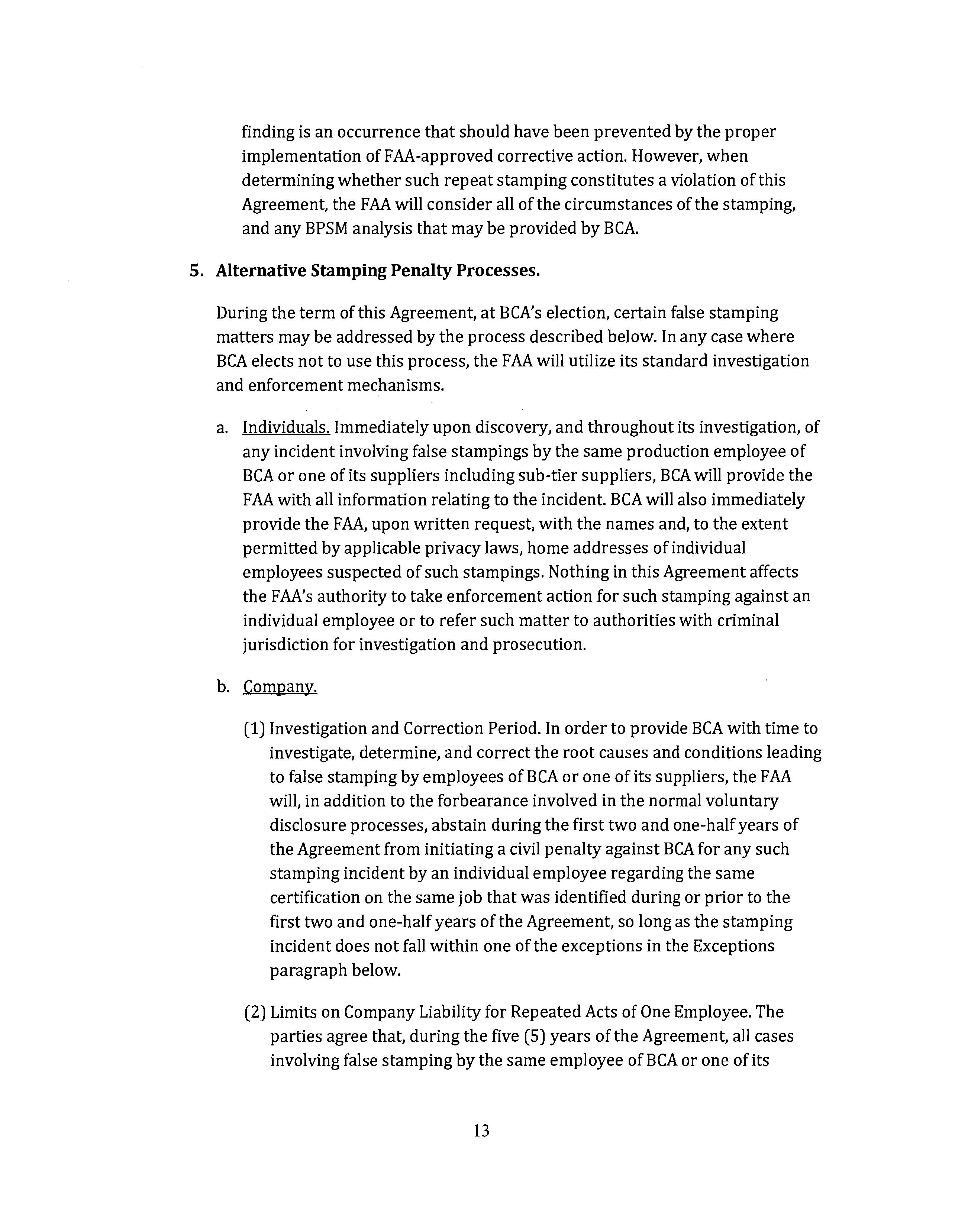
finding is an occurrence that should have been prevented by the proper implementation of FAA-approved corrective action. However, when determining whether such repeat stamping constitutes a violation of this Agreement, the FAA will consider all of the circumstances of the stamping, and any BPSM analysis that may be provided by BCA.
5. Alternative Stamping Penalty Processes.
During the term of this Agreement, at BCA's election, certain false stamping matters may be addressed by the process described below. In any case where BCA elects not to use this process, the FAA will utilize its standard investigation and enforcement mechanisms.
a. Individuals. Immediately upon discovery, and throughout its investigation, of any incident involving false stampings by the same production employee of BCA or one of its suppliers including sub-tier suppliers, BCA will provide the FAA with all information relating to the incident. BCA will also immediately provide the FAA, upon written request, with the names and, to the extent permitted by applicable privacy laws, home addresses of individual employees suspected of such stampings. Nothing in this Agreement affects the FAA's authority to take enforcement action for such stamping against an individual employee or to refer such matter to authorities with criminal jurisdiction for investigation and prosecution.
b. Company.
(1) Investigation and Correction Period. In order to provide BCA with time to investigate, determine, and correct the root causes and conditions leading to false stamping by employees of BCA or one of its suppliers, the FAA will, in addition to the forbearance involved in the normal voluntary disclosure processes, abstain during the first two and one-half years of the Agreement from initiating a civil penalty against BCA for any such stamping incident by an individual employee regarding the same certification on the same job that was identified during or prior to the first two and one-half years of the Agreement, so long as the stamping incident does not fall within one of the exceptions in the Exceptions paragraph below.
(2) Limits on Company Liability for Repeated Acts of One Employee. The parties agree that, during the five (5) years of the Agreement, all cases involving false stamping by the same employee of BCA or one of its
13 EXHIBIT A, p. 060 Ex. 1, p. 013
suppliers making the same certification on the same job, shall be treated as follows, so long as the stamping does not fall within one of the exceptions in the Exceptions paragraph below.
(i) Expedited Process. After the normal LOI and response process, representatives of the FAA and BCA shall meet to discuss the sanction for the false stampings.
(ii) Liquidated Penalty. After said meeting, the FAA will notify BCA of the liquidated penalty, which shall not exceed the amounts set forth in the following table. These amounts are separate from the deferred penalty under this Agreement. BCA shall pay the FAA this liquidated amount, electronically, within 30 calendar days.

c. Exceptions. The relief provided to BCA in the two paragraphs above does not apply if the stamping:
(1) Was caused wholly or in part by a failure to properly apply FAA-approved corrective action; or
(2) Was itself a cause, in whole or in part, of an airworthiness directive (AD); or
(3) Was the result of pressure from another employee with apparent or actual authority to direct the employee.
H. Quality of Submissions.
1. Certification Plans and Compliance Deliverables. During 2016, at least - .) percent of all Certification Plans that BCA submits to the FAA (not including the ODA) for the first time ("first pass") will be considered to be "first-pass quality." For the purpose of this Agreement, "first-pass quality" means
Number
Minimum Civil Penalty Maximum Penalty
$18,750 $100,000
of False Stampings
1-10
11-1000 $100,000 $1,000,000 1001-2500 $500,000 $2,000,000 >2,500 $2,000,000 $5,000,000
14 EXHIBIT A, p. 061 Ex. 1, p. 014
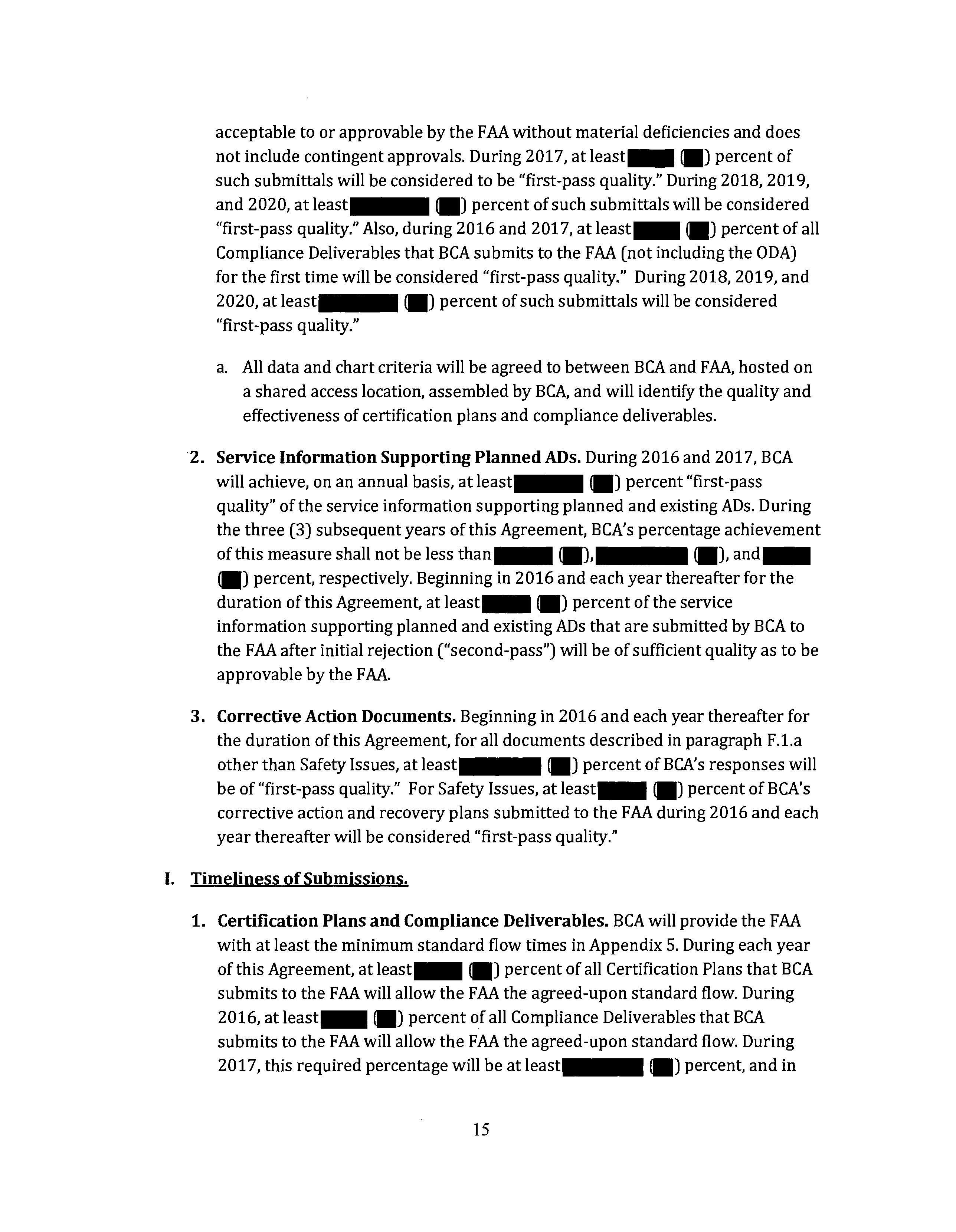
acceptable to or approvable by the FAA without material deficiencies and does not include contingent approvals. During 2017, at least- .) percent of such submittals will be considered to be "first-pass quality." During 2018, 2019, and 2020, at least- (II) percent of such submittals will be considered "first-pass quality." Also, during 2016 and 2017, at least- .) percent of all Compliance Deliverables that BCA submits to the FAA (not including the ODA) for the first time will be considered "first-pass quality." During 2018, 2019, and 2020, at least- .) percent of such submittals will be considered "first-pass quality."
a. All data and chart criteria will be agreed to between BCA and FAA, hosted on a shared access location, assembled by BCA, and will identify the quality and effectiveness of certification plans and compliance deliverables.
2. Service Information Supporting Planned ADs. During 2016 and 2017, BCA will achieve, on an annual basis, at least- .) percent "first-pass quality" of the service information supporting planned and existing ADs. During the three (3) subsequent years of this Agreement, BCA's percentage achievement of this measure shall not be less than-.).-.). and.) percent, respectively. Beginning in 2016 and each year thereafter for the duration of this Agreement, at least- .) percent of the service information supporting planned and existing ADs that are submitted by BCA to the FAA after initial rejection ("second-pass") will be of sufficient quality as to be approvable by the FAA.
3. Corrective Action Documents. Beginning in 2016 and each year thereafter for the duration of this Agreement, for all documents described in paragraph F.1.a other than Safety Issues, at least- .) percent of BCA's responses will be of "first-pass quality." For Safety Issues, at least-.) percent of BCA's corrective action and recovery plans submitted to the FAA during 2016 and each year thereafter will be considered "first-pass quality."
I. Timeliness of Submissions.
1. Certification Plans and Compliance Deliverables. BCA will provide the FAA with at least the minimum standard flow times in Appendix 5. During each year of this Agreement, at least- .) percent of all Certification Plans that BCA submits to the FM will allow the FAA the agreed-upon standard flow. During 2016, at least-.) percent of all Compliance Deliverables that BCA submits to the FM will allow the FAA the agreed-upon standard flow. During 2017, this required percentage will be at least- .) percent, and in
15 EXHIBIT A, p. 062 Ex. 1, p. 015

2018, 2019, and 2020, at least- (II) percent. Beginning January 1, 2016, and for the duration of this Agreement, BCA will submit at least- (II) percent of each month's proposed revisions to these documents in time to allow the FAA at least the standard flow times in Appendix 5.
a. All data and chart criteria will be agreed to between BCA and FAA, hosted on a shared access location, assembled by BCA and will identify the timeliness performance of certification plans and compliance deliverables.
2. Service Information Supporting Planned ADs. During 2016, BCA will submit at least- (II) percent of service information (SI) supporting planned and existing ADs within the time period agreed upon in each Si's End-to-End Agreement. During 2017, at least- (II) percent of such information shall be submitted within the time period agreed upon in each Si's End-to-End Agreement. During 2018, 2019, and 2010, at least- (II) percent of such information shall be submitted within the time period agreed upon in each Si's End-to-End Agreement. If any SI is rejected, the SACO or LAACO, as appropriate, will jointly re-plan a resubmittal date with BCA and BCA will submit an approvable SI within that time at least- (II) percent of the time, beginning in 2016 and each year thereafter for the duration of this Agreement. If BCA and the FAA fail to reach agreement on an End-to-End Agreement for a safety issue, the FAA will specify an End-to-End schedule in a 14 CFR 183.63(d) letter requesting SI to support its planned AD, and use such schedule to calculate BCA's on-time performance.
3. Corrective Action Documents. This paragraph describes the timeliness requirements for BCA's submittal of the items identified in paragraph F.1.a, above, other than LOAs.
a. During each year of this Agreement, BCA will submit at least- (II) percent of all corrective action response documents required to be submitted to the Boeing CMO within the deadline identified by the FAA.
b. During 2016, BCA will submit at least- (II) percent of all corrective action response documents required to be submitted to the Boeing Aviation Safety Oversight Office (BASOO) within the deadline identified by the FAA. During each subsequent year of this Agreement, BCA shall improve this percentage by at least. percent per year, i.e.,- (II) percent in 2017, (II) percent in 2018,- (II) percent in 2019, and- (II) percent in 2020.
16 EXHIBIT A, p. 063 Ex. 1, p. 016

c. Boeing will submit all corrective action responses to Part 25 Notifications of Airworthiness Noncompliance in accordance with its ODA Procedures Manual.
d. During 2016, BCA will submit at least- .) percent of all Safety Issue documents within the deadline identified by the FAA. During each subsequent year of this Agreement, BCA will submit at least- .) percent of all Safety Issue documents within the deadline identified by the FAA.
e. A submission subject to this section shall be deemed timely if it is submitted no later than a deadline that is extended by the FAA.
4. For purposes of assessing BCA's timeliness performance under this Section I, delays attributable to FAA actions (including changed requirements or directions, or exceedance of agreed-to turnaround times) will not be counted toward the deadlines established in Section I or Appendix 5.
The following two tables graphically represent BCA's commitments with regard to these Sections H and I. In the event of a discrepancy between the table and the above text, the text controls.
17 EXHIBIT A, p. 064 Ex. 1, p. 017
Certification Plans
Compliance Deliverables
SI for Pl. ADs (1st Pass)
SI for Pl. ADs (2d Pass)
C.A. except Safety
Safety Root Cause Documents
Quality

Timeliness
Certification Plans
Compliance Deliverables
Service InformationInitial Submittal
Service InformationResubmittal
C.A. to CMO
C.A. to BASOO
C.A. for Part 25 N/Cs
Safety Issues
2016 2017 2018 2019 2020
• • • • •
• • • • • • • • • •
• • • • •
• • • • •
• • • • •
2016 2017 2018 2019 2020
• • • • •
• • • • •
• • • • •
• • • • •
• • • • •
• • • • • Per Per Per Per Per
ODAPM ODAPM ODAPM ODAPM ODAPM
• • • • • 18 EXHIBIT A, p. 065 Ex. 1, p. 018
J. Audits ofBCA Suppliers for Acceptance of Work Performed.
1. As of March of 2015, there were a total of 434 category 1 and 2 parts suppliers for BCA. BCA will develop, submit for FAA CMO approval, and implement a plan to audit at least. (1111) percent of these suppliers. These audits will determine whether any of BCA's suppliers are accepting work that is not complete, and whether any such improper acceptance is systemic.
2. BCA's-suppliers will be subject to these audits without regard to whether their relationship with BCA is direct or indirect. (Indirect suppliers are those who have a contract with a BCA direct supplier and not directly with BCA.) In addition to the 434 category 1 and 2 parts suppliers, BCA may include in these audits those sub-tier suppliers that are responsible for major components of the build process.
3. BCA will conduct these audits in two phases: an initial audit of. (1111) suppliers, and then, after BCA and the FAA assess the methodology and results of those initial. (II) audits, an audit of the remainder of the. (II) percent of BCA suppliers required by this section to be audited.
4. By October 1, 2015, BCA had submitted its plan for conducting these audits to the FAA for approval. BCA's supplier audit plan:
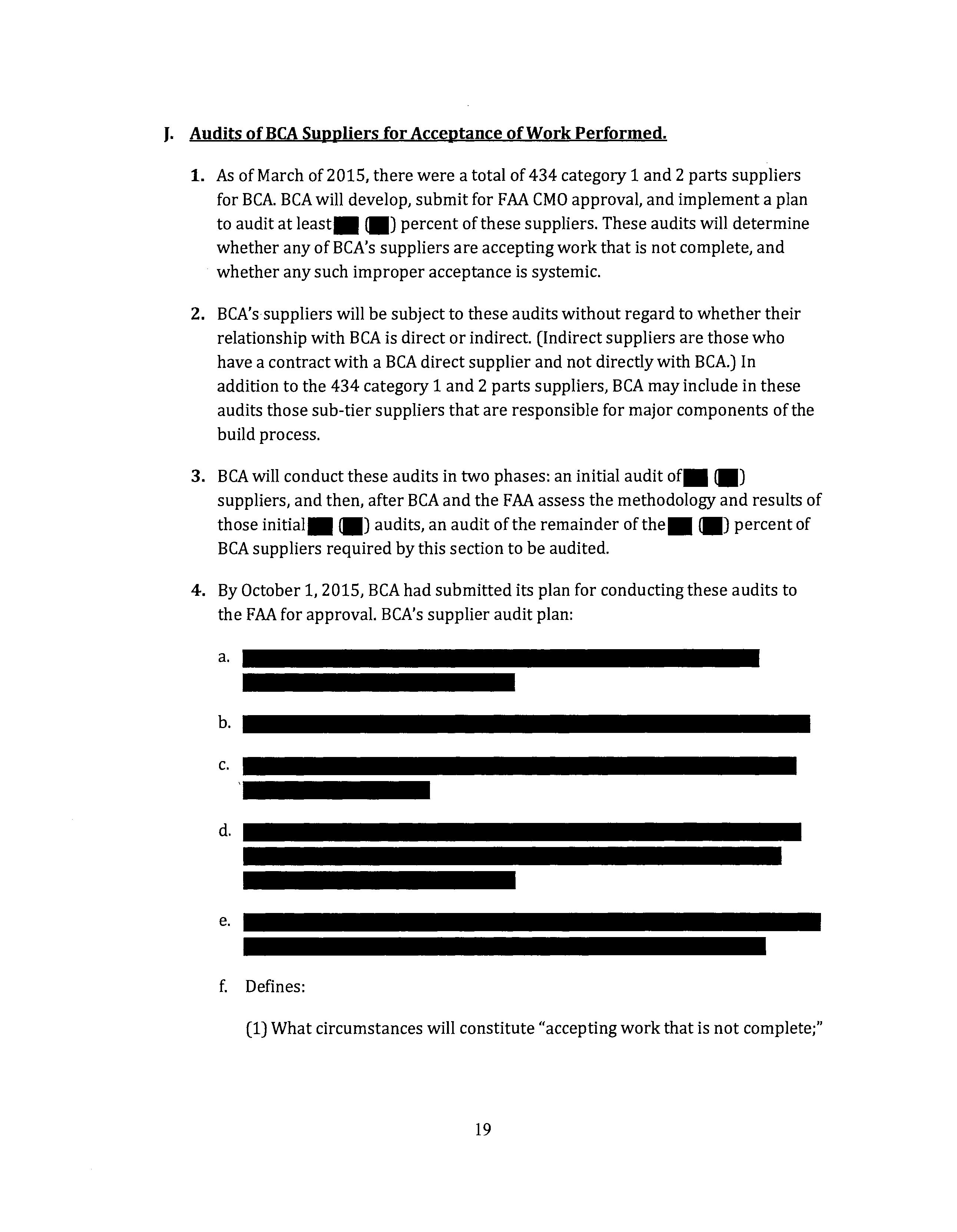
f. Defines:
(1) What circumstances will constitute "accepting work that is not complete;"
a. b. C. d. e.
19 EXHIBIT A, p. 066 Ex. 1, p. 019

(2) What auditing methods and tools Boeing will use to find these circumstances;
(3) How BCA will document the audit activity and findings;
(4) How BCA will administer immediate corrections;
(5) How BCA will conduct root cause analysis, identify common causes and systemic issues;
(6) How BCA will implement root cause and systemic corrective actions; and
(7) How BCA will follow up to verify corrective action effectiveness and sustainment.
5. BCA will not initiate these audits until after the FAA has approved its supplier audit plan. The FAA may override any part of the supplier plan, including but not limited to its methodology, the suppliers to be audited, or the selected parts.
6. By June 1, 2016, BCA will present to the FAA for agreement:
a. The results from the initial. audits;
b. BCA's analysis on whether its risk-based method was either validated or adjusted; and
c. Based on the validated or adjusted risk method, BCA's proposal for the identity of the remaining suppliers to be audited, and the method of conducting those audits.
7. By January 5, 2017, BCA will complete the remaining audits.
8. By January 5, 2017, BCA will have identified audit findings and completed root cause analysis on a suitable sample of findings to allow identification of systemic issues and recommended corrective actions.
9. By March 1, 2017, BCA will present to the FAA the results of the audits, root cause analysis, identification of systemic issues and recommended solutions.
10.By June 1, 2017, BCA will present to the FAA a summary of corrective action implementation. This meeting may need to be repeated on a periodic basis until all corrective actions have been implemented or the FAA agrees that review is no longer necessary.
20 EXHIBIT A, p. 067 Ex. 1, p. 020

11.lf adjustments to this schedule are needed, BCA must present the proposed schedule to the FAA for approval, and include a rationale for the proposed schedule change.
12. The FAA may attend any portion of the audits with suitable prior notice.
K. Sustained Effectiveness of Implemented Letter of Investigation (LOI) Corrective Actions.
To measure whether the corrective actions implemented in response to FAAissued letters of investigation remain effective, BCA will conduct a follow-up corrective action verification within one year following initial implementation of the corrective action. (This will include an assessment of the corrective actions put in place to address improper stamping issues.)
L. Compliance Reporting.
1. Method. Unless otherwise noted, BCA must promptly make the reports noted below in writing, to the manager of the TAD or his or her designee.
2. On-Demand Reports. BCA will promptly provide, upon the FAA's reasonable and good faith request, any documentation relating to BCA's performance of the terms of this Agreement.
3. Annual Comprehensive Reports. By January 15 of the years 2017, 2018, 2019, and 2020, BCA will produce an Annual Comprehensive Report on BCA's regulatory compliance activities and performance, including the continued effectiveness of the implementation of corrective action, according to each section of the above BCA obligations, during the entirety of the preceding calendar year. BCA will provide this report to its CEO and to the FAA.
4. Final Compliance Report. In lieu of an Annual Comprehensive Report for calendar year 2020, by October 15, 2020, BCA will provide a Final Compliance Report to the FAA with BCA's status with regard to the fulfillment of its obligations under the terms of this Agreement.
Final determination of whether BCA has complied with the terms and conditions of this Agreement shall be made by the Administrator of the FAA or his or her designated representative, in accordance with the provisions of Part II, Sections B and C.
Any approvals from the FAA required by this Agreement shall not be unreasonably withheld; and, to the extent such approvals are given after a period of review that
21 EXHIBIT A, p. 068 Ex. 1, p. 021

materially impairs BCA's ability to meet subsequent deadlines set forth in the sections above, the relevant deadlines shall be extended to reflect the duration of that period of review.
II. PAYMENT AND DEFERRAL OF CIVIL PENALTIES.
A. BCA agrees to pay a civil penalty in the amount of $12,000,000.00 upon execution of this Agreement. As stated in Part III of this Agreement, the FAA agrees not to pursue the recovery of additional civil penalties against BCA in the pending cases that are the subject of this Agreement.
B. In the event that BCA does not meet its commitments under this Agreement, BCA and the FAA agree that BCA shall be subject to additional civil penalties up to $ 24,000,000.00 . Such potential penalties are deferred, subject to the terms of Part II, Section C herein.
C. The FAA will review the reports from BCA required by Part I, Section L, of this Agreement and, using that or other relevant information, periodically and within eight (8) weeks ofreceiving each Annual Comprehensive Report, will advise BCA whether the FAA is satisfied with BCA's actions to fulfill the company's obligations as of such date pursuant to this Agreement. If the FAA identifies any area in which it is dissatisfied with BCA' s performance of its commitments in this Agreement, it will advise BCA in writing of its reasons and provide BCA with twenty (20) business days to respond. In its required response, BCA may request an opportunity to cure any deficiency noted by the FAA. Such request must be in writing and include a plan, description of expected necessary resources, and schedule for accomplishing the cure. The FAA will evaluate BCA's response, including any request to cure. The FAA may approve or reject the request, in whole or in part.
1. If the FAA rejects the request, in whole or in part, the FAA will notify BCA of its final determination in writing, and in its sole discretion may assess a financial penalty that constitutes a portion of the potential deferred penalty amount set forth in Part II, Section B, in an amount that the FAA reasonably and in good faith determines is proportionate to BCA's performance deficiency relative to its obligations to be achieved as of such date pursuant to this Agreement and the total remaining deferred penalty amount that could be assessed against BCA.
2. If, however, the FAA approves or modifies one or more of BCA's requested cures, the FAA will evaluate, at times of its choosing, BCA's success in curing its deficient performance. If the FAA determines that BCA's performance is not in compliance with BCA's cure obligation under this Agreement, the FAA will notify
22 EXHIBIT A, p. 069 Ex. 1, p. 022

BCA of its final determination in writing and in its sole discretion may assess a financial penalty that constitutes a portion of the potential deferred penalty amount set forth in Part II, Section B, in an amount that the FAA reasonably and in good faith determines is proportionate to BCA's performance deficiency relative to its obligations to be achieved as of such date pursuant to this Agreement and the total remaining deferred penalty that could be assessed againstBCA
D. BCA will pay any such penalty amount within thirty (30) calendar days following receipt of the FAA's final written determination. The FAA may assess BCA multiple such penalties for failure to comply with its obligations pursuant to this Agreement, but notwithstanding any other provision in this agreement, the total penalty for any BCA failures of performance that occur between January 1, 2016 and June 30, 2018 shall not exceed fifty (SO) percent of the total deferred penalty amount, and the total penalty for any failures of performance that occur between July 1, 2018 and December 31, 2020 shall also not exceed fifty (SO) percent of the total deferred penalty amount. Any such penalties assessed will be reasonable, in good faith, and considered in light of the totality of BCA's performance of its several obligations under this Agreement. BCA has no rights whatsoever of administrative or judicial review of or appeal from the FAA's determination and assessment of the amount of the deferred civil penalty BCA shall pay due to its failure to fulfill any obligation pursuant to this Agreement. However, to ensure clarity, understanding, and coordination, the FAA agrees that the FAA's Chief Counsel will be available to discuss, if requested, with Boeing's Vice President and Assistant General Counsel for BCA the rationale for and reasonableness of any proposed penalty for BCA's failure to comply with this Agreement, prior to the FAA's final assessment of such penalty.
E. BCA shall pay all civil penalties under this Agreement by electronic funds transfer to the United States of America. The Regional Counsel's office of the FAA's Northwest Mountain Region will provide BCA with written wire-transfer instructions upon execution of this Agreement.
III. OBLIGATIONS OF THE FAA.
In consideration of the agreements and corrective actions set forth herein, and except for such obligations as are created by this Agreement, the FAA hereby waives, releases and will refrain from instituting, prosecuting, or maintaining any civil penalty action arising from the EIRs in the thirteen (13) pending cases referenced above.
23 EXHIBIT A, p. 070 Ex. 1, p. 023

IV. MISCELLANEOUS PROVISIONS.
A. Term. The terms and conditions of this Agreement will be effective as of January 1, 2016, and will continue for a period of five (5) years from that date, unless extended in a written agreement signed by the FAA's Chief Counsel and Boeing's Vice President and Assistant General Counsel for BCA.
B. Deviations and Noncompliances Unauthorized. Nothing in this Agreement allows BCA to deviate from the approved Type Design or Production Certificate processes. Nothing in this Agreement authorizes BCA to commit any regulatory noncompliance or nonconformance to the type design during any portion of the implementation of this Agreement. The approvals given by the FAA in this Agreement are not binding for any purpose outside of this Agreement. BCA will not modify any commitment made in this Agreement by modifying any internal procedure referenced in this Agreement, without prior approval from the FAA
C. Scope. The FAA and BCA agree that all instances of statutory or regulatory noncompliance by BCA that are voluntarily disclosed by BCA about which the FAA does not have knowledge independent of such reports will be evaluated by the FAA in accordance with the FAA's Reporting and Correction Policy, set forth in FAA Order 2150.3B, Compliance/Enforcement Bulletin 92-2, and Advisory Circular 00-58B.
D. Avoidance of Duplicative Penalties. The FAA and BCA recognize that regulatory violations by BCA other than the pending cases, may result in additional enforcement action against BCA, provided that the FAA agrees it will not use a failure to comply with a provision in this Agreement, as the basis for both a penalty imposed under this Agreement and an independent, separate enforcement action. In other words, if the breach of the Agreement is also itself a regulatory violation, the FAA will elect to pursue it as either a breach of the Agreement triggering payment of some or all of the deferred civil penalty set forth in Section II, Parts B-D or a regulatory violation, but not both.
E. The terms of this Agreement do not apply to any matter concerning BCA's qualifications to hold and exercise the privileges of Production Certificate No. 700 and do not constitute a waiver by the FAA of any statutory responsibility.
F. No Further Notice. BCA waives any and all rights to further notice of the allegations contained in the EIRs listed above.
G. Waiver of Appeal Rights. BCA waives any right to appeal or otherwise seek administrative or judicial review of this Agreement. The FAA and BCA acknowledge
24 EXHIBIT A, p. 071 Ex. 1, p. 024

that by executing this Agreement, BCA and its individual employees shall not be deemed to have waived any constitutional rights, including the right to counsel and legal privileges.
H. Enforcement. The FAA and BCA each reserve the right to judicially enforce any terms or provisions of this Agreement.
I. Applicability of FOIA. The parties agree that any release by the FAA in response to any requests from the public for this Agreement (including its Appendices) or related records will be governed by the Freedom of Information Act (FOIA). Boeing maintains that this Agreement and its supporting Appendices in total or in part contain trade secrets and information that is commercial or financial and privileged or confidential and therefore should be exempt from disclosure pursuant to FOIA requests. Accordingly, the FAA will notify Boeing of any request for public release of the aforementioned documents, and the FAA will consult with Boeing prior to any public release of the documents, or portions thereof, in a manner consistent with the FAA's current FOIA policies, procedures and the applicable law.
J. Completeness. The terms set forth in this Agreement shall constitute a full settlement and release of any and all civil penalties that have been, or could have been pursued against BCA as result of the alleged violations described in the thirteen (13) pending cases.
K. No Admissions. FAA and BCA agree that BCA's execution of this Agreement and payment of any civil penalty amount to the FAA pursuant to this Agreement do not constitute a finding of violation by the FAA or imply an admission of violation or other wrongdoing on the part of BCA In addition, this Agreement is being entered into for settlement and compromise purposes only, in accordance with Federal Rules of Evidence (FRE) Rule 408 and applicable state rules.
L. Implications for Future Cases. The FAA and BCA agree that the Administrator of the FAA may consider the allegations contained in the pending cases as a finding of violation history for the purpose of any future legal enforcement action arising from violations of the FAA governing statute or the FAA regulations by BCA.
M. Own Costs. Each party to this Agreement shall bear its own costs, including attorney fees.
N. Authority. The representatives of each party signing this Agreement pledge that they are duly authorized to do so on behalf of the Federal Aviation Administration or Boeing Commercial Airplanes.
25 EXHIBIT A, p. 072 Ex. 1, p. 025
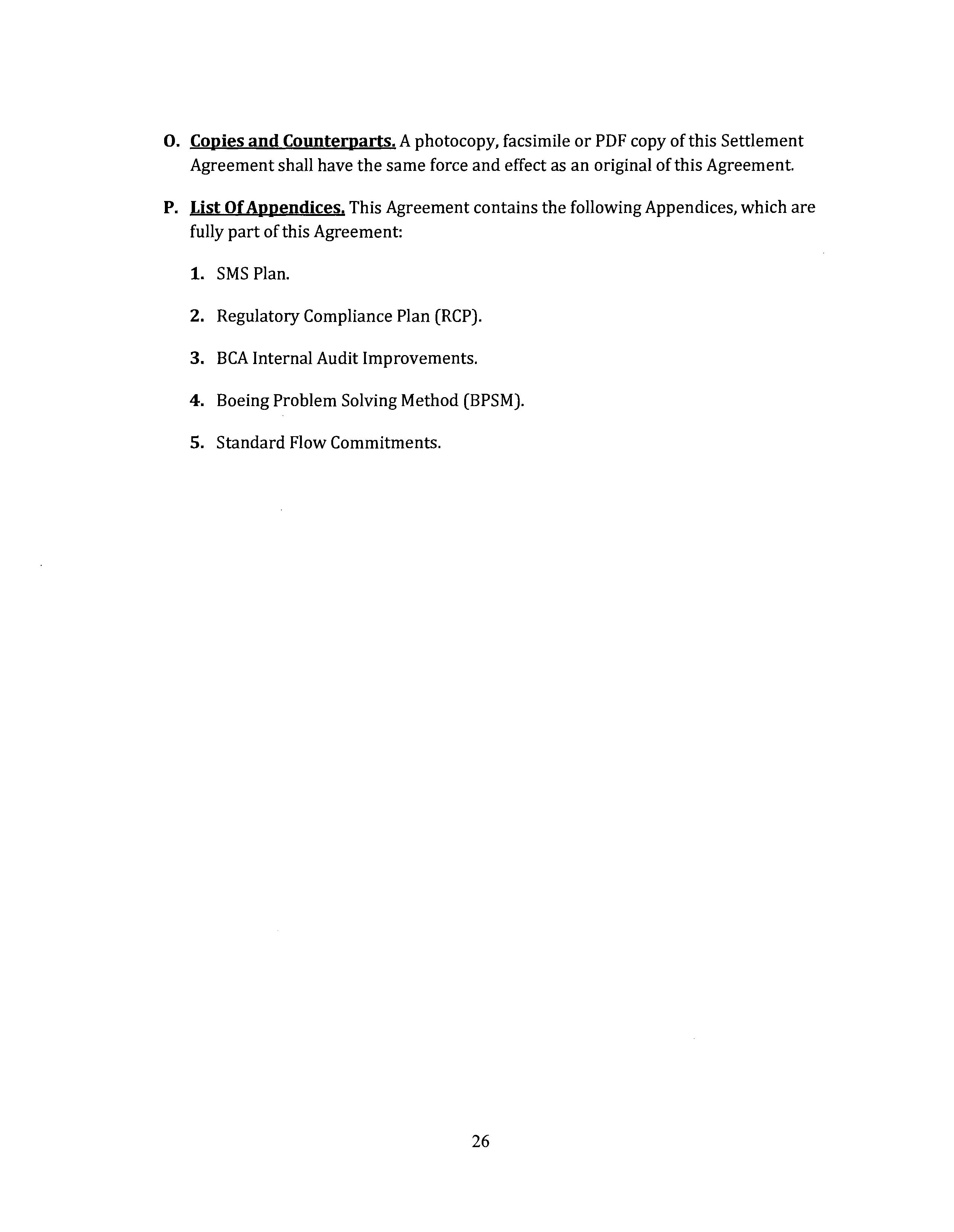
0. Copies and Counterparts. A photocopy, facsimile or PDF copy of this Settlement Agreement shall have the same force and effect as an original of this Agreement.
P. List Of Appendices. This Agreement contains the following Appendices, which are fully part of this Agreement:
1. SMS Plan.
2. Regulatory Compliance Plan (RCP).
3. BCA Internal Audit Improvements.
4. Boeing Problem Solving Method (BPSM).
5. Standard Flow Commitments.
26 EXHIBIT A, p. 073 Ex. 1, p. 026

Abbreviations
This Agreement, including its appendices, may use the following abbreviations:
AD - Airworthiness Directive
AR - Authorized Representative
BASOO- Boeing Aviation Safety Oversight Office
BCA - Boeing Commercial Airplanes
BPI - Business Process Instruction
BPSM - Boeing Problem Solving Method
CMO- Certificate Management Office
COS - Continued Operational Safety
EIR - Enforcement Investigative Report
FAA - Federal Aviation Administration
FAV - First Article Verification
FOIA - Freedom of Information Act
LAACO - Lost Angeles Aircraft Certification Office
LOA - Letter of Acknowledgment
LOI - Letter of Investigation
ODA - Organization Designation Authorization
PSD - Process Specification Departure
Q&M - Quality and Manufacturing
RCP - Regulatory Compliance Plan
SACO - Seattle Aircraft Certification Office
SER - Surveillance Evaluation Record
27 EXHIBIT A, p. 074 Ex. 1, p. 027

SI - Service Information
SMS - Safety Management System
SPC - Safety Promotion Center
SQ - Supplier Quality
SRB - Safety Review Board
SRP - Service-Related Problem
TAD - Transport Airplane Directorate
TARAM - Transport Airplane Risk Assessment Methodology
14 CFR-Title 14, Code of Federal Regulations
28 EXHIBIT A, p. 075 Ex. 1, p. 028
istration: ,.
Chief Counsel
FAA
Dated: _IJ_/_11_fa_o___ 1r I I
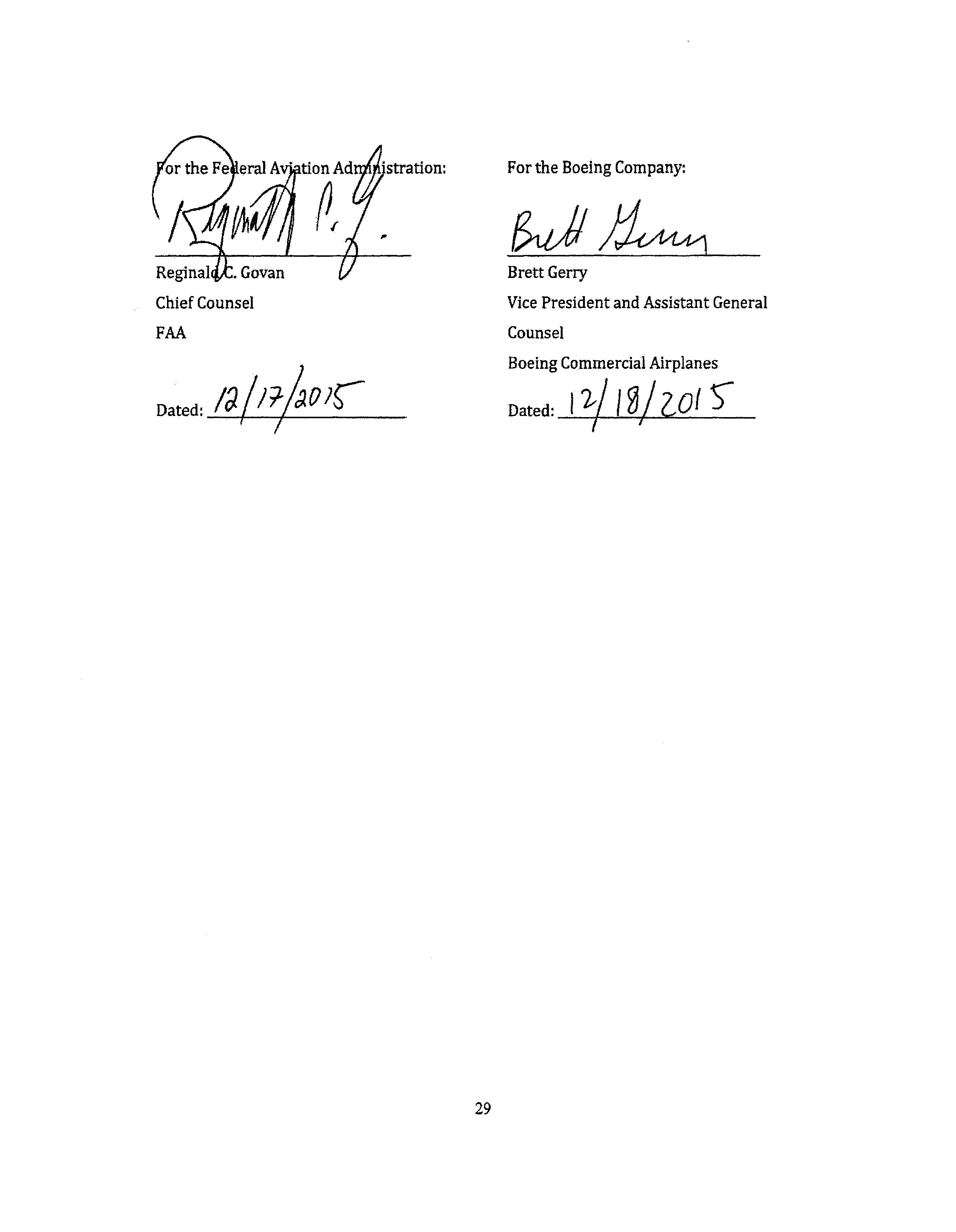
For the Boeing Company:
Brett Gerry Vice President and Assistant General Counsel
Boeing Commercial Airplanes
Dated: 1i/ /9/ zol S' 1
29 EXHIBIT A, p. 076 Ex. 1, p. 029
United States Department of Transportation
Federal Aviation Administration
Office of the Chief Counsel Enforcement Division
The Federal Aviation Administration (FAA or Agency) and The Boeing Company (Boeing) (collectively, “the Parties”) enter into this Settlement Agreement (Agreement) by and through their undersigned representatives to resolve the allegations documented in the following cases: 2019NM410003, 2020NM410001, and 2019NM420003.
RECITALS
WHEREAS, the FAA issued a civil penalty letter to Boeing in Case No. 2019NM410003 on December 6, 2019, indicating that the FAA would accept in settlement $3,916,871.00.
WHEREAS, the FAA issued a civil penalty letter to Boeing in Case No. 2020NM410001 on January 10, 2020, indicating that the FAA would accept in settlement $5,401,155.00.
WHEREAS, the FAA issued a civil penalty letter to Boeing in Case No. 2019NM420003 on March 6, 2020, indicating that the FAA would accept in settlement $19,682,200.00.
WHEREAS, the Parties agree that it is in the best interest of the FAA and Boeing to resolve Case Nos. 2019NM410003, 2020NM410001, and 2019NM420003, and both are willing to enter into this Agreement.
WHEREAS, the Parties wish to resolve the disputes that are the subject of this litigation without the expense and drain on resources that may be associated with protracted litigation.
WHEREAS, the Parties agree that it is in the best interest of the parties and the public to resolve these pending enforcement actions against Boeing.
WHEREAS, both Parties want Boeing to implement sustainable, enduring corrective actions that will address the root causes of the regulatory violations subject to this Agreement and prevent similar future violations.
WHEREAS, Boeing recognizes that regulatory compliance is critical to the quality, safety, and prompt delivery of its products. Boeing therefore has committed and is further committing, with this Agreement, to continue its efforts to improve its processes and practices for ensuring compliance with regulatory commitments.
NOW, THEREFORE, in consideration of the mutual covenants and payments described herein, the Parties hereby AGREE as follows:
1
EXHIBIT A, p. 077 Ex. 2, p.001
1. Civil Penalty Payments and Deferrals
1.1.
Mitigation of Civil Penalties
Consistent with FAA Order 2150.3C, which states that “corrective action is a mitigating factor when it exceeds regulatory or statutory requirements, corrects the underlying violation, and is designed to prevent future violations,” the FAA agrees to mitigate the civil penalties in Case Nos. 2019NM410003 and 2020NM410001 by a total of one million dollars ($1,000,000.00) for completion of the following corrective action:
Improvements to the Notice of Escapement (NoE) process relating to revisions to the U-40 note which have reduced the timelines for processing NoEs.
Based on documentation that Boeing provided to the FAA, including Aircraft Readiness Logs (ARLs), the Parties agree that thirty-two (32) of the one hundred and seventy-three (173) Boeing 737 MAX aircraft alleged in the civil penalty letter in Case No. 2019NM420003 contained sensors compatible with the applicable Sensor Interchangeability Specification and Supplemental Type Certificate. As a result, the FAA agrees to reduce the civil penalty by eight hundred twenty-one thousand four hundred forty-eight dollars ($821,448.00).
1.2. Payment of a Civil Penalty
Boeing agrees to pay a civil penalty of twenty seven million one hundred seventyeight thousand seven hundred seventy-eight dollars ($27,178,778.00) in resolution of Case Nos. 2019NM410003, 2020NM410001, and 2019NM420003.
$27,178,778.00 is the total amount listed in the civil penalty letters between the three cases, less the mitigation amounts in Section 1.1.
1.3.
Timing of Payment
Boeing agrees to pay seventeen million dollars ($17,000,000.00) of the civil penalty within 30 days of the date of the full execution of this Agreement.
Boeing agrees to pay this portion of the civil penalty per the terms of Section 3.4.
1.4.
Deferral of Payment
The FAA agrees that it will defer up to and including ten million one hundred seventy-eight thousand seven hundred seventy-eight dollars ($10,178,778.00) of the civil penalty if Boeing completes the corrective actions listed in Section 2 per the time limits and terms referenced throughout Section 2 and its paragraphs and subparagraphs. Further terms of the deferral are detailed in Section 3.
2
EXHIBIT A, p. 078 Ex. 2, p.002
2. Programmatic Obligations of Boeing and Corrective Actions
2.1. Comprehensive BPSM relating to shipments at risk
Within 90 days of the date of the full execution of this Agreement, perform a comprehensive review using the Boeing Problem Solving Model (BPSM) process of all Boeing processes and procedures relating to the control and use of parts shipped at risk from suppliers, including the Boeing Fabrication Division. For the avoidance of doubt, parts “shipped at risk” are parts subject to BAC or industry specifications requiring lot, batch, or part testing to ensure conformance that are shipped from the supplier when such testing is incomplete, pending, or failed.
Within 30 days of completion of the comprehensive review, provide the FAA with the completed BPSM including all investigation aspects and corrective actions identified to ensure that Boeing has robust process controls in place to eliminate nonconformances in aircraft presented for airworthiness certification or a Certificate of Export arising from parts shipped at risk from suppliers, including the Boeing Fabrication Division. Such process controls must identify the criteria for determining when stopping the practice of shipping specific parts at risk is the only reasonable and appropriate corrective action. With the exception of parts associated with open certification projects, or other categories of parts as agreed upon by the FAA, such process controls must also ensure that any parts shipped at risk are quarantined, and are not installed on any aircraft, unless and until Boeing determines that those parts conform to their approved design and are in a condition for safe operation.
Within 30 days of the FAA’s approval of the process controls identified in the BPSM referenced in Section 2.1, add provisions to the Boeing Quality Manual which describe the process controls developed, define parts “shipped at risk” as noted in the first paragraph of Section 2.1, and state that these process controls and any future revisions must be approved by the FAA Boeing Certificate Management Office (CMO).
2.2. Revisions to PRO-3907
Within 90 days of the date of the full execution of this Agreement, Boeing will, in coordination with the FAA, revise Procedure (PRO) 3907, “Notice of Escapement – Nonconforming Products” to address and mitigate the risk of aircraft with known or suspected nonconformances being presented for airworthiness certification or a Certificate of Export. The revisions will:
• Ensure that timely and appropriate positive controls are applied to identify, track, document, evaluate, and disposition known or suspected nonconforming products or articles produced by internal or external suppliers;
3
EXHIBIT A, p. 079 Ex. 2, p.003
• Incorporate SMS risk management principles;
• Incorporate into the PRO where appropriate the recommendations for improving timeliness provided by the Initial Technical Review (ITR) Working Group currently evaluating the procedures in PRO-3907; and
• Ensure compliance with 14 C.F.R. §§ 21.137(h)(1) and 21.146(c).
Within 90 days of the full execution of this Agreement, Boeing must incorporate PRO-3907 by reference in the Boeing Quality Manual. Specifically, Boeing shall mark PRO-3907 in the Approved Quality System Listing (AQSL) as “requiring FAA approval of all revisions”, thereby requiring that PRO-3907, including any future revisions, must be approved by the CMO.
2.3. BPSM – Completion of Items
Relating to the BPSM associated with the facts that led to Case No. 2019NM420003, Boeing will complete Corrective Action Verification of Item 6 in the BPSM on-time, as defined in the action detailed below:
Verification item 6 – 10/8/2021 – Perform the verification per the verification plan and document the results.
2.4. Improvements for Supplier Oversight and STC Holders
Within 90 days of the date of the full execution of this Agreement, using the BPSM process, Boeing shall identify and report to the FAA specific improvements associated with supplier oversight and how Boeing will apply those improvements to suppliers and Supplemental Type Certificate (STC) holders for production incorporation. The scope of the improvements shall include:
a. Procedures, process controls, and accountability for airplane-level integration for the processes involved.
b. Procedures and process controls for the integration of responsibilities between engineering and production.
Within 30 days of the completion of the BPSM, develop a plan to implement the improvements identified and provide a copy of the BPSM for review to the FAA Boeing Aviation Safety Oversight Office (BASOO) and CMO.
4
EXHIBIT A, p. 080 Ex. 2, p.004
2.5. Safety Risk Management Activities
Perform a Safety Risk Management (SRM) activity in accordance with the Boeing Safety Management System Procedures for an SRM on the topics listed in Sections 2.5a through 2.5c. The SRM activities related to 2.5a and 2.5c must be completed within 90 days of the date of the full execution of this Agreement. The SRM activity related to 2.5b must be completed within 120 days of the date of the full execution of this Agreement.
a. A determination of whether Boeing has appropriate procedures and process controls in its internal procedures for reviewing Supply Chain Oversight conducted by the Boeing Supplier Quality (SQ) organization, including an assessment of SQ staffing levels, and the effectiveness of the suppliers’ corrective actions developed in response to Boeing’s supplier audit findings.
b. A determination of whether Boeing has appropriate procedures and process controls in its internal procedures for incorporating Supplemental Type Certificates (STC) and Buyer-Furnished Equipment (BFE) into engineering and production operations. This SRM activity shall include participation from the following FAA offices — Boeing CMO, BASOO, and Seattle Aircraft Certification Office.
c. A determination of Boeing’s readiness for increasing the production rate of the 737 model.
Boeing will coordinate with the FAA in the development of the foregoing SRM activities.
2.6. Production Rate Readiness
Within 60 days of the date of the full execution of this Agreement, add a provision to PRO-2424, “Regulatory Administration of FAA Production Certificates and Air Agency Certificates,” to allow the FAA access, for the purpose of providing the opportunity for the FAA to observe, to all Production Rate Readiness assessments, all underlying data on which the assessments were based, and the results of those assessments, at least 30 calendar days prior to any increase in the production rate of any airplane model covered by Production Certificate No. 700.
Within 60 days of the date of the full execution of this Agreement, add an addendum to the Boeing Quality Manual providing the CMO management with read-only access to Boeing’s Smart Factory application, including its full suite of diagnostic reports. The addendum will also contain the terms and conditions that the CMO and Boeing agree to regarding the CMO’s Smart Factory access.
5
EXHIBIT A, p. 081 Ex. 2, p.005
3. Deferral of Civil Penalties and Opportunity to Cure any Noncompliance
3.1. Deferred Payments
In the event that Boeing does not perform the corrective actions in accordance with the terms as described in Section 2, the FAA and Boeing agree that Boeing shall be subject to deferred civil penalties up to and including ten million one hundred seventy-eight thousand seven hundred seventy-eight dollars ($10,178,778.00).
Whether to require payment of any such deferred penalty and, if so, in what amount, shall be in the sole discretion of the FAA, subject to the remaining terms of this Section 3.
The amount of any deferred penalty the FAA requires to be paid shall be based on its reasonable and good faith assessment of the extent of Boeing’s noncompliance relative to: the extent of its compliance with any other specific procedural or substantive obligation relating to the issue for which it is noncompliant, Boeing’s compliance with the totality of its other obligations as of the date of such noncompliance, and the total remaining deferred penalty amount that could be assessed against Boeing as of such date.
3.2. Review of Boeing’s Performance Under this Agreement — Notice of Noncompliance with the Agreement and Finding of Noncompliance
If the FAA finds that Boeing has failed to perform corrective action(s) in accordance with the terms specified in Section 2, the FAA will provide Boeing with a written Notice of Noncompliance. The FAA will review Boeing’s completion of corrective actions as the deadlines within Section 2 pass, and will issue a Notice of Noncompliance, if applicable. The FAA will send all notice(s) of noncompliance to Boeing by email, mail, or courier service, to the attention of the following:
Carole Murray Vice President, Total Quality
Boeing Commercial Airplanes
PO Box 3707, M/S 0H-230
Seattle, WA 98124
6
EXHIBIT A, p. 082 Ex. 2, p.006
3.3.
The FAA will afford Boeing the opportunity to submit a written response, with a deadline of 10 business days from the date of service of the applicable Notice of Noncompliance. For purposes of this Agreement, “date of service” refers to the date on which the FAA transmits the Notice of Noncompliance to Boeing as described above in this Section 3.2.
If Boeing chooses to submit a response to a Notice of Noncompliance, it shall direct its response by email, mail, or courier service to:
Manager, Boeing Certificate Management Office
Federal Aviation Administration
2200 South 216th Street
Des Moines, WA 98198
Email: tyler.feeley@faa.gov
Upon receipt of Boeing’s timely response to a Notice of Noncompliance, the FAA will consider the response and determine whether to require payment of any deferred penalty. If Boeing submits a late response, any consideration of such response shall be within the FAA’s sole discretion. The FAA and Boeing agree that if Boeing has not submitted a response to a Notice of Noncompliance by the deadline, the FAA may determine whether to require payment of any deferred penalty without the benefit of Boeing’s response.
The FAA will issue a Finding of Noncompliance if the FAA still finds after Boeing’s response (or non-response) to the associated Notice of Noncompliance that a deferred penalty should be imposed. The Finding(s) of Noncompliance will identify the noncompliance(s) and the amount of deferred penalty that Boeing must pay. The FAA will issue all Finding(s) of Noncompliance within 90 days after the latest deadline for a corrective action in Section 2, or by January 6, 2022, whichever is later.
Timing of Payment
Boeing will pay any deferred penalty imposed herein within 30 calendar days of the date it receives a Finding of Noncompliance from the FAA.
3.4.
Mechanism of Payment
Boeing will pay all civil penalties under this Agreement by wire transfer to the United States of America. To complete the wire transfer, Boeing will need the following information:
7
EXHIBIT A, p. 083 Ex. 2, p.007
Receiver Bank Name: TREAS NYC
Receiver ABA/Routing Number:
Receiving Institution: U.S. Treasury
c/o Federal Reserve Bank of New York 33 Liberty Street New York, NY 10045
Account Number:
Beneficiary: Federal Aviation Administration
Reference: Boeing Global Settlement
Attn: Peggy Coulter, AMK-322
3.5. Enforcement
The FAA and Boeing each reserve the right to judicially enforce any terms or provisions of this Agreement that were not specifically waived. Venue shall be proper in any United States District Court for the District of Washington or the District of Columbia.
3.6.
Sunset of Deferred Civil Penalty
If Boeing completes all of the corrective actions listed in Section 2 per the time limits and terms referenced throughout Section 2 and its paragraphs and subparagraphs, then Boeing will not be obligated to pay the FAA the deferred civil penalty amount of ten million one hundred seventy-eight thousand seven hundred seventy-eight dollars ($10,178,778.00). If the FAA issues a Finding of Noncompliance and requires Boeing to pay a portion of the deferred civil penalty in accordance with this Section 3, Boeing will not be obligated to pay the FAA any remaining portion of the deferred civil penalty not associated with any Finding(s) of Noncompliance.
4. Miscellaneous Provisions
4.1. Deviations and Noncompliances Unauthorized
Nothing in this Agreement allows Boeing to deviate from the requirements of its production certificate, and the procedures approved or accepted by the FAA therein. Nothing in this Agreement authorizes Boeing to commit any regulatory noncompliance during any portion of the implementation of this Agreement. The approvals given by the FAA in this Agreement are not binding for any purposes outside of this Agreement. Boeing will not modify any commitment made in this Agreement by modifying any internal procedure referenced in this Agreement, or by seeking the passage of legislation by the United States Congress, without prior approval from the FAA. However, nothing about this provision is intended to impair Boeing’s right to participate in industry-wide lobbying efforts.
8
EXHIBIT A, p. 084 Ex. 2, p.008
4.2.
Scope
This Agreement encompasses only those cases specifically identified in this Agreement and no others.
The FAA and Boeing agree that during the term of this Agreement all instances of statutory or regulatory noncompliance by Boeing that are voluntarily disclosed by Boeing and about which the FAA does not have knowledge independent of such voluntary reports will be evaluated by the FAA in accordance with the thencurrent revisions of:
• FAA Order 2150.3B;
• FAA Order 2150.3C; and
• Advisory Circular 00-68, Aircraft Certification Service Voluntary Disclosure Reporting Program.
4.3. Avoidance of Duplicative Penalties
The FAA and Boeing recognize that regulatory violations by Boeing may result in a new enforcement action against Boeing. The FAA agrees it will not use a failure to comply with a provision of this Agreement as the basis for both a payment of a deferred penalty under this Agreement and a new enforcement action. If the breach of the Agreement is also itself a regulatory violation, the FAA will elect to pursue it as either a breach of this Agreement or a new enforcement action, but not both.
4.4.
Violation History
Boeing agrees that the violations alleged in the civil penalty letters in Case Nos. 2019NM410003, 2020NM410001, and 2019NM420003, will constitute a violation history, which may be used by the FAA for all purposes consistent with the guidance in the applicable version of FAA Order 2150.3.
A violation history often justifies imposing a sanction at the higher end of the normal range. A significant violation history, such as multiple careless violations in the past five years or a prior violation involving reckless or intentional conduct, may warrant a sanction above the identified sanction range. It might also justify revocation rather than suspension if the pattern of violation reflects a lack of qualification. A violation history might justify a certificate suspension against an entity if previously issued civil penalties have not produced the desired deterrent effect. In deciding the extent and nature of the aggravation applied, the FAA considers such factors as the length of time that has elapsed between violations, whether the violations involved the same or similar regulations, and whether the violations are factually similar.
9
EXHIBIT A, p. 085 Ex. 2, p.009
4.5. Qualifications
The terms of this Agreement do not apply to any matter which the FAA in its sole discretion determines Boeing’s qualifications to hold and exercise the privileges of Production Certificate No. 700 and do not constitute a waiver by the FAA of any statutory responsibility.
4.6. No Further Notice
Boeing irrevocably waives any and all rights to further notice of the allegations contained in the EIRs listed above.
4.7. Waiver
Both parties irrevocably waive any right to appeal or otherwise seek administrative or judicial review of any case covered by this Agreement. Boeing irrevocably waives any and all causes of action it may have against the Administrator, the FAA, and any current or former FAA officials and employees relating to, or arising from, this Agreement and the cases covered by this agreement. Boeing irrevocably waives any and all causes of action and judicial review of any decision or action by the FAA taken under Sections 3.1 or 3.2 of this Agreement.
4.8.
Freedom of Information Act
The Parties agree that any release by the FAA in response to any requests from the public for this Agreement or related records (including, without limitation, any information provided by Boeing to the FAA as described in this Agreement) will be governed by the Freedom of Information Act (FOIA), Executive Order 12600, and the Department of Transportation’s regulations pertaining to the public availability of information found at 49 C.F.R. part 7. Boeing maintains that this Agreement and related records (including, without limitation, any information provided by Boeing to the FAA as described in this Agreement) in total or in part contain trade secrets and information that is commercial or financial and privileged or confidential, and therefore should be exempt from disclosure in response to FOIA requests. Accordingly, the FAA will notify Boeing of any request for public release of the aforementioned documents, or portions thereof, and the FAA will consult with Boeing prior to any public release of them, consistent with the FAA’s and Department of Transportation’s current FOIA policies, procedures, and applicable law.
4.9. Third-Parties
No person or entity is intended to be a third-party beneficiary of the provisions of this Agreement for purposes of any civil, criminal, or administrative action and, accordingly, no person or entity may assert any claim or right as a beneficiary or
10
EXHIBIT A, p. 086 Ex. 2, p.010
4.10.
4.11.
protected class under this Agreement in any civil, criminal, or administrative action.
Completeness
The terms set forth in this Agreement shall constitute a full settlement and release of any and all civil penalties that have been, or could have been, pursued against Boeing as a result of the alleged violations described in Case Nos. 2019NM410003, 2020NM410001, and 2019NM420003. This Agreement constitutes the entire agreement and understanding between the Parties. Any statement, representation, agreement, or understanding, in oral or written form that is not contained in this Agreement shall not be enforced, recognized, or used to interpret this Agreement.
Severability
Except as expressly stated with respect to particular provisions in this Agreement, if any provision of this Agreement is determined by a court or administrative body to be illegal, invalid, or unenforceable, this Agreement will be construed as if the severed term or provision had never comprised a part of this Agreement, and the remaining terms and provisions of this Agreement will remain in full force and effect and will not be affected by the severed term or provisions or by its severance from this Agreement.
4.12.
Choice of Governing Law
Federal law shall apply to interpret and enforce this Agreement.
4.13.
Calculation of Time
For purposes of calculating any time period arising under this agreement, the date of an act, event, or notice, after which a designated time period begins to run, is not included in a computation of time under this agreement. The last day of a time period is included in a computation of time, unless the last day is a Saturday, Sunday, or Federal legal holiday. In such case, the time period runs until the end of the next day that is not a Saturday, Sunday, or Federal legal holiday. Time periods will be calculated using calendar days and expire at 5:00 P.M., Pacific Time, on the last day of the period.
Where any time period pursuant to this Agreement expires on a Saturday, Sunday, or Federal legal holiday, the period in question will be extended to 5:00 P.M., Pacific Time, on the next business day.
11
EXHIBIT A, p. 087 Ex. 2, p.011
4.14. Costs
Each party to this Agreement shall bear its own costs relating to any of the cases covered by this agreement or the enforcement of any provision or term of this agreement, including attorney fees.
4.15. Joint Drafting
This Agreement shall be considered a jointly drafted agreement and shall not be construed against any party as the drafter.
4.16. Amendment
This Agreement cannot be modified or amended except through a written instrument that specifically refers to this Agreement and that is signed by the Parties’ counsel. No provision of this Agreement may be waived or altered except through a written waiver or amendment signed by the parties counsel.
4.17. Copies and Counterparts
A photocopy, facsimile, or PDF copy of this Agreement shall have the same force and effect as an original of this Agreement.
4.18. Authority
The counsel for each party signing this Agreement pledge that they are duly authorized to do so on behalf of the FAA or Boeing and, by their signatures on this page, indicate the consent of the FAA and Boeing to the terms and conditions set forth above.
5. Signatures
For the Federal Aviation Administration: For The Boeing Company:
Alexi
g
 Mark
Mark
C. Fava Attorney
 Chief Counsel,
Chief Counsel,
Boeing Engineering, Federal Aviation Administration Regulatory & South Carolina Operations
May 26, 2021
May 25, 2021
Date Date
12
______________________________ ______________________________
______________________________ ______________________________
EXHIBIT A, p. 088 Ex. 2, p.012
IN THE UNITED STATES DISTRICT COURT FOR THE
NORTHERN DISTRICT OF TEXAS
Fort Worth Division ) bb
UNITED STATES OF AMERICA ) ) 4:21-CR-005-O v. ) )
THE BOEING COMPANY, ) ) ) Count 1: 18 U.S.C. § 371 Defendant. ) )
CRIMINAL INFORMATION
The United States of America charges:
COUNT ONE
(Conspiracy to Defraud the United States)
1. From at least in or around November 2016 through at least in or around December 2018, in the Northern District of Texas and elsewhere, the Defendant,
THE BOEING COMPANY, knowingly and willfully, and with the intent to defraud, conspired and agreed together with others to defraud the United States by impairing, obstructing, defeating, and interfering with, by dishonest means, the lawful function of a United States government agency, to wit, the Federal Aviation Administration Aircraft Evaluation Group (“FAA AEG”) within the United States Department of Transportation, in connection with the FAA AEG’s evaluation of the Boeing 737 MAX airplane’s Maneuvering Characteristics Augmentation System (“MCAS”), including for purposes of the 737 MAX Flight Standardization Board Report (“FSB Report”) and the 737 MAX differences-training determination.
Case
Document 1 Filed 01/07/21 Page 1 of 2 PageID
4:21-cr-00005-O
1
1 EXHIBIT A, p. 089 Ex. 3, p. 001
2. In furtherance of the conspiracy and to effect its objects, in the Northern District of Texas and elsewhere, the Defendant,
THE BOEING COMPANY, together with others, knowingly committed and caused the commission of the following overt acts, among others:
a. On or about January 17, 2017, an employee of THE BOEING COMPANY emailed an employee of the FAA AEG about the 737 MAX FSB Report, stating in part, “Flight Controls: Delete MCAS, recall we decided we weren’t going to cover it [. . .] since it’s way outside the normal operating envelope.”
b. On or about July 7, 2017, an employee of THE BOEING COMPANY emailed employees of at least two major U.S.-based airline customers, stating in part, “Attached is the final and approved 737 FSB [R]eport which adds the 737 MAX.”
(In violation of Title 18, United States Code, Section 371).
DANIEL S. KAHN
Acting Chief, Fraud Section
Criminal Division
United States Department of Justice
By: ______________________________ b i l
Cory E. Jacobs, Trial Attorney New York Bar No. 4761953 cory.jacobs@usdoj.gov

Michael T. O’Neill, Assistant Chief New York Bar No. 4689782 michael.t.oneill@usdoj.gov
Scott Armstrong, Trial Attorney D.C. Bar No. 993851 scott.armstrong@usdoj.gov
United States Department of Justice
Criminal Division, Fraud Section 1400 New York Avenue, N.W. Washington, D.C. 20005 202-514-2000
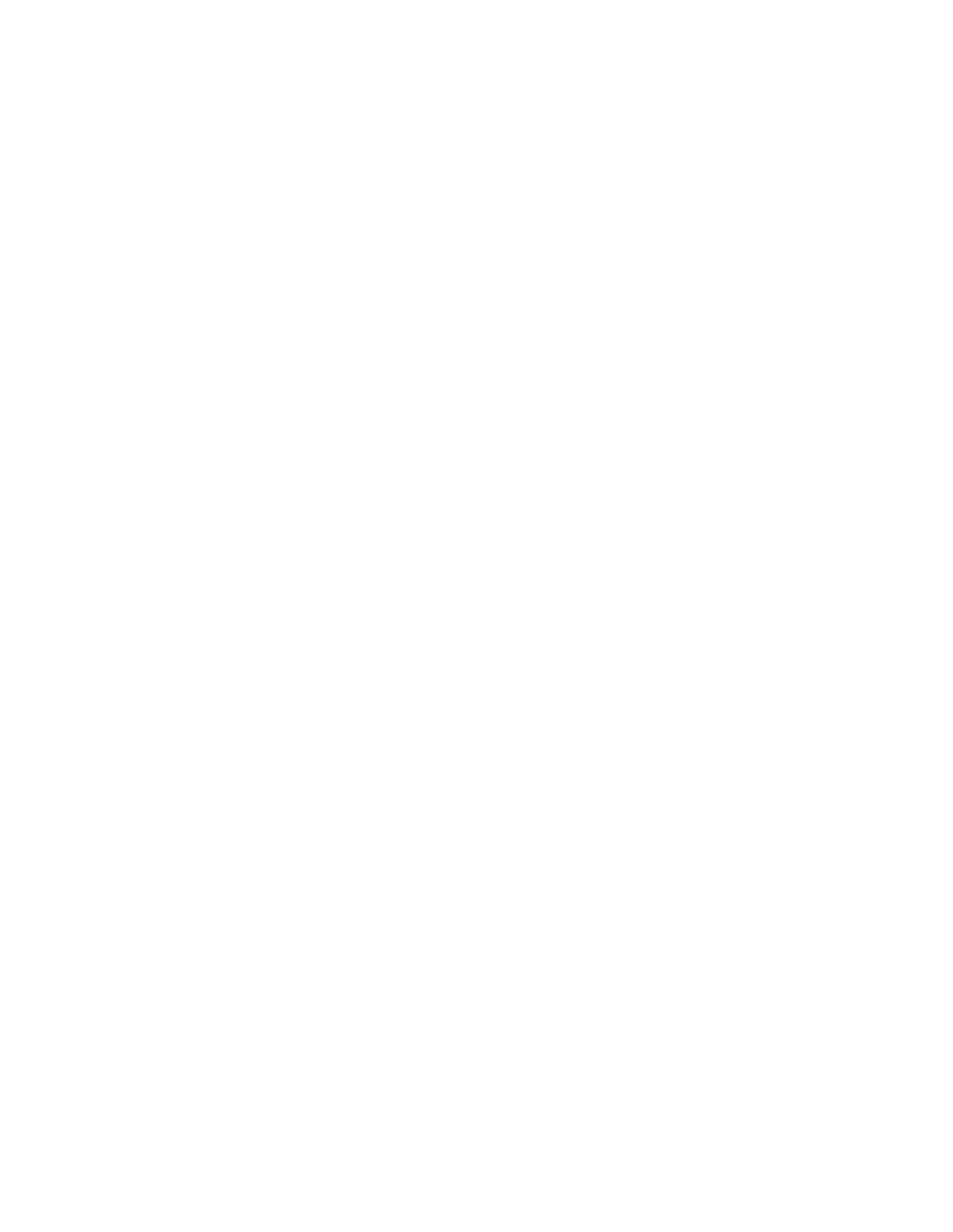
ERIN NEALY COX
United States Attorney Northern District of Texas
By: ___________________________________

Chad E. Meacham, Assistant U.S. Attorney hd hi Texas Bar No. 00784584 CMeacham@usa.doj.gov
United States Attorney’s Office Northern District of Texas 1100 Commerce Street, 3rd Floor Dallas, TX 75242 214-659-8600
Case 4:21-cr-00005-O Document 1 Filed 01/07/21 Page 2 of 2 PageID 2
2 EXHIBIT A, p. 090 Ex. 3, p. 002
IN THE UNITED STATES DISTRICT COURT FOR THE
NORTHERN DISTRICT OF TEXAS
Fort Worth Division
UNITED STATES OF AMERICA ) 4:21-CR-005-O
THE BOEING COMPANY,
DEFERRED PROSECUTION AGREEMENT
Defendant The Boeing Company (the “Company”), pursuant to authority granted by the Company’s Board of Directors reflected in Attachment B, the United States Department of Justice, Criminal Division, Fraud Section (the “Fraud Section”), and the United States Attorney’s Office for the Northern District of Texas (the “USAO-NDTX”) enter into this deferred prosecution agreement (the “Agreement”). The terms and conditions of this Agreement are as follows:
Criminal Information and Acceptance of Responsibility
1. The Company acknowledges and agrees that the Fraud Section will file the attached one-count criminal Information in the United States District Court for the Northern District of Texas charging the Company with Conspiracy to Defraud the United States, in violation of Title 18, United States Code, Section 371 (the “Information”). In so doing, the Company:
(a) knowingly waives any right it may have to indictment on this charge, as well as all rights to a
Case 4:21-cr-00005-O Document 4 Filed 01/07/21 Page 1 of 58 PageID 6
) ) bb )
)
) )
) ) ) Defendant. ) ) ) )
v.
-1EXHIBIT A, p. 091 Ex. 3, p. 003
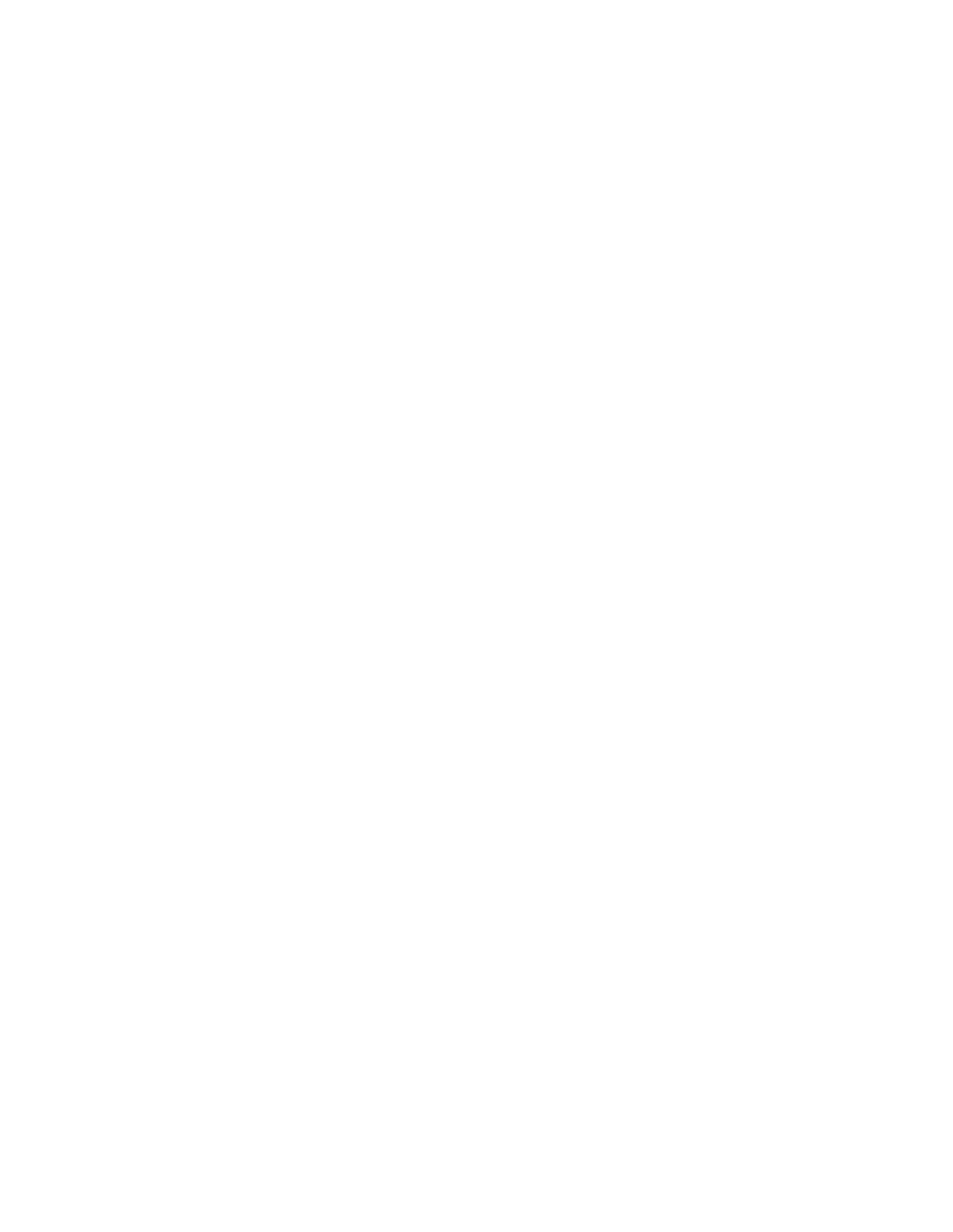
speedy trial pursuant to the Sixth Amendment to the United States Constitution, Title 18, United States Code, Section 3161, and Federal Rule of Criminal Procedure 48(b); and (b) knowingly waives any objection with respect to venue to any charges by the United States arising out of the conduct described in the Statement of Facts attached hereto as Attachment A (the “Statement of Facts”) and consents to the filing of the Information, as provided under the terms of this Agreement, in the United States District Court for the Northern District of Texas. The Fraud Section agrees to defer prosecution of the Company pursuant to the terms and conditions described below.
2. The Company admits, accepts, and acknowledges that it is responsible under United States law for the acts of its officers, directors, employees, and agents as charged in the Information, and as set forth in the Statement of Facts, and that the allegations described in the Information and the facts described in the Statement of Facts are true and accurate. The Company agrees that, effective as of the date it signs this Agreement, in any prosecution that is deferred by this Agreement, it will not dispute the Statement of Facts set forth in this Agreement, and, in any such prosecution, the Statement of Facts shall be admissible as: (a) substantive evidence offered by the government in its case-in-chief and rebuttal case; (b) impeachment evidence offered by the government on cross-examination; and (c) evidence at any sentencing hearing or other hearing. In addition, in connection therewith, the Company agrees not to assert any claim under the United States Constitution, Rule 410 of the Federal Rules of Evidence, Rule 11(f) of the Federal Rules of Criminal Procedure, Section 1B1.1(a) of the United States Sentencing Guidelines (“USSG” or “Sentencing Guidelines”), or any other federal rule that the Statement of Facts should be suppressed or is otherwise inadmissible as evidence in any form. -2-
Case 4:21-cr-00005-O Document 4 Filed 01/07/21 Page 2 of 58 PageID 7
EXHIBIT A, p. 092 Ex. 3, p. 004
Term of the Agreement
3. This Agreement is effective for a period beginning on the date on which the Information is filed and ending three years from that date (the “Term”). The Company agrees, however, that, in the event the Fraud Section determines, in its sole discretion, that the Company has knowingly violated any provision of this Agreement or has failed to completely perform or fulfill each of its obligations under this Agreement, an extension or extensions of the Term may be imposed by the Fraud Section, in its sole discretion, for up to a total additional time period of one year, without prejudice to the right of the Fraud Section to proceed as provided in Paragraphs 26-30 below. Any extension of the Agreement extends all terms of this Agreement, including the terms of the reporting requirement in Attachment D, for an equivalent period. Conversely, in the event the Fraud Section finds, in its sole discretion, that there exists a ch ange in circumstances sufficient to eliminate the need for the reporting requirement in Attachment D, and that the other provisions of this Agreement have been satisfied, the Agreement may be terminated early. If the Court refuses to grant exclusion of time under the Speedy Trial Act, Title 18, United States Code,
Section 3161(h)(2), the Term shall be deemed to have not begun, and all the provisions of this Agreement shall be deemed null and void, except that the statute of limitations for any prosecution relating to the conduct described in the Statement of Facts shall be tolled from the date on which this Agreement is signed until the date the Court refuses to grant the exclusion of time plus six months, and except for the provisions contained within Paragraph 2 of this Agreement.
Case 4:21-cr-00005-O Document 4 Filed 01/07/21 Page 3 of 58 PageID 8
-3EXHIBIT A, p. 093 Ex. 3, p. 005
Relevant Considerations
4. The Fraud Section enters into this Agreement based on the individual facts and circumstances presented by this case and by the Company, including:
a. The nature and seriousness of the offense conduct, which involved two of the Company’s 737 MAX Flight Technical Pilots deceiving the Federal Aviation Administration’s Aircraft Evaluation Group (“FAA AEG”) about an important aircraft part called the Maneuvering Characteristics Augmentation System (“MCAS”) that impacted the flight control system of Boeing’s 737 MAX. Through this deception, the Company interfered with the FAA AEG’s lawful function to evaluate MCAS and to include information about MCAS in the 737 MAX FSB Report, and fraudulently obtained from the FAA AEG a differences-training determination for the 737 MAX that was based on incomplete and inaccurate information about MCAS;
b. The Company did not receive voluntary disclosure credit pursuant to the Corporate Enforcement Policy in the Department of Justice Manual 9-47.120, or pursuant to the Sentencing Guidelines, because it did not timely and voluntarily disclose to the Fraud Section the offense conduct described in the Statement of Facts;
c. The Company received partial credit for its cooperation with the Fraud
Section’s investigation into the Company’s above-described deception of the FAA AEG; the Company’s cooperation ultimately included voluntarily and proactively identifying to the Fraud Section potentially significant documents and Company witnesses and voluntarily organizing voluminous evidence that the Company was obligated to produce; such cooperation, however, was delayed and only began after the first six months of the
Case 4:21-cr-00005-O Document 4 Filed 01/07/21 Page 4 of 58 PageID 9
-4EXHIBIT A, p. 094 Ex. 3, p. 006

Fraud Section’s investigation, during which time the Company’s response frustrated the Fraud Section’s investigation;
d. The Company engaged in remedial measures after the offense conduct, including: (i) creating a permanent aerospace safety committee of the Board of Directors to oversee the Company’s policies and procedures governing safety and its interactions with the FAA and other government agencies and regulators; (ii) creating a Product and Services Safety organization to strengthen and centralize the safety-related functions that were previously located across the Company; (iii) reorganizing the Company’s engineering function to have all Boeing engineers, as well as the Company’s Flight Technical Team, report through the Company’s chief engineer rather than to the business units; and (iv) making structural changes to the Company’s Flight Technical Team to increase the supervision, effectiveness, and professionalism of the Company’s Flight Technical Pilots, including moving the Company’s Flight Technical Team under the same organizational umbrella as the Company’s Flight Test Team, and adopting new policies and procedures and conducting training to clarify expectations and requirements governing communications between the Company’s Flight Technical Pilots and regulatory authorities, including specifically the FAA AEG. The Company also made significant changes to its top leadership since the offense occurred;
e. The Company ultimately provided to the Fraud Section all relevant facts known to it, including information about the individuals involved in the conduct described in the attached Statement of Facts and conduct disclosed prior to the Agreement;
f. The Company’s prior history of misconduct includes a criminal conviction from 1989 for an employee illegally obtaining confidential military planning documents,
Case 4:21-cr-00005-O Document 4 Filed 01/07/21 Page 5 of 58 PageID 10
-5EXHIBIT A, p. 095 Ex. 3, p. 007

and a criminal non-prosecution agreement from 2006 for an employee engaging in procurement fraud. The Company’s history also includes a civil FAA settlement agreement from 2015 related to safety and quality issues concerning the Company’s Boeing Commercial Airplanes business unit;
g. After the offense conduct, the Company undertook the remedial efforts described above and enhanced and has committed to continuing to enhance its compliance program and internal controls, including ensuring that its compliance program satisfies the minimum elements set forth in Attachment C to this Agreement (Corporate Compliance Program);
h. The Fraud Section determined that an independent compliance monitor was unnecessary based on the following factors, among others: (i) the misconduct was neither pervasive across the organization, nor undertaken by a large number of employees, nor facilitated by senior management; (ii) although two of the Company’s 737 MAX Flight Technical Pilots deceived the FAA AEG about MCAS by way of misleading statements, half-truths, and omissions, others in the Company disclosed MCAS’s expanded operational scope to different FAA personnel who were responsible for determining whether the 737 MAX met U.S. federal airworthiness standards; (iii) the state of the Company’s remedial improvements to its compliance program and internal controls; and (iv) the Company’s agreement to meet with and report to the Fraud Section as set forth in Attachment D to this Agreement (Enhanced Reporting Requirements);
i. The Company has agreed to continue to cooperate with the Fraud Section as described in Paragraph 5, below;
Case 4:21-cr-00005-O Document 4 Filed 01/07/21 Page 6 of 58 PageID 11
-6EXHIBIT A, p. 096 Ex. 3, p. 008
j. Accordingly, after considering (a) through (i) above, the Fraud Section believes that the appropriate resolution in this case is a Deferred Prosecution Agreement with the Company; a criminal monetary penalty in the amount of $243,600,000, which reflects a fine at the low end of the otherwise-applicable Sentencing Guidelines fine range; $1,770,000,000 in compensation to the Company’s airline customers; $500,000,000 in additional compensation to the heirs, relatives, and/or legal beneficiaries of the crash victims of Lion Air Flight 610 and Ethiopian Airlines Flight 302; and the Company’s agreement to meet with and report to the Fraud Section as set forth in Attachment D to this Agreement.
Future Cooperation and Disclosure Requirements
5. The Company and its subsidiaries and affiliates shall cooperate fully with the Fraud Section in any and all matters relating to the conduct described in this Agreement and the attached Statement of Facts and other conduct under investigation by the Fraud Section, until the later of the date upon which all investigations and prosecutions arising out of such conduct are concluded, or the end of the Term. At the request of the Fraud Section, the Company and its subsidiaries and affiliates shall also cooperate fully with other domestic or foreign law enforcement and regulatory authorities and agencies in any investigation of the Company, its subsidiaries, affiliates, or any of their present or former officers, directors, employees, and agents in any and all matters relating to the conduct described in this Agreement and the attached Statement of Facts and other conduct. The Company’s and its subsidiaries’ and affiliates’ cooperation pursuant to this Paragraph is subject to applicable law and regulations, as well as valid claims of attorney-client privilege or attorney work product doctrine; however, the Company and its subsidiaries and affiliates must provide to the Fraud Section a log of any information or cooperation that is not provided based on
Case 4:21-cr-00005-O Document 4 Filed 01/07/21 Page 7 of 58 PageID 12
-7EXHIBIT A, p. 097 Ex. 3, p. 009

an assertion of law, regulation, or privilege, and the Company and its subsidiaries and affiliates bear the burden of establishing the validity of any such assertion. The Company and its subsidiaries and affiliates agree that their cooperation pursuant to this paragraph shall include, but not be limited to, the following:
a. Upon request of the Fraud Section, the Company and its subsidiaries and affiliates shall truthfully disclose all factual information with respect to their activities and those of their present and former directors, officers, employees, agents, and consultants, including any evidence or allegations and internal or external investigations, about which the Company and its subsidiaries and affiliates have any knowledge or about which the Fraud Section may inquire. This obligation of truthful disclosure includes, but is not limited to, the obligation of the Company and its subsidiaries and affiliates to provide to the Fraud Section, upon request, any document, record or other tangible evidence about which the Fraud Section may inquire of the Company and its subsidiaries and affiliates.
b. Upon request of the Fraud Section, the Company and its subsidiaries and affiliates shall designate knowledgeable employees, agents, or attorneys to provide to the Fraud Section the information and materials described in Paragraph 5(a) above on behalf of the Company and its subsidiaries and affiliates. It is further understood that the Company and its subsidiaries and affiliates must at all times provide complete, truthful, and accurate information.
c. The Company and its subsidiaries and affiliates shall use their best efforts to make available for interviews or testimony, as requested by the Fraud Section, present or former officers, directors, employees, agents, and consultants of the Company and its subsidiaries and affiliates. This obligation includes, but is not limited to, sworn testimony
Case 4:21-cr-00005-O Document 4 Filed 01/07/21 Page 8 of 58 PageID 13
-8EXHIBIT A, p. 098 Ex. 3, p. 010
before a federal grand jury or in federal trials, as well as interviews with domestic or foreign law enforcement and regulatory authorities. Cooperation under this Paragraph shall include identification of witnesses who, to the knowledge of the Company and its subsidiaries and affiliates, may have material information regarding the matters under investigation.
d. With respect to any information, testimony, documents, records, or other tangible evidence provided to the Fraud Section pursuant to this Agreement, the Company and its subsidiaries and affiliates consent to any and all disclosures to other governmental authorities, including United States authorities and those of a foreign government of such materials as the Fraud Section, in its sole discretion, shall deem appropriate.
6. In addition to the obligations in Paragraph 5, during the Term, should the Company learn of any evidence or allegation of a violation of U.S. fraud laws committed by the Company’s employees or agents upon any domestic or foreign government agency (including the FAA), regulator, or any of the Company’s airline customers, the Company shall promptly report such evidence or allegation to the Fraud Section.
Total U.S. Criminal Monetary Amount
7. The Company and the Fraud Section agree that the Total U.S. Criminal Monetary Amount to be paid by the Company pursuant to this Agreement is $2,513,600,000, which comprises the following components as further described below: (i) a criminal monetary penalty of $243,600,000 (the “Criminal Monetary Penalty”); (ii) $1,770,000,000 in compensation to Boeing’s airline customers (the “Airline Compensation Amount”); and (iii) $500,000,000 in compensation to the heirs, relatives, and/or legal beneficiaries of the crash victims of Lion Air -9-
Case 4:21-cr-00005-O Document 4 Filed 01/07/21 Page 9 of 58 PageID 14
EXHIBIT A, p. 099 Ex. 3, p. 011
Flight 610 and Ethiopian Airlines Flight 302 (the “Crash-Victim Beneficiaries Compensation Amount”).
8. The Company acknowledges that no tax deduction may be sought in connection with the payment of the Criminal Monetary Penalty. The Company shall not seek or accept directly or indirectly reimbursement or indemnification from any source with regard to the Criminal Monetary Penalty or any other agreement entered into with any other enforcement authority or a regulator concerning the facts set forth in the Statement of Facts.
Payment of Criminal Monetary Penalty
9. The Fraud Section and the Company agree that application of the Sentencing Guidelines to determine the applicable fine range yields the following analysis:
a. The 2018 USSG are applicable to this matter.
b. Offense Level. Based upon USSG § 2B1.1, the total offense level is 34, calculated as follows:
Base Fine. Based upon USSG § 8C2.4(a)(2), which imposes a base fine equal to the pecuniary gain to the organization from the offense if such gain is greater than the amount indicated in the Offense Level Fine Table, the base fine is $243,600,000 (representing Boeing’s cost-savings, based on Boeing’s assessment of the cost associated with the implementation of full-flight simulator training for the 737 MAX).
Case 4:21-cr-00005-O Document 4 Filed 01/07/21 Page 10 of 58 PageID 15
(a)(2) Base Offense Level 6 (b)(1)(N) Gain of More Than $150,000,000 +26 (b)(10) TOTAL Sophisticated Means +2 ___ 34
-10EXHIBIT A, p. 100 Ex. 3, p. 012
c. Culpability Score. Based upon USSG § 8C2.5, the culpability score is 5, calculated as follows:
(a) Base Culpability Score 5
(b)(4) The organization had 50 or more employees and an individual within substantial authority personnel participated in, condoned, or was willfully ignorant of the offense +2
(g)(2) The organization cooperated in the investigation, and clearly demonstrated recognition and affirmative acceptance of responsibility for its criminal conduct -2
Calculation of Fine Range:
Base Fine $243,600,000
Multipliers 1.0 (min) / 2.0 (max)
Fine Range $243,600,000 / $487,200,000
10. The Company agrees to pay the Criminal Monetary Penalty of $243,600,000 to the United States Treasury no later than ten (10) business days after the Agreement is fully executed pursuant to payment instructions provided by the Fraud Section in its sole discretion. The Fraud Section and the Company agree that the Criminal Monetary Penalty is appropriate given the facts and circumstances of this case, including the Relevant Considerations described in Paragraph 4.
11. The Criminal Monetary Penalty is final and shall not be refunded. Furthermore, nothing in this Agreement shall be deemed an agreement by the Fraud Section that $243,600,000 is the maximum penalty that may be imposed in any future prosecution, and the Fraud Section is not precluded from arguing in any future prosecution that the Court should impose a higher fine, although the Fraud Section agrees that under those circumstances, it will recommend to the Court
Case 4:21-cr-00005-O Document 4 Filed 01/07/21 Page 11 of 58 PageID 16 ___
TOTAL 5
-11EXHIBIT A, p. 101 Ex. 3, p. 013
that any amount paid under this Agreement should be offset against any fine the Court imposes as part of a putative future judgment.
Payment of Airline Compensation Amount
12. The Company agrees to pay a total Airline Compensation Amount of $1,770,000,000 to its airline customers for the direct pecuniary harm that its airline customers incurred as a result of the grounding of the Company’s 737 MAX. The Airline Compensation Amount shall be offset by any payments already made by the Company, as of the date this Agreement is fully executed, to any of its airline customers for the direct pecuniary harm that its airline customers incurred as a result of the grounding of the Company’s 737 MAX. The Company shall pay any remaining amounts due under the Airline Compensation Amount to its airline customers by the end of the Term and shall provide documentation to the Fraud Section evidencing the amounts paid.
Payment of Crash-Victim Beneficiaries Compensation Amount
13. The Company agrees to pay a total Crash-Victim Beneficiaries Compensation Amount of $500,000,000 to the heirs, relatives, and/or legal beneficiaries of the crash victims of Lion Air Flight 610 and Ethiopian Airlines Flight 302. No later than ten (10) business days after the filing of the Information, the Company shall establish an escrow account (“Escrow Account”) into which it shall deposit the full Crash-Victim Beneficiaries Compensation Amount. No monies will be paid out of the Escrow Account without prior approval by the Fraud Section.
14. The parties agree that the appointment of a Crash-Victim Beneficiaries Compensation Claims Administrator (the “Administrator”) is appropriate and necessary to determine the proper administration and disbursement of the Crash-Victim Beneficiaries Compensation Amount that the Company will pay to the beneficiaries of the crash victims.
Case 4:21-cr-00005-O Document 4 Filed 01/07/21 Page 12 of 58 PageID 17
-12EXHIBIT A, p. 102 Ex. 3, p. 014

15. The Administrator, consistent with a process imposed and required by the Fraud Section, will make recommendations to the Fraud Section regarding: (a) the individuals who should receive payments from the Crash-Victim Beneficiaries Compensation Amount; and (b) the compensation amounts that these individuals should receive. Only the Fraud Section shall be empowered to make final decisions regarding: (a) the individuals who should receive the victim payments from the Crash-Victim Beneficiaries Compensation Amount; and (b) the compensation amounts that these individuals should receive.
16. The Company agrees to pay for all costs, fees, and expenses incurred by the Administrator. The Company shall execute an engagement letter with the Administrator that must be approved, in advance of execution, by the Fraud Section.
17. Within twenty (20) business days after the filing of the Information, the Company shall submit a written proposal identifying three (3) candidates to serve as the Administrator, setting forth the candidates’ qualifications and credentials. The Fraud Section retains the right, in its sole discretion, to choose the Administrator from among the candidates proposed by the Company. Any submission or selection of the Administrator by either the Company or the Fraud Section shall be made without unlawful discrimination against any person or class of persons. The Fraud Section and the Company will use their best efforts to complete the selection process within thirty (30) calendar days of the execution of this Agreement.
18. The Company agrees that it will not employ or be affiliated with the Administrator for a period of not less than two years from the date on which the Administrator’s term expires. Nor will the Company discuss with the Administrator the possibility of further employment or affiliation during the Administrator’s term. Upon agreement by the parties, this prohibition will -13-
Case 4:21-cr-00005-O Document 4 Filed 01/07/21 Page 13 of 58 PageID 18
EXHIBIT A, p. 103 Ex. 3, p. 015
not apply to other claims administration responsibilities that the Administrator may undertake in connection with resolutions with foreign or other domestic authorities.
19. The Company agrees that it will not use the fact that any beneficiary of the crash victims of Lion Air Flight 610 and Ethiopian Airlines Flight 302 seeks or receives any compensation from the Crash-Victim Beneficiaries Compensation Amount to seek to preclude such beneficiary from pursuing any other lawful claim that such beneficiary might have against the Company.
Conditional Release from Liability
20. Subject to Paragraphs 26-30, the Fraud Section agrees, except as provided in this Agreement, that it will not bring any criminal or civil case against the Company relating to any of the conduct as described in the attached Statement of Facts or the Information filed pursuant to this Agreement. The Fraud Section, however, may use any information related to the conduct described in the attached Statement of Facts against the Company: (a) in a prosecution for perjury or obstruction of justice; (b) in a prosecution for making a false statement; (c) in a prosecution or other proceeding relating to any crime of violence; or (d) in a prosecution or other proceeding relating to a violation of any provision of Title 26 of the United States Code.
a. This Agreement does not provide any protection against prosecution for any future conduct by the Company.
b. In addition, this Agreement does not provide any protection against prosecution of any individuals, regardless of their affiliation with the Company.
Corporate Compliance Program
21. The Company represents that it has implemented and will continue to implement a compliance and ethics program designed, implemented, and enforced to prevent and detect
Case 4:21-cr-00005-O Document 4 Filed 01/07/21 Page 14 of 58 PageID 19
-14EXHIBIT A, p. 104 Ex. 3, p. 016
violations of the U.S. fraud laws throughout its operations, including those of its subsidiaries, affiliates, agents, and joint ventures, and those of its contractors and subcontractors whose responsibilities relate to the Company’s interactions with any domestic or foreign government agency (including the FAA), regulator, or any of its airline customers, including, but not limited to, the minimum elements set forth in Attachment C.
22. In order to address any deficiencies in its internal controls, policies, and procedures, the Company represents that it has undertaken, and will continue to undertake in the future, in a manner consistent with all of its obligations under this Agreement, a review of its existing internal controls, policies, and procedures regarding compliance with U.S. fraud laws, focusing on the Company’s interactions with domestic or foreign government agencies (including the FAA), regulators, and any of its airline customers. Where necessary and appropriate, the Company agrees to adopt a new compliance program, or to modify its existing one, including internal controls, compliance policies, and procedures in order to ensure that it maintains an effective compliance program, including a system of internal controls, designed to effectively detect and deter violations of U.S. fraud laws. The compliance program, including the internal controls system, will include, but not be limited to, the minimum elements set forth in Attachment C.
Enhanced Corporate Compliance Reporting
23. The Company agrees that it will report to the Fraud Section periodically, at no less than three-month intervals during the Term, regarding remediation, implementation, and testing of its compliance program and internal controls, policies, and procedures described in Attachment C. During the Term, the Company shall (i) conduct an initial review and submit an initial report, and (ii) conduct and prepare at least two follow-up reviews and reports, as described in Attachment D. -15-
Case 4:21-cr-00005-O Document 4 Filed 01/07/21 Page 15 of 58 PageID 20
EXHIBIT A, p. 105 Ex. 3, p. 017
Deferred Prosecution
24. In consideration of the undertakings agreed to by the Company herein, the Fraud Section agrees that any prosecution of the Company for the conduct set forth in the attached Statement of Facts or Information will be and hereby is deferred for the Term. To the extent there is conduct disclosed by the Company that is not set forth in the attached Statement of Facts or Information, such conduct will not be exempt from further prosecution and is not within the scope of or relevant to this Agreement.
25. The Fraud Section further agrees that if the Company fully complies with all of its obligations under this Agreement, the Fraud Section will not continue the criminal prosecution against the Company described in Paragraph 1 and, at the conclusion of the Term, this Agreement shall expire. Six months after the Agreement’s expiration, the Fraud Section shall seek dismissal with prejudice of the Information filed against the Company described in Paragraph 1, and agree not to file charges in the future against the Company based on the conduct described in this Agreement, the attached Statement of Facts, or the Information. If, however, the Fraud Section determines during this six-month period that the Company breached the Agreement during the Term, as described in Paragraphs 26-30, the Fraud Section’s ability to extend the Term, as described in Paragraph 3, or to pursue other remedies, including those described in Paragraphs 26-30, remains in full effect.
Breach of the Agreement
26. If, during the Term, (a) the Company commits any felony under U.S. federal law; (b) the Company provides in connection with this Agreement deliberately false, incomplete, or misleading information, including in connection with its disclosure of information about individual culpability; (c) the Company or its subsidiaries and affiliates fail to cooperate as set forth in -16-
Case 4:21-cr-00005-O Document 4 Filed 01/07/21 Page 16 of 58 PageID 21
EXHIBIT A, p. 106 Ex. 3, p. 018

Paragraphs 5 and 6 of this Agreement; (d) the Company fails to implement a compliance program as set forth in Paragraphs 21-22 of this Agreement and Attachment C; or (e) the Company and its subsidiaries and affiliates otherwise fail to completely perform or fulfill each of their obligations under the Agreement, regardless of whether the Fraud Section becomes aware of such a breach after the Term is complete, the Company and its subsidiaries and affiliates shall thereafter be subject to prosecution for any federal criminal violation of which the Fraud Section has knowledge, including, but not limited to, the charges in the Information described in Paragraph 1, which may be pursued by the Fraud Section in the United States District Court for the Northern District of Texas or any other appropriate venue. Determination of whether the Company has breached the Agreement and whether to pursue prosecution of the Company and its subsidiaries and affiliates shall be in the Fraud Section’s sole discretion. Any such prosecution may be premised on information provided by the Company, its subsidiaries and affiliates, or their personnel. Any such prosecution relating to the conduct described in the attached Statement of Facts or relating to conduct known to the Fraud Section prior to the date on which this Agreement was signed that is not time-barred by the applicable statute of limitations on the date of the signing of this Agreement may be commenced against the Company, or its subsidiaries and affiliates, notwithstanding the expiration of the statute of limitations, between the signing of this Agreement and the expiration of the Term plus one year. Thus, by signing this Agreement, the Company agrees that the statute of limitations with respect to any such prosecution that is not time-barred on the date of the signing of this Agreement shall be tolled for the Term plus one year. In addition, the Company agrees that the statute of limitations as to any violation of U.S. federal law that occurs during the Term will be tolled from the date upon which the violation occurs until the earlier of the date upon which the Fraud Section is made aware of the violation or the duration of the Term plus five years, and that -17-
Case 4:21-cr-00005-O Document 4 Filed 01/07/21 Page 17 of 58 PageID 22
EXHIBIT A, p. 107 Ex. 3, p. 019

this period shall be excluded from any calculation of time for purposes of the application of the statute of limitations.
27. In the event the Fraud Section determines that the Company has breached this Agreement, the Fraud Section agrees to provide the Company with written notice of such breach prior to instituting any prosecution resulting from such breach. Within thirty days of receipt of such notice, the Company shall have the opportunity to respond to the Fraud Section in writing to explain the nature and circumstances of such breach, as well as the actions the Company has taken to address and remediate the situation, which explanation the Fraud Section shall consider in determining whether to pursue prosecution of the Company.
28. In the event that the Fraud Section determines that the Company has breached this Agreement: (a) all statements made by or on behalf of the Company or its subsidiaries and affiliates to the Fraud Section or to the Court, including the attached Statement of Facts, and any testimony given by the Company or its subsidiaries and affiliates before a grand jury, a court, or any tribunal, or at any legislative hearings, whether prior or subsequent to this Agreement, and any leads derived from such statements or testimony, shall be admissible in evidence in any and all criminal proceedings brought by the Fraud Section against the Company or its subsidiaries and affiliates; and (b) the Company or its subsidiaries and affiliates shall not assert any claim under the United States Constitution, Rule 11(f) of the Federal Rules of Criminal Procedure, Rule 410 of the Federal Rules of Evidence, Section 1B1.1(a) of the USSG, or any other federal rule that any such statements or testimony made by or on behalf of the Company prior or subsequent to this Agreement, or any leads derived therefrom, should be suppressed or are otherwise inadmissible. The decision whether conduct or statements of any current director, officer, or employee, or any person acting on behalf of, or at the direction of, the Company or its subsidiaries and affiliates will
Case 4:21-cr-00005-O Document 4 Filed 01/07/21 Page 18 of 58 PageID 23
EXHIBIT A, p. 108 Ex. 3, p. 020
-18-
be imputed to the Company for the purpose of determining whether the Company has violated any provision of this Agreement shall be in the sole discretion of the Fraud Section.
29. The Company acknowledges that the Fraud Section has made no representations, assurances, or promises concerning what sentence may be imposed by the Court if the Company breaches this Agreement and this matter proceeds to judgment. The Company further acknowledges that any such sentence is solely within the discretion of the Court and that nothing in this Agreement binds or restricts the Court in the exercise of such discretion.
30. On the date that the period of deferred prosecution specified in this Agreement expires, the Company, by the Chief Executive Officer of the Company and the Chief Financial Officer of the Company, will submit the certification set forth in Attachment E and certify to the Fraud Section that the Company has met its disclosure obligations pursuant to Paragraph 6 of this Agreement. Each certification will be deemed a material statement and representation by the Company to the executive branch of the United States for purposes of Title 18, United States Code, Sections 1001 and 1519, and it will be deemed to have been made in the judicial district in which this Agreement is filed.
Sale, Merger, or Other Change in Corporate Form of the Company
31. Except as may otherwise be agreed by the parties in connection with a particular transaction, the Company agrees that in the event that, during the Term, it undertakes any change in corporate form, including if it sells, merges, or transfers business operations that are material to the Company’s operations, or to the operations of any subsidiaries or affiliates involved in the conduct described in the attached Statement of Facts, as they exist as of the date of this Agreement, whether such sale is structured as a sale, asset sale, merger, transfer, or other change in corporate form, it shall include in any contract for sale, merger, transfer, or other change in corporate form
Case 4:21-cr-00005-O Document 4 Filed 01/07/21 Page 19 of 58 PageID 24
-19EXHIBIT A, p. 109 Ex. 3, p. 021
a provision binding the purchaser, or any successor in interest thereto, to the obligations described in this Agreement. The purchaser or successor in interest must also agree in writing that the Fraud Section’s ability to breach under this Agreement is applicable in full force to that entity. The Company agrees that the failure to include these provisions in the transaction will make any such transaction null and void. The Company shall provide notice to the Fraud Section at least thirty (30) days prior to undertaking any such sale, merger, transfer, or other change in corporate form. The Fraud Section shall notify the Company prior to such transaction (or series of transactions) if it determines that the transaction(s) will have the effect of circumventing or frustrating the enforcement purposes of this Agreement. At any time during the Term the Company engages in a transaction(s) that has the effect of circumventing or frustrating the enforcement purposes of this Agreement, the Fraud Section may deem it a breach of this Agreement pursuant to Paragraphs 26-30 of this Agreement. Nothing herein shall restrict the Company from indemnifying (or otherwise holding harmless) the purchaser or successor in interest for penalties or other costs arising from any conduct that may have occurred prior to the date of the transaction, so long as such indemnification does not have the effect of circumventing or frustrating the enforcement purposes of this Agreement, as determined by the Fraud Section.
Public Statements by the Company
32. The Company expressly agrees that it shall not, through present or future attorneys, officers, directors, employees, agents, or any other person authorized to speak for the Company make any public statement, in litigation or otherwise, contradicting the acceptance of responsibility by the Company set forth above or the facts described in the attached Statement of Facts. Any such contradictory statement shall, subject to cure rights of the Company described below, constitute a breach of this Agreement, and the Company thereafter shall be subject to prosecution
Case 4:21-cr-00005-O Document 4 Filed 01/07/21 Page 20 of 58 PageID 25
EXHIBIT A, p. 110 Ex. 3, p. 022
-20-

as set forth in Paragraphs 26-30 of this Agreement. The decision whether any public statement by any such person contradicting a fact contained in the attached Statement of Facts will be imputed to the Company for the purpose of determining whether it has breached this Agreement shall be at the sole discretion of the Fraud Section. If the Fraud Section determines that a public statement by any such person contradicts, in whole or in part, a statement contained in the attached Statement of Facts, the Fraud Section shall so notify the Company, and the Company may avoid a breach of this Agreement by publicly repudiating such statement(s) within five business days after notification. The Company shall be permitted to raise defenses and to assert affirmative claims in other proceedings relating to the matters set forth in the attached Statement of Facts provided that such defenses and claims do not contradict, in whole or in part, a statement contained in the attached Statement of Facts. This Paragraph does not apply to any statement made by any present or former officer, director, employee, or agent of the Company in the course of any criminal, regulatory, or civil case initiated against such individual, unless such individual is speaking on behalf of the Company.
33. The Company agrees that if it, or any of its direct or indirect subsidiaries or affiliates, issues a press release or holds any press conference in connection with this Agreement, the Company shall first consult with the Fraud Section to determine (a) whether the text of the release or proposed statements at the press conference are true and accurate with respect to matters between the Fraud Section and the Company; and (b) whether the Fraud Section has any objection to the release.
Case 4:21-cr-00005-O Document 4 Filed 01/07/21 Page 21 of 58 PageID 26
-21EXHIBIT A, p. 111 Ex. 3, p. 023
34. The Fraud Section agrees, if requested to do so, to bring to the attention of law enforcement and regulatory authorities the facts and circumstances relating to the nature of the conduct underlying this Agreement, including the nature and quality of the Company’s cooperation and remediation. By agreeing to provide this information to such authorities, the Fraud Section is not agreeing to advocate on behalf of the Company, but rather is agreeing to provide facts to be evaluated independently by such authorities.
Limitations on Binding Effect of the Agreement
35. This Agreement is binding on the Company, the Fraud Section, and the USAO-NDTX, but specifically does not bind any other component of the United States Department of Justice, other federal agencies, or any state, local or foreign law enforcement or regulatory agencies, or any other authorities, although the Fraud Section will bring the cooperation of the Company and its compliance with its other obligations under this Agreement to the attention of such agencies and authorities if requested to do so by the Company.
Notice
36. Any notice to the Fraud Section under this Agreement shall be given by personal delivery, overnight delivery by a recognized delivery service, or registered or certified mail, addressed to the Chief of the Market Integrity and Major Frauds Unit, United States Department of Justice, Criminal Division, Fraud Section, 1400 New York Avenue N.W., Washington, D.C., 20005. Any notice to the Company under this Agreement shall be given by personal delivery, overnight delivery by a recognized delivery service, or registered or certified mail, addressed to Brett C. Gerry, Chief Legal Officer and Executive Vice President, Global Compliance, The Boeing Company, 100 North Riverside Plaza, Chicago, Illinois 60606. Notice shall be effective upon actual receipt by the Fraud Section or the Company.
Case 4:21-cr-00005-O Document 4 Filed 01/07/21 Page 22 of 58 PageID 27
-22EXHIBIT A, p. 112 Ex. 3, p. 024
Complete Agreement
37. This Agreement, including its attachments, sets forth all the terms of the agreement between the Company, the Fraud Section, and the USAO-NDTX. No amendments, modifications, or additions to this Agreement shall be valid unless they are in writing and signed by the Fraud Section, the USAO-NDTX, the attorneys for the Company, and duly authorized representatives of the Company.
Case
Document 4 Filed 01/07/21 Page 23 of 58 PageID 28
4:21-cr-00005-O
*** -23EXHIBIT A, p. 113 Ex. 3, p. 025
AGREED: FOR THE BOEING COMPANY:
1/6/2021
Date: --- - ---- By:
David L. Calhoun President and Chief Executive Officer THE BOEING COMPANY
1/6/2021
Date: - - By:
Chief Legal Officer and Executive Vice President, Global Compliance TIIE BOEING COMPANY


1/6/2021
Date: ___ By:
1/6/2021
Date : ___ By:
Craig S. Primis
Patrick Haney
KIRKLAND & ELLIS LLP Counsel for The Boeing Company ..
Richard Cullen
Benjamin L Hatch
Brandon M. Santos
MCGUIREWOODS LLP Counsel for The Boeing Company -24-
Case 4:21-cr-00005-O Document 4 Filed 01/07/21 Page 24 of 58 PageID 29
EXHIBIT A, p. 114 Ex. 3, p. 026
AGREED: FOR THE UNITED STATES DEPARTMENT OF JUSTICE:


Date: _____________________ ____________________ By:
DANIEL S. KAHN Acting Chief, Fraud Section Criminal Division _____________________________________
Cory E. Jacobs Trial Attorney


Date: _____________________ _ _____________
By:

Michael T. O’Neill Trial
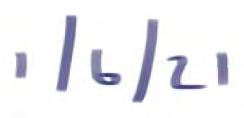
Date: _____________________ _____ ___________
By:

Scott Armstr Trial Attorney
Assistant Chief _____________________________________ Chief ong Armstrong Trial
ERIN NEALY X d States Attorney e
CO COX Unite United States Northern District of T xas Texas


Date: _____________________ _______ ___________ By: _____________________________________
Chad E. Meacham Assistant U.S. Attorney
Document 4 Filed 01/07/21 Page 25 of 58 PageID 30
Case 4:21-cr-00005-O
-25EXHIBIT A, p. 115 Ex. 3, p. 027
COMPANY OFFICER'S CERTIFICATE
I have read the Agreement and carefully reviewed its terms and attachments with inside and outside counsel for The Boeing Company (the " Company" ). I understand the terms of the Agreement and voluntarily agree, on behalf of the Company, to each of its terms. Before signing the Agreement, I consulted inside and outside counsel for the Company. Counsel fully advised me of the rights of the Company, of possible defenses, of the Sentencing Guidelines' provisions, and of the consequences of entering into this Agreement.
With the assistance of the Company ' s Chief Legal Officer, I have provided the Agreement for review by the Company ' s Board of Directors, who have been briefed on its principal terms and who have delegated authority to approve the Agreement to a subgroup of the Board of Directors, as set forth and described in the Certificate of Corporate Approval. I have advised and caused outside counsel for the Company to advise the duly authorized subgroup of the Company ' s Board of Directors fully of the rights of the Company , of possible defenses, of the Sentencing Guidelines ' provisions, and of the consequences of entering into the Agreement.
No promises or inducements have been made other than those contained in the Agreement. Furthermore, no one has threatened or forced me, or to my knowledge any person authorizing the Agreement on behalf of the Company, in any way to enter into the Agreement. I am also satisfied with outside counsels' representation in this matter. I certify that I am the President and Chief Executive Officer for the Company and that I have been duly authorized by the Company to execute the Agreement on behalf of the Company.
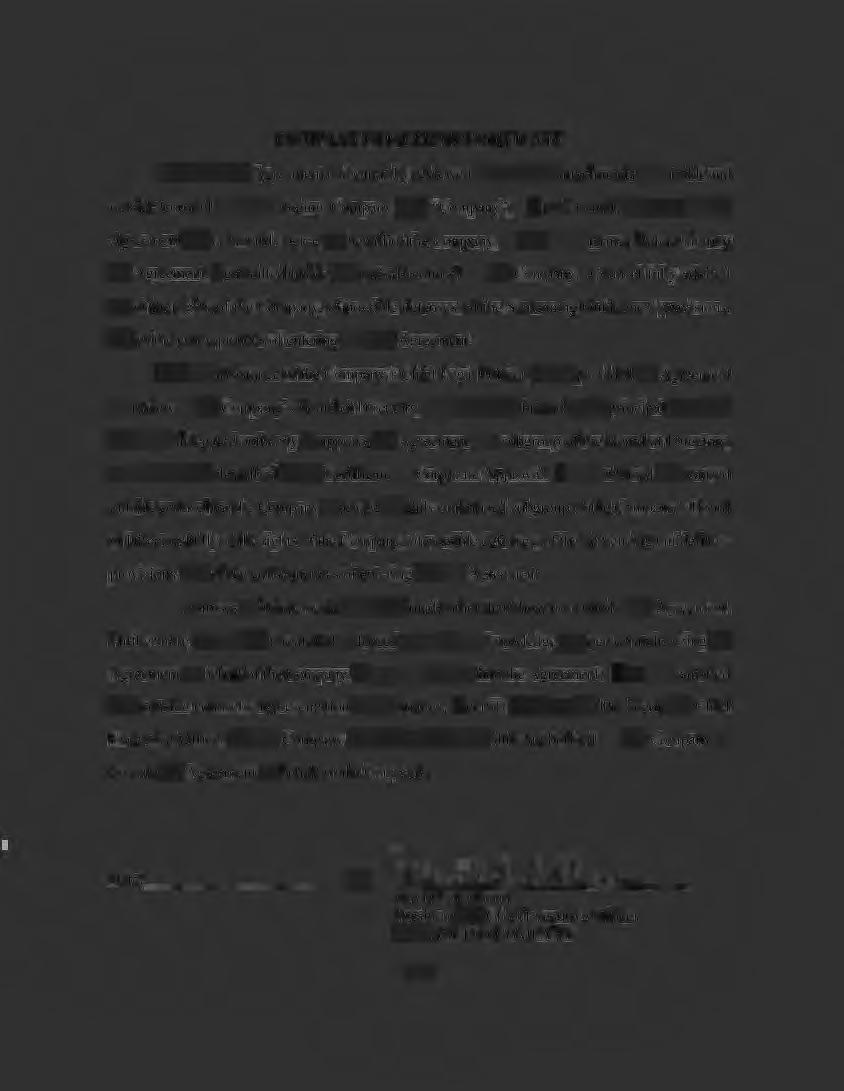
1/6/2021
Date : ----- - ---
David L. Calhoun President and Chief Executive Officer
BOEING COMPANY
THE
-26Case 4:21-cr-00005-O Document 4 Filed 01/07/21 Page 26 of 58 PageID 31
EXHIBIT A, p. 116 Ex. 3, p. 028
CERTIFICATE OF COUNSEL FOR THE BOEING COMPANY
I am counsel for The Boeing Company (the "Company") in the matter covered by this Agreement. In connection with such representation, I have examined relevant Company documents and have discussed them with the Company's Corporate Secretary and the subgroup of the Company's Board of Directors to which the Board delegated the authority to approve execution of the Agreement after review of the final documents and terms Based on my review of the foregoing materials and discussions, I am of the opinion that the representative of the Company has been duly authorized to ent er into the Agreement on behalf of the Company and that the Agreement has been duly and validly authorized, executed, and delivered on behalf of the Company and is a valid and binding obligation ofthe Company. Further, I have carefully reviewed the terms of the Agreement with the subgroup of the Board refe renced above and the Company's President and Chief Executive Officer. I have fully advised them of the rights of the Company, of possible defenses, of the Sentencing Guidelines ' provisions and of the consequences of entering into the Agreement. To my lmowledge, the decision of the Company to enter into the Agreement, based on the authorization of the Board of Directors, is an informed and voluntary one. Date: ______ Date: ___ By
By:

Craig S. Primis
Patrick Haney
KIRKLAND

& ELLIS LLP
Counsel for The Boeing Company

Richard Cullen
Benjamin L. Hatch
Brandon M. Santos

MCGUIREWOODS LLP
Counsel for The Boeing Company -27-


~Ifft~
Case 4:21-cr-00005-O Document 4 Filed 01/07/21 Page 27 of 58 PageID 32 1/6/2021 1/6/2021 EXHIBIT A, p. 117 Ex. 3, p. 029
ATTACHMENT A
STATEMENT OF FACTS
1. The following Statement of Facts is incorporated by reference as part of the Deferred Prosecution Agreement (the “Agreement”) between the United States Department of Justice, Criminal Division, Fraud Section (the “Fraud Section”), the United States Attorney’s Office for the Northern District of Texas (the “USAO-NDTX”) and The Boeing Company (“Boeing” or the “Company”). The Company hereby agrees and stipulates that the following information is true and accurate. The Company admits, accepts, and acknowledges that it is responsible for the acts of its officers, directors, employees, and agents as set forth below. Should the Fraud Section or the USAO-NDTX pursue the prosecution that is deferred by this Agreement, the Company agrees that it will neither contest the admissibility of, nor contradict, this Statement of Facts in any such proceeding. The following facts establish beyond a reasonable doubt the charge set forth in the Information attached to this Agreement:
Background
At all times relevant to this Statement of Facts, with all dates being approximate and inclusive:
Boeing’s New Airplane: The 737 MAX
2. The Boeing Company (“Boeing”) was a U.S.-based multinational corporation that designed, manufactured, and sold commercial airplanes to airlines worldwide. Boeing operated from various locations, including in and around Seattle, Washington.
3. Boeing’s airline customers included major U.S.-based airlines headquartered in the Northern District of Texas and elsewhere.
Case 4:21-cr-00005-O Document 4 Filed 01/07/21 Page 28 of 58 PageID 33
A-1 EXHIBIT A, p. 118 Ex. 3, p. 030
4. The Boeing 737 was a commercial airplane that could seat approximately 200 passengers and was one of Boeing’s best-selling airplane models. Boeing began designing, manufacturing, and selling the Boeing 737 in the 1960s. Over time, Boeing designed, manufactured, and sold new versions of the Boeing 737 to its airline customers, including major U.S.-based airlines.
5. In or around June 2011, Boeing began developing and marketing a new version of its Boeing 737 called the 737 MAX. The 737 MAX was designed by Boeing as a competitive answer to a new version of an airplane developed by one of Boeing’s top rivals in commercial airplanes, Company-1. Like the new version of Company-1’s airplane, the 737 MAX promised increased fuel efficiency over its prior version, the 737 Next Generation (“737 NG”). With this increased efficiency, the 737 MAX offered fuel-cost savings for airlines.
The FAA AEG’s Role in Determining Pilot “Differences Training” for New Airplanes
6. Before any U.S.-based airline could operate a new commercial airplane, U.S. regulations required the Federal Aviation Administration (“FAA”), an organization within the United States Department of Transportation, to evaluate and approve the airplane for commercial use. Without this approval, a U.S.-based airline would not be permitted to operate the airplane.
7. As part of this evaluation and approval process, the FAA had to make two distinct determinations: (i) whether the airplane met U.S. federal airworthiness standards; and (ii) what minimum level of pilot training would be required for a pilot to fly the airplane for a U.S.-based airline. These two determinations were made by entirely different groups within the FAA that were composed of different personnel with different organizational structures and different reporting lines.
Case 4:21-cr-00005-O Document 4 Filed 01/07/21 Page 29 of 58 PageID 34
A-2 EXHIBIT A, p. 119 Ex. 3, p. 031

8. The FAA Aircraft Evaluation Group (“AEG”) was principally responsible for determining the minimum level of pilot training required for a pilot to fly the airplane for a U.S.-based airline. To make that determination, the FAA AEG compared the new version of the airplane (such as the 737 MAX) to a similar, prior version of the airplane (such as the 737 NG). After evaluating the differences between the new and prior versions of the airplane, the FAA AEG mandated the minimum level of pilot training, known as “differences training,” for the new version.
9. Based on the nature and extent of the differences between the new and prior version of the airplane, the FAA AEG assigned a level of differences training ranging from “Level A” through “Level E.” These levels of differences training ranged in rigor, with “Level A” being the least intensive and “Level E” the most intensive. As relevant here, “Level B” differences training generally included computer-based training (“CBT”) training, and “Level D” differences training generally included full-flight simulator training.
10. At the conclusion of the FAA’s evaluation of the new version of the airplane, the FAA AEG published a Flight Standardization Board Report (“FSB Report”). Among other things, the FSB Report contained relevant information about certain airplane systems and parts that the airplane manufacturer was required to incorporate into airplane manuals and pilot-training materials for all U.S.-based airlines that would fly the airplane. The FSB Report also contained the FAA AEG’s differences-training determination.
Case 4:21-cr-00005-O Document 4 Filed 01/07/21 Page 30 of 58 PageID 35
A-3 EXHIBIT A, p. 120 Ex. 3, p. 032
Boeing’s 737 MAX Chief Technical Pilots
11. Boeing’s 737 MAX Flight Technical Team was principally responsible for identifying and providing to the FAA AEG all information that was relevant to the FAA AEG in connection with the FAA AEG’s publication of the 737 MAX FSB Report. The 737 MAX Flight Technical Team was separate and distinct from another group within Boeing that was responsible for providing information to the FAA for certification of whether the airplane met U.S. federal airworthiness standards.
12. From in or around early 2012 until in or around early 2014, Boeing Employee-1 was a Technical Pilot for Boeing’s 737 MAX Flight Technical Team. In or around early 2014, Boeing Employee-1 became Boeing’s 737 MAX Chief Technical Pilot. In that role, Boeing Employee-1 led the 737 MAX Flight Technical Team. In or around July 2018, Boeing Employee-1 left Boeing to work for a major U.S.-based airline.
13. From in or around mid-2014 until in or around July 2018, Boeing Employee-2 was a Technical Pilot for Boeing’s 737 MAX Flight Technical Team. In or around July 2018, after Boeing Employee-1 left Boeing, Boeing Employee-2 became Boeing’s 737 MAX Chief Technical Pilot. In that role, Boeing Employee-2 led the 737 MAX Flight Technical Team.
14. Boeing Employee-1 and Boeing Employee-2 understood that the FAA AEG relied on them, as members of Boeing’s 737 MAX Flight Technical Team, to identify and provide to the FAA AEG all information that was relevant to the FAA AEG in connection with the FAA AEG’s publication of the 737 MAX FSB Report, including information that could impact the FAA AEG’s differences-training determination.
Case 4:21-cr-00005-O Document 4 Filed 01/07/21 Page 31 of 58 PageID 36
A-4 EXHIBIT A, p. 121 Ex. 3, p. 033
15. Boeing Employee-1 and Boeing Employee-2 also understood that, because flight controls were vital to flying modern commercial airplanes, differences between the flight controls of the 737 NG and the 737 MAX were especially important to the FAA AEG for purposes of its publication of the 737 MAX FSB Report and the FAA AEG’s differences-training determination.
Overview of the Conspiracy to Defraud the FAA AEG
16. From at least in and around November 2016 through at least in and around December 2018, in the Northern District of Texas and elsewhere, Boeing, through Boeing Employee-1 and Boeing Employee-2, knowingly, and with intent to defraud, conspired to defraud the FAA AEG.
17. At all times during the conspiracy, Boeing Employee-1 and Boeing Employee-2 were acting within the scope of their employment and with the intention, at least in part, to benefit Boeing. The purpose of the conspiracy was to defraud the FAA AEG by impairing, obstructing, defeating, and interfering with the lawful function of the FAA AEG by dishonest means in connection with its publication of the 737 MAX FSB Report and its differences-training determination for the Boeing 737 MAX, in order to bring about a financial gain to Boeing and to benefit Boeing Employee-1 and Boeing Employee-2 in connection with the Boeing 737 MAX.
Lead-Up to the Conspiracy and Scheme to Defraud
Boeing’s Financial Incentive to Secure No Greater than “Level B” Differences Training in the 737 MAX FSB Report
18. As Boeing knew, “Level B” differences training was significantly less expensive for airlines to complete than “Level D.” For example, a pilot could complete “Level B” differences training from anywhere in the world in a matter of hours using a computer or tablet. In contrast, a
Case 4:21-cr-00005-O Document 4 Filed 01/07/21 Page 32 of 58 PageID 37
A-5 EXHIBIT A, p. 122 Ex. 3, p. 034

pilot could complete “Level D” differences training only by appearing in person wherever the pilot’s airline operated a full-flight simulator. Apart from the cost of acquiring one or more multimillion-dollar simulators and other related expenses, airlines that were required by the FAA AEG to train pilots on a full-flight simulator could also lose revenue that the pilot might otherwise have generated from flying airline passengers during that time. Accordingly, if the FAA AEG required a less rigorous level—such as “Level B”—of differences training for the 737 MAX in the 737 MAX FSB Report, the 737 MAX would be a more attractive option for Boeing’s airline customers already flying the 737 NG than switching to an entirely new airplane, such as the new version of Company-1’s airplane, as such customers would save significant money in pilot-training costs by transitioning to the 737 MAX.
19. Principally for this reason, Boeing’s stated objectives in designing the 737 MAX included securing the FAA AEG’s determination to require no greater than “Level B” differences training in the 737 MAX FSB Report. Boeing Employee-1 and Boeing Employee-2 understood as much. For example, in or around November 2014, Boeing Employee-2 wrote in an internal Boeing electronic chat communication to Boeing Employee-1 that “nothing can jepordize [sic] level b[.]” In or around December 2014, Boeing Employee-1 wrote in an email to another Boeing employee that “if we lose Level B [it] will be thrown squarely on my shoulders. It was [Boeing Employee-1], yes [Boeing Employee-1]! Who cost Boeing tens of millions of dollars!”
Case 4:21-cr-00005-O Document 4 Filed 01/07/21 Page 33 of 58 PageID 38
A-6 EXHIBIT A, p. 123 Ex. 3, p. 035
The Maneuvering Characteristics Augmentation System (“MCAS”)
20. To achieve its promised fuel efficiency, the 737 MAX used larger engines than the 737 NG. These larger engines, and their placement under the airplane’s wings, meant that the aerodynamics of the 737 MAX differed from those of the 737 NG.
21. These different aerodynamics created a new handling characteristic for the 737 MAX that caused the 737 MAX’s nose to pitch up during a certain flight maneuver called a high-speed, wind-up turn. A high-speed, wind-up turn generally involved sharply turning the airplane at high speed (approximately Mach 0.6-0.8) in a corkscrew-like pattern.
22. A high-speed, wind-up turn was a “certification” maneuver, that is, a maneuver outside the limits of what the 737 MAX would be expected to encounter during a normal commercial passenger flight. Nevertheless, if Boeing did not fix the 737 MAX’s pitch-up characteristic in high-speed, wind-up turns, the FAA could determine that the 737 MAX did not meet U.S. federal airworthiness standards.
23. To fix this pitch-up characteristic, Boeing created MCAS and incorporated it as a part of the 737 MAX’s flight controls. MCAS was an aircraft “part” within the meaning of Title 18, United States Code, Sections 31(a)(7) and 38. In operation, MCAS would automatically cause the airplane’s nose to pitch down by adjusting the 737 MAX’s horizontal stabilizer (a horizontal tail located near the rear of the airplane). As originally designed, MCAS could only activate during a high-speed, wind-up turn.
Case 4:21-cr-00005-O Document 4 Filed 01/07/21 Page 34 of 58 PageID 39
A-7 EXHIBIT A, p. 124 Ex. 3, p. 036
Boeing Employee-1 and Other Boeing Employees Told the FAA AEG that MCAS was Limited to High-Speed, Wind-Up Turns
24. In or around June 2015, Boeing Employee-1 and other Boeing employees briefed the FAA AEG on MCAS. During this briefing, Boeing described MCAS as a system that could only activate during a high-speed, wind-up turn. After the briefing, Boeing Employee-1 and another Boeing employee further discussed MCAS with an FAA AEG employee (“FAA AEG Employee-1”) and reiterated to FAA AEG Employee-1 the limited operational scope of MCAS.
Boeing Subsequently Expanded MCAS’s Operational Scope Beyond High-Speed, Wind-Up Turns
25. Subsequently, Boeing expanded MCAS’s operational scope, including the speed range within which MCAS could activate, significantly altering its original design. Among other things, when the airplane registered a high angle of attack, the change expanded the speed range within which MCAS could activate from approximately Mach 0.6-0.8 to approximately Mach 0.2-0.8—that is, from only high-speed flight to nearly the entire speed range for the 737 MAX, including low-speed flight, which generally occurs at a lower altitude and in and around takeoff and landing. Boeing disclosed this expansion to FAA personnel, but only to those personnel who were responsible for determining whether the 737 MAX met U.S. federal airworthiness standards.
Boeing did not disclose the expansion to the FAA AEG personnel responsible for publishing the 737 MAX FSB Report and making the training-related determination.
Boeing Advocated for the FAA AEG to Publish the 737 MAX FSB Report with No Greater than “Level B” Differences Training
26. On or about August 16, 2016, before the FAA AEG published the 737 MAX FSB Report, the FAA AEG issued a provisional “Level B” differences-training determination for the A-8
Case 4:21-cr-00005-O Document 4 Filed 01/07/21 Page 35 of 58 PageID 40
EXHIBIT A, p. 125 Ex. 3, p. 037

737 MAX. At the time of this provisional determination, the FAA AEG was unaware that Boeing had expanded MCAS’s operational scope.
27. On or about the same day, Boeing Employee-1 recognized Boeing’s achievement in an email to Boeing employees, including Boeing Employee-2, and wrote that the FAA AEG’s provisional determination “culminates more than 3 years of tireless and collaborative efforts across many business units” and that the 737 MAX program management “is VERY happy.”
28. As Boeing Employee-1 and Boeing Employee-2 knew, the FAA AEG based its provisional “Level B” differences training for the 737 MAX in part on its understanding that MCAS could only activate during the limited operational scope of a high-speed, wind up turn.
29. Boeing Employee-1 and Boeing Employee-2 also understood, as Boeing Employee-1 acknowledged in his email on or about August 16, 2016, that the FAA AEG’s “Level B” differences determination for the 737 MAX was only a “provisional approval [. . .] assuming no significant systems changes to the airplane.”
30. For example, in an email to Boeing employees including Boeing Employee-2 discussing a potential change to another part of the 737 MAX’s flight controls on or about November 10, 2016, Boeing Employee-1 emphasized that “[o]ne of the Program Directives we were given was to not create any differences [. . .]. This is what we sold to the regulators who have already granted us the Level B differences determination. To go back to them now, and tell them there is in fact a difference [. . .] would be a huge threat to that differences training determination.”
Case 4:21-cr-00005-O Document 4 Filed 01/07/21 Page 36 of 58 PageID 41
A-9 EXHIBIT A, p. 126 Ex. 3, p. 038
The Conspiracy Begins
“Shocker Alert”: Boeing Employee-1 and Boeing Employee-2 Discovered MCAS’s Expanded Operational Scope
31. On or about November 15, 2016, during a test flight of the 737 MAX in a simulator, Boeing Employee-1 experienced what Boeing Employee-1 recognized as MCAS operating at lower speed. Boeing Employee-1 further recognized that this lower-speed operation was different from what Boeing had briefed and described to the FAA AEG.
32. On or about that same day, Boeing Employee-1 and Boeing Employee-2 discussed MCAS in an internal Boeing electronic chat communication, writing in part:
Boeing Employee-1: Oh shocker alerT! [sic] / MCAS is now active down to [Mach] .2 / It’s running rampant in the sim on me / at least that’s what [a Boeing simulator engineer] thinks is happening
Boeing Employee-2: Oh great, that means we have to update the speed trim description in vol 2
Boeing Employee-1: so I basically lied to the regulators (unknowingly)
Boeing Employee-2: it wasn’t a lie, no one told us that was the case
33. At this point, Boeing Employee-1 and Boeing Employee-2 recognized that the FAA AEG was under the misimpression that MCAS operated only during a high-speed, wind up turn and could not operate at lower Mach speeds, such as at Mach 0.2. Boeing Employee-1 and Boeing Employee-2 therefore knew, at least as of the time of this chat communication, that the FAA AEG’s provisional “Level B” differences-training determination had been based in part on outdated and inaccurate information about MCAS.
Case 4:21-cr-00005-O Document 4 Filed 01/07/21 Page 37 of 58 PageID 42
A-10 EXHIBIT A, p. 127 Ex. 3, p. 039
34. Boeing Employee-1 and Boeing Employee-2 also knew that MCAS’s expanded operational scope was relevant to the FAA AEG’s decisions about the content of the 737 MAX FSB Report, including whether to include information about MCAS. Boeing Employee-1 and Boeing Employee-2 similarly understood that it was their responsibility to update the FAA AEG about any relevant changes to the 737 MAX’s flight controls—such as MCAS’s expanded operational scope.
35. Despite knowing that the FAA AEG had issued its provisional “Level B” determination without any awareness that MCAS’s operational scope had been expanded to include high angle of attack conditions in nearly the entire speed range of ordinary commercial flight, Boeing Employee-1 and Boeing Employee-2 did not correct the FAA AEG’s understanding of MCAS’s operational scope or otherwise ensure that the FAA AEG’s “Level B” determination was based on an accurate understanding of MCAS’s operation. Instead, Boeing—through Boeing Employee-1 and Boeing Employee-2—intentionally withheld and concealed from the FAA AEG their knowledge of MCAS’s expanded operational scope.
Boeing, through Boeing Employee-1 and Boeing Employee-2, Deceived the FAA AEG about MCAS’s Operational Scope and Told the FAA AEG to Delete MCAS from the 737 MAX FSB Report
36. For example, shortly after the simulated test flight described in paragraph 30, Boeing Employee-1 talked with FAA AEG Employee-1, who asked Boeing Employee-1 about the simulated test flight. Boeing Employee-1 intentionally withheld and concealed from FAA AEG Employee-1 the fact that MCAS’s operational scope had been expanded beyond what the FAA AEG relied upon when it issued its provisional “Level B” differences-training determination for the 737 MAX.
Case 4:21-cr-00005-O Document 4 Filed 01/07/21 Page 38 of 58 PageID 43
A-11 EXHIBIT A, p. 128 Ex. 3, p. 040

37. Around the time that Boeing Employee-1 and Boeing Employee-2 discussed MCAS’s expanded operational scope, Boeing Employee-1 asked a Boeing senior engineer assigned to the 737 MAX program about MCAS’s operational scope. The senior engineer confirmed to Boeing Employee-1 that MCAS could activate beyond the limited operational scope of a high-speed, wind-up turn. The senior engineer suggested that Boeing Employee-1 contact certain subject-matter experts at Boeing for more specific information about MCAS’s operational scope.
38. On or about November 17, 2016, the FAA AEG emailed three Boeing employees, including Boeing Employee-1, Boeing Employee-2, and another Boeing employee, a draft of the forthcoming 737 MAX FSB Report. That same day, Boeing Employee-1 asked Boeing Employee-2 and the other Boeing employee to review the draft 737 MAX FSB Report “for any glaring issues.”
39. On or about November 22, 2016, the other Boeing employee emailed the draft 737 MAX FSB Report back to the FAA AEG with proposed edits. Boeing Employee-1 and Boeing Employee-2 were included on this email. Boeing Employee-1 included a proposed edit to delete a reference to MCAS, and wrote, “We agreed not to reference MCAS since it’s outside normal operating envelope.” Neither Boeing Employee-1 nor Boeing Employee-2 shared the fact of MCAS’s expanded operational scope with the FAA AEG or otherwise corrected the FAA AEG’s misimpression that MCAS’s operational scope was limited to high-speed, wind-up turns.
40. In doing so, Boeing Employee-1 and Boeing Employee-2 deceived the FAA AEG into believing that the basis upon which the FAA AEG had initially “agreed” to remove any information about MCAS from the 737 MAX FSB Report—that MCAS could only activate during
Case 4:21-cr-00005-O Document 4 Filed 01/07/21 Page 39 of 58 PageID 44
EXHIBIT A, p. 129 Ex. 3, p. 041
A-12

the limited operational scope of a high-speed, wind-up turn—remained the same. Boeing Employee-1 and Boeing Employee-2 withheld their knowledge of MCAS from the FAA AEG to avoid risking the FAA AEG taking any action that could threaten the differences-training determination for the 737 MAX.
41. On or about January 17, 2017, Boeing Employee-1 again reminded the FAA AEG in an email to delete any reference to MCAS from the forthcoming 737 MAX FSB Report, and wrote, “Flight Controls: Delete MCAS, recall we decided we weren’t going to cover it [. . .] since it’s way outside the normal operating envelope.” Again, Boeing Employee-1 deceived the FAA AEG into believing that the basis upon which the FAA AEG had initially “decided” to remove any information about MCAS from the 737 MAX FSB Report—that MCAS could only activate during the limited operational scope of a high-speed, wind-up turn—remained the same.
42. By concealing MCAS’s expanded operational scope from the FAA AEG, Boeing, through Boeing Employee-1 and Boeing Employee-2, defrauded, impaired, obstructed, defeated, and interfered with the FAA AEG’s lawful function to evaluate MCAS and to include information about MCAS in the 737 MAX FSB Report.
43. Based on Boeing’s misleading statements, half-truths, and omissions to the FAA AEG about MCAS, and in reliance on those statements and omissions, the FAA AEG agreed to delete all information about MCAS from the 737 MAX FSB Report.
44. From in or around January 2017 through in or around July 2017 (when the 737 MAX FSB Report was published), Boeing Employee-1 and Boeing Employee-2 sent and caused to be sent emails to representatives of various Boeing airline customers that had agreed to purchase the 737 MAX, including major U.S.-based airlines. In these emails, Boeing Employee-1 and A-13
Case 4:21-cr-00005-O Document 4 Filed 01/07/21 Page 40 of 58 PageID 45
EXHIBIT A, p. 130 Ex. 3, p. 042
Boeing Employee-2 or members of their 737 MAX Flight Technical Team referenced and included drafts of the forthcoming 737 MAX FSB Report and airplane manuals and pilot-training materials for Boeing’s 737 MAX airline customers. None of these items contained any information about MCAS, consistent with Boeing Employee-1’s and Boeing Employee-2’s efforts to deceive the FAA AEG into deleting information about MCAS.
The FAA AEG Published the 737 MAX FSB Report Without Any Information about MCAS and Required No Greater than “Level B” Differences Training
45. On or about July 5, 2017, the FAA AEG published the first 737 MAX FSB Report, which included the FAA AEG’s “Level B” differences-training determination for the 737 MAX.
46. Because of Boeing’s intentional withholding of information from the FAA AEG, the final version of the 737 MAX FSB Report lacked information about MCAS, and relevant portions of this 737 MAX FSB Report were materially false, inaccurate, and incomplete. In turn, airplane manuals and pilot-training materials for U.S.-based airlines lacked information about MCAS, and relevant portions of these manuals and materials were similarly materially false, inaccurate, and incomplete as a result.
47. After the FAA AEG published the final version of the 737 MAX FSB Report, Boeing continued to sell, and Boeing’s U.S.-based airline customers were permitted to fly, the 737 MAX. Pilots flying the 737 MAX for Boeing’s airline customers were not provided any information about MCAS in their airplane manuals and pilot-training materials.
Lion Air Flight 610: The First 737 MAX Crash Exposed MCAS’s Operational Scope
48. On October 29, 2018, Lion Air Flight 610, a Boeing 737 MAX, crashed shortly after takeoff into the Java Sea near Indonesia. All 189 passengers and crew on board died.
Case 4:21-cr-00005-O Document 4 Filed 01/07/21 Page 41 of 58 PageID 46
A-14 EXHIBIT A, p. 131 Ex. 3, p. 043

49. Following the Lion Air crash, the FAA AEG learned that MCAS activated during the flight and may have played a role in the crash. The FAA AEG also learned for the first time about MCAS’s expanded operational scope.
50. In and around the same time, Boeing employees, including Boeing Employee-2, met with personnel from the FAA AEG to discuss, among other things, MCAS’s operational scope. After that meeting, Boeing Employee-2 told FAA AEG Employee-1 that he was previously unaware of MCAS’s expanded operational scope and otherwise misled FAA AEG Employee-1 about Boeing Employee-2’s prior knowledge of MCAS.
51. Also, in and around the same time, Boeing Employee-2 caused Boeing to present a false and misleading presentation to the FAA AEG about MCAS. Boeing investigated, among other things, what information Boeing Employee-1 and Boeing Employee-2 provided to the FAA AEG about MCAS. In connection with this investigation, Boeing Employee-2 caused Boeing to represent in a presentation to the FAA AEG that, during the training-evaluation process, Boeing and the FAA AEG had “discussed and agreed on [the] removal of MCAS” from the 737 MAX FSB Report and associated materials. This representation was misleading because Boeing Employee-2 had failed to disclose the “shocker alert” chat communication and the fact that the FAA AEG was deprived of relevant information about MCAS.
52. Following the Lion Air crash, Boeing proposed changes to the operational scope of MCAS, and the FAA AEG worked with Boeing to evaluate these changes to MCAS for purposes of pilot training.
Case
Document 4 Filed 01/07/21 Page 42 of 58 PageID 47
4:21-cr-00005-O
A-15 EXHIBIT A, p. 132 Ex. 3, p. 044
Ethiopian Airlines Flight 302: The Second 737 MAX Crash and the Grounding of the Fleet
53. On March 10, 2019, Ethiopian Airlines Flight 302, a Boeing 737 MAX, crashed shortly after takeoff near Ejere, Ethiopia. All 157 passengers and crew on board died. Following the Ethiopian Airlines crash, the FAA AEG learned that MCAS activated during the flight and may have played a role in the crash.
54. On March 13, 2019, the 737 MAX was officially grounded in the United States, indefinitely halting further flights of this airplane by any U.S.-based airline.
Case
Document 4 Filed 01/07/21 Page 43 of 58 PageID 48
4:21-cr-00005-O
*** A-16 EXHIBIT A, p. 133 Ex. 3, p. 045
ATTACHMENT B
CERTIFICATE OF CORPORATE APPROVAL FOR THE BOEING COMPANY
WHEREAS, The Boeing Company (the “Company”) has been engaged in discussions with the United States Department of Justice, Criminal Division, Fraud Section (the “Fraud Section”) regarding issues arising in relation to the Fraud Section’s investigation of violations of U.S. fraud laws by certain of the Company’s employees;
WHEREAS, in order to resolve such discussions, it is proposed that the Company enter into a deferred prosecution agreement with the Fraud Section (the “Agreement”);
WHEREAS, the Board of Directors of the Company (the “Board”) has been extensively briefed on discussions with the Fraud Section regarding an agreement to resolve this matter;
WHEREAS, the Board was informed of the principal terms of the Agreement by the Chief Legal Officer of the Company and agreed that the Company should enter into an agreement on those terms, and delegated to a subgroup of the Board the authority to approve execution of the Agreement after review of the final documents and terms;
WHEREAS, the Board has been provided with the Agreement and its attachments for review; and
WHEREAS, the subgroup of the Board to which this task was delegated has reviewed documents relevant to the Agreement, and has discussed the final terms of the Agreement with David L. Calhoun, the Company’s President and Chief Executive Officer, together with inside and outside counsel for the Company; and such counsel have advised Mr. Calhoun and the subgroup of the Company’s rights, possible defenses, the Sentencing Guidelines’ provisions, and the consequences of entering into the Agreement with the Fraud Section; and such counsel have
Case 4:21-cr-00005-O Document 4 Filed 01/07/21 Page 44 of 58 PageID 49
B-1 EXHIBIT A, p. 134 Ex. 3, p. 046

further advised the subgroup that the material terms of the final documents are consistent with the terms of the Agreement previously described to the Board;
Therefore, the subgroup of the Board of Directors to which the Board delegated authority has provided its approval as to the following:
1. The Company (a) acknowledges the filing of the one-count Information (as such term is described/defined in the Agreement) charging the Company with one count of Conspiracy to Defraud the United States, in violation of Title 18, United States Code, Section 371; (b) waives indictment on such charges and enters into a deferred prosecution agreement with the Fraud Section; and (c) agrees to pay a Total U.S. Criminal Monetary Amount of $2,513,600,000 under the Agreement with respect to the conduct described in the Information;
2. The Company accepts the terms and conditions of the Agreement, including, but not limited to, (a) a knowing waiver of its rights to a speedy trial pursuant to the Sixth Amendment to the United States Constitution, Title 18, United States Code, Section 3161, and Federal Rule of Criminal Procedure 48(b); and (b) a knowing waiver for purposes of the Agreement and any charges by the United States arising out of the conduct described in the Statement of Facts attached to the Agreement of any objection with respect to venue and consents to the filing of the Information, as provided under the terms of the Agreement, in the United States District Court for the Northern District of Texas; and (c) a knowing waiver of any defenses based on the statute of limitations for any prosecution relating to the conduct described in the Statement of Facts attached to the Agreement and Information or relating to conduct known to the Fraud Section prior to the date on which the Agreement is signed that is not timebarred by the applicable statute of limitations on the date of the signing of this Agreement;
Case 4:21-cr-00005-O Document 4 Filed 01/07/21 Page 45 of 58 PageID 50
B-2 EXHIBIT A, p. 135 Ex. 3, p. 047
3. Mr. Calhoun is authorized, empowered and directed, on behalf of the Company, to execute the Agreement substantially in such form as reviewed by the duly authorized subgroup of the Board with such changes as Mr. Calhoun may approve;
4. Mr. Calhoun is hereby authorized, empowered and directed to take any and all actions as may be necessary or appropriate and to approve the forms, terms or provisions of any agreement or other documents as may be necessary or appropriate, to carry out and effectuate the purpose and intent of the foregoing approval; and
5. All of the actions of Mr. Calhoun, whose actions would have been authorized by the foregoing approval except that such actions were taken prior to the adoption of such approval, are hereby severally ratified, confirmed, approved, and adopted as actions on behalf of the Company.
Date: 1/5/2021
By:
Grant M. Dixton Corporate Secretary THE BOEING COMPANY
Case
Document 4 Filed 01/07/21 Page 46 of 58 PageID 51
4:21-cr-00005-O
____________________
_____________________________________
B-3 EXHIBIT A, p. 136 Ex. 3, p. 048
ATTACHMENT C
CORPORATE COMPLIANCE PROGRAM
In order to address any deficiencies in its internal controls, compliance program, policies, and procedures relating to violations of U.S. fraud laws in connection with interactions with any domestic or foreign government agency (including the FAA), regulator, or any of its airline customers, The Boeing Company (the “Company”) agrees to continue to conduct, in a manner consistent with all of its obligations under this Agreement, appropriate reviews of its existing internal controls, policies, and procedures.
Where necessary and appropriate, the Company agrees to adopt a new or to modify its existing compliance program, including internal controls, compliance policies, and procedures in order to ensure that it maintains an effective compliance program that is designed, implemented, and enforced to effectively deter and detect violations of U.S. fraud laws. At a minimum, this should include, but not be limited to, the following elements to the extent they are not already part of the Company’s existing internal controls, compliance program, policies, and procedures:
Commitment to Compliance
1. The Company will ensure that its directors and senior management provide strong, explicit, and visible support and commitment to its corporate policy against violations of U.S. fraud laws and its compliance codes, and demonstrate rigorous adherence by example. The Company will also ensure that middle management, in turn, reinforces those standards and encourages employees to abide by them. The Company will create and foster a culture of ethics and compliance with the law in its day-to-day operations.
Case 4:21-cr-00005-O Document 4 Filed 01/07/21 Page 47 of 58 PageID 52
C-1 EXHIBIT A, p. 137 Ex. 3, p. 049

Policies and Procedures
2. The Company will develop and promulgate clearly articulated and visible corporate policies against violations of U.S. fraud laws, which policies shall be memorialized in a written compliance code.
3. The Company will develop and promulgate compliance policies and procedures designed to reduce the prospect of violations of U.S. fraud laws and the Company’s compliance code, and the Company will take appropriate measures to encourage and support the observance of ethics and compliance policies and procedures against violation of U.S. fraud laws by personnel at all levels of the Company. These policies and procedures shall apply to all directors, officers, and employees and, where necessary and appropriate, outside parties acting on behalf of the Company, including, but not limited to, agents, consultants, and joint venture partners (collectively, “agents and business partners”). The Company shall notify all employees that compliance with the policies and procedures is the duty of individuals at all levels of the Company.
Periodic Risk-Based Review
4. The Company will develop these compliance policies and procedures on the basis of a periodic risk assessment addressing the individual circumstances of the Company.
5. The Company shall review its compliance policies and procedures regarding U.S. fraud laws no less than annually and update them as appropriate to ensure their continued effectiveness, taking into account relevant developments in the field and evolving industry standards.
Case 4:21-cr-00005-O Document 4 Filed 01/07/21 Page 48 of 58 PageID 53
C-2 EXHIBIT A, p. 138 Ex. 3, p. 050

Proper Oversight and Independence
6. The Company will assign responsibility to one or more senior corporate executives of the Company for the implementation and oversight of the Company’s compliance code, policies, and procedures regarding U.S. fraud laws. Such corporate official(s) shall have the authority to report directly to independent monitoring bodies, including internal audit, the Company’s Board of Directors, or any appropriate committee of the Board of Directors, and shall have an adequate level of stature and autonomy from management as well as sufficient resources and authority to maintain such autonomy.
Training and Guidance
7. The Company will implement mechanisms designed to ensure that its compliance code, policies, and procedures regarding U.S. fraud laws are effectively communicated to all directors, officers, employees, and, where necessary and appropriate, agents and business partners. These mechanisms shall include: (a) periodic training for all directors and officers, all employees in positions of leadership or trust, any positions that require such training (e.g., internal audit, sales, legal, compliance, finance), and, where necessary and appropriate, agents and business partners; and (b) corresponding certifications by all such directors, officers, employees, agents and business partners, certifying compliance with the training requirements. The Company will conduct training in a manner tailored to the audience’s size, sophistication, or subject matter expertise and, where appropriate, will discuss prior compliance incidents.
Case 4:21-cr-00005-O Document 4 Filed 01/07/21 Page 49 of 58 PageID 54
C-3 EXHIBIT A, p. 139 Ex. 3, p. 051

8. The Company will maintain, or where necessary establish, an effective system for providing guidance and advice to directors, officers, employees, and, where necessary and appropriate, agents and business partners, on complying with the Company’s compliance code, policies, and procedures regarding U.S. fraud laws, including when they need advice on an urgent basis.
Internal Reporting and Investigation
9. The Company will maintain, or where necessary establish, an effective system for internal and, where possible, confidential reporting by, and protection of, directors, officers, employees, and, where appropriate, agents and business partners concerning violations of U.S. fraud laws or the Company’s compliance code, policies, and procedures regarding U.S. fraud laws.
10. The Company will maintain, or where necessary establish, an effective and reliable process with sufficient resources for responding to, investigating, and documenting allegations of violations of U.S. fraud laws or the Company’s compliance code, policies, and procedures regarding U.S. fraud laws. The Company will handle the investigations of such complaints in an effective manner, including routing the complaints to proper personnel, conducting timely and thorough investigations, and following up with appropriate discipline where necessary.
Enforcement and Discipline
11. The Company will implement mechanisms designed to effectively enforce its compliance code, policies, and procedures, including appropriately incentivizing compliance and disciplining violations.
12. The Company will institute appropriate disciplinary procedures to address, among other things, violations of U.S. fraud laws and the Company’s compliance code, policies, and procedures regarding the U.S. fraud laws by the Company’s directors, officers, and employees.
Case 4:21-cr-00005-O Document 4 Filed 01/07/21 Page 50 of 58 PageID 55
C-4 EXHIBIT A, p. 140 Ex. 3, p. 052

Such procedures should be applied consistently and fairly, and in a manner consistent with the violation, regardless of the position held by, or perceived importance of, the director, officer, or employee. The Company shall implement procedures to ensure that where misconduct is discovered, reasonable steps are taken to remedy the harm resulting from such misconduct, and to ensure that appropriate steps are taken to prevent further similar misconduct, including assessing the internal controls, compliance code, policies, and procedures and making modifications necessary to ensure the overall compliance program regarding U.S. fraud laws is effective.
Mergers and Acquisitions
13. The Company will develop and implement policies and procedures for mergers and acquisitions requiring that the Company conduct appropriate risk-based due diligence on potential new business entities, including appropriate due diligence regarding U.S. fraud laws by legal, accounting, and compliance personnel.
14. The Company will ensure its compliance code, policies, and procedures regarding U.S. fraud laws apply as quickly as is practicable to newly-acquired businesses or entities merged with the Company, and will promptly (a) train the directors, officers, employees, agents, and business partners consistent with Paragraphs 7-8; and (b) where warranted, conduct an audit of all newly acquired or merged businesses as quickly as is practicable concerning compliance with U.S. fraud laws.
Monitoring, Testing, and Remediation
15. In order to ensure that its compliance program does not become stale, the Company will conduct periodic reviews and testing of its compliance code, policies, and procedures regarding U.S. fraud laws designed to evaluate and improve their effectiveness in preventing and detecting violations of U.S. fraud laws and the Company’s code, policies, and procedures
Case 4:21-cr-00005-O Document 4 Filed 01/07/21 Page 51 of 58 PageID 56
C-5 EXHIBIT A, p. 141 Ex. 3, p. 053

regarding U.S. fraud laws, taking into account relevant developments in the field and evolving industry standards. The Company will ensure that compliance and control personnel have sufficient direct and indirect access to relevant sources of data to allow for timely and effective monitoring and/or testing. Based on such review and testing and its analysis of any prior misconduct, the Company will conduct a thoughtful root cause analysis and timely and appropriately remediate to address the root causes.
Case
Document 4 Filed 01/07/21 Page 52 of 58 PageID 57
4:21-cr-00005-O
C-6 EXHIBIT A, p. 142 Ex. 3, p. 054
ATTACHMENT D
ENHANCED REPORTING REQUIREMENTS
The Boeing Company (the “Company”) agrees that it will report to the United States Department of Justice, Criminal Division, Fraud Section (the “Fraud Section”) periodically, at no less than three-month intervals during the Term, regarding remediation, implementation, and testing of its compliance program and internal controls, policies, and procedures described in Attachment C. During the Term, the Company shall (i) conduct an initial review and submit an initial report, and (ii) conduct and prepare at least two follow-up reviews and reports, as described below:
1. In undertaking the reviews, the Company shall undertake the following activities, among others: (a) inspection of relevant documents, including the Company’s current policies, procedures, and training materials concerning compliance with U.S. fraud laws; (b) inspection and testing of selected systems and procedures of the Company at sample sites, including record-keeping and internal audit procedures; (c) meetings with, and interviews of, relevant current and, where appropriate, former directors, officers, employees, business partners, agents, and other persons at mutually convenient times and places; and (d) analyses, studies, and, most importantly, comprehensive testing of the Company’s compliance program.
Written Work Plans and Reports
2. To carry out its enhanced self-reporting obligations, the Company shall conduct an initial review and prepare an initial report, followed by at least two follow-up reviews and reports.
3. With respect to the initial review and report, after consultation with the Fraud Section, the Company shall prepare the first written work plan within sixty (60) calendar days of
Case 4:21-cr-00005-O Document 4 Filed 01/07/21 Page 53 of 58 PageID 58
D-1 EXHIBIT A, p. 143 Ex. 3, p. 055

the date this Agreement is executed, and the Fraud Section shall provide comments within thirty (30) calendar days after receipt of the written work plan.
4. With respect to each follow-up review and report, after consultation with the Fraud Section, the Company shall prepare a written work plan within forty-five (45) calendar days of the submission of the prior report, and the Fraud Section shall provide comments within thirty (30) calendar days after receipt of the written work plan.
5. Any disputes between the Company and the Fraud Section with respect to any written work plan shall be decided by the Fraud Section in its sole discretion.
6. All written work plans shall identify with reasonable specificity the activities the Company plans to undertake in execution of the enhanced self-reporting obligations.
7. By no later than one year from the date this Agreement is executed, the Company shall submit to the Fraud Section a written report setting forth a complete description of its remediation efforts to date, the results of its testing of its compliance program, and its proposals to ensure that its compliance program is reasonably designed, implemented and enforced so that the program is effective in deterring and detecting violations of U.S. fraud laws. The report shall be transmitted to:
Sally B. Molloy
Cory E. Jacobs
Michael T. O’Neill
Scott Armstrong
United States Department of Justice Criminal Division, Fraud Section 1400 New York Avenue N.W. Washington, D.C. 20005
The Company may extend the time period for issuance of the initial report with prior written approval of the Fraud Section.
Case 4:21-cr-00005-O Document 4 Filed 01/07/21 Page 54 of 58 PageID 59
D-2 EXHIBIT A, p. 144 Ex. 3, p. 056

8. The Company shall undertake at least two follow-up reviews and reports, incorporating the views of the Fraud Section on the Company’s prior reviews and reports, to further monitor and assess whether the Company’s compliance program is reasonably designed, implemented, and enforced so that it is effective at deterring and detecting violations of U.S. fraud laws.
9. The first follow-up report shall be completed by no later than one year after the initial report is submitted to the Fraud Section.
10. The second follow-up report shall be completed and delivered to the Fraud Section no later than thirty (30) days before the end of the Term.
Meetings During the Term
11. The Company shall meet with the Fraud Section within thirty (30) calendar days after providing each report to the Fraud Section to discuss the report.
12. At least quarterly, and more frequently if the Fraud Section deems it appropriate in its sole discretion, representatives from the Company and the Fraud Section will meet to discuss the status of the review and enhanced self-reporting obligations, and any suggestions, comments, or improvements the Company may wish to discuss with or propose to the Fraud Section.
Contemplated Confidentiality of Reports
13. The reports will likely include proprietary, financial, confidential, and competitive business information. Moreover, public disclosure of the reports could discourage cooperation, impede pending or potential government investigations and thus undermine the objectives of the reporting requirement. For these reasons, among others, the reports and the contents thereof are intended to remain and shall remain non-public, except as otherwise agreed to by the parties in
Case 4:21-cr-00005-O Document 4 Filed 01/07/21 Page 55 of 58 PageID 60
D-3 EXHIBIT A, p. 145 Ex. 3, p. 057

writing, or except to the extent that the Fraud Section determines in its sole discretion that disclosure would be in furtherance of the Fraud Section’s discharge of its duties and responsibilities or is otherwise required by law.
14. The Company may extend the time period for submission of any of the follow-up reports with prior written approval of the Fraud Section.
Case
Document 4 Filed 01/07/21 Page 56 of 58 PageID 61
4:21-cr-00005-O
D-4 EXHIBIT A, p. 146 Ex. 3, p. 058
ATTACHMENT E CERTIFICATION
To: United States Department of Justice
Criminal Division, Fraud Section
Attention: Chief of the Fraud Section
Re: Deferred Prosecution Agreement Disclosure Certification
The undersigned certify, pursuant to Paragraph 30 of the Deferred Prosecution Agreement (“DPA”) filed on January _____, 2021 in the United States District Court for the Northern District of Texas, by and between the United States of America and The Boeing Company (the “Company”), that undersigned are aware of the Company’s disclosure obligations under Paragraph 6 of the DPA, and that the Company has disclosed to the United States Department of Justice, Criminal Division, Fraud Section (the “Fraud Section”) any and all evidence or allegations of conduct required pursuant to Paragraph 6 of the DPA, which includes evidence or allegations of any violation of U.S. fraud laws committed by the Company’s employees and agents upon any domestic or foreign government agency (including the FAA), regulator, or any of the Company’s airline customers (“Disclosable Information”). This obligation to disclose information extends to any and all Disclosable Information that has been identified through the Company’s compliance and controls program, whistleblower channel, internal audit reports, due diligence procedures, investigation process, or other processes. The undersigned further acknowledge and agree that the reporting requirements contained in Paragraph 6 and the representations contained in this certification constitute a significant and important component of the DPA and of the Fraud Section’s determination whether the Company has satisfied its obligations under the DPA.
Case 4:21-cr-00005-O Document 4 Filed 01/07/21 Page 57 of 58 PageID 62
E-1 EXHIBIT A, p. 147 Ex. 3, p. 059
The undersigned hereby certify that they are the Chief Executive Officer and the Chief Financial Officer of the Company, respectively, and that each has been duly authorized by the Company to sign this Certification on behalf of the Company.
This Certification shall constitute a material statement and representation by the undersigned and by, on behalf of, and for the benefit of, the Company to the executive branch of the United States for purposes of 18 U.S.C. § 1001, and such material statement and representation shall be deemed to have been made in the Northern District of Texas. This Certification shall also constitute a record, document, or tangible object in connection with a matter within the jurisdiction of a department and agency of the United States for purposes of 18 U.S.C. § 1519, and such record, document, or tangible object shall be deemed to have been made in the Northern District of Texas.

Date: _____________________
Name (Printed):
Name (Signed):
Chief Executive Officer
Date: _____________________
Name (Printed): __________________________________
Name (Signed):
Chief Financial Officer
BOEING COMPANY
Case 4:21-cr-00005-O Document 4 Filed 01/07/21 Page 58 of 58 PageID 63
__________________________________
__________________________________
THE
BOEING COMPANY
THE
E-2 EXHIBIT A, p. 148 Ex. 3, p. 060
__________________________________
Section103OrganizationDesignation
Authorizations(ODA)forTransportAirplanes
ExpertPanelReviewReport
FinalReport
AircraftCertification,Safety,andAccountabilityActof2020(Pub.L.116-260,Div. V),Section103
EXHIBIT A, p. 149 Ex. 4, p. 001
Acknowledgments
Thesuccessfulcompletionofthisreportwasmadepossiblewiththecooperationand assistancefromthefollowingorganizations:
TheFederalAviationAdministration
TheBoeingCompany
AmericanAirlines
BellTextronInc.
UniversityofSouthernCalifornia, ofEngineering SpecialthankstothetechnicalsupportprovidedbyBrittneyGoodwin,MinaMitchelland HeatherThorson,andanalysissupportprovidedbytheDataandAssessmentsTeam, withinthe Office.
Page2of50
EXHIBIT A, p. 150 Ex. 4, p. 002
TableofContents
Page3of50
1.ExecutiveSummary.......................................................................................................4 2.ExpertPanelReview......................................................................................................6 2.1CongressionalMandate............................................................................................6 2.2ScopeoftheExpertPanelReview............................................................................6 2.3SafetyCulturePrinciples...........................................................................................9 2.4SafetyManagementandSMSPrinciples................................................................10 2.5FAAODAPrinciples................................................................................................12 2.6ExpertPanelTimeframeandMethodology.............................................................13 Culture,SMS,ODA,andRelatedTopics.................16 3.1TimelinesofEventsInformativetotheExpertPanel...............................................16 3.2GeneralObservations.............................................................................................22 3.3ObservationsonSafetyCulture...............................................................................22 3.4ObservationsonSafetyManagementandSafetyManagementSystems...............22 3.5ObservationsonODA.............................................................................................24
..26
4.FindingsandRecommendations..................................................................................31 4.1SafetyCulture..........................................................................................................31 4.2SMS........................................................................................................................33 4.3ODA........................................................................................................................36 4.4OtherMattersConsistentwiththePublicInterestinAviationSafety.......................39 5.Appendices..................................................................................................................41 AppendixA.ExpertPanelMembership.........................................................................41 AppendixB.AcronymsandDefinitions.........................................................................45 AppendixC.ReferencedDocuments............................................................................48 EXHIBIT A, p. 151 Ex. 4, p. 003
3.6ObservationsonHumanFactorsandHumanSystemsIntegration.........................25
3.8ObservationsonSafetyastheHighestPriorityorTopPriority................................29
1.ExecutiveSummary
ThisreportconveysthefindingsandrecommendationsoftheOrganizationDesignation Authorization(ODA)ExpertReviewPanel(hereinreferredtoasthe or )formedunderSection103ofthe2020AircraftCertification,Safety,and AccountabilityAct(ACSAA),Pub.L.116-260,Div.V,§1031(hereinreferredtoasthe identifiestheAdministratoroftheFederalAviationAdministration (FAA)andCongressionalcommitteesofjurisdictionasrecipientsofthisreport.
TheActrequirestheExpertPaneltoreviewthesafetymanagementprocessesand theireffectivenessforeachholderofanODAforthedesignandproductionoftransport airplanes.2TheActalsorequirestheExpertPaneltomakerecommendationstothe Administratorregardingsuggestedactionstoaddressanydeficienciesfoundafter reviewofthematterslistedinSection103(a)(2)oftheAct.TheExpertPanelconcluded thatrecommendationsforTheBoeingCompany3(hereinreferredtoasoeingand theFAAareconsistentwiththerequirementsoftheActandwiththepublicinterestin aviationsafety.TheExpertPanelexpectsthattheFAAAdministratorwillreviewthe recommendationsandreinforcethemasappropriate.
Section103(a)(3)oftheActdefinestherequiredcompositionoftheExpertPanel. AppendixAofthisreportidentifiestheExpertPanelmembership.
TheExpertPanelfocuseditsreviewonsafetyculture,safetymanagementsystems (SMS),andODA,whilealsoevaluatingothertopicsofconcernforthesafetyofthe flyingpublic.
Followingitsreview,theExpertPanelidentified27findingsand53associated recommendations.Thefindingsandrecommendationsarebaseduponthe expertiseandreviewofmorethan4,000pagesofBoeingdocuments,sevensurveys, over250interviews,andmeetingswithBoeingemployeesacrosssixcompany locations.
TheExpertPanelobservedadisconnectbetweenseniormanagement andothermembersoftheorganizationonsafetyculture.Interviewees,including ODAUnitMembers(UM),alsoquestionedwhetherBoeingssafetyreporting systemswouldfunctioninawaythatensuresopencommunicationand non-retaliation.TheExpertPanelalsoobservedinadequateandconfusing
1Section103,ExpertReviewofOrganizationDesignationAuthorizationsforTransportAirplanes,Aircraft Certification,Safety,andAccountabilityAct(ACSAA),2020.
2Section137(6),Definitions,ofACSAA2020,definestransportairplanesasatransportcategoryairplane designedforoperationbyanaircarrierorforeignaircarriertype-certificatedwithapassengerseating capacityof30ormoreoranall-cargoorcombiderivativeofsuchanairplane.Thisdefinitionlimitedthe scopeofthepanelreviewtoBoeingCommercialAirplanes(BCA),abusinessunitofTheBoeing Company.
3Asstatedin -K,TheBoeingCompany,togetherwithits servicesofferedthroughthreereportablesegments:CommercialAirplanes(BCA);Defense,Space& Security(BDS);andGlobalServices(BGS).https://investors.boeing.com/investors/reports/default.aspx
Page4of50
EXHIBIT A, p. 152 Ex. 4, p. 004
implementationofthefivecomponentsofapositivesafetyculture(Reporting Culture,JustCulture,FlexibleCulture,LearningCulture,andInformedCulture).
TheExpertPanelfoundSMSproceduresreflecttheInternationalCivil AviationOrganization(ICAO)andtheFAASMSframeworks.However,the BoeingSMSproceduresarenotstructuredinawaythatensuresallemployees understand SMS.Theproceduresandtrainingare complexandinaconstantstateofchange,creatingemployeeconfusion especiallyamongdifferentworksitesandemployeegroups.TheExpertPanel alsofoundalackofawarenessofsafety-relatedmetricsatalllevelsofthe organization;employeeshaddifficultydistinguishingthedifferencesamong variousmeasuringmethods,theirpurpose,andoutcomes.
restructuringofthemanagementoftheODAunitdecreased opportunitiesforinterferenceandretaliationagainstUMs,andprovideseffective organizationalmessagingregardingindependenceofUMs.However,the restructuring,whilebetter,stillallowsopportunitiesforretaliationtooccur, particularlywithregardstosalaryandfurloughranking.Thisinfluencestheability ofUMstoexecutetheirdelegatedfunctionseffectively.
TheExpertPanelalsofoundadditionalissuesatBoeingthataffectaviation safety,whichincludeinadequatehumanfactorsconsiderationcommensurateto itsimportancetoaviationsafetyandlackofpilotinputinaircraftdesignand operation.
TheActdidnotdirecttheExpertPaneltoinvestigatespecificairplaneincidentsor accidents,ortomakerecommendationstowardaspecificairplaneincidentoraccident, whicheither .However,onseveral occasionsduringtheExpertP ityissueswithBoeing productsbecamepublic.ThesequalityissuesamplifiedtheExpertPanelconcerns thatthesafety-relatedmessagesorbehaviorsarenotbeingimplementedacrossthe entireBoeingpopulation.
Withinsixmonthsoftheissuanceofthisreport,Boeingshouldreviewthe recommendationscontainedinthisreportanddevelopanactionplanthatincludesa milestone-basedapproachthatcomprehensivelyaddresseseachrecommendation. Boeingshouldthensharethatactionplan,includingimplementationdateswiththeFAA. Successfuladoptionoftherecommendationsisexpectedtoimprovethelevelofsafety providedbyBoeingtoitsworkforce,operators,andthepublic.WhiletheExpertPanel focusedonBoeingasanODAholder,theenclosedfindingsandrecommendationsmay assistothercompanieswithsimilarauthorizationstoimplementsuccessfulsafety culture,SMS,orODAprograms.
TheprofessionalopinionsexpressedinthisreportsolelybelongtotheExpertPaneland isnotrepresentativeofanyemployer,organization,orothergrouporindividual.
Page5of50
EXHIBIT A, p. 153 Ex. 4, p. 005
2.ExpertPanelReview
2.1CongressionalMandate
TofulfilltherequirementsofSection103oftheAct,theFAAsolicitedandselectedthe ExpertPanelwhichconvenedonMarch1,2023.Thisreportmakesrecommendations totheFAAAdministratorregardingsuggestedactionstoaddressdeficienciesfoundby theExpertPanel:
A.Theextenttowhichtheh asafetycultureconsistentwiththeprinciplesoftheInternationalCivilAviation OrganizationSafetyManagementManual,FourthEdition(InternationalCivil AviationOrganizationDoc.No.9859)oranysimilarsuccessordocument.
B.Theeffectivenessofmeasuresinstitutedbytheholdertoinstill,among employeesandcontractorsofsuchholderthatsupportorganizationdesignation authorizationfunctions,acommitmenttosafetyaboveallotherpriorities.
C. requirementsapplicabletoofficersandemployeesofsuchholder,andsafety culture,ofmakingreasonableandappropriatedecisionsregardingfunctions delegatedtotheholderpursuanttotheorganizationdesignationauthorization.
D.AnyothermatterdeterminedbytheAdministratorforwhichinclusioninthe reviewwouldbeconsistentwiththepublicinterestinaviationsafety.
2.2ScopeoftheExpertPanelReview
ThissectionofthereportdescribestheExpertP theActandhowthosemeaningsinformed activities.
Section137(6)ofACSAAdefinestransportairplanesasatransportcategoryairplane designedforoperationbyanaircarrierorforeignaircarriertype-certificatedwitha passengerseatingcapacityof30ormoreoranall-cargoorcombiderivativeofsuchan airplane.ThishelpedlimitthescopeoftheExpertP business unitsofBoeing.
TheActrequirestheExpertPaneltoreviewcertainholdersofanFAAissuedODA. UnderTitle14,CodeofFederalRegulations(CFR)part183,theFAAgrantedBoeing fourODAtypes:MajorRepair&Alteration(MRA),ProductionCertificate(PC), SupplementalTypeCertificate(STC),andTypeCertificate(TC).
The Section103(a)(2)(A)oftheAct
TheActrequirestheExpertPaneltoreview,...t managementprocessespromoteorfosterasafetycultureSinceBoeingreceivedits ODAin2009,theExpertPanelconsideredsafetymanagementpolicies,processes,and activitiesfrom2009throughFebruary2024(thecompletionoftheExpertPanel review).
Page6of50
EXHIBIT A, p. 154 Ex. 4, p. 006
TheExpertPanel safetymanagementprocesses those SMS.
TheActalsorequirestheExpertPaneltoperformitsreviewusing,theprinciplesofthe InternationalCivilAviationOrganization(ICAO)SafetyManagementManual,Fourth Edition(InternationalCivilAviationOrganizationDoc.No.9859),orsimilarsuccessor document.TheExpertPanel ICAOSafetyManagementManual,Fourth Edition,2018(hereinreferredtoasICAOSafetyManagementManual),asastandard ofreviewandasguidance.ChapterThreeoftheICAOSafetyManagementManual addressesthetopicofsafetyculture.TheExpertP safetyculture frameworktobeconsistentwithsafetyculturemodelsusedbyFAAandtheNational AeronauticsandSpaceAdministration(NASA).InadditiontotheICAOSafety ManagementManual,theExpertPanelreferredtoFAAandNASAmaterialsonsafety culture.
Section103(a)(2)(B)oftheAct
Section103(a)(2)(B)oftheActrequirestheExpertPaneltoreviewtheeffectivenessof measuresinstitutedbytheholdertoinstill,amongemployeesandcontractorsofsuch holderthatsupportorganizationdesignationauthorizationfunctions,acommitmentto safetyaboveallotherpriorities.
TheExpertPanelinterpretedthe organizationdesignationauthorizationfunctionstomeanthepersonneldirectly assignedtodelegateddesignandproductionfunctions.
TheExpertPanelusedtheOxfordLanguagesdefinitionforeffectiveness,meaning thedegreetowhichsomethingissuccessfulinproducingadesiredresult.4
For ,theExpertPanelinterpretedthephraseastoeither besynonymouswithactionstakenorameasureoftheresultsofanactiontaken.The formermeaningdrovetheExpertPaneltoseekactionstakenbyBoeinginsupportofits objective.ThelatterinterpretationledtheExpertPaneltoseekqualitativeorquantitative measurementsBoeingusedtoassesstheactiontaken.
Therefore,toevaluatetheeffectivenessofmeasuresinstituted(i.e.,desiredresultsof actionstaken)byBoeing,theExpertPanelidentified:
objectivesforsafetyculture,safetymanagement,andODA,as describedinbothBoeingenterprise-levelpoliciesandprocedures,andinpolicies andproceduresapplicabletoBoeingCommercialAirplanes(hereinalsoreferred toasBCA),abusinessunitwithinBoeing.
qualitativeorquantitativemeasurementsusedtoassesstheresultsof itsactionstakentowardsafetyculture,safetymanagement,orODA.
Page7of50
4 EXHIBIT A, p. 155 Ex. 4, p. 007
TheExpertPanel otherpriorities resultdescribedineachversionof . 5
TheExpertPanelconducteditsreviewofsafetyculture,safetymanagement,andODA, andcomparedthereviewresultstobothindustryreferencematerialsandtotheExpert Panelmembersexperiences.TheExpertPanelstructuredthisreporttoalignwiththe topicsofsafetyculture,safetymanagement,ODA,andadditionaltopicsaffecting aviationsafety.
fSection103(a)(2)(C)oftheAct
Section103(a)(2)(C)oftheActrequirestheExpertPaneltospecificallyconsider Boeing employeesof[Boeing makingreasonableandappropriatedecisionsregarding[ODA]functionsdelegatedto oeingbytheFAA.
Airplanes(BCA),BoeingDefense,Space,&Security(BDS),andBoeingGlobal Services(BGS),allthreeofwhicharesupportedbyfunctions,suchasEngineeringTest &Technology,HumanResources,Legal,andCommunications.
BoeingorganizesapplicantandUMswithintheBCAbusinessunitandtheEngineering Test&Technologyfunction.
Boeingalsoorganizesemployees,withtheirprimaryrolebeingsafetymanagement, SMS,andProductSafety,toreportintotheChiefAerospaceSafetyOffice(CASO), whichresidesintheEngineeringTest&Technologyfunction.
Overall,BoeingprovidedtotheExpertPanelmultiplepresentationsanddocuments,as wellasofferedmultiplediscussionsthatdescribedthevariousorganizationalstructures thatsupportedsafetyculture,safetymanagement,andODA.
TheExpertPanelrecognizedtherequirementsapplicabletoofficersandemployeesof [Boeing] MemorandumofUnderstandingbetweentheFAAand Boeing,astheHolder.
Boeingmanagementstructureemphasizesseniorexecutiveleadershipidentifyinga varietyofenterprise-levelobjectives.Theseobjectivescanbefurtherdistributedthrough subordinateorganizationsandareusedtodefineoperatingactivities.Boeingthenuses avarietyoffeedbackmechanismstoevaluateoperationalcomplianceandperformance againsttheobjectives.
Therefore,tosupportevaluationof appropriatedecisions , nelalsoreferredto
5BOEINGSAFETYMANAGEMENTSYSTEMPOLICY,TheBoeingCompany,RevisionJanuary2024 www.boeing.com/resources/boeingdotcom/principles/safety/SMS_Policy.pdf.
Page8of50
ial
EXHIBIT A, p. 156 Ex. 4, p. 008
enterprise-levelsafetyobjectivespublishedinitsSafetyManagementSystem Policy.
2.3SafetyCulturePrinciples
Dr.JamesReason,apioneeringscholarofsafetyculture,inhisseminalworkon managingrisksoforganizationalaccidentsprovidesadiscussiononsafetyculture whichisreflectedintheICAOSafetyManagementManual.Dr.Reasonoffered:
fabricatingitsessentialcomponentsandthenassemblingtheminto aworkingwhole.Itisundoubtedlytruethatabadorganizational accidentcanachievesomedramaticconversionsfety shortlived.Asafetycultureisnot somethingthatspringsupready-madefromaneardeath experience,ratheritemergesgraduallyfromthepersistentand successfulapplicationofpracticalanddown-to-earthmeasures. Thereisnothingmysticalaboutit.Acquiringasafetycultureisa processofcollectivelearning,likeanyother.Norisitasingle entity.Itismadeupofanumberofinteractingelements,orways ofdoing,thinkingandmanagingthathaveenhancedsafetyhealth astheirnaturalbyproduct.6(Reason,1997,p.192)
TheExpertPanelusedDr.Reason thatconsistsoffive components,whichcollectively,wouldcultivateapositivesafetyculture.Thefive componentsinclude:ReportingCulture,JustCulture,FlexibleCulture,LearningCulture, andInformedCulture.BoeingadoptedthesesamefivecomponentsinitsPositive SafetyCulturestructure.Thecomponentsarealsousedbynumerousgovernment, academic,andindustryorganizationsincludingNASAandtheFAA.TheExpertPanel consideredeachofthefivesafetyculturecomponentsthroughoutitsreview.
TheExpertPanelreflectedonICAOsdescriptionregardingtheinterdependenceof safetycultureandsafetymanagement:
Safetycultureisarguablythesinglemostimportantinfluenceon themanagementofsafety.Ifanorganizationhasinstitutedallthe safetymanagementrequirementsbutdoesnothaveapositive safetyculture,itislikelytounderperform.Effectivesafety managementempowersapositivesafetyculture,andapositive safetycultureempowerseffectivesafetymanagement.(ICAO SafetyManagementManual,p3-1,3-2)7
6Reason,James.T."ManagingtheRisksofOrganizationalAccidents."1997,p.192.AshgatePublishing Co.
7InternationalCivilAviationOrganization(ICAO),Doc9859,SafetyManagementManual,FourthEdition, p.3-1,3-2.INTERNATIONALCIVILAVIATIONORGANIZATION,2018.
Page9of50
EXHIBIT A, p. 157 Ex. 4, p. 009
2.4SafetyManagementandSMSPrinciples
TheActalsorequiresconsiderationofsafetymanagementprocesseswith specificinterestinthewaytheseprocessespromotedorfosteredasafetyculture.The ExpertPanelrecognizedcertainsafetymanagementandSMSprinciplesdescribedin theICAOSafetyManagementManualandinFAApublications.
ThetopicofSMSinaviationhasbeenaroundformorethan30years.TheFAA providesthefollowingdescriptionofSMSanditsprinciples:
Technologyandsystemimprovementshavemadegreat contributionstosafety.However,partofbeingsafeisabout attitudesandpayingattentiontowhatyoursurroundingsaretelling you.Whetherthroughdataorthroughtheinputofemployeesand others,recognizingthatmanyopportunitiesexisttostopan accidentisthefirststepinmovingfromreactivetopredictive thinking.SMSisallaboutdecision-making.Thus,ithastobea decision-maker'stool,notatraditionalsafetyprogramseparateand distinctfrombusinessandoperationaldecisionmaking.8(FAA)
TheFAAfurtherdescribesconnectionsbetweenSMS,organizationalbehaviors,and safetyculture
SMSrequirestheorganizationitselftoexamineitsoperationsand thedecisionsaroundthoseoperations.SMSallowsanorganization toadapttochange,increasingcomplexity,andlimitedresources. SMSwillalsopromotethecontinuousimprovementofsafety throughspecificmethodstopredicthazardsfromemployeereports anddatacollection.Organizationswillthenusethisinformationto analyze,assess,andcontrolrisk.Partoftheprocesswillalso includethemonitoringofcontrolsandofthesystemitselffor effectiveness.SMSwillhelporganizationscomplywithexisting regulationswhilepredictingtheneedforfutureactionbysharing knowledgeandinformation.Finally,SMSincludesrequirements thatwillenhancethesafetyattitudesofanorganizationby changingthesafetycultureofleadership,management,and employees.Allofthesechangesaredesignedtohelpthe organizationincorporateallthreeformsofrationale-reactive, proactive,andpredictivethinking.9(FAA)
8SafetyManagementSystem,FAA.February2024.www.faa.gov/about/initiatives/sms/explained
9SafetyManagementSystem,FAA.February2024.www.faa.gov/about/initiatives/sms/explained
Page10of50
EXHIBIT A, p. 158 Ex. 4, p. 010
TheFAAfurtherstates:
SMShasgeneratedwidesupportintheaviationcommunityasan effectiveapproachthatcandeliverrealsafetyandfinancial benefits.SMSsintegratemodernsafetyconceptsintorepeatable, proactiveprocessesinasinglesystem,emphasizingsafety managementasafundamentalbusinessprocesstobeconsidered inthesamemannerasotheraspectsofbusinessmanagement.
ThestructureofSMSprovidesorganizationsgreaterinsightinto theiroperationalenvironment,generatingprocessefficienciesand costavoidance.Someparticipantshavefoundthatbenefitsbegin tomaterializeevenintheearlyreactivestagesofimplementation. Thiscontinuesasorganizationsevolvetoincorporateallthree phases-reactive,proactive,andpredictive-intotheirprocesses.10 (FAA)
TheFAAalsodescribesSMSasanevolutionaryprocessinsystemsafetyandsafety management.SMSisastructuredprocessthatobligatesorganizationstomanage
SafetyManagementSystem,FAA.February2024.www.faa.gov/about/initiatives/sms/explained
Page11of50
Figure1SMSAddressingtheOrganizationsRoleinSafety(FAA)
EXHIBIT A, p. 159 Ex. 4, p. 011
10
safetywiththesamelevelofprioritythatothercorebusinessprocessesare 11
The bligatesorganizationstomanagesafetywiththe samelevelofprioritythatothercorebusinessprocessesaremanaged12helpedforma basisfortheExpertP
TheExpertPanelalsorecognizedtheextenttowhichBoeingappearedtohave connecteditsSMStoitsODA.
2.5FAAODAPrinciples
Inthe1920s,CongressprovidedtheFAAauthoritytodelegatediscretionaryfunctions. The2005changeto14CFRpart183subpartD13expandedorganizationaldelegations (i.e.,ODAs)toallowanorganizationwithdemonstratedcompetence,integrity,and expertiseinaircraftcertificationfunctionstoapplyforanODA.
Delegationsallowtheorganizationstomakefindingsandissuecertificates,i.e.,perform discretionaryfunctionsinengineering,manufacturing,operations,airworthiness,or maintenanceonbehalfoftheAdministrator.AnODAincludesanODAholderandthe ODAunit,bothofwhichhavespecificresponsibilities.
TheODAholderistheparentorganizationtowhichtheFAAgrantsanODA.In
TheODAunitisanidentifiablegroupoftwoormoreindividualswithintheODA holder'sorganizationthatperformthespecificallydelegateddiscretionary functionsonbehalfoftheFAA.
WhenactingasarepresentativeoftheAdministrator,anindividualisrequiredto performinamannerconsistentwiththepolicies,guidelines,anddirectivesoftheFAA. Whenperformingadelegatedfunction,anindividualislegallydistinctfrom,andmust actindependentof,theODAholder.
TheExpertPanelused14CFRpart183subpartDandthedetailedrequirementsfrom FAAOrder8100.15B14asstandardsforassessingBoeingasanODAholderandODA unit.QualificationstoholdanODAmostrelevantto assessment were:
Havesufficientfacilities,resources,andpersonnel,toperformthefunctions.
HavesufficientexperiencewithFAArequirements,processes,andproceduresto performthefunctions.
Havesufficient,relevantexperiencetoperformthefunctions.
11SafetyManagementSystem,FAA.February2024.www.faa.gov/about/initiatives/sms/explained
12SafetyManagementSystem,FAA.February2024.www.faa.gov/about/initiatives/sms/explained 1314CFRpart183subpartD,SafetyAssurance.FederalRegister,Vol.70,No.197,p.59932-59949. October13,2005.
14FAAOrder8100.15B,OrganizationDesignationAuthorizationProcedures,datedMay16,2013.
Page12of50
EXHIBIT A, p. 160 Ex. 4, p. 012
Complywiththeprocedurescontainedinitsapprovedproceduresmanual. GiveODAUMssufficientauthoritytoperformtheauthorizedfunctions. Ensurethatnoconflictingnon-ODAunitdutiesorotherinterferenceaffectsthe performanceofauthorizedfunctionsbyODAUMs. CooperatewiththeAdministratorinhisperformanceofoversightoftheODA holderandtheODAunit.
Theprinciplesofsafetyculture,asdescribedintheICAOSafetyManagementManual, alsoalignwiththeexpectedenvironmenttheODAholderisexpectedtocreateforan ODAunitanditsUMs,under14CFRpart183subpartD.
2.6ExpertPanelTimeframeandMethodology
TheFAAselectedexperts15conveneditsfirstmeetingtheweekofMarch1,2023,at FAAHeadquartersinWashington,DC.Theinitialmeetingsfocusedoninterpreting Section103requirementsanddevelopinganapproachfordiscoveringandcollecting dataandinformation.Priortotheinitialmeetings,membersoftheExpertPanelsigned twoNon-DisclosureAgreements(NDA),onewiththeFAAandonewithBoeing.
Morethan4,000pagesofdocumentsreceivedfromBoeingwerestampedasBoeing Proprietary.TheNDAsinhibitedtheExpertPanelfromusingassistantstoaidin discovery.TheNDAsalsoprecludedincludingproprietaryinformationinthisreport.
TheExpertPanelmetasaplenaryatleast2hoursperweekfromMarch2023to February2024,wheretheExpertPanelfurtherrefinedthediscoveryprocess, conductedworkshops,orreceivedpresentationsfromBoeingorfromtheFAA.During theweeklymeetings,theExpertPanelalignedonsubsequentrequeststoBoeingin supportofExpertPanelplans.
Boeingprovidedtwopoints-of-contact(POC),andallrequestswerecommunicated throughthePOC.Collaboratively,theExpertPanelandthePOCestablishedaprocess thatallowedtheExpertPaneltorequestandreceivedocumentsfromBoeing.All BoeingdocumentsweremarkedforreleasetotheExpertPanelforusewithinthe parametersoftheNDA.
InApril2023,theExpertPanelvisitedaBoeingfacilityinthePugetSoundregionto meetwithmembersofBoeingChiefAerospaceSafetyOffice(CASO)and administratorsoftheBoeingODA.ThismeetingprovidedtheExpertPaneldirect contactwithBoeingleadershipandallowedthecompanyanopportunitytopresentits safetyculture,SMS,andODAtopics.
TheExpertPanelcreatedthreeteamstofacilitatethediscoveryprocessandtoidentify, review,andsummarizeinformationfromdocumentation,surveys,andinterviews.
Thedocumentationteamanalyzedmorethan100proceduresandpoliciesto determinetheextenttowhichBoeingdocumentationhelpedpromoteorfostera safetyculture,instillacommitmenttosafetyaboveallotherpriorities,and 15ExpertPanelMembershipspecifiedinAppendixAofthereport
Page13of50
EXHIBIT A, p. 161 Ex. 4, p. 013
-makingcapabilitieswithrespecttoitsODA,andother issuesaffectingsafety.Theteamidentified41documents(BoeingProprietary) thatdefinedprocedures,technicalguidance,andorganizationalstructurefor BoeingandforBCA.
ThesurveyteamanalyzedresponsesfromsevensurveysconductedbyBoeing, theInternationalAssociationofMachinistsandAerospaceWorkers(IAM),and theSocietyofProfessionalEngineeringEmployeesinAerospace(SPEEA) unions.Thesurveyteamgaugedthematurityofsafetyculture,SMS, andODAchangesbycategorizingtheresponsesaspositiveornegativein relationtothecorrespondingmandateintheAct.Theteamconducted predominatelyqualitativeanalyses, results,andemphasizedtheinterpretationofsentimentsandnuanceswithinthe surveyresponses.
TheExpertPaneldevelopedinterviewquestionstogaininsightonhowwell Boeingfostereditssafetyculture,instilledacommitmenttosafety,and/or enhanceditsdecision-makingwithrespecttoODA,andotherissuesaffecting safetymanagement.Morethan250in-depthinterviewswereconductedof BoeingandofFAAemployees.Eachinterviewlastedatleastone-hourand occurredoverthecourseof11weeks.TheinterviewswithBoeingemployees, someofwhomwereIAMorSPEEAunionmembers,occurredacrosssixBoeing locationsorvirtually,andincludedemployeesatalllevelsoftheBoeing organizationfromlineworkerstoseniorexecutivesandamemberoftheBoard ofDirectors.TheinterviewswithFAAemployeesincludedexecutives,managers, andOrganizationManagementTeams(OMT),someofwhomwerealso membersoftheNationalAirTrafficControllersAssociation(NATCA)andthe ProfessionalAviationSafetySpecialists,AFL-CIO(PASS).Interviewquestions forFAAemployeesweredevelopedtoalignwiththerequirementsintheActand behaviorsthatsupportasafetycultureconsistentwiththeelementsspecifiedin theICAOSafetyManagementManual,NASA,andFAAmaterials. Post-interviews,theinterviewteamdevelopedcriteriatoevaluatetheinterviewee responses.
TheExpertPanelalsoengagedtheFAAdataanalyticsexperts,whohelpedanalyze interviewandsurveyresultsandprovideassessments.Throughthediscovery,data collection,andanalysisprocess,thedocumentation,survey,andinterviewteamsmet separatelyandcollectivelyonaregularbasistodevelopthefindingsand recommendationsspecifiedinSection4ofthisreport.
Throughoutthe ,Boeingrespondedtodocumentationrequests, arrangedlogisticsforinterviews,andprovidedBoeingsubjectmatterexpertsfor workshopsrelatedtosubjects
TheExpertPanelsoughttoestablishaworkingrelationshipbaseduponBoeing's publishedSeek,Speak&Listen(SS&L)habits.
InMay2021,thecompanyalsointroducedSeek,Speak&Listen (SS&L)habits.Thesehabitsareembeddedineverythingwedoto
Page14of50
EXHIBIT A, p. 162 Ex. 4, p. 014
helpuscreateacultureoftrust,careandconnectionbyencouraging employeestoseekoutdifferentperspectives,tospeakupwithideas orconcerns,andtolistenandlearnfromoneanother.Bypracticing thesehabits,Boeingisbuildingstrongerteamsandachievingbetter businessoutcomes.16
EachinterviewwithBoeingemployeesstartedwithanopeningstatementthatthe ExpertPanelwas"...veryinterestedinhearingyourperspectiveoneachtopic." However,itappearedtosomeExpertPanelmembersthatBoeingemployeesviewed theExpertPworkasanaudit;notanopportunitytocollaborate.Interviewees askedminimalquestionsoftheexperts.Someintervieweesmentionedabriefingwas providedbyBoeinglegalpriortotheinterviews.
162023BoeingChiefAerospaceSafetyOfficerReport,TheBoeingCompany. https://www.boeing.com/sustainability/our-principles/caso-report
Page15of50
EXHIBIT A, p. 163 Ex. 4, p. 015
3.ObservationsofBSafetyCulture,SMS,ODA,andRelatedTopics
3.1TimelinesofEventsInformativetotheExpertPanel
Figure2ofthisreportprovidesatimelineoftheFAA,ACSAA,andBoeingmilestones aswellascertainBoeing-relatedin-serviceeventsthathelpedin work.WhiletheExpertPaneldidnotinvestigatein-serviceevents,thetimingofeach eventprovidedinsighttosafetyculture,safetymanagement,orODAactivities.
Page16of50
EXHIBIT A, p. 164 Ex. 4, p. 016
[IntentionallyLeftBlank]







Page17of50
EXHIBIT A, p. 165 Ex. 4, p. 017
Figure2MilestonesinSafetyManagementandODA,andSignificantBoeingEvents
TheeventsspecifiedinFigure2ofthisreportalsoprovidedcriticalinsightsonthe evolutionofsafetymanagement,SMS,andODA.Threeoftheeventsthatoccurredin 2009,2015,and2017specificallyprovidedinsighttotheevolutionofsafety managementsystemsatBoeingandaredescribedfurtheras:
2009TheFAAissuedanAdvancedNoticeofPublicRulemaking(ANPRM)17relatedto SMSfororganizationswhodesignormanufactureaviationproducts.TheFAA requestedpubliccommentstoasetofquestionsandtopicsrelatedtoSMS. Numerousorganizations,includingBoeing,respondedtothisANPRM.The Marangeofsupport andconcernsforimplementingSMS,suchas
Q5.Ifyouhavevoluntarilydeveloped,orareintheprocessofdevelopingan SMS,whatimpacthasSMShadonyourorganizationintermsofenhanced safetyandcompliancewithexistingCFRs?
,and believetherearepotentialbenefitsfromaformalSMSimplementationeffort, theactualbenefitstosafetyandcomplianceforourorganizationareexpected tobesmall.
Q6.Whichtypesofproduct/serviceprovidersshouldberequiredtohavean SMSandwhich,ifany,shouldnot?
Boeingbelievesthatsafetymanagementsystemconceptsand principlescanpotentiallyprovidevaluabletoolsfororganizationalsafetyrisk managementforanyorganizationwithsafetyriskexposure,includingaviation productandserviceproviders.Ideally,thesewouldbevoluntarilyadoptedand integratedintothemanagementactivityofindividualorganizations,and becomewidelyrecognizedasindustrybestpractice,obviatingtheneedfor regulatoryaction.
Q8.Whatareyourmainconcernsandrecommendationsinmakingthe transitiontoanSMSregardingthefollowing?a.Documentationrequirements (e.g.,developingorupdatingmanuals,policies,procedures,standard operatingprocedures).b.Record-keepingrequirements(e.g.,hazard identificationdata,riskassessmentdata,correctiveactions).c.Collection, sharing,andmanagementofsafetyinformation(e.g.,protectionofand accesstopersonallyidentifiableinformation,proprietaryinformation).
Response:TheexistingBoeingsafetyprocessesandactivitiesinclude maturesafetydatacollectionandrecord-keepingsystemsthatspanthe
17AdvanceNoticedofProposedRulemaking(ANPRM)forSMSforDesignandManufacturing organizations.FederalRegister.Vol.74,No.140,p.36414-36417.July23,2009.
Page18of50
EXHIBIT A, p. 166 Ex. 4, p. 018
productlife-cycle.IntheeventthatFAAdevelopsregulationrequiringSMSfor designandmanufacturingorganizations,theregulatorylanguageand advisorymaterialshouldbenon-prescriptiveandflexibleenoughtoallowthe continuedoperationofexistingsuccessfulandeffectivesystems.
Thesuccessfuloperationofsafetyriskmanagementintheglobalair transportationsystemrequireseffectiveinformationflowinavarietyof contexts:withinorganizations;acrosscompanyboundaries;betweenindustry sectors;andbetweenindustry,regulatoryandinvestigativeagencies. Harmonizationofstandardsforrecording,reporting,andcommunicating safetydataandinformationofferspotentiallysignificantbenefit.
Q16.WhatareyourconcernsandrecommendationsregardingtheFAA makingthetransitiontorequiringSMSofproduct/serviceproviders(e.g., scheduleforimplementation,FAAacceptanceandapprovalprocedures, oversight)?
regulationsdonotundoordisrupteffective,efficientsafetysystemsinplace today.
2015BoeingenteredintoasettlementagreementwiththeFAAthatincluded,inpart,a statementthatread, (SMS)planBCAdevelopedtomeetinternationallyacceptedstandards, 18
Alsoin2015,theFAApublished14CFRpart519,whichaddressednew regulationsforSafetyManagementSystemsandwasapplicableonlytocertain airoperatorsandnotapplicabletoorganizationswhodesignormanufacture aviationproducts.
2017TheAircraftCertificationServicewithintheFAAestablishedaVoluntarySMS ProgramthatallowedtheFAAtoassessanapplicantvoluntarySMSprogram inaccordancewiththerequirementsinNationalAerospaceStandard (NAS)9927orwith14CFRpart5.TheFAAencouragedindustrytoimplement
18
Cases.FAAPress Release,December22,2015.https://www.faa.gov/newsroom/boeing-agrees-pay-12-million-andenhance-its-compliance-systems-settle-enforcement-cases?newsId= 1914CFRpart5,SafetyManagementSystems.FederalRegister.Vol.80,No.5,p.1308-1328.January8, 2015.
20NationalAerospaceStandard(NAS)9927,SafetyManagementSystemsandPracticesforDesignand ManufacturingwasdevelopedbytheAerospaceIndustriesAssociationandtheGeneralAviation ManufacturersAssociationtoassistdesignandmanufacturingorganizationsinvoluntarilyimplementingan SMS.
Page19of50
EXHIBIT A, p. 167 Ex. 4, p. 019
SMSintotheirregularbusinessprocessesandgainFAArecognitionoftheir SMSprogram.
Followingthefatalairplaneaccidentsin2018and2019,Boeingexecutedthefollowing developmentsrelatedtosafetymanagementandSMS.21 AerospaceSafetyOfficerReports22providedadditionaldescriptionofactivitiesthat Boeingaccomplished,someofwhichconnectedsafetywithODAandwiththe Engineeringfunction.Inthefollowingparagraphs,theuseofthetermBoardrefersto
2019TheBoardannouncedtheformationofaCommitteeonAirplanePoliciesand proceduresforthedesignanddevelopmentofairplanes.TheCAPPmet betweenAprilandAugust2019andsubmittedrecommendationstotheBoardon August26,2019.
T committeeoftheBoardtooverseeandensurethesafedesign,development, manufacture,production,operation,maintenance,anddeliveryofthec aerospaceproductsandservices.TheBoardalsoamendedthec CorporateGovernancePrinciplestoincludesafety-relatedexperienceasoneof thecriteriaitwillconsiderinchoosingfuturedirectors.
centralizedchannelforemployeestoreportconfidentiallyconcernsrelatedto product,services,orworkplacesafety,ethicalbusinessconduct,orproduction channelforUMs pressure.
BoeingannouncedthattheBoardhadadoptedtherecommendationsproposed bytheCAPP,including,amongothers:(i)developingaProductandServices SafetyorganizationreportingtotheChiefEngineerandtheASC;(ii)realigning companyengineers reportuptot and(iv)modifyingtheContinuedOperationSafetyProgramtorequireallsafety reportingbeprovidedtotheChiefEngineerforreview.
Boeingannouncedthatthec recommendations,includingtherealignmentofallcompanyengineersunderthe ChiefEngineerandthecreationofaProductandServicesSafetyorganization, theleaderofwhichreporteddirectlytotheChiefEngineerandtheASC.The
21COURTOFCHANCERYOFTHESTATEOFDELAWAREINRETHEBOEINGCOMPANY DERIVATIVELITIGATION:Consol.C.A.No.2019-0907-MTZ.RetrievedNovember15,2023. https://www.osc.ny.gov/files/press/pdf/stipulation-of-settlement-boeing.pdf 222022ChiefAerospaceSafetyOfficerReport,TheBoeingCompany.
Page20of50
EXHIBIT
168 Ex. 4, p. 020
A, p.
companyalsoannounceditwouldexpandcompanywidetheimplementationof SMSthenunderdevelopmenttoenhancesafetyprocedures.
BoeingannouncedtheBoardhadseparatedtherolesofBoardChairandCEO. Followingthechange,DirectorDavidCalhounassumedtheroleofnon-executive chairman.Inconnectionwiththeyear-endcompensationprocessfor2019,the executiveperformancewithrespecttosafety,includingtorequireconsultation withtheASC.
2020T
expresslyforclawbacksofincentivecompensationfromexecutiveswhoviolate orengageinnegligentconductinconnectionwithsupervisingsomeonewho productsorservicesandthatcouldbeexpectedtohaveamaterialadverse impactonBoeing,itscustomersorthepublic.
TheBoar theBoardChairbeelectedfromamongtheindependentdirectors.
andfunctionalleaderstoencourageemployeestoproactivelyseekoutandraise concernsrelatedtoproductsafetyandothersubjects.
IntroducedDesignPracticestogivethecompanyastandardmethodtocapture, protect,maintain,integrate,andsharecriticaltechnicalandengineering knowledgeandlessonslearned.
FAAaccepted signifiedBCAhad implementedSMSthatmeetstheintentof14CFRpart5,SafetyManagement Systems,NAS9927,SafetyManagementSystemPracticesforDesignand Manufacturing,aswellasICAOAnnex19.
2021BoeingcreatedthepositionofChiefAerospaceSafetyOfficer(reportingtothe ChiefEngineer)toleadtheGlobalAviationSafetyprogram.
BoeingalsoimplementedTechnicalDesignReviewstodrivetransparent dialogueswiththeengineeringexpertsearlyinthedesignprocesstoreduce risksanderrorswhileensuringproductrequirementsaremet.
BoeingrestructureditsODAAdministrationandAirplaneSafetyorganizationsso theyareseparatefromthedesignengineersandbusinessunits.Thiswasto reinforcetheindependencefromthedesignengineeringorganizations.
2022BoeingestablishedanODAOmbudspersonProgramtoprovideODAunit memberswithaneutralthirdpartytoadviseandassistODAunitmemberswith anywork-relatedconcerns.
BoeingalsoestablishedIntegratedProductTeamsforspecificinitiatives, includingtheEnterpriseSafetyManagementSystem,GlobalAerospaceSafety Initiative,andtheAerospaceSafetyAnalyticsandSafetyExperienceatBoeing.
Page21of50
EXHIBIT A, p. 169 Ex. 4, p. 021
3.2GeneralObservations
&Listenbehaviors,theExpertPanelobserved throughoutthediscoveryandassessmentprocessthatattentionwasgiventoSpeak, withlittleornoattentiongiventoSeekorListen.TheExpertPanelprovidednumerous opportunitiesthroughoutitsengagementswithBoeingforittoseekinformationfromthe experiencesonapproachestosafetyculture,SMS,orODA.TheExpert PanelreceivedminimalquestionsfromBoeingduringtheseengagements.
Throughoutthe ,thepanelrequestedfromBoeing,evidence, policies,procedures aboveallotherpriorities.Thepanelobserveddocumentation,surveyresponses,and employeeinterviewsthatdidnotprovideobjectiveevidenceofafoundational
AppendixCofthisreportliststhevariousdocumentsandresources,whichwhen andrecommendations.
3.3ObservationsonSafetyCulture
componentsofReportingCulture, JustCulture,FlexibleCulture,LearningCulture,andInformedCulture.Boeingseemsto havefocuseditssafetycultureimplementationeffortsontheJustCultureandReporting Culturecomponents.Boeingmadeeffortstotrainthetopicofsafetycultureand employedaSafetyC workwithleadersandintegratedproductteams. SafetyManagementSystemPolicyfoundexplicitreferencestoPositiveSafetyCulture andtoJustCulture,whileimpliedreferencesweremadetotheotherculture components.InterviewsconductedbytheExpertPanelidentifiedthatemployeesare confusedbythedifferenttermsandthelackofexplicitdescriptionsthatclarifiesthese topics.
3.4ObservationsonSafetyManagementandSafetyManagementSystems
ShortlyafterthetwoModel737-8(MAX)airplaneaccidentsthatoccurredin2018and ookaseriesofsteps23 andannouncedit wouldexpandcompanywidetheimplementationoftheSafetyManagementSystem 24Theseriesofsteps
23COURTOFCHANCERYOFTHESTATEOFDELAWAREINRETHEBOEINGCOMPANY DERIVATIVELITIGATION:Consol.C.A.No.2019-0907-MTZ.RetrievedNovember15,2023. https://www.osc.ny.gov/files/press/pdf/stipulation-of-settlement-boeing.pdf
24COURTOFCHANCERYOFTHESTATEOFDELAWAREINRETHEBOEINGCOMPANY DERIVATIVELITIGATION:Consol.C.A.No.2019-0907-MTZ.RetrievedNovember15,2023. https://www.osc.ny.gov/files/press/pdf/stipulation-of-settlement-boeing.pdf
Page22of50
EXHIBIT A, p. 170 Ex. 4, p. 022
takenaredescribedinSection3.1ofthereport.DuringinterviewsandBoeing presentations,employeesconsistentlyreferredtothetotalityofthesestepsasthestart .
In2022,Boeingpublishedthe2021ChiefAerospaceSafetyOfficerReport,thefirstof suchareport, OurSafetyJourney journeywith:
We[Boeing]implementedaseriesofmeaningfulchangesto strengthenoursafetypracticesandcultureandbringlasting improvementstoaerospacesafety.Itisajourneyofcontinuous improvementandwearededicatedtomakingdailyprogressand holdingourselvesaccountabletothehigheststandards.(CASO Report,2021)
Thisquoteexplicitlyconnectssafetypractices,culture,anddailyprogress, whichtheExpertPanelinterpretedascommitmentstodrivepositivechange.
TheExpertP fortheenterpriseanditsbusinessunits.Allthesedocumentswerepublishedbetween 2020and2023,andsomedocumentswererevisedduringtheperiodoftheExpert Withinsomedocuments,provisionsforrevisiondescriptionsexisted,but lackedtraceabilityofthechanges.Forexample,overarchingSMSmanualwas revisedbetween2022and2023withtheonlyrevisiondescriptionnoted Rewrite. onindicatorswerepresentthroughoutthedocument.
SMSmanualsdescribedrolesandresponsibilitiesforpersonswithspecific SMS-relatedpositions.Forthemajorityofemployeesandcontractors,theirrolesin weremainlyimpliedindocumentscoveringgeneralconduct.TheExpert
role.TheExpertPanelwasnotmadeawareofdocumentsthat explicitlytranslatescontentfoundinthetop-levelSMSdocumentsintolanguage(i.e., terms,descriptions,etc.)usedmostoftenattheworkinglevelsofthevariousfunctions acrossBoeing.
WithintheSMS-governingdocument,BoeingdescribedhowitsSMSsupportsPositive SafetyCultureandthenlaterinthedocumentitdescribedhowsafetycultureisa foundationalelementofSMS.Thedocumentsconsistentlyintertwinedthetopicsof SMSandsafetyculture.TheSMS-governingdocumentsincludedabriefdescriptionof thefivecomponents
Oneofthefivecomponents BoeingdescribedInformedCultureprimarilyas to completetrainingandthe neededtrainingfortheirwork.
TheSafetyAssurancecomponent areactivitiesto monitorandmeasuretheperformanceofitsSMS.Boeingdescribedtherequired measuresandsafetyperformanceindicatorswithinanSMSasintegraltoaPositive SafetyCultureandcontinuedlearning.
Page23of50
EXHIBIT A, p. 171 Ex. 4, p. 023
TheExpertPanelrecognizedthataneffectiveSMSrequiresanemployeewith,at minimum,awarenessoftheirro performtheirSMSuseSMSorsafetycultureterminology.
TheExpertPanelrevieweddozensofBoeingSMSdocumentsandpresentationsand believedthatthedocumentationwaswritteninaformatthatfocusedoncomplyingwith theappropriateICAOorFAASMSrequirements.However,SMSdocuments donoteffectivelyresultinunderstandingbytheaverageemployeeoftheirrolein oundalackofawarenessofsafety-relatedmetricsat alllevelsoftheorganization,andsignificantskepticismexpressedbyBoeingemployees regardingthelastingpoweroftheSMSimplementation.
EmployeesalsoexpressedtheirbeliefthatSMSshouldnotdisturbexistingproduct safetysystemsandshouldinsteadfunctioninparallel.Duringinterviews,Boeing employeeshighlightedthatSMSimplementationwasnottodisruptexistingsafety programorsystems.SMSoperatingproceduredocumentsspokeofSMSasthe overarchingsafetyprogrambutthenalsoprovidedsegregationofSMS-focused activitiesfromlegacysafetyactivities(oftenreferredtowithinBoeingasSafetyReview BoardorSRBactivities).
BoeingdescribedSMStrainingrequiredbyallemployeesin2021,2022,and2023. Interviewswithpersonsresponsiblefordevelopinganddeliveringthetraining highlightedthatthetrainingwasacademicinthefirstyear,followedbymorepersonal messagingtoemployeesinthesecondyear,andfollowedbyascenario-basedcourse inthethirdyear.Theevolutionofthesetrainingcoursesdemonstratedapositiveeffort towardmakingthetrainingmoremeaningfulandimpactfultoemployeesintheirdaily work.
BoeingprovidedaviewintoitsSafetyIntelligenceprogram,whichincludedperformance measuresforSMStraining.Thesemeasuresincludedcountsofemployeeswho completedtraining.Nomeasuresofcompetencywereincludedinthetraining measures.
sChiefAerospaceSafetyOfficedemonstratedasuccessfulsafetyinitiative knownastheSMSChampionsProgram,whichteachesSMSprinciplestoemployee groups.ThegroupscanthensharetheSMSprincipleswiththeirrespectiveworkareas. ThiswasrecognizedbytheExpertPanelasapositiveactivitytoorganicallypromote SMSeffortsandincreaseadvocatesforSMS.Duringexecutiveinterviews,theExpert Paneltooktheopportunitytoencourageexecutivestoimplementtheprogramintheir respectiveorganizations.
3.5ObservationsonODA
BoeingwasfirstgrantedindividualODAsfortheBCAandBDSbusinessentitiesin 2009.In2019,theFAAapprovedintegratingthetwoODAsintoasinglesystem.The ODAunitisanindependentbutintegratedorganizationwithintheBoeingRegulatory AdministrationandAirworthinessorganization,whichitselfresideswithintheChief AerospaceSafetyOfficeintheEngineeringTestandTechnologyoperatinggroup.
Page24of50
EXHIBIT A, p. 172 Ex. 4, p. 024
TheExpertPanelreviewedtheorganizationalstructureoftheODAholderandtheODA unittodeterminewhethertherewassufficientseparationtoensureindependenceof UMsinconductingauthorizedfunctions.BoeingODAunitequatedtoover1,000 personswhoperformFAAdelegatedfunctionsinmanufacturingactivities(inspection, conformity,etc.)inengineeringactivities(e.g.,approvingdesignsandwitnessingtests), andadministrativefunctions.
TheODAholderhasprovidedsufficientfacilities,physicalresources,andsupport personnelforUMstoperformdelegatedfunctions.
Currentpersonnelaresufficient,buttheabilitytoensureadequateexperiencewith aviationsafetyrequirements,processes,andproceduresisdeclining.Similarly, sufficient,relevant,and/orcurrentexperienceinthemanufacturingandengineering arenasdecreasedasthemoreseasonedstaffleftortookretirementduringthe pandemic.
Therelianceondispersedengineeringexperience,expertise,andguidancedoesnot appeartobecoordinatedorconsistentlymonitoredforsufficiencyinnumbers, experience,expertise,orcommunicationchannels.SomeEngineeringUnitMembers (E-UMs)outsidetheWashingtonstateareafeltisolatedinworkanddecision-making processes;theyreportedfeelinglesssupported,withlittleorganizedmentoringor knowledgesharing.Thelackofabilityinsomeorganizationstoopenlyexchange informationwithE-UMsduringthedesignphaseofacertificationprojectmaybe hamperingtheengineeringprocess.
WhiletheseconcernsdonotinterferewiththeODAUMdelegatedfunctions,itpresents difficultyinfulfillingmultiplerolesforthemoreexperiencedmembersoftheODAunits. Therelianceonthelimitedexperienceandexpertiseistroublingwhenrecruitmentis difficultfortheentireaviationindustry.Italsolessenstheopportunityforknowledgeto passfromonegenerationtothenextwhenthemoreadvancedexpertsarerequiredto performmoreandmoredelegatedfunctions.
Withthediminishingseniorengineeringresources,asmentionedabove,lesstimemay beavailableforthementoringandtrainingoflessexperiencedengineers,whichmay leadtolowerfirstpassqualityoncertificationplansandreports,testparameters,and otherdocumentationusedtosupportshowingsofcompliance.
integrationoftheSMSprocesses,procedures,anddatacollectionrequirementshasnot beenaccomplished.
3.6ObservationsonHumanFactorsandHumanSystemsIntegration
Sections104and106ofACSAArequirestheFAAtoincreaseitsoversightonhuman factorsinthecertificationprocess.Inaddition,Sections112and124ofACSAArequires theFAAtodevelopeducationprogramstocreatein-houseexpertiseinhumanfactors.
D
factorsspecialistsplayedanintegralroleinenhancingthedesignandfunctionalityof
Page25of50
EXHIBIT A, p. 173 Ex. 4, p. 025
theairplanesflightdecks(Perrow,1983).25Theseprogramsfocusedonstreamlining operations,supportinghumanperformance,ensuringsafety,andprovidingongoing supporttotheaviationindustry.
swerethegold standardwithpilots,engineers,productsupport,andhumanfactorsspecialists.These humanfactorsspecialistsworkedcloselyandcollectivelyintheSeattlearea.Since then,theroleofhumanfactorsanditsinfluenceerodedduetoaseriesofadministrative decisionsatBoeing,whichincludesreorganization,decentralization,downsizing,and
SeniorBoeingmanagementandtechnicalstaffinformedtheExpertPanelduringits interviewsthatthecompanyisintheprocessofrebuildingitshumanfactorscapability withinBCA.
3.7Observationson
Management
ReferencestoSafety
TheICAOSafetyManagementManualdescribes themanagementofsafety26asabasicelementofasafetyculture.Further,Dr.Reason addedthatcommitmentstandsasadrivingforceforsafetyculture.27Withrespectto SMS,ICAOSafetyManagementManualalsoemphasizesthetopicofaccountability asacentralcharacteristicofaneffectiveSMS.
TheExpertPanelreviewed2023AnnualMeetingofShareholdersnotice (referredhereinasthe2023Proxystatement)forindicators Directorsregardingmessagesoractionsrelatedtosafet commitmenttosafety,accountabilitywithinanSMS,andotherrelatedtopics.The2023 Proxystatementreferencedsafetyculture,safetymanagementsystems,andproduct nreferencetodiscussionson SustainabilityandthroughouttheCompensationDiscussionandAnalysissection.
safetymanagementsystemsbystating:
Safetyremainsparamountandwehavetakenactionsacross Boeingtostrengthenoursafetyculturefurtherandtomeetour obligationstothosewhodependonthesafetyofourproducts. Amongothersteps,wehavematuredourenterprise-wideSafety ManagementSystem,continuedtoenhanceourQuality ManagementSystem,andissuedourfirstChiefAerospaceSafety
25Perrow,Charles.TheOrganizationalContextofHumanFactorsEngineering,AdministrativeScience Quarterly,Vol.28,No.4,December1983,pp.521-541.
26InternationalCivilAviationOrganization(ICAO),Doc9859,SafetyManagementManual,FourthEdition, Chapter3,Table5,p.3-4.INTERNATIONALCIVILAVIATIONORGANIZATION,2018.
27Reason,James.T."ManagingtheRisksofOrganizationalAccidents."1997,AshgatePublishingCo.p. 113
Page26of50
EXHIBIT A, p. 174 Ex. 4, p. 026
OfficerReporttoensurecontinuedtransparencyinoursafetyrelatedefforts.28
UnderthetopicofSustainability,theBoardhighlightedmilestonesandeffortsin2022 tostrengthenitssafetypracticesandculture.2023Proxystatement,p.28)
ProductsafetyappearedfrequentlyintheCompensationDiscussionandAnalysis Section on identifyingappropriatesafety-relatedmetricsforincentiveprogramdesignand evaluatingindividualexecutiveperformancewithrespecttosafety.29TheBoardof Directorsalsodetailedtheuseofperformancemetricsrelatedtoproductsafetyand SMSwhendeterminingbothAnnualIncentivePayandLong-TermIncentives.The proxystatementnotes,IndividualperformanceisassessedunderourSeek,Speak& Listen 2023Proxystatement,
TheProxystatementprovidedthecomponentsandformula(seeFigure3)usedto calculateaFinalAnnualIncentiveAward.
Figure3AnnualIncentiveAwardFormula(source:2023Proxystatement,p.41)
ProductSafety,asauniquemeasure,isoneoffivepartsoftheOperational Performancescore(seeFigure4).
Figure4AnnualIncentiveAwardFormula(source:2023Proxystatement,p.42)
LookingcloseratOperationalPerformance,Figure5providesdetailsontheProduct Safetytarget,outcomes,andfinalscorefor2022.
282023BoeingProxyStatement,TheBoeingCompany. https://materials.proxyvote.com/Approved/097023/20230217/NPS_527282/HTML1/the_boeing_companyproxy2023_0002.htm
292023BoeingProxyStatement,TheBoeingCompany. https://materials.proxyvote.com/Approved/097023/20230217/NPS_527282/HTML1/the_boeing_companyproxy2023_0002.htm
Page27of50
EXHIBIT A, p. 175 Ex. 4, p. 027
Figure5ProductSafetywithinOperationalPerformance(source:2023Proxystatement,p.45)
Figure6showsthecontributionoftheOperationalPerformanceScorewithinthefinal AnnualIncentiveAward.For2022,thetopicofProductSafetycontributed1/3ofthe 15%weightedOperationalPerformanceScore.
Figure6CompanyPerformanceScorefor2022CalculationforAnnualIncentivePay(source:2023 Proxystatement,p.45)
TheProductSafetymeasurecomprisedapproximately4%oftheoverall2022Annual IncentiveAward(5%ofthe116%awarded).
AnadditionalcomponentofexecutivecompensationexiststhroughtheLong-Term IncentiveProgram.
Figure7summarizeselementsofthe2022Long-TermIncentiveProgram,includingthe duringtheyearinwhichtheprogramgrantsawards.
Page28of50
EXHIBIT A, p. 176 Ex. 4, p. 028
Figure7SMStrainingrequirementintheLong-TermIncentiveProgram(source:2023Proxystatement, p.42)
Considerationofproductsafetyincompensationcalculationsmayhavechangedfor 2023.TheExpertPanelcompleteditsworkbeforepublicationofthe2023Proxy statement.
3.8ObservationsonSafetyastheHighestPriorityorTopPriority
BoeingprovidedtheExpertPanelwithacopyoftheBoeingSafetyManagement SystemPolicy,datedApril2022,which ourtop BoeingrevisedthispolicyinAugust2023withtheadditionofasafetyobjective relatedtoemergencyresponseactivitiesandachangetothemessage,wemake safetyourtoppsafetyisourfoundation.Asubsequentrevisiontothesame policyinJanuary2024reflectedthesametextastheAugust2023versionbutwithnew signaturestothepolicy.
TheExpertPanelrecognizedSection102ofACSAA30,SafetyManagementSystems, states:
TheAdministratorshallinitiatearulemakingproceedingtorequire thatmanufacturersthatholdbothatypecertificateandaproduction consistentwiththestandardsandrecommendedpractices
30Section102,SafetyManagementSystems,ACSAA2020
Page29of50
EXHIBIT A, p. 177 Ex. 4, p. 029
CODEOFETHICS.
safetymanagementsystemtoincludeestablishmentofacodeof ethicsapplicabletoallappropriateemployeesofacertificate holder,includingofficers(asdeterminedbytheFAA),which clarifiesthatsafety highestpriority(emphasis added).(Section102ofACSAA)
InJanuary2023,inpartrespondingtoSection102ACSAArequirements,FAA publishedaNoticeofProposedRulemaking(NPRM)forSafetyManagement Systems.31TheNPRMincludedproposedregulatorylanguageconsistentwiththe ACSAAlanguage:
§5.21Safetypolicy.
(a)AnypersonrequiredtohaveanSMSunderthispartmusthave asafetypolicythatincludesatleastthefollowing:
(7)Acodeofethicsthatisapplicabletoallemployees,including managementpersonnelandofficers,whichclarifiesthatsafetyis highestpriority(emphasisadded).32
TheExpertPanelacknowledgedthatwhiletheuseofthesephrasesmay notbeuncommon,regulatingtheoperationalexecutionofthephrasemay bechallenging.
3114CFRpart5,SafetyManagementSystems.FederalRegister.Vol.80,No.5,p.1308-1328.January8, 2015.
3214CFRpart5,SafetyManagementSystems,§5.21Safetypolicy.FederalRegister.Vol.88,No.7,p. 1970.January11,2023.
Page30of50
EXHIBIT A, p. 178 Ex. 4, p. 030
4.FindingsandRecommendations
TheExpertPanelbelievedthattheonuswasonBoeingtodemonstrateitscommitment toapositivesafetyculture,toinculcatingSMS,andtoeffectivelyadministeringitsODA. Boeingdidprovidedocumentation,commandmedia,andexperttestimonyonitssafety culture,SMS,andODA.WhiletheExpertPanelfoundBoeinghadinitiatedeffortsand establishedprograms,thefindingsandrecommendationsindicategapsin safetyjourney.TheExpertPanelproposesthatallfindingsandrecommendationsare necessarytoensureaviationsafety.Thefollowingfindingsandrecommendations addressthetopicsofsafetyculture,SMS,ODA,andothertopicsofconcernforthe safetyoftheflyingpublic.TheExpertPanelrecognizesthereareoverlapsbetween thesetopicsandsubsequentlyinitsFindingsandRecommendations.
4.1SafetyCulture
1.Finding:InExpertPanelinterviews,andinconjunctionwithunionsurveys conductedbytheIAMandSPEEA,manyBoeingemployeesdidnotdemonstrate -widesafetycultureefforts,noritspurposeand procedures.
RecommendationstoBoeing:
1.Ensuresafetyculturecommunicationutilizesafetycultureterminologythat isconsistentwiththefunctionalgroupsordisciplinesreceivingthemessages toaidintheunderstandingofhowsafetycultureappliestotheirwork.
2.Developmeasuresandmetricsforpersonnelawarenessofsafetyculture effortswithparticularattentiontosite-by-sitevariation.
3.Conductperiodicsafetyculturesurveysthatareledandadvocatedby leadershipwiththeresultsreturningtoleadershipwithinatimelymannerfor thedevelopmentandimplementationofcorrectiveactions.Leadershipshould trackandreportoncorrectiveactionsonaregularbasis(e.g.,quarterly) throughactionclosure.
4.Reducethevariationsinsafetycultureunderstandingamongworksites (e.g.,Renton,Everett,Charleston,SealBeach)andemployeegroups.
2.Finding:InExpertPanelinterviews,amajorityofBoeingemployeesdidnot haveskillfulawarenesswiththeconceptsofJustCultureandReportingCulture. Someemployeeswereabletoidentifydailyactivitiesthatfitintothesetwo elementsofsafetyculture.Employeeswerelessawareofdailyactivitiesor companyactionsthatdemonstratedthecomponentsofInformed,Flexible,and LearningCulture.
RecommendationtoBoeing:
5.EnsureallfivecomponentsthatmakeuptheBoeingpositivesafety culturemodelaredescribedandcommunicatedinamannerrecognizablein allfunctionsanddisciplinesacrossBoeingtobuildskillfulawareness.
3.Finding:TheExpertPanelwasinformedthatinWashingtonstate,atri-party AviationSafetyActionProgram(ASAP)agreementbetweenBoeing,IAM,and
Page31of50
EXHIBIT A, p. 179 Ex. 4, p. 031
theFAAisinplace.However,notallBoeingsiteshaveanASAPwithIAM, SPEEA,andnon-unionemployees.TheExpertPanelnotesthatconfidential, non-punitivereportingsystemshaveprovidedusefulinputsinsupportingthe SMSeffortsinothercompanies.
RecommendationtoBCAandtheFAA:
6.EstablishASAPatallBoeingsitesincoordinationwiththeFAA.
4.Finding:TheExpertPanellearnedmanagersthatareauthorizedtooversee employeeperformanceevaluations,salarydecisions,promotions,and disciplinaryactionsmightalsobetaskedwithinvestigativedutiesintheSMS framework.Thisarrangementcouldleadtoamanagerinvestigatingareport withintheirownreportingchain,potentiallycompromisingBoeing toanon-retaliatoryandimpartialenvironment.Thisdualresponsibilityand authoritycreate,amongsomeemployees,hesitationinreportingsafetyconcerns forfearofretaliation.
RecommendationtoBoeing:
7.Createaninvestigationprocessthatissufficientlyautonomoustoensure confidenceinnon-retaliatorymeasures.
5.Finding:TheExpertPanelcouldnotidentifyaconsistentandclearsafety reportingchannelorprocesswithinthebusinessunit,norasuccessfulprocessin whichtheemployeeisinformedoftheoutcomeofthereport.Employeesdidnot understandhowtoutilizethedifferentreportingsystems,whichreportingsystem touseandwhen.Employeesalsopreferredtoavoidallreportingsystems, includingSpeakUp,andfavoredtoreportissuestotheirmanager.TheExpert Panelisconcernedthatthisconfusionaboutreportingsystemsmaydiscourage employeesfromsubmittingsafetyconcerns.
SpeakUpisviewedwithinBoeingasanewreportingprogram(thoughitwas establishedin2019),associatedwiththeSMSprogram,andisconsistentwith theintentoftheReportingCulturecomponentofBoeing effort.Boeing asapreferredmethodofreportingforemployees.Employeeinterviewsrevealed distrustintheanonymityoftheSpeakUpprogram,whichquestionsthe effectivenessofthisreportingprogram.Ultimately,employeesprefertoreport safetyissuestotheirmanagers.
TheExpertPanelalsofoundthatemployeeswhosubmitareportarenot consistentlyinformedoftheoutcomeoftheirreport.
RecommendationstoBoeing:
8.Ensureallreportingprocessesandwhentousethedifferentreporting systemsareclearlyunderstoodbyBoeing suppliers.
9.Providetimelyfeedbacktothereporterontheinvestigationprogress, includingthedispositionandresolutionofthereport.
Page32of50
EXHIBIT A, p. 180 Ex. 4, p. 032
10.EnhanceandbetterexplaintheanonymityofSpeakUp.
11.Ensuretransparencyoftheinvestigationprocessresultingfromsubmitted SpeakUpreportsandcommunicatethechangesresultingfromany correctiveactionsbothdivisionallyandenterprisewide.
6.Finding:TheExpertPanelcouldnotverifywhethersafetyconcernsreported directlytothemanagementchainwerecapturedandresolvedinasystematic manner.TheExpertPanelobservedthatbothcompanyandcontractemployees usethemanagementchaintoreportmostconcerns.Thismethodmaybe effective,butitisunclearhowthereportedconcernsarecapturedandresolved inasystematicmanner.Whenemployeesreportthroughthemanagementchain, thereportsarenotconsistentlysubmittedintoSMS.
RecommendationtoBoeing:
12.Createaprocessthatrequiressafety-relatedreportssubmittedinformally tosupervisorsormanagerstobedocumented,tracked,resolved,and evaluatedforsafetyriskunderSMSpolicies.
7.Finding:ThisExpertPanelconducteditssafetycultureassessmentofBoeing primarilythroughqualitativemethods.TheExpertPanelisalsoawareofsafety cultureassessmentsthatemployquantitativemethods.TheExpertPanelfurther notesthatgovernmentagenciesandprivatecompanieshavesuccessfully employedsafetycultureassessments,incollaborationwithindustry,toprovide actionableresultsandtohelpmaturesafetyprograms.
RecommendationstoBoeing:
13.Dedicateanddevelopcompanyresourcesneededtoconductperiodicand thoroughsafetycultureassessments.
14.Engageexternalprofessionalorganizationswhoconductsafetyculture assessmentsinadditiontoBoeinginternalsafetyassessmentresources.
4.2SMS
8.Finding:SimilartoFinding1,inExpertPanelinterviews,andinconjunctionwith unionsurveysconductedbyIAMandSPEEA,manyBoeingemployeesdidnot procedures.
RecommendationstoBoeing:
15.EnsureSMScommunicationsutilizeSMSterminologythatisconsistent withthefunctionalgroupsordisciplinesreceivingthemessagestoaidinthe understandingofhowSMSappliestotheirwork.
16.DevelopmeasuresandmetricsforpersonnelawarenessofSMSefforts withparticularattentiontosite-by-sitevariation.
17.ConductperiodicSMSsurveysthatareledandadvocatedbyleadership withtheresultsreturningtoleadershipwithinatimelymannerforthe developmentandimplementationofcorrectiveactions.Leadershipshould
Page33of50
EXHIBIT A, p. 181 Ex. 4, p. 033
trackandreportoncorrectiveactionsonaregularbasisthroughaction closure.
9.Finding:BoeingprimarilyfocuseditsSMSimplementationeffortsonsafetyrisk management(SRM),whichisonlyonefundamentalpillaroftheICAOorBoeing SMSstructure.Tosomeextent,Boeingalsofocusedonthepillarofsafetypolicy. ICAOguidance33offersSMSisintendedtobeimplementedasanintegrated structure.SuccessfulimplementationrequiresallpillarsoftheICAOSMS structure,whicharesafetypolicyandobjectives,safetyriskmanagement,safety assurance,andsafetypromotion.TheExpertPanelobservedthatthesepillars havenotbeenfullyimplemented.
RecommendationtoBoeing:
18.MatureallpillarsofSMS.
10.Finding:TheExpertPanelfoundthecomplexityandamountofSMS documentation,theconstantstateofdocumentchanges,andthelackofclarityin therevisiondescriptions,createsemployeeconfusion.Thiscontributestothe delayandimproperdevelopmentofSMSatBoeing.
RecommendationstoBoeing:
19.Tailordocumentationandprocessesassociatedwithsafetyprograms,so theyareclearlyunderstoodandfollowedbyemployeesatalllevelsofBoeing.
20.Leveragetheknowledge,experience,andresourcesthatareavailable withinthevariouslabororganizationsrepresentedatBoeingtohelpinform, mature,andtailorthedocumentationandprocessesassociatedwiththe safetyprograms.Alsoincreasethelabororganizationsparticipationin safety-relatedactivitiesatalllevelsoftheorganization.
11.Finding:BoeingestablishedanSMSChampionsProgramthatteachesSMS principlestoemployeegroups.ThegroupssharetheSMSprincipleswiththeir respectiveworkareas.Thisisrecognizedasapositiveactivitytoorganically spreadtheSMSmessage.
RecommendationtoBoeing:
21.ContinuetoexpandtheSMSChampionsProgramacrossallBoeingsites andorganizations.
12.Finding:BoeingemploysaSMSdashboardtotrackinformationonsafetygoals compliance,andsafetyassurance.TheExpertPanelfoundthatthereislittle awarenessamongemployeesandsomemanagersoftheexistenceand differencesamongthevariousmeasuringmethods,theirpurpose,andoutcomes. TheExpertPanelisunabletodistinguishbetweenlegacytrackingmethodsand theSMSmeasures.Thecontinuedseparationofthelegacyreportingsystemsis
33InternationalCivilAviationOrganization(ICAO),Doc9859,SafetyManagementManual,FourthEdition, p.9-32.INTERNATIONALCIVILAVIATIONORGANIZATION,2018.
Page34of50
EXHIBIT A, p. 182 Ex. 4, p. 034
addingtotheineffectivenesstotheKPIsunderitsSMS.TheExpertPanelfound thatsurveyresponsesandinterviewsreflectedthisconfusion.Thereisalsoa lackofdevelopmentofmeasuresthatfeedintoSMS.
RecommendationstoBoeing:
22.TailormetricsthatevaluateSMSobjectivestotheworksiteandto rolesandresponsibilitieswithinthematrixorganization.
23.ValidatetheeffectivenessoftheKPImeasuresandrelatetheKPIstothe associatedSMSactivities.
13.Finding:Boeingemployeesacrossalldisciplinesandrolesexpressedconcerns overthelastingpoweroftheSMSprogramandsafetyinitiatives.Thisraises concernsaboutthesustainabilityofSMS.Thelackoffeedbackand/ordelayin providingfeedbackjeopardizesthelongevityofSMS.
SustainabilityisadditionallychallengedbyBoeing disruptlegacy safetyprocesses.
RecommendationstoBoeing:
24.UtilizeandcontinueearlybenchmarkingactivityasBoeingmaturesits SMSprogram.ThisensuresalignmentofSMSdatacollectionwithits customers,stakeholders,andsafetyregulators.
25.Createnewandupdateexisting,near-andlong-termmeasurable objectivesrelatedtothesustainabilityoftheSMS.
26.Developandcontinuouslyevaluate,evolve,andadjustacommunication planthatprovidesstatusonSMSimprovementtargets,progress,and completions.
27.Matureitsmechanismsintegratingallexternalstakeholdersafety-related feedback,inclusiveofbenchmarkingactivities,intoBoeing'sSMSprogram andcommunicatetheresultstotheAerospaceSafetyCommittee.
28.Establishhowthecurrentsystemofexistingpoliciesandprocedures interfaceoroverlapwithSMStocreateacompleteplanforaddressing potentialconflictsanddeficienciesbetweenSMSandlegacysystems.
14.Finding:TheICAOSafetyManagementManualdescribesthebenefitsof comprehensivelyapplyinganintegratedSMSacrossanorganization.Boeing providedevidencethatitisusingitsSMStoevaluateproductsafetydecisions andsomebusinessdecisions.TheExpertPanelBoeing documentationrevealeddetailedproceduresonhowtouseSMStoevaluate productsafetydecisions,buttherearenodetailedproceduresonhowto determinewhichbusinessdecisionsaffectsafetyorhowtheyshouldbe evaluatedunderSMS.
RecommendationtoBoeing:
29.Developdetailedprocedurestodeterminewhichbusinessactivitiesshould beevaluatedunderSMSandhowtoevaluatethosedecisions.
Page35of50
EXHIBIT A, p. 183 Ex. 4, p. 035
15.Finding:TheExpertPanelisconcernedwiththe overseeexpandingSMSregulationswithrespectto recognizestheinterdependencebetweenBoeingandtheFAAinthesuccessful implementationofSMS.TheExpertPanelalsorecognizesBoeing preparefortheexpansionofSMSregulationsthrough14CFRpart5.
InterviewswithFAAemployeesandmanagersalsoconveyedconcernsabout thesustainabilityofBoeing
RecommendationstotheFAA:
30.Fosteraneffectivesafetycultureandprepareandpublisharoadmapfor workforcedevelopmenttoprepareitsengineersandinspectorstoeffectively overseeSMSfordesignandmanufacturingorganizations.
31.PartnerwithindustrytodefineclearmeasuresofsuccessforSMS implementationfordesignandmanufacturingorganizationsandjointlyreview thosemeasuresofsuccessonaregularbasis.
4.3ODA
16.Finding:TheODAreorganizationandBoeUMinterferencetraining measuresdidnoteliminatethepotentialfornegativebehaviortowardUMs(e.g., limitedcareergrowth)whenUMsraisesafetyconcernsorexercisedelegated functionsthatresultindecisionnotfavorabletothecompany.Interviewees sharedexamplesofunintendedconsequenceswhenconcernsofpotential interferenceandretaliationareraised.SomeUMsreportedchangesinbehavior fromtheirleadershipandunrequestedchangesinassignments.
Othernon-UMsandUMsnotperformingdelegatedfunctionssharedtheir hesitancytocollaboratewitheachotheroncompliancediscussions.Some intervieweesindicateddiscussionsbetweenUMsandtheapplicantwere perceivedasinterferencewhentheconversationaroundtheshowingof compliancebecamecontentious.
RecommendationstoBoeing:
32.Wheninterferenceinvestigationsarenotsubstantiated,theremaybean opportunityforimprovementsoutsidetheinterferenceproceduresforwhich developmentofcorrectiveactionscouldbebeneficial.Theoutputsofthe correctiveactionsshouldaddressboththeODAunitandapplicantprocesses orbehaviors.
33.EnsuretheODAholderandtheUMsunderstandmentoringbyUMsand helpingwithdevelopmentoftheshowingcanbedonewithoutinterferenceor undueinfluence.
34.Ensureallemployees,includingUMs,candisputeandresolveconcernsof retaliationwhenexpressingoraddressingconcernsofcomplianceand/or safety.Thisrequiresclearandconcisepoliciesandtransparentmeansof adjudicationforrepresentedandnon-representedemployees.
Page36of50
EXHIBIT A, p. 184 Ex. 4, p. 036
17.Finding:Boeingundertookmanymeasurestoensurethecapabilityofits ODAunittomakereasonableandappropriatedecisionsregardingits delegatedfunctions.However,BoeingdidnotprovidetheExpertPanelwith metricsorKPIsrelativetothoseinitiativeswhenaskedforsuchdata.Boeing didnotproducequantifiablemeasureswhichledExpertPanelmembersto concludeBoeingisnotactivelymonitoringtheefficacyoftheseinitiatives. Consequently,theExpertPanelcannotascertainthetangibleimpactof Boeing'smeasuresortowhatdegreeBoeinginstilledacommitmenttosafety aboveallotherprioritiesamongitsemployeessupportingODAfunctions.
RecommendationstoBoeing:
35.AspartofitsengagementwiththeFAA,Boeingshouldassessandreview theextenttowhichtheproposedmeasuresensureorwouldinstilla commitmenttosafetyaboveallotherprioritiesamongitsemployees supportingODAfunctions.
18.Finding:TheExpertPanelisconcernedthatBoeingisnottakingsufficient actionstomaintainandexpanditsUMpipeline.TheExpertPanelnotessome positivestepshavebeenimplementedtoattractandretainUMs,including incentivepayprograms.However,theExpertPanellearnedthroughinterviews thereisamajorconcernthatexperiencedpersonnelareleavingandnotbeing replacedandeffortstoretainthemarenoteffectiveortimely.Interviewswith FAAemployeesfoundasimilarproblemexistsintheFAAandits correspondingoversightoftheODA.Giventhetimeframerequiredtoproperly trainaUM,andtakingsufficientactionstomaintainandexpanditsUM pipelinewillbekeyforBoeingtomaintainorexpanditscurrentproduction rates.
RecommendationtoBoeing:
36.Createamoreproactiveandsustainedapproachtomaintainandexpand itsUMworkforcepipeline.
RecommendationtotheFAA:
37.Establishorenhanceretentionprogramsforpersonneltoproperly managetheBoeingODA.
19.Finding:ODAorganizationalstructurechangesarenotyetfullyimplemented. SomeE-UMsreporthavinglittletonointeractionwiththeirnewsupervisors andinsteadstillreporttotheirprevious
NoneofthewrittenprocedurestheExpertPanelrevieweddefineshow Boeingachievesitsworkasreflectedintheneworganizationalstructure. Instead,thedocumentsstillrefertothepreviousorganizationalstructure, exacerbatingthelackofeffectivenessoftheorganizationalchange.
Page37of50
EXHIBIT A, p. 185 Ex. 4, p. 037
RecommendationstoBoeing:
38.ContinuetoimplementthenewreportingstructureandensureE-UMsand theirnewsupervisorsunderstandtheexpectationsoftheneworganizational structure.
39.Establishamethodtoevaluatetheeffectivenessoftheorganizational structurechange.
40.EnsureE-UMsandthosetheyworkwithunderstandhowtofollowthe thatreflecttheneworganizational structurearereleased.
41.Updateprocedurestoreflecttheneworganizationalstructureandprovide theFAAwithatimelinetocompletethiseffort.
20.Finding:AsrequiredbyFAAOrder8100.15B,BoeingastheODAholder conductsannualself-auditsthatevaluatetheE-UMs.Boeing methodinvolvesbothODAandnon-ODApersonneltoassesseachE-UMs performanceoftheirauthorizedfunctions.TheinvolvementoftheE-UM companysupervisor,whohasauthorityovertheE-UMscompensation, careerpath,andannualassessmentoftheirperformanceofauthorized functions,couldpresentaconflictanderodeanE-UMsindependenceand protectionfrominterference.
RecommendationstoBoeingandtheFAA:
42. -UMauditofperformanceofauthorized functions,specificallylookingattheinvolvedparties,anddetermineif removingnon-ODApersonnelincludingleadershipduringtheauditwould strengthenE-UMprotectionfrominterferenceorretaliation.
21.Finding:TheExpertPanelnotesthatduringitsinterviews,itfoundavariation amongUMsregardinghowwelltheyfeltsupportedbyODAmanagement whenperformingtheirdelegatedfunctions.Specifically,non-Rentonand non-EverettsitesfeltlesssupportedbyODAmanagement.Thephysical separationbetweenthesitescausesemployeestofeelcommunicationisnot atthesamelevelasthemainsites.Boeingdoesnotappeartoeffectively mitigatetheresultsofaphysicalseparationofemployees.
RecommendationstoBoeing:
43.EnhancetheorganizationalsupportforODAmembersatallBoeingsites toensuremanagementuniformityoftheODA.
44.ImprovecommunicationandengagementacrossallODAUMsdisciplines andsites.
22.Finding:DuringtheExpertPanel weredescribedwhereBoeing,astheapplicant,hadagreementswithFAA managementpersonnelthatoverruledtheOMTandUMdecisionwithouttheir consultation.
Page38of50
EXHIBIT A, p. 186 Ex. 4, p. 038
RecommendationtotheFAA:
45.EnsuretherearepoliciesrequiringFAAmanagementtoconsultwiththe OMTpriortomakingadecisionregardingadisputedregulatorypositionand suchpoliciesareunderstoodatallFAAlevels.
4.4OtherMattersConsistentwiththePublicInterestinAviationSafety
23.Finding:Basedoninterviews,pilotinputswithinBoeingareneitherdirectly norconsistentlydeliveredtothehighest-leveldecisionvenueswherepilots didnotoccupyaseatatthetable.Someintervieweesbelievedthatpilots viewsofbeingheardwasdependentontheindividualsoccupyingexecutive positionswithinBoeingandtheorganizationalstructure.Concernswere expressedduringinterviewsthatthechiefpilotpositiondoesnotresidewithin theorganizationalstructureaffordingittheauthorityandresponsibilities commensuratewiththepositionequivalenttothechiefengineer.
RecommendationtoBoeing:
46.Toppilotpositionshouldcarrytheauthorityconsistentwiththe offlight,training,andhumanfactorsrelateddecisions.
24.Finding:TheExpertPanelcouldnotfindcommandmediathatensuredthe areadequatelyaddressedindependentofthe individualoccupyingexecutiveleadershippositions.TheExpertPanel recognizesBoeing hazardsinherenttotheaircraftdesignthatmayaffectthesafeoperationofan aircraft.
RecommendationtoBoeing:
47.Createadocumentedprocessincommandmediaspecificallydesignedto captureandresolveallsafetyofflightconcernsraisedbyflightandtestcrew members.Theprocessshouldensureallsafetyofflightconcernsareformally acknowledgedandaresponseisprovidedbytheappropriatemanagement levelinatimelymanner.Furthermore,tomaintainthehigheststandardsof accountabilityandregulatorycompliance,theresolutionoftheseconcerns andtheentirecommunicationchainshouldbeprovidedtotheFAA,upon request.
25.Finding:TheExpertPanelobservedtheFAArepresentativeshaveagood, familiarworkingrelationshipwithUMsinsharinginformation; however,interviewsrevealedthiscanleadtotheFAArequestingUMsto reportonareasthatgobeyondformallydelegatedfunctions.Duringthe interviews,theExpertPanelheardexamplesoftherequestswhichincluded providinginformationoncontinuedoperationalsafetyissues,materialreview boardactions,suppliermanagementandcontrol,andqualityoversight responsibilities.TheserequestsplacetheUMinthepositionofreportingon
Page39of50
EXHIBIT A, p. 187 Ex. 4, p. 039
itemsandissuesthatareinthepurviewofeitherBoeingastheODAholder, ortheFAA.
RecommendationtotheFAA:
48.EnsureFAAemployeesdonotpressureorrequireUMstoprovide informationoutsideoftheirauthorizedfunctions.
26.Finding:TheExpertPanelunderstandsthatpreviouschangesinBoeing organizationdecentralizeditshumanfactorsexpertise,asdiscussedin Section3ofthisreportconcerningHumanFactorsandHumanSystems Integration.Boeingiscurrentlyintheprocessofrebuildingitshumanfactors expertise.Boeing shipexpressedintenttoestablishhuman factorsasaformal,stand-alone,andhighlyprioritizedtechnicaldisciplineand designpracticewithinBoeing.
RecommendationstoBoeing:
49.Expeditethedevelopmentofhumanfactorsasahighlyprioritized technicaldisciplineanddesignpracticewithinBoeing.
50.Partnerwithacademiaandindustryexpertstodevelopthehumanfactors disciplineenterprisewide,validateitseffectiveness,andprovideregular updatestotheFAAonitsprogress.
27.Finding:AlthoughBoeingprovidedtheExpertPanelaroadmaptoimplement theSMSandODAchangesdescribedintheroadmapwerenotyetcompleted. TheExpertPanelacknowledgestheconcernspecifiedintheICAOSafety ManagementManualregardingthenaturaldriftinorganizations.TheExpert PanelnotesthecurrentstateofimplementationofBoeingSMSandODA changesrequirescontinuedreviewoftheseactivitiesbybothinternaland externalorganizations.
RecommendationtoBoeing:
51.Withinsixmonthsoftheissuanceofthisreport,reviewthe recommendationscontainedinthisreportanddevelopanactionplanthat includesamilestone-basedapproachtocomprehensivelyaddresseach recommendationandsharethatactionplanwiththeFAA.
RecommendationstotheFAA:
52.FormaninterdisciplinaryteamtoreviewBoeing fromrecommendation51.
53.AninterdisciplinaryteamshouldengagewithBoeingonaregularbasisto reviewBoeing thisreporttoensuresustainedandadequateprogressbyBoeingin addressingtherecommendationscontainedinthisreport.
Page40of50
EXHIBIT A, p. 188 Ex. 4, p. 040
5.Appendices
AppendixA.ExpertPanelMembership
Section103, paragraph (a)(3) MembershipRequirementFulfilledby
Dr.ImmanuelBarshi Sr.PrincipalInvestigator,Human SystemsIntegration
(A)
2representativesoftheNational AeronauticsandSpace Administration
(B)
(C)
(D)
2employeesofthe
CertificationServicewith experienceconductingoversight ofpersonsnotinvolvedinthe designorproductionoftransport airplanes
1employeeofthe
CertificationServicewith experienceconductingoversight ofpersonsinvolvedinthe designorproductionoftransport airplanes
2employeesofthe Adminis StandardsServicewith experienceinoversightofsafety managementsystems
(E) 1appropriatelyqualified representative,designatedby theapplicablerepresented organization,ofeachof
Dr.TracyDillinger NASASeniorExecutive Psychologist:AgencySafety CultureProgramandAgency HumanFactorsProgram
MichaelBartron ChiefScientificandTechnical AdvisorforSafetyandRisk Analysis
LindaNavarro SeniorAdvisor,Organization DesignationAuthorization(ODA) Office
JimPhoenix Manager,BoeingCertification ManagementOffice
JohnCaldwell SeniorTechnicalAdvisor,Air CarrierDivision
KavinKrum Manager,FlightStandardsNational FieldOffice,ProgramOffice
Page41of50
EXHIBIT A, p. 189 Ex. 4, p. 041
Section103, paragraph (a)(3)
E(i)
MembershipRequirementFulfilledby
Alaborunionrepresenting airlinepilotsinvolvedinboth passengerandall-cargo operations
E(ii)
E(iii)
E(iv)
E(v)
E(vi)
(F)
Alaborunion,notselected underclause(i),representing airlinepilotswithexpertiseinthe mattersdescribedinparagraph (2)
Alaborunionrepresenting employeesengagedinthe assemblyoftransportairplanes
Thecertifiedbargaining representativeundersection 7111oftitle5,UnitedStates Code,forfieldengineers engagedintheauditor oversightofanorganization designationauthorizationwithin theAircraftCertificationService oftheAdministration
Thecertifiedbargaining representativeforsafety inspectorsoftheAdministration
Alaborunionrepresenting employeesengagedinthe designoftransportairplanes
2independentexpertswhohave notservedasapolitical appointeeintheAdministration and
(i)whoholdeithera baccalaureateorpostgraduate degreeinthefieldofaerospace engineeringorarelated discipline;and (ii)whohaveaminimumof20 yearsofrelevantapplied experience
Dr.JohnD.Cinnamon PhD,PE.SubjectMatterExpert, AircraftandDesignOperating Group(ADO),AirLinePilots
Capt.HarveyMeek Representative CoalitionofAirlinePilots Association
JonHolden President,District751International AssociationofMachinists
JeffreyPalmer AerospaceEngineer,NationalAir TrafficControllersAssociation
WilliamMoore AviationSafetyInspector ProfessionalAviationSafety Specialists,AFL-CIO
RichardPlunkett DirectorofStrategicDevelopment SocietyofProfessionalEngineering EmployeesinAerospace
Dr.JavierdeLuis Lecturer,Departmentof AeronauticsandAstronautics MassachusettsInstituteof Technology
Dr.NajmedinMeshkatiProfessor Civil/EnvironmentalEngineering; IndustrialandSystems Engineering; USCAviationSafetyandSecurity Program UniversityofSouthernCalifornia
Page42of50
EXHIBIT A, p. 190 Ex. 4, p. 042
Section103, paragraph (a)(3)
(G)
4aircarrieremployeeswhose jobresponsibilitiesinclude administrationofasafety managementsystem
LawrenceBrinsfield RegulatoryComplianceManager, FedExExpress
ShannonFerrington ODAAdministrator,Southwest Airlines
CherylHurst DirectorofCabinandRegulatory Standards, AmericanAirlines
RajuTumarada ODALeadAdministrator,United Airlines
ValerieEgan Manager,ODAAdministrationand ComplianceAdministrator,Bell Textron
(H)
4individualsrepresenting4 differentholdersoforganization designationauthorizations,with preferencegiventoindividuals representingholdersof organizationdesignation authorizationsforthedesignor productionofaircraftotherthan transportairplanesorforthe designorproductionofaircraft engines,propellers,or appliances
PatrickEwald ODALeadAdministrator,GE Aerospace
BrianFarmer ODACoreActivitiesDirectorand EngineeringUMAdministrator, GulfstreamAerospaceCorporation
KeithMorgan SeniorTechnicalFellow, Certification&Airworthinessand FormerODALeadAdministrator, Pratt&Whitney
Page43of50
MembershipRequirementFulfilledby
EXHIBIT A, p. 191 Ex. 4, p. 043
Section103, paragraph (a)(3)
(I)
MembershipRequirementFulfilledby
1individualholdingalaw degreeandwhohasexpertisein thelegaldutiesofaholderofan organizationdesignation authorizationandtheinteraction withtheFAA,exceptthatsuch individualmaynot,withinthe 10-yearperiodprecedingthe beenemployedby,orprovided legalservicesto,theholderof anorganizationdesignation authorizationreferencedin paragraph(2).
SarahMacLeod ManagingMember,LawFirmof Obadal,Filler,MacLeod&Klein, P.L.L.C.
Page44of50
EXHIBIT A, p. 192 Ex. 4, p. 044
ACSAA
AppendixB.AcronymsandDefinitions
AircraftCertification,Safety,andAccountabilityAct(2020)
AircraftCertification,Safety,andAccountabilityAct,Pub.L.116-260, Div.V,§103(2020)
ANPRMAdvancedNoticeofPublicRulemaking
ApplicantAperson,ororganization,applyingtotheFAAforatypecertificate, supplementtypecertificateorproductioncertificatewhichmayor maynotincludedesignapprovals,productionapprovals, airworthinesscertificatesandairworthinessapprovals.
ASC AerospaceSafetyCommittee(Boeing)
BCA BoeingCommercialAirplanes
BDS BoeingDefense,Space,&Security
BGS BoeingGlobalServices
CAPP CommitteeonAirplanePoliciesandProcesses(Boeing)
CASOChiefAerospaceSafetyOffice(Boeing)
CEO ChiefExecutiveOfficer(Boeing)
CFR TheCodeofFederalRegulations
DesignPracticeTermusedbyBoeingtodescribeacollectionofengineeringdesign requirements,instructions,guidance,andexperienceintoa standard.DesignPracticesapplytoaspecifictopicordiscipline(e.g., Structures,Electrical,HumanFactors),andtheyalsoincludeaboard comprisedofSubjectMatterExperts(SMEs)onthespecifictopic, whoarechargedwithenforcingthedesignstandard,andreviewing andapprovinganydeviationstothestandard.
Itiscommonforeachdesignpracticetocontainachecklistthatis usedpriortoreleaseofanewdesign.
E-UM EngineeringUnitMembers
FAA FederalAviationAdministration
IAM InternationalAssociationofMachinistsandAerospaceWorkers (Union)
Page45of50
EXHIBIT A, p. 193 Ex. 4, p. 045
ICAO
InternationalCivilAviationOrganization
InterferenceTitle49oftheUnitedStatesCode§44742,Interferencewiththe DutiesofOrganizationDesignationAuthorizationUnitMembers
(d)Definitions
(1)GeneralApplicabilityThedefinitionscontainedinsection 44736(c)shallapplytothissection.
(2)InterferenceInthissection,theterminterferencemeans-
(A)blatantoregregiousstatementsorbehavior,suchasharassment, beratement,orthreats,thatareasonablepersonwouldconcludewas intendedtoimproperlyinfluenceorprejudiceanODAunitmembers performanceofhisorherduties;or
(B)thepresenceofnon-ODAunitdutiesoractivitiesthatconflictwith theperformanceofauthorizedfunctionsbyODAunitmembers.
MRA MajorRepair&Alteration
NAS NationalAerospaceStandard
NASA NationalAeronauticsandSpaceAdministration
NATCANationalAirTrafficControllersAssociation(FAAUnion)
NDA Non-DisclosureAgreements
ODA OrganizationDesignationAuthorization
OMT OrganizationManagementTeams
PASS ProfessionalAviationSafetySpecialists,AFL-CIO(FAAUnion)
PC ProductionCertificate
POC PointofContact
SMS SafetyManagementSystem
SPEEASocietyofProfessionalEngineeringEmployeesinAerospace(Union)
SS&L Seek,Speak&Listen(Boeing)
STC SupplementalTypeCertificate
TC TypeCertificate
Page46of50
EXHIBIT A, p. 194 Ex. 4, p. 046
Transport airplanes
Section137(6)ofACSAA(2020),definestransportairplanesasa transportcategoryairplanedesignedforoperationbyanaircarrieror foreignaircarriertype-certificatedwithapassengerseatingcapacity of30ormoreoranall-cargoorcombiderivativeofsuchanairplane. Thisdefinitiondiffersfrom14CFR§25AirworthinessStandards: TransportCategoryAirplanes,andthereby,limitsthescopeofthe reviewtoonlyBoeingCommercialAirplanes(BCA)forthe purposesofthisreport.
UnitMembers
Page47of50
EXHIBIT A, p. 195 Ex. 4, p. 047
UMs
AppendixC.ReferencedDocuments
FootnoteNo.ReferencedDocuments
1. Section103,ExpertReviewofOrganizationDesignation AuthorizationsforTransportAirplanes,AircraftCertification,Safety, andAccountabilityAct(ACSAA),2020.
2. Section137(6),Definitions,ofACSAA2020,definestransport airplanesasatransportcategoryairplanedesignedforoperation byanaircarrierorforeignaircarriertype-certificatedwitha passengerseatingcapacityof30ormoreoranall-cargoorcombi derivativeofsuchanairplane.Thisdefinitionlimitedthescopeof thepanelreviewtoBoeingCommercialAirplanes(BCA),a businessunitofTheBoeingCompany.
3. Asstatedin Form10-K,The BoeingCompany,togetherwithitssubsidiariesisoneofthe productsandservicesofferedthroughthreereportablesegments: CommercialAirplanes(BCA);Defense,Space&Security(BDS); andGlobalServices(BGS). https://investors.boeing.com/investors/reports/default.aspx
4. Languages.February2024.
5. BOEINGSAFETYMANAGEMENTSYSTEMPOLICY,TheBoeing Company,RevisionJanuary2024 www.boeing.com/resources/boeingdotcom/principles/safety/SMS_ Policy.pdf.
6. Reason,James.T."ManagingtheRisksofOrganizational Accidents."1997,p.192.AshgatePublishingCo.
7. InternationalCivilAviationOrganization(ICAO),Doc9859,Safety ManagementManual,FourthEdition,p.3-1,3-2. INTERNATIONALCIVILAVIATIONORGANIZATION,2018.
8. SafetyManagementSystem,FAA.February2024. www.faa.gov/about/initiatives/sms/explained
9. SafetyManagementSystem,FAA.February2024. www.faa.gov/about/initiatives/sms/explained
10.
11.
SafetyManagementSystem,FAA.February2024. www.faa.gov/about/initiatives/sms/explained
SafetyManagementSystem,FAA.February2024. www.faa.gov/about/initiatives/sms/explained
Page48of50
EXHIBIT A, p. 196 Ex. 4, p. 048
12. SafetyManagementSystem,FAA.February2024. www.faa.gov/about/initiatives/sms/explained
13.14CFRPart183subpartD,SafetyAssurance.FederalRegister, Vol.70,No.197,p.59932-59949.October13,2005.
14.FAAOrder8100.15B,OrganizationDesignationAuthorization Procedures,datedMay16,2013.
15.ExpertPanelMembershipspecifiedinAppendixAofthereport
16. 2023BoeingChiefAerospaceSafetyOfficerReport,TheBoeing Company.https://www.boeing.com/sustainability/ourprinciples/caso-report
17.AdvanceNoticedofProposedRulemaking(ANPRM)forSMSfor DesignandManufacturingorganizations.FederalRegister.Vol.74, No.140,p.36414-36417.July23,2009.
18. Enforcementcases.FAA,December22,2015. https://www.faa.gov/newsroom/boeing-agrees-pay-12-million-andenhance-its-compliance-systems-settle-enforcementcases?newsId=
19.14CFRpart5,SafetyManagementSystems.FederalRegister. Vol.80,No.5,p.1308-1328.January8,2015.
20.NationalAerospaceStandard(NAS)9927,SafetyManagement SystemsandPracticesforDesignandManufacturingwas developedbytheAerospaceIndustriesAssociationandthe GeneralAviationManufacturersAssociationtoassistdesignand manufacturingorganizationsinvoluntarilyimplementinganSMS.
21.COURTOFCHANCERYOFTHESTATEOFDELAWAREINRE THEBOEINGCOMPANYDERIVATIVELITIGATION:Consol. C.A.No.2019-0907-MTZ.RetrievedNovember15,2023. https://www.osc.ny.gov/files/press/pdf/stipulation-of-settlementboeing.pdf
22. 2022ChiefAerospaceSafetyOfficerReport,TheBoeing Company. https://www.boeing.com/content/dam/boeing/boeingdotcom/principl es/safety/caso/caso-report-2022.pdf
23.COURTOFCHANCERYOFTHESTATEOFDELAWAREINRE THEBOEINGCOMPANYDERIVATIVELITIGATION:Consol. C.A.No.2019-0907-MTZ.RetrievedNovember15,2023. https://www.osc.ny.gov/files/press/pdf/stipulation-of-settlementboeing.pdf
Page49of50
EXHIBIT A, p. 197 Ex. 4, p. 049
24.COURTOFCHANCERYOFTHESTATEOFDELAWAREINRE THEBOEINGCOMPANYDERIVATIVELITIGATION:Consol. C.A.No.2019-0907-MTZ.RetrievedNovember15,2023. https://www.osc.ny.gov/files/press/pdf/stipulation-of-settlementboeing.pdf
25.Perrow,Charles.TheOrganizationalContextofHumanFactors Engineering,AdministrativeScienceQuarterly,Vol.28,No.4, December1983,pp.521-541.
26.InternationalCivilAviationOrganization(ICAO),Doc9859,Safety ManagementManual,FourthEdition,Chapter3,Table5,p.3-4, INTERNATIONALCIVILAVIATIONORGANIZATION,2018.
27.Reason,James.T."ManagingtheRisksofOrganizational Accidents."1997,AshgatePublishingCo.p.113
28.2023BoeingProxyStatement,TheBoeingCompany. https://materials.proxyvote.com/Approved/097023/20230217/NPS_ 527282/HTML1/the_boeing_company-proxy2023_0002.htm
29.2023BoeingProxyStatement,TheBoeingCompany. https://materials.proxyvote.com/Approved/097023/20230217/NPS_ 527282/HTML1/the_boeing_company-proxy2023_0002.htm
30.Section102,SafetyManagementSystems,ACSAA2020
31.14CFRpart5,SafetyManagementSystems.FederalRegister. Vol.80,No.5,p.1308-1328.January8,2015.
32.14CFRpart5,SafetyManagementSystems,§5.21Safetypolicy FederalRegister.Vol.88,No.7,p.1970.January11,2023.
33.InternationalCivilAviationOrganization(ICAO),Doc9859,Safety ManagementManual,FourthEdition,p.9-32.INTERNATIONAL CIVILAVIATIONORGANIZATION,2018.
Page50of50
EXHIBIT A, p. 198 Ex. 4, p. 050


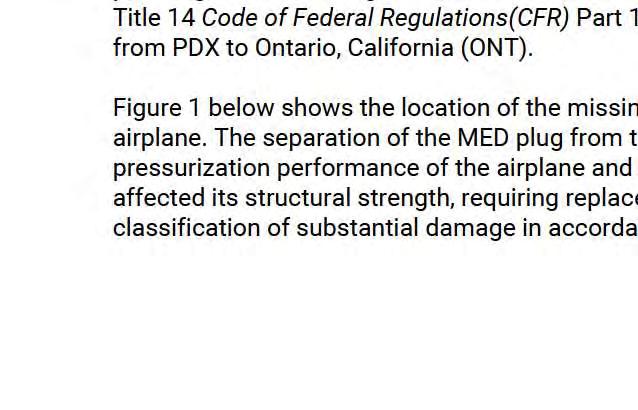





EXHIBIT A, p. 199 Ex, 5, p. 001
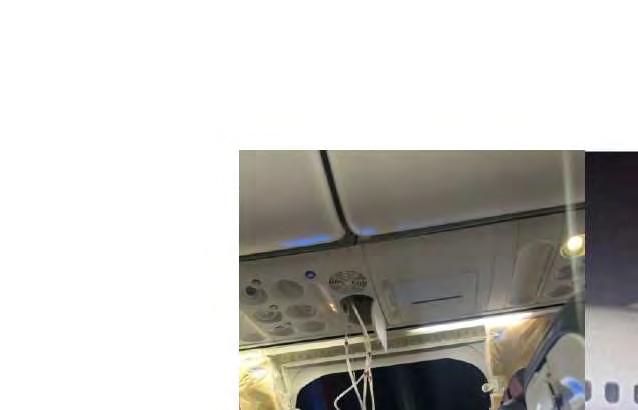

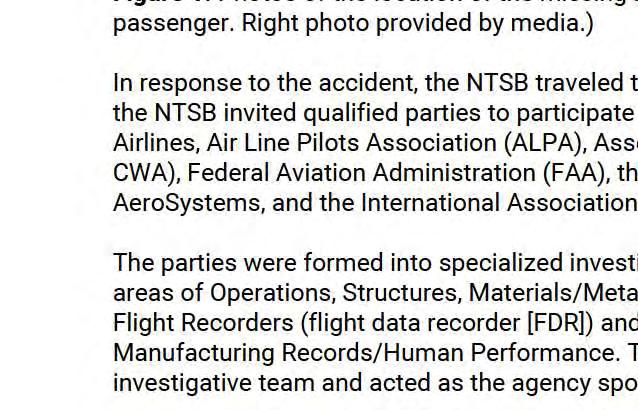





EXHIBIT A, p. 200 Ex, 5, p. 002

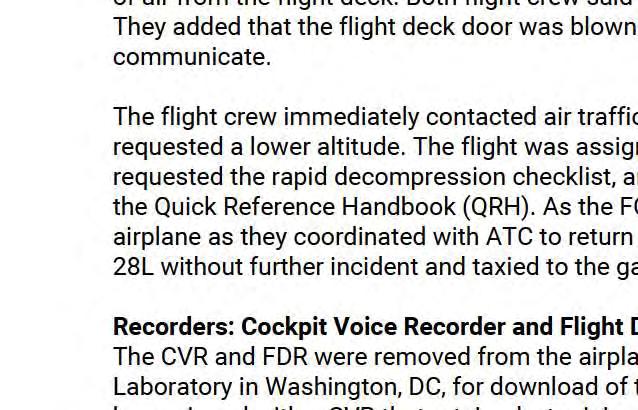
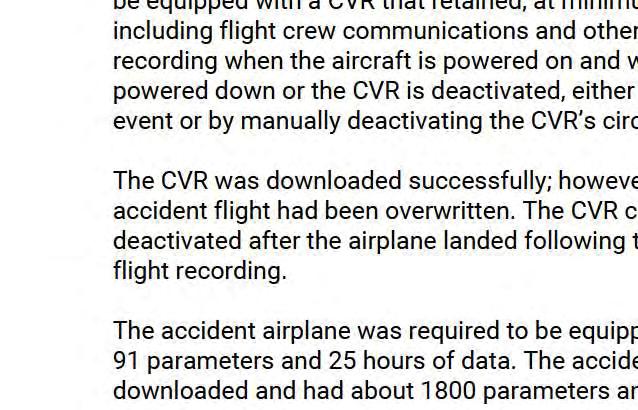


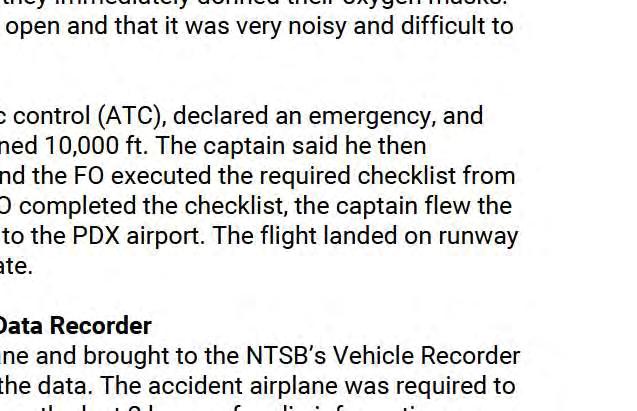

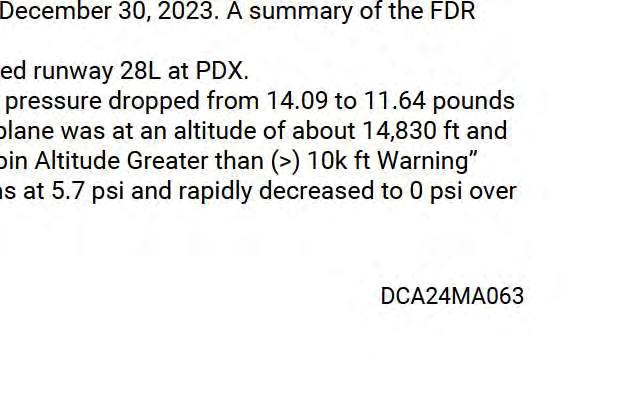
EXHIBIT A, p. 201 Ex, 5, p. 003








EXHIBIT A, p. 202 Ex, 5, p. 004


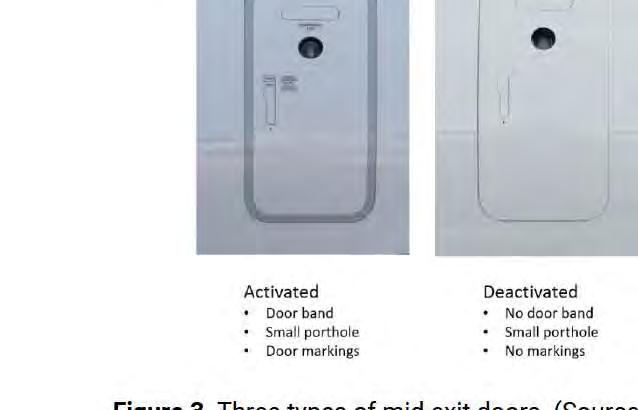




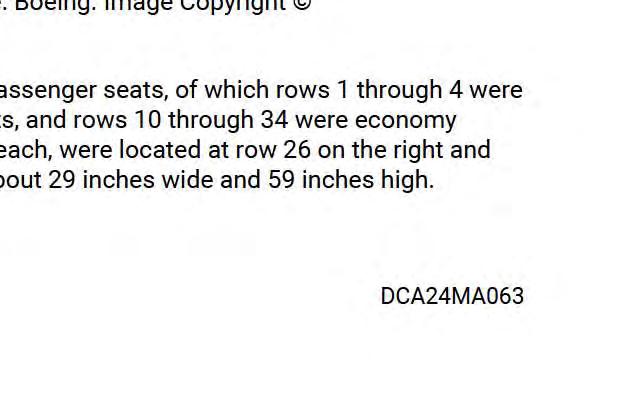
EXHIBIT A, p. 203 Ex, 5, p. 005





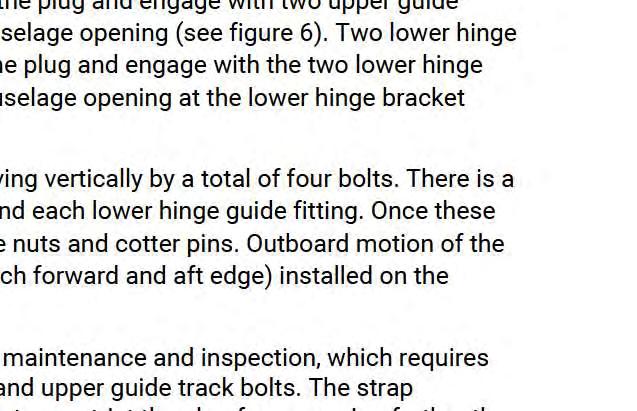
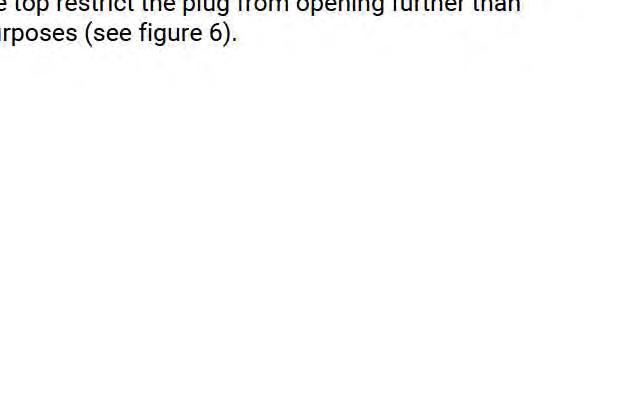

EXHIBIT A, p. 204 Ex, 5, p. 006



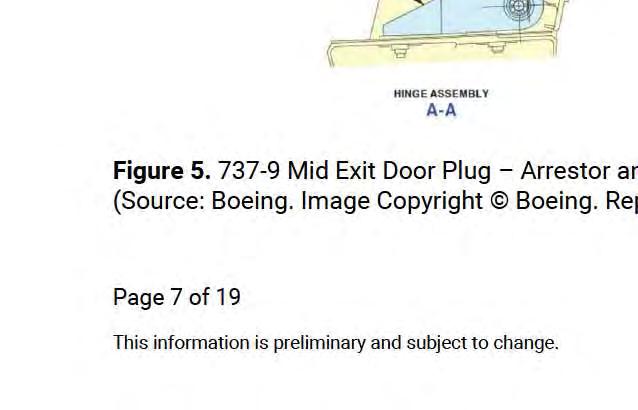

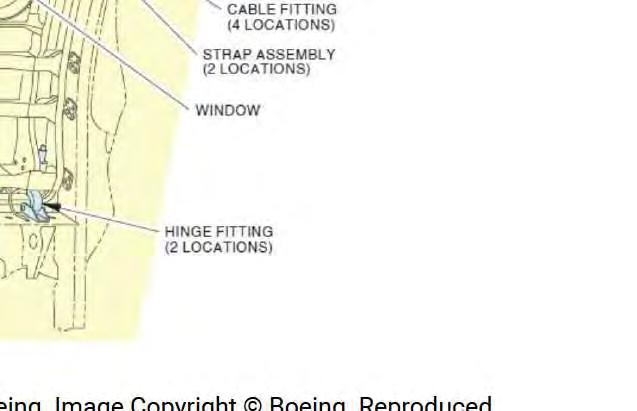


EXHIBIT A, p. 205 Ex, 5, p. 007
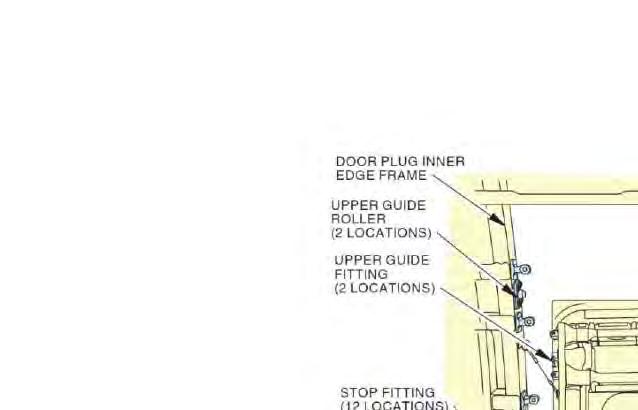
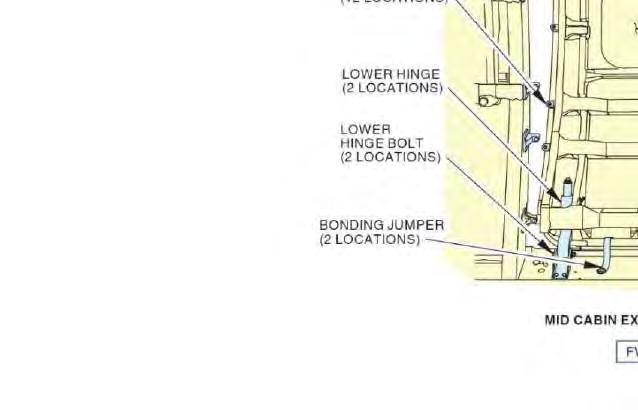


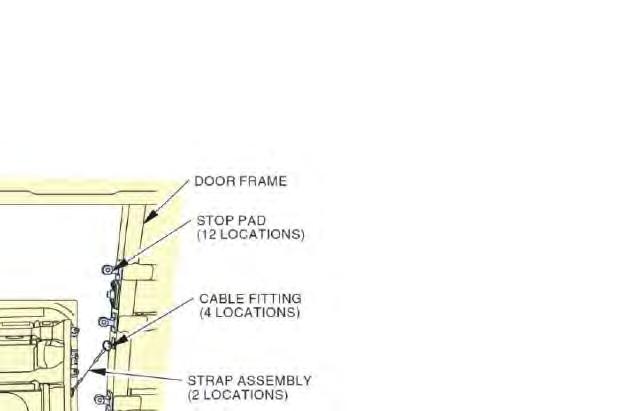



EXHIBIT A, p. 206 Ex, 5, p. 008

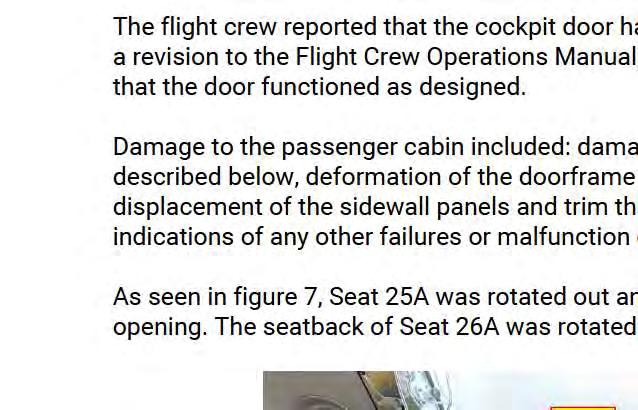

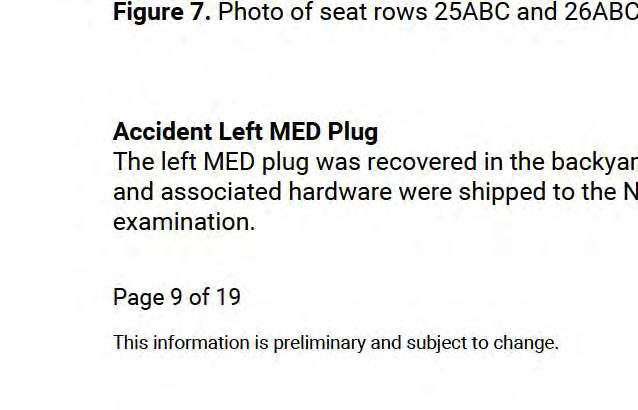

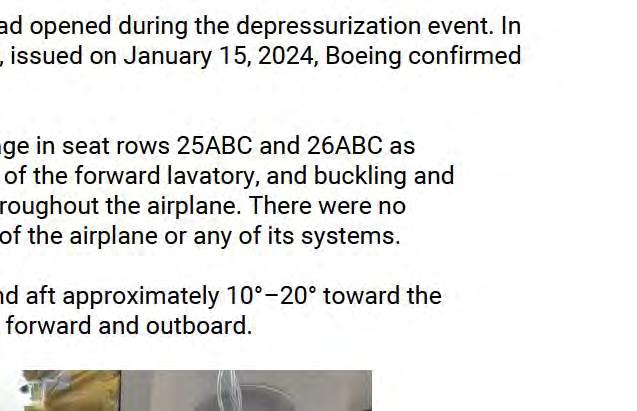


EXHIBIT A, p. 207 Ex, 5, p. 009




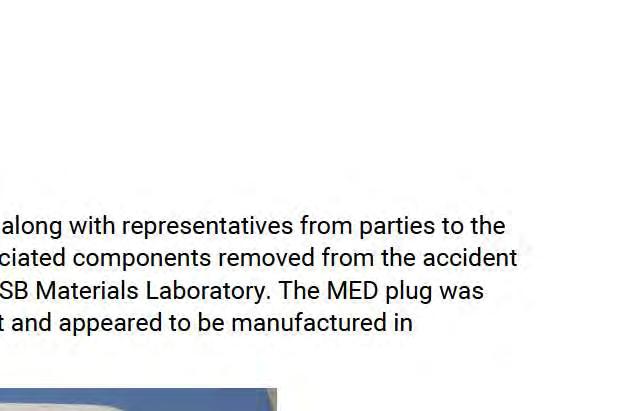
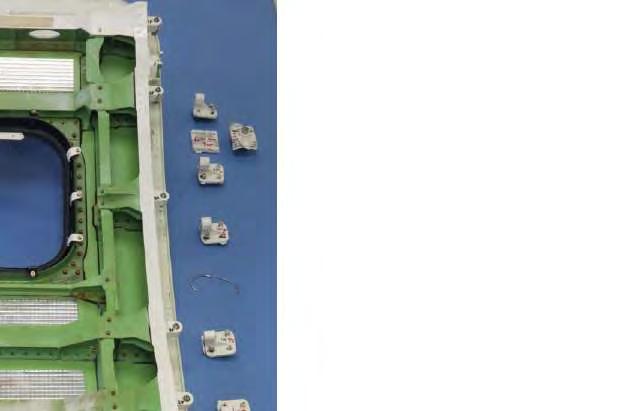

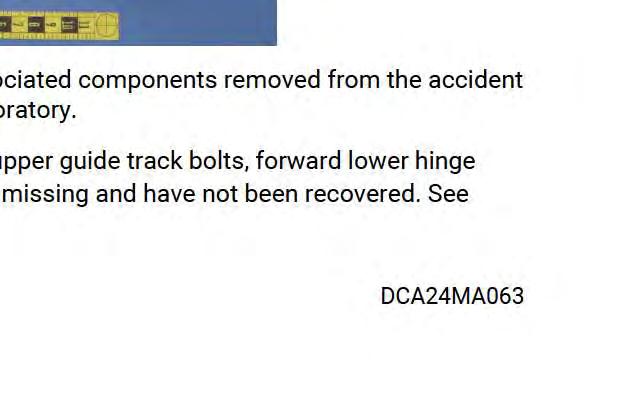
EXHIBIT A, p. 208 Ex, 5, p. 010

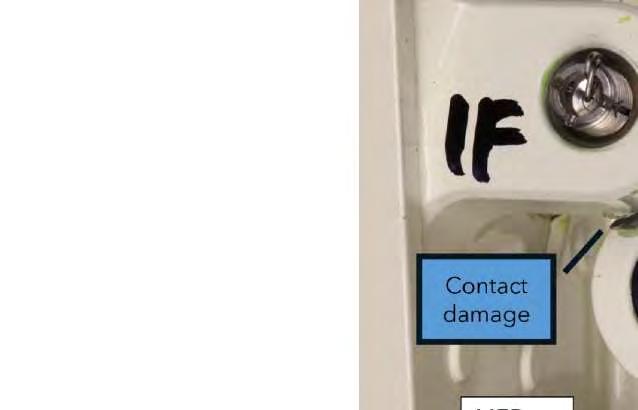

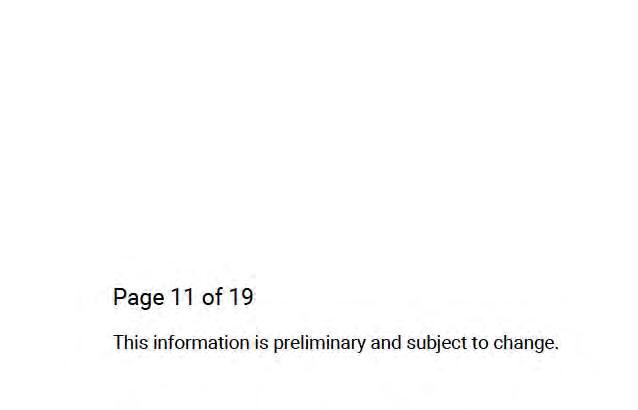




EXHIBIT A, p. 209 Ex, 5, p. 011




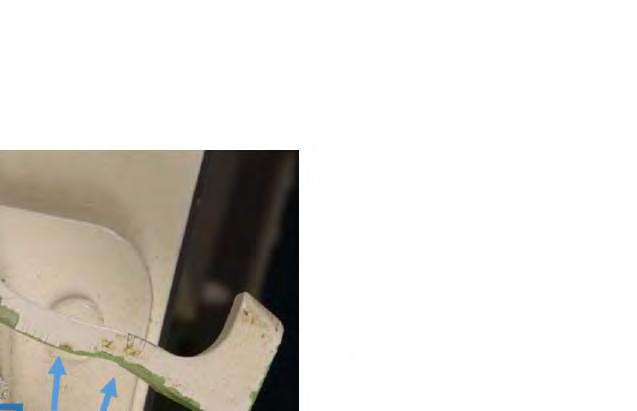



EXHIBIT A, p. 210 Ex, 5, p. 012








EXHIBIT A, p. 211 Ex, 5, p. 013







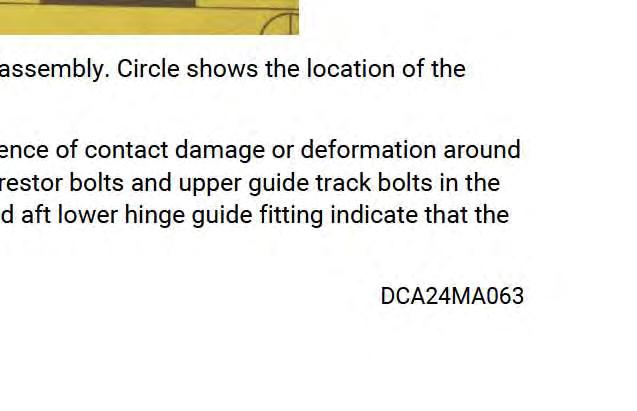
EXHIBIT A, p. 212 Ex, 5, p. 014





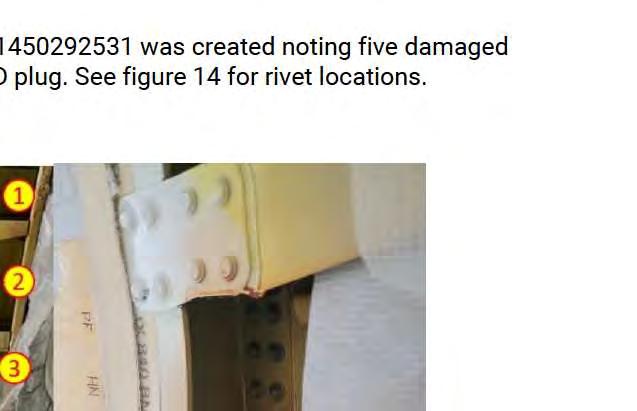


EXHIBIT A, p. 213 Ex, 5, p. 015

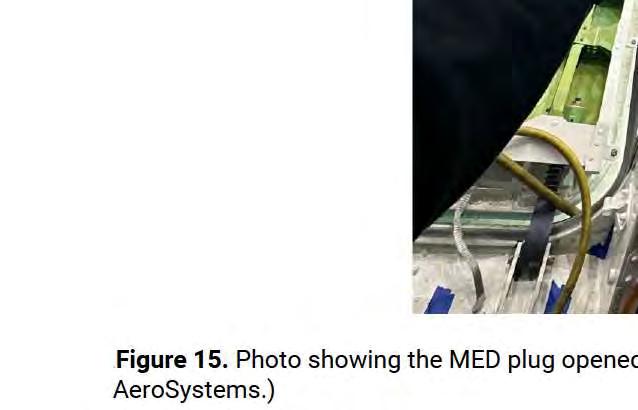

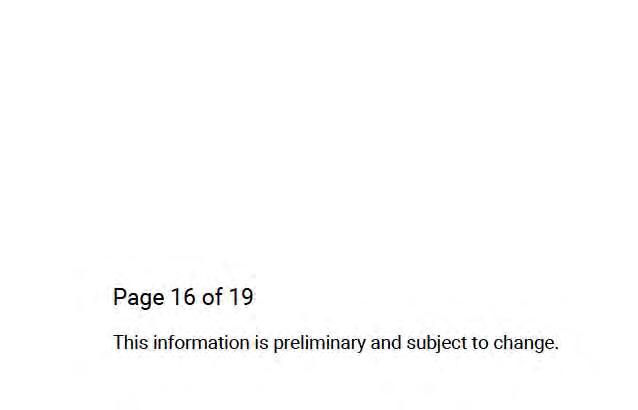
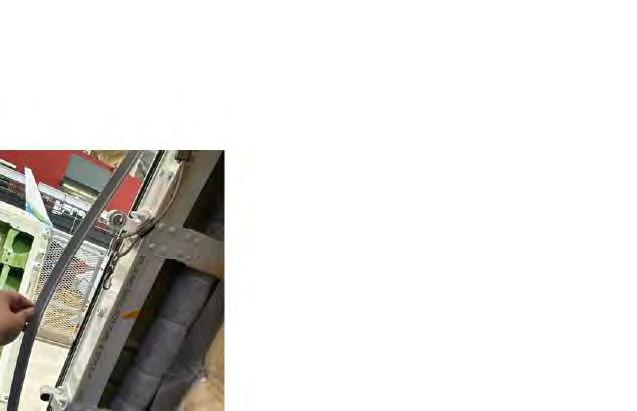



EXHIBIT A, p. 214 Ex, 5, p. 016



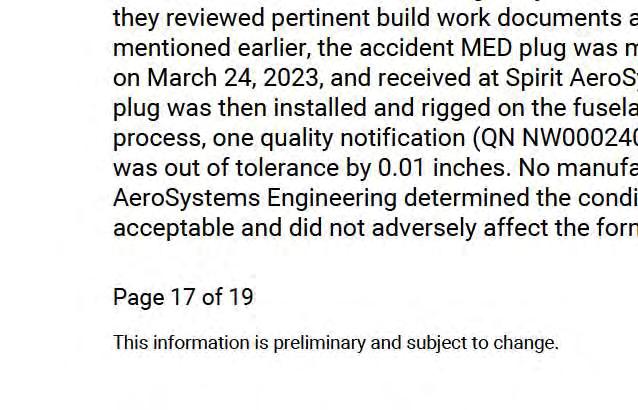




EXHIBIT A, p. 215 Ex, 5, p. 017


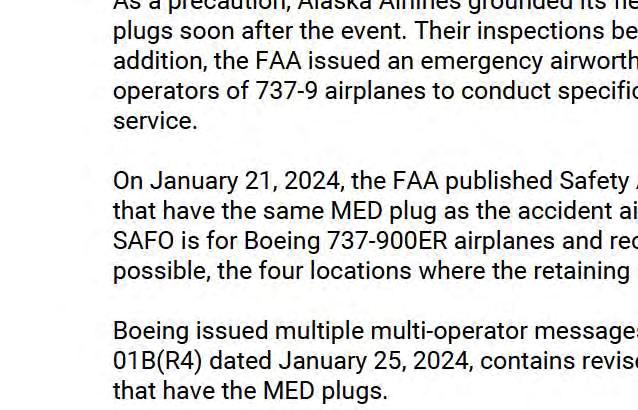





EXHIBIT A, p. 216 Ex, 5, p. 018
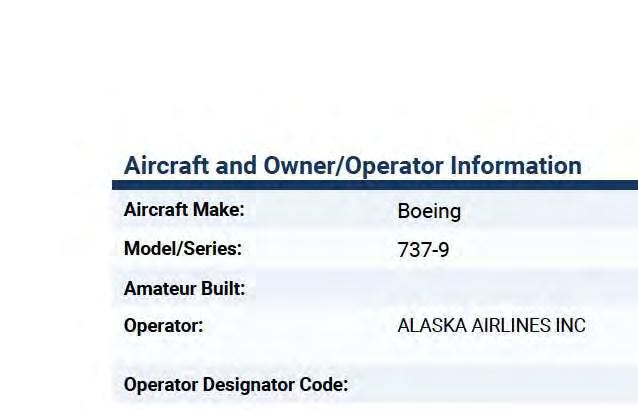
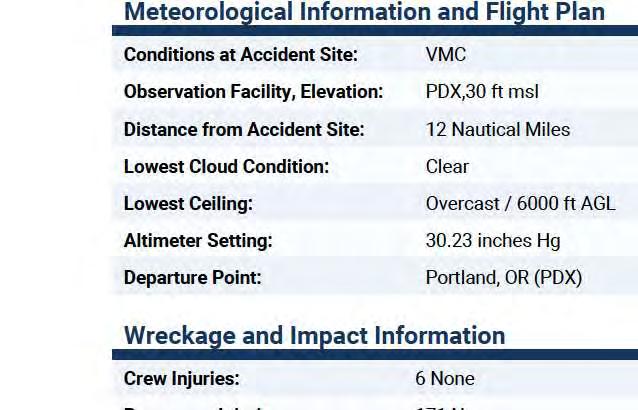



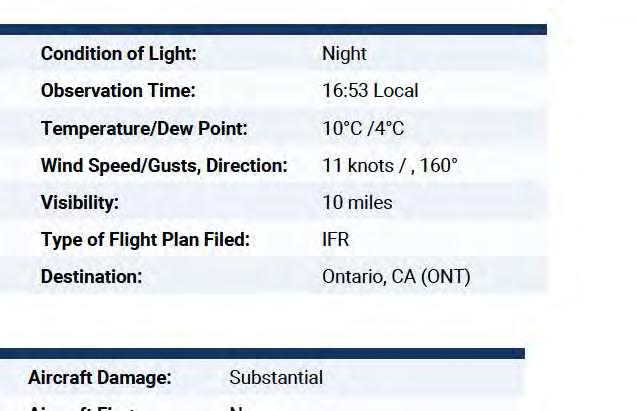


EXHIBIT A, p. 217 Ex, 5, p. 019

ROOT CAUSE ANALYSIS AND THE BOEING PROBLEM SOLVING MODEL
Utilizing the Apollo Root Cause Analysis methodology and RealityCharting® Software in Boeing’s 5-Step Root Cause Corrective Action Model for Effective Problem Solving
Authored by

www.armsreliability.com
EXHIBIT A, p. 218 Ex. 6, p. 001
Jemma Gaber and Jennifer MacKay

This white paper describes performing Root Cause Analysis (RCA) utilizing the Boeing Problem Solving Model-Root Cause Corrective Action (BPSM-RCCA). It details one Boeing Technical Principal’s use of the Apollo Root Cause Analysis methodology and RealityCharting® software during a problem-solving project.
www.armsreliability.com 2 OVERVIEW
ABOUT Boeing’s Root Cause Analysis expert: Jennifer MacKay 3 BOEING PROBLEM SOLVING MODEL An overview of the BPSM 4 STEP 1 Define the Problem 6 STEP 2 Perform a Root Cause Analysis 7 STEP 3 Identify Potential Solutions 9 STEP 4 Implement Solutions 11 STEP 5 Sustain the Gains 14 CONCLUSION Summary of the Approach 15 The Apollo Root Cause Analysis methodology was created by Apollonian Publications. ARMS Reliability is Licensed to use and distribute Apollo Root Cause Analysis methodology materials. RealityCharting® and RC Pro™ are the software tools that support the Apollo Root Cause Analysis methodology. EXHIBIT A, p. 219 Ex. 6, p. 002

ABOUT JENNIFER MACKAY
Jennifer is the only Root Cause Analysis Technical Principal at The Boeing Company. She provides RCA consultations, investigations, and holds workshops across the Boeing enterprise, addressing some of Boeing’s most complex and longest running production and process issues.
She joined the Boeing Company as a manufacturing engineering planner in 1991, and in 2007 took on the role of RCA specialist. In this role, she conducts full Root Cause Analysis and solution implementation, consults on Root Cause Analyses, and trains other employees in RCA. She frequently holds internal training sessions and has taught over 900 Boeing employees the RCA skillset to date.
To understand how crucial problemsolving is at Boeing it helps to understand the scale of the company. Boeing is the world’s largest aerospace company and America’s biggest manufacturing exporter. The Commercial Airplanes portion of the business employs more than 83,000 people worldwide, has more than 10,000 Boeing commercial jetliners currently in service and a record 5,500 more on order.
The production facility where she works in Everett, WA is the largest building, by volume, in the world according to the Guinness Book of World Records. There is a lot of

room, literally, for problem-solving and process improvement especially when you consider that in a single 777 aircraft, there are 3 million parts provided by 900 suppliers from 17 countries around the world.
www.armsreliability.com 3
EXHIBIT A, p. 220 Ex. 6, p. 003
Figure 1: Jennifer MacKay, Root Cause Analysis Technical Principal, The Boeing Company

BOEING PROBLEM SOLVING MODEL
AN OVERVIEW
The Boeing Problem Solving Model provides a structured approach to continuous improvement. It can be used to solve problems or capture opportunities of any size or scope. This model is the standard problem solving method for The Boeing Company.
The Problem Definition Template
This tool provides a method for developing a clear, concise statement describing the problem.
Actions to take:
• Define the current situation, ideal situation, and the gap between
• Define the scope and boundaries
• Break down the problem or opportunity
• Walk the process
• Identify existing processes/ standards
• Develop a problem statement with a clearly stated end goal
• Set measurable and challenging targets
The 5 Whys
Start with the problem statement from Phase 1.
Ask why this happened. If the answer to the initial why does not identify the root cause, continue asking “Why” until actionable root causes are identified.
Actions to take:
• Perform root cause analysis (RCA) to systematically identify all the contributors to the problem
• Validate the prioritized root cause(s) through data and walking the process
• Assure the data is valid and represents facts, not opinion
Improvement Actions & Expected Results
Use to describe improvement actions to be taken, the business results achieved once an action has been completed.
Actions to take:
• Identify as many potential solutions as possible that address the root cause(s) and narrow down to most practical to address the root cause(s)
• Validate preferred solution(s) through mockup, simulation, and/or pilot as required
• Stakeholder buy-in
Action Item List
Review progress on a regular basis and assure that team members are accountable to complete the items. Items may be related to deliverables or be in general support of the plan.
Actions to take:
• Capture actions, Responsibilities, and ECD’s
• Ensure implementation is completed as defined
• Monitor and communicate progress to the plan with stakeholders
• Update standard / documentation and training as required
Problem Solving Model Checklist
Ensures the desired results are achieved, measured, and monitored after implementation. Minor adjustments to plan may occur over time to sustain the benefits.
Actions to take:
• Ensure solutions meet/ produce the expected results
• Verify the problem defined is resolved or mitigated
• Monitor results over time
• Share results with stakeholders
• Ensure the new standard is maintained
www.armsreliability.com 4
Identify ROOT CAUSES IMPLEMENT the Solutions SUSTAIN the Gains DEFINE and DESCRIBE the Problem or Opportunity Identify and VALIDATE PROPOSED Solutions 1 5 4 3 2 BOEING PROBLEM SOLVING MODEL
DEFINE & DESCRIBE THE PROBLEM OR OPPORTUNITY IDENTIFY ROOT CAUSESIDENTIFY AND VALIDATE PROPOSED SOLUTIONS IMPLEMENT THE PROPOSED SOLUTION SUSTAIN THE GAINS RECOMMENDED TOOL: RECOMMENDED TOOL: RECOMMENDED TOOL: RECOMMENDED TOOL: RECOMMENDED TOOL:
FIGURE 3: DETAILS OF THE 5-STEP BPSM, INCLUDING RECOMMENDED TOOLS
1 2 3 4 5 EXHIBIT A, p. 221 Ex. 6, p. 004
FIGURE 2: THE 5-STEP BOEING PROBLEM SOLVING MODEL

APOLLO ROOT CAUSE ANALYSIS METHODOLOGY: The BPSM does not limit users to a specific set of tools for problem solving at any stage of the process. There are many different approaches for analyzing root causes and the Apollo Root Cause Analysis methodology and RealityCharting® software work well within the Boeing process.
The Apollo Root Cause Analysis methodology provides a multi cause-and-effect way of thinking and goes far beyond the traditional root cause analysis problem solving processes. It facilitates the creation of a common reality, using input from all stakeholders to produce an evidence-based understanding of a problem. This method ensures that solutions address proven causes, not assumed causes.
REALITYCHARTING®: This software is a powerful Root Cause Analysis tool used to assist facilitators and complement the Apollo Root Cause Analysis methodology. It is user-friendly and enables individuals to accurately identify and document the root causes of a problem. RealityCharts made with RealityCharting® help users obtain a better understanding of causeand-effect relationships and this leads to identifying effective potential solutions to prevent recurrence.
www.armsreliability.com 5
REALITYCHART CREATED IN REALITYCHARTING® EXHIBIT A, p. 222 Ex. 6, p. 005
FIGURE 4: A SAMPLE

STEP 1 DEFINE AND DESCRIBE THE PROBLEM OR OPPORTUNITY
The investigation phase of the BPSM process can involve:
CONTAINMENT:
Depending on the problem this could involve containing a situation so issues don’t progress further. This is especially important in the production environment.
REVIEWING THE “AS-DESIGNED” CONDITION:
Review the engineering drawings, specifications, and tooling from the design team.
REVIEWING THE “AS-PLANNED” CONDITION:
Review the manufacturing engineering plans that resulted from the initial design.
OBSERVING THE “AS-BUILT” CONDITION/PROCESS:
Witness the process in real-time; take photos and/or video to reference later. Perform surveys, look at technical data from past incidents, ask witnesses what happened, and see it first-hand. Give different weights to different types of data - i.e. eyewitness recollections versus empirical data. Bring in suppliers or go visit suppliers to understand their processes.
“I was working a wing project a while back, and the lead Quality Inspector who’d been there for 10 years had seen an error occurring on the 777 wing
and swore that it was happening five to seven times per wing, no more. However, I needed to validate and quantify the true quantity. We invoked process monitoring on 3 airplanes and found that this particular error was happening 94 times, per wing, on average. The Quality Inspector was shocked and was worried I would think he’d been lying to me. But I knew he wasn’t. People will give you their assumptions based on what they know… but they don’t know what they don’t know.”
– Jennifer MacKay
COMPARING THE AS-DESIGNED, ASPLANNED, AND AS-BUILT:
Unfortunately, the designed, planned and built configuration don’t always match up like they should. If it can be determined how/why things don’t match up then potential solutions begin to form.
DRAFTING A CHARTER:
A charter is a simple word document that lists the problem description, deliverables, objectives, and scope/boundaries. An agreedupon charter ensures all stakeholders are in alignment at project initiation.
“I found out how important a charter was when I didn’t create it once. At the end of the investigation, after we had implemented two stellar solutions and had completed a report about how successful our RCA had been, my manager came up to me and said, ‘Jennifer, that was fantastic, but it wasn’t the problem I wanted you to fix.’”
– Jennifer MacKay
www.armsreliability.com 6
EXHIBIT A, p. 223 Ex. 6, p. 006

STEP 2 IDENTIFY ROOT CAUSES
Identifying and exploring causal relationships can involve:
CREATING A CAUSE-AND-EFFECT MAP USING APOLLO ROOT CAUSE ANALYSIS
METHODOLOGY AND REALITYCHARTING® SOFTWARE:
RealityCharting® helps identify and record all of the causes of, and contributors to, a problem. Mapping out the relationships enables potential solutions to be more apparent. There are multiple approaches for creating a Realitychart:
INITIAL DRAFT
Independently create an initial Realitychart draft. Print it out and share it with Subject Matter Experts one-on-one, face-to-face.
“About a third of the time, I get to solutions that I’m confident in and I don’t feel it’s necessary to pull together a team.”
– Jennifer MacKay
GATHER A SMALL TEAM
Share the initial Realitychart draft with a small team of Subject Matter Experts in a group setting. Go through the cause-boxes oneby-one and expand the map with the input received from the team.
HOLD A WORKSHOP
There’s a spark that happens when you gather a team in a room to focus on a problem; the brainstorming and creativity that results from the synergy is irreplaceable. Convene a workshop for two reasons:
1. There isn’t confidence that the individually determined solutions identified in the Realitychart draft will truly fix the problem.
2. The independently proposed solutions might be controversial, or the people who will need to be involved in implementing the solutions aren’t currently on-board and their support is needed.
Resources are usually limited and people are busy so be judicious about planning workshops. Schedule two four-hour sessions with a couple days in between, and then however many one to two-hour follow-up sessions are necessary in the following weeks.
www.armsreliability.com 7
EXHIBIT A, p. 224 Ex. 6, p. 007


ADDITIONAL INVESTIGATING:
Creating the RealityChart® will often uncover questions or areas where more information is needed. Additional investigations may be required to provide evidence to validate a particular cause-path or potential solution. Investigation often includes a historical “deep dive” to quantify “heavy hitters” or frequent contributors to the problem, ex: does the problem only occur on a left hand wing and not the right hand? Does it occur when performed on one shift versus another?
UTILIZING CROSS-FUNCTIONAL
EFFORT: Whether the investigation involves talking to individuals one-on-one or pulling together a workshop, there are certain core team members whose involvement should be considered. These can include:
• Manufacturing Engineering
• Process Engineering
• Quality Assurance Investigation
• Manufacturing Lead Mechanic
• Tooling Engineering
• Stress Engineering
• Information Technology
• Supplier Engineering
• Supplier Manufacturing
• Supplier Tooling Engineering
It is imperative to get these important groups involved at the earliest stages of the project so there is a common understanding of the problem and buy-in for Step Three – Solution Implementation. Additionally, consider anyone else who will need to be involved with implementing the solutions: customers, design engineers, researchers, facilities, management, etc.
www.armsreliability.com 8
FIGURE 5: RCA WORKSHOP
EXHIBIT A, p. 225 Ex. 6, p. 008

STEP 3 IDENTIFY AND VALIDATE PROPOSED SOLUTIONS
At this step the RealityCharting® software is a very useful tool to visually depict how potential solutions can directly support problem resolution. Realitycharts can be color-coded to show potential solutions which correspond to each cause-path.

Technical experts are crucial when creating a Realitychart because they ensure all potential solutions are considered. Technical experts could include individuals such as:
Internal Subject Matter Experts: Individuals with extensive experience in their fields.
Internal Research and Development: Departments designated to identifying cutting-edge technologies and process improvements.
External Resources: Other industries are usually open to building relationships and sharing information. Pursuing knowledge-transfers with outside companies can be very beneficial to both parties involved.
“In one instance, Boeing wanted to improve exterior paint quality on the wings and decided we should pursue outside expertise. As a company we are really good at continually improving the way we do what we do. But we are not always quick to recognize when something is being done better elsewhere. So, I took our team on tours of the Ford and BMW paint facilities and spoke with their paint engineering experts to see what advancements they had made in both the robotic and manual paint processes, and defect detection.”
– Jennifer MacKay
www.armsreliability.com 9
FIGURE 6: COLOR-CODED REALITYCHART
EXHIBIT A, p. 226 Ex. 6, p. 009

DOWN-SELECTING POTENTIAL SOLUTIONS:
Often times there is no single solution that completely eliminates a problem, therefore, implementing a set of solutions can greatly reduce the probability of recurrence. Depending on the size of the project it can be easy to determine which solution(s) to implement, but if a problem is large and complex it can be difficult to proceed with confidence. However, several tools are available for down-selecting solutions such as performing an impact and changeability review and a return on investment (ROI) analysis.
Impact and Changeability Review:
Before selecting a solution consider both the impact it will have on the problem and the difficulty of implementation. Performing an impact and changeability review involves assigning a weighted number value to each potential solution which enables mathematical prioritization. The criteria can be adapted to any specific problem.
“In one RCA investigation, we identified 181 potential solutions so we had to prioritize the solutions by questioning each one.” – Jennifer MacKay
Return on Investment:
It can be value-added to determine the ROI for solution implementation; this will often times determine whether or not leadership will support a solution. Assign a dollar value to everything (flow time reduction, reducing safety risks, freeing-up floor space, eliminating heavy machinery operations, etc). Prepare ROI figures to show the cost/benefit information; determine when a potential solution will pay itself off and how much cost will be avoided in the future.
“I take my ROI down to the specific airplane level, for example: if we implement these engineering, tooling, and process changes it will cost us XX amount, the savings/benefits are XX, and we will see our return on investment on Airplane Line Number XXXX.”
– Jennifer MacKay
Impact Criteria
Degree to which the solution helps reduce the problem
Degree to which the solution solves the problem(s) vs temporarily fixes it
Degree to which solution results in unintended (negative) consequences
When rating “IMPACT”
1 = little impact
2 = some impact
3 = considerable impact
Changeability Criteria
Cost to implement
Amount of time required to implement
Level of acceptance by factory and maintenance personnel
When rating “CHANGEABILITY”
1 = difficult to achieve
2 = moderate effort to achieve
3 = little or no effort to achieve
FIGURE 7: IMPACT AND CHANGEABILITY CRITERIA
Effort/Impact Analysis: Template #1
Highly Effective Solutions
Solution ideas placed in this quadrant (low effort, high impact) should be the focus of a team’s energy since they are suspected to result in the best return investment
Easy-implementation, Low Value Added Solutions
Solution ideas placed in this quadrant (low effort, low impact) may require additional analysis to determine whether or not they should be implemented, but teams should not fall into the trap of analysis paralysis
Difficult-Implementation, High Value Added Solution
Solution ideas placed in this quadrant (high effort, high impact) often require significant additional analysis to determine whether or not they should be implemented
Ineffective Solutions
Solution ideas placed in this quadrant (high effort, low impact) should be set aside, and only reassessed if solutions in other quadrants prove to be unviable
Implementaion Effort (High)
FIGURE 8: EFFORT/IMPACT ANALYSIS TABLE
www.armsreliability.com 10
(Low)
(Low) Solution Impact (High) EXHIBIT A, p. 227 Ex. 6, p. 010

STEP 4 IMPLEMENT THE SOLUTIONS
Implementing solutions can be the most difficult step in the process, especially when solutions involve complex designs. Most solutions require effort from multiple groups, both inside and outside the company, who have different priorities and timelines. Additionally, people are frequently changing job roles in large companies; working with ever-changing points of contact can impact implementation.
Implementation effort and cost can vary wildly depending on the complexity of the problem. Don’t ignore the simple, efficient, inexpensive solutions just because they aren’t as exciting as the complex, revolutionary, high-tech solutions. Economical solutions can be impactful so don’t lose sight of the purpose of the project: solving the problem.
VIEWS OF SUCCESS:
Things often take longer than expected, especially when other groups are involved. Progress can be out of your hands but even if things take years to fix, they’re still fixed. Alternatively, a complete fix for a problem might not be feasible but improving the situation is still beneficial.
“For example, an RCA regarding a wing panel issue identified an engineering drawing change as one of the solutions. The change required a complex stress analysis, which in turn required measurement data across multiple airplanes. Tool Engineering was needed to support the data collection. Tooling fabrication, data collection across multiple airplanes, and the stress analysis took several months to accomplish.
The full project took more than a year and half to complete. I was a bit dejected by the length of time required to make this change. My manager recommended that I re-think my view of success. He reminded me that the project that took a year and a half to successfully complete included a change that eliminated a problem that had plagued our programs since the very first aluminum-passenger-plane wing. He was relieved that someone had finally stuck with it long enough to get the problem resolved.”
– Jennifer MacKay
PROJECT TRACKING:
Successful project tracking is essential to project completion. Publicizing a project’s status provides visibility and accountability for open action-items. It also provides leadership the information they need to adequately support the effort. Additionally, a project tracking system enables users to manage and organize multiple in-work projects simultaneously. Lastly, completed projects can be retained and made available for historical reference. A good tracking system includes easy access to data for all stakeholders such as a 4-Square, presentation, charter, Realitychart, and action-item list.
www.armsreliability.com 11
EXHIBIT A, p. 228 Ex. 6, p. 011

“Sadly, when projects are not tracked and action-items aren’t completed some of the best solutions can fall by the way-side and never see implementation. I mitigate this by managing my projects via Sharepoint; at a glance project status, action-item responsibilities, and next steps can easily be viewed. This also allows access to all project information: 4-square, project presentation, Realitychart, data collection, meeting minutes, photos and videos.”
– Jennifer MacKay
4-SQUARE:
A “4-Square” is a simple and effective tool that provides a quick overview of a project situation, reviewed causes, proposals/solutions, actions/steps, and a timeline of events. A 4-square should be updated at each major milestone of a project.

PROJECT PRESENTATION:
Compiling an overall project presentation is very useful for reporting to leadership and stakeholders; it also for provides a historical reference. A presentation should identify the team members, outline the problem, provide background information, explain the investigation and results, identify the causes and solutions selected, provide details about the implementation plan, and summarize the ROI.
www.armsreliability.com 12
FIGURE 9: EXAMPLE OF AN RCA 4-SQUARE, PROPRIETARY INFORMATION HAS BEEN REMOVED
EXHIBIT A, p. 229 Ex. 6, p. 012

ACTION-ITEM LIST: Creating and maintaining an action-item list supports project progression by assigning responsibility to a focal. It also provides estimated due-dates and actual completion dates to project tasks. An action-item list also tracks the status of individual tasks by assigning a percentage-completion value to each.

It’s essential that an RCA package (4-Square, presentation, charter, Realitychart, action-item list):
• Shows real-time project status
• Communicates findings
• Establishes credibility
• Provides a visual that pulls the entire project together, especially when multiple groups are working on different parts of a solution
• Creates a basis for decision-mak ing and funding approval
• Provides historical reference and knowledge for others
www.armsreliability.com 13
FIGURE 10: EXAMPLE OF AN ACTION-ITEM LOG, PROPRIETARY INFORMATION HAS BEEN REMOVED
EXHIBIT A, p. 230 Ex. 6, p. 013

STEP 5 SUSTAIN THE GAINS
Sustaining the gains is the final step of the Boeing Problem Solving Model. This involves verifying that the solutions which have been implemented actually solved the problem without introducing other issues. Additionally, it’s important to gather financial data and modify the ROI to include the actual gains achieved.
PROCESS IMPROVEMENT PROJECTS:
Sustaining the gains on process improvement solutions can be accomplished by conducting reviews on the implemented fixes. Witnessing a successful solution right after implementation is critical but it’s equally as important to ensure the problem remains fixed. It’s a good practice to conduct 30/60/90 day checks after solution implementation.
“A while back, a team of mine came up with a solution to a difficult problem — the problem involved 7 locations of recurring defects on a horizontal stabilizer. When we finally resolved the issue the team met on the factory floor to witness the implemented fix. The first and second airplanes down the line resulted in 100% success; our team cheered and patted ourselves on the back for a job well done.
A year and a half later I was on the floor telling someone about this problem we had fixed and I introduced them to the lead mechanic involved on the project. I was explaining the success of the project when the mechanic said ‘Yeah, but you only fixed five of the problem areas. There are still two where the solution doesn’t work.’ Apparently these two problems had been going on ever since airplane three, and no one ever told me. So, guess what my next assignment was… Because of this I now do a better job of following-up; I make sure the implemented solutions work as planned before closing the project.”
– Jennifer MacKay
NONCONFORMANCE PROJECTS:
When a production part, installation, process, etc. doesn’t conform to the engineering specifications a ‘nonconformance’ exists. These nonconformance projects can’t be closed until the implemented solution(s) are validated on a production airplane. This acts as built-in verification system whereas process improvement projects need to be monitored.
www.armsreliability.com 14
EXHIBIT A, p. 231 Ex. 6, p. 014

CONCLUSION A SUMMARY
Incorporating the Apollo Root Cause Analysis Methodology and RealityCharting® software into the Boeing Problem Solving Model has been a very successful method for conducting Root Cause Analysis investigations.
“I’ve found that most people are problem solvers by nature but when they utilize structured methods, tools, and training their results are consistently more effective.”
– Jennifer MacKay
ABOUT ARMS RELIABILITY
ARMS Reliability has worked with many companies worldwide to implement their performance improvement programs. By structuring programs to fit within the goals and objectives of the business, rather than applying a ‘one size fits all’ solution, effective and long lasting results are realized.
www.apollorootcause.com
www.armsreliability.com 15
info@apollorootcause.com Australia Africa Asia Europe Latin America | | | | | North America NORTH / CENTRAL / SOUTH AMERICA P: +1 512 795 5291 AUSTRALIA / ASIA / NEW ZEALAND P: +61 3 5255 5357 EUROPE / MIDDLE EAST / AFRICA P: +44 1484 505 776 ARMS Reliability is an authorized global training provider of the Apollo Root Cause Analysis methodology. RealityCharting® and RC Pro™ are the software tools that support the Apollo Root Cause Analysis methodology.
Learn the Apollo Root Cause Analysis methodology at our worldwide public training courses VIEW PUBLIC TRAINING CALENDAR EXHIBIT A, p. 232 Ex. 6, p. 015
















































 Mark
Mark
 Chief Counsel,
Chief Counsel,



















































































































































































